Australian
and international
exploratory
performance and
media arts
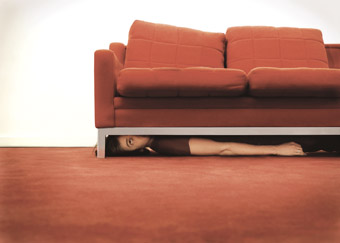
Hamish Michael in publicity still for Marius von Mayenburg’s Moving Target
photo Garth Oriander
Hamish Michael in publicity still for Marius von Mayenburg’s Moving Target
This edition of RealTime is, above all, musical. In a cluster of OnScreen articles you can read about the impact of vintage popular musics on artists working in film, theatre and installation. In our festival section, you’ll discover the potent music programming evident in the Sydney and Adelaide Festivals. Consonant with this, the issue of hybridity constantly rises to the surface of this edition—whether in expanded notions of media arts evident at Ars Electronica, Videobrasil and Zero One or in numerous individual artworks and performance festivals, like OzAsia. Cross- fertilisation, multilinearity and media convergences continue to yield emergent possibilities, not fixities. It’s a fecund time offering a creativity to counter the multitude of fundamentalisms that have beset us in recent decades. The Labor Party’s victory in the 2007 Australian federal government election and the prospect of the Senate becoming once again a house of review offer hope for a revival of the democratic impulse in our culture, for the promotion of empathy and active compassion. But let’s not think it’s going to be easy. Leonard Cohen writes in his Book of Longing (see page 5), “We are moving into a period of bewilderment, a curious moment in which people find light in the midst of despair, and vertigo at the summit of their hopes. It is a religious moment also, and here is the danger. People will want to obey the voice of Authority, and many strange constructs of what Authority is will arise in every mind. The family will appear again as the Foundation, much honoured, much praised, but those of us who have been pierced by other possibilities, we will merely go through the motions, albeit the motions of love. The public yearning for Order will invite many stubborn uncompromising persons to impose it. The sadness of the zoo will fall upon society” (Book of Longing, Penguin Books, 2007). We prefer to look forward, cautiously, to happier times, wish you good reading, a joyous holiday season and hope to share a richly creative 2008 with you. At least you don’t have to hide under the couch any more. Keith, Virginia & Gail
RealTime issue #82 Dec-Jan 2007 pg. 1
© RealTime ; for permission to reproduce apply to realtime@realtimearts.net
This picture spread is available for download.
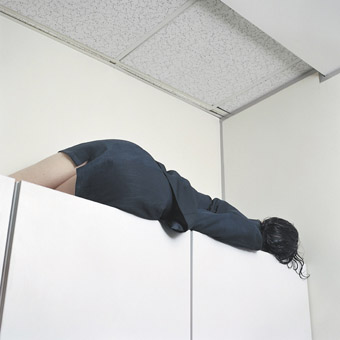
White Collar Undone (2006)
Narinda Reeders
White Collar Undone (2006)
White Collar Undone (2006), Narinda Reeders.
Reeders’ day job as a computer programmer inspired two photo-documentary series about office environments. Exhibited as part of Girl Parade curated by Bec Dean, Australian Centre for Photography, Nov 16-Jan 26
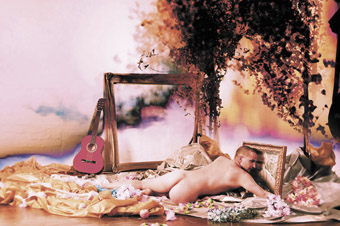
Brindabella, BalletLab
photo Jeff Busby, art direction 3 Deep Design
Brindabella, BalletLab
Brindabella, BalletLab
A collaboration between BalletLab and New York choreographer Miguel Gutierrez. A baroque fantasia on the seductive dangers of the Australian bush. Malthouse,
Dec 5 -8. Reviewed in RT83.
Photography: Alex Davies
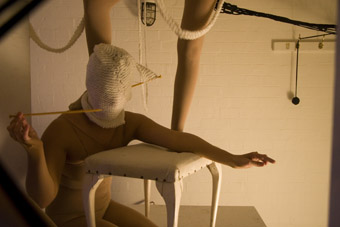
Pork in The Rafters, Body Knitting
photo Alex Davies
Pork in The Rafters, Body Knitting
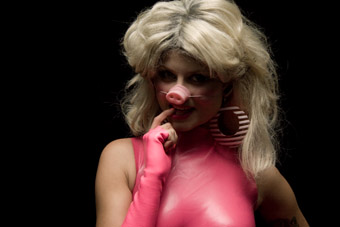
Nikki Majajas
Alex Davies
Nikki Majajas
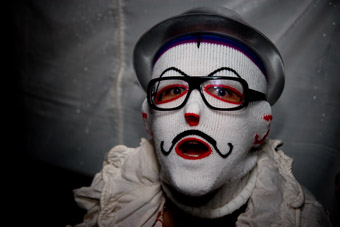
Biffo’s Blowup Bonanza, Justin Shoulder
Alex Davies
Biffo’s Blowup Bonanza, Justin Shoulder
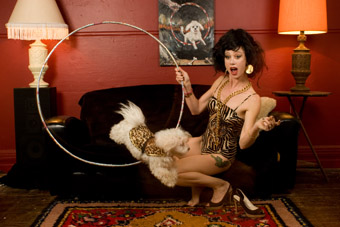
Annabel Lines and Baby Boy
photo Alex Davies
Annabel Lines and Baby Boy
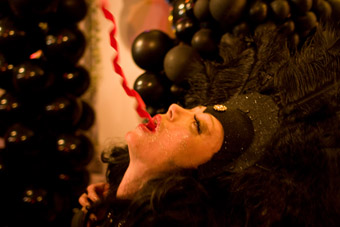
Bachanalian Bash, Annabel Lines
photo Alex Davies
Bachanalian Bash, Annabel Lines
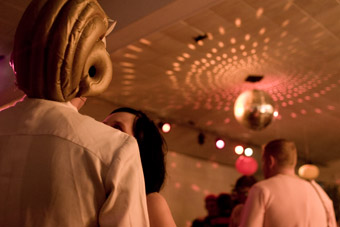
Bachanalian Bash, Medium Rare Gallery
photo Alex Davies
Bachanalian Bash, Medium Rare Gallery
A selection from Davies’ exhibition of over 150 social documentary/street photographs from Sydney and abroad. Chalkhorse Gallery, Surry Hills,
Nov 29-Dec 1, http://chalkhorse.com.au
RealTime issue #82 Dec-Jan 2007 pg. 2-3
© RealTime ; for permission to reproduce apply to realtime@realtimearts.net
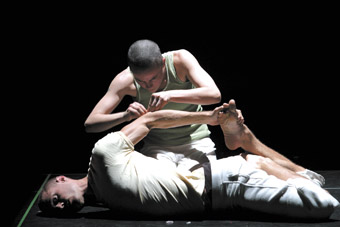
Kyle Kremerskothen, Kirstie McCracken, Aether, Lucy Guerin Inc
photo Rachelle Roberts
Kyle Kremerskothen, Kirstie McCracken, Aether, Lucy Guerin Inc
“EXHILARATING, STIMULATING, DISTURBING, EROTIC, PROVOCATIVE, CHALLENGING, HAUNTING.” SYDNEY FESTIVAL HAS SELECTED THESE ADJECTIVES TO DESCRIBE THE SEVEN DANCE PRODUCTIONS IN THE ‘FESTIVAL WITHIN A FESTIVAL’ WHICH IS THE ABOUT AN HOUR PROGRAM FOR 2008. LAUNCHED IN 2006, THE SERIES IS ONE OF FESTIVAL DIRECTOR FERGUS LINEHAN’S MOST SUCCESSFUL INITIATIVES, ATTRACTING NEW FESTIVAL AUDIENCES TO THE SYDNEY OPERA HOUSE THROUGH A $25 TICKET FEE, SHORT PERFORMANCES AND PUNCHY MARKETING.
This year’s program, subtitled Movers & Shakers, is devoted entirely to Australian contemporary dance. Sydney Festival was the successful bidder in a $200,000 tender from the Australia Council’s Dance Board and Community Partnerships and Market Development Division for an initiative to build audiences for, and raise the profile of, Australian dance. Jennifer McLachlan, Director of Dance at the Australia Council, says, “The Sydney Festival has developed a smart concept that will provide an ideal platform to showcase Australian dance to a broad cross-section of the Australian community.”
Realising that this program is the closest thing to a national contemporary dance festival Australia has had since Robyn Archer’s 2003 Melbourne Festival, the Australia Council has focused additional funding on bringing a delegation of 12 key international presenters to the festival—from North America, the Netherlands, Belgium, Germany, France, Finland, Korea and Japan.
Fergus Linehan has created a program with mass appeal, seeking work with strong imagery and high production values. He has used the new funding to commission and co-commission world premieres and remount productions recently shown in other states and overseas. Works will be shown in the Opera House’s Drama Theatre, Playhouse and Studio and at the Riverside Theatres in Parramatta. The festival has also commissioned a program of dance for screen, curated by Erin Brannigan of Reeldance, for the western foyers of the Sydney Opera House. There will also be a panel in the Eat, Drink, Talk Art series at The Mint which will bring the programmed choreographers into conversation with their audience.
force majeure
Amongst the world premieres is Force Majeure’s The Age I’m In, a collaboration with Sydney-based photographer William Yang. Described by the company’s director Kate Champion as “a revealing portrait of Australia today”, the work is a slice-of-life examination of “a random and diverse selection of Australians aged between eight and 80.” Force Majeure’s 2005 production, Already Elsewhere was commissioned and premiered by Brett Sheehy for the 2006 Sydney Festival and the company’s debut Same, same But Different premiered in Sydney Festival of 2002. Champion says,”The company came into being through the Sydney Festival so our relationship is heartfelt. We are thrilled to be part of this festival which we feel represents the ‘here and now’ of the Australian dance industry. The Age I’m In is extending our aim to represent a range of Australian experience that exists beyond the rehearsal room walls and is sourced from experiences of everyday people.”
chunky move
Another world premiere in the season is Chunky Move’s Mortal Engine (see the interview with director Gideon Obarzanek in RT81, p41), a follow-up to the widely toured dance and technology solo, Glow, which was shown at the Sydney Opera House Studio in 2007 as well as at Melbourne Festival and extensively overseas. In Mortal Engine we will experience a “new dance-video-laser performance using movement responsive video projections to portray an ever-shifting, shimmering world in which the limits of the human body are an illusion.” Promising the same shift between the exquisite and the grotesque which characterised the mood swings of Glow, but with more dancers and more technological innovations, this collaboration between choreographer Gideon Obarzanek and German interactive video systems maker Frieder Weiss features the polished integration of movement and image characteristic of much of the Movers & Shakers program.
rings, benjamin, dunn
A double bill commission is the third world premiere in the season. Independent choreographers Frances Rings and Narelle Benjamin have created solos for dancer Kathryn Dunn. Rings’ Belonging is an “evocation of the innate connections between the body and nature.” Rings, one of Bangarra Dance Theatre’s resident choreographers, says, “ I feel this work is as much a journey back home for me as it is for Katie. With each of my new works I step closer to connecting with my roots. I’m excited to work with a soloist and really get down to defining my choreography and to partake in some Women’s Business.” Benjamin says her work, Figment, “was created to throw light on my sister’s experiences as a suffering schizophrenic. Schizophrenia changed her reality, and re-wrote the path of her past for years before beginning treatment. After she began taking medication, and gaining some relief, she kept journals detailing her hallucinations and delusions. She also took the time to talk of those times and the ongoing battle she wages with this debilitating disease.” Benjamin is using the same creative team she assembled for recent productions, Gossamer and The Dark Room, with Samuel James contributing projected images and Huey Benjamin the score and sound design.
shaun parker
Amongst the Sydney premieres are Shaun Parker’s This Show is About People, a hit of the 2007 Melbourne International Arts Festival. Dancer-choreographer Parker collaborated with vocalists Mara and Llew Kiek and a talented group of dancers and musicians to create a humorous dance theatre work with appealing musical quirks (see John Bailey’s review p8). Parker says,”I wanted to make a work about the nature of life and death and the questions one asks about humanity and to allow the production to be driven by the body and the voice—two of the fundamental aspects of what it is to be human. I want my work to connect with audiences, and challenge them all at the same time.”
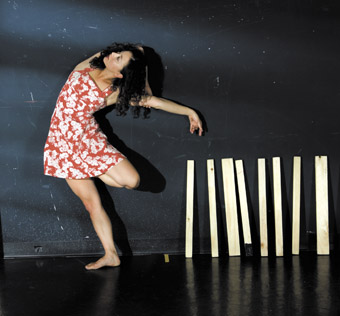
Kristina Chan, construct
photo Chris Herzfeld
Kristina Chan, construct
tanja liedtke
Tanja Liedtke’s Construct premiered in London in 2007 (see Martin del Amo’s review in RT81) and toured the UK just prior to the choreographer’s untimely death. Solon Ulbrich, associate director of the work and Liedtke’s partner, says, “Construct received acclaim from England’s The Times newspaper as ‘a bolt out of the blue’ and has been planned for presentation in the Sydney Festival since April 2007. The festival is to be commended for maintaining their commitment to presenting Construct. We are thrilled to present the work and fulfil Tanja’s commitment to bringing audiences the finest, stimulating dance experiences.”
lucy guerin
Lucy Guerin’s Aether is new to Sydney, but the company certainly is not. Guerin says, “Being programmed in Sydney for the third time in 12 months is an incredible opportunity for our company to consolidate the audience base we have there and also to make some inroads in expanding it. Our company is on a strong upward trajectory with various opportunities appearing in our hometown of Melbourne, as well as around Australia and the world.” Described by Guerin as “an intricate and chaotic dance piece”, Aether “depicts the struggle of five dancers—at once fast, furious and delicate—as they transcend the messy clutter and confusion of contemporary communication and make direct, and ultimately human, connections.”
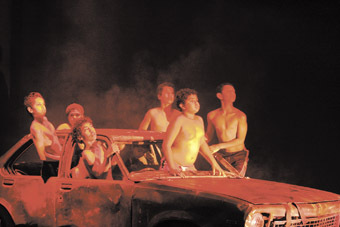
Kin
photo Joanne Bell
Kin
stephen page
Kin by Stephen Page, Artistic Director of Bangarra, is a surprise inclusion, featuring as it does, a cast of pubescent boys clambering over a burnt-out car and telling their stories in dialogue, rock music and rap as much as in dance and movement. Page calls Kin, commissioned by the 5th Asia Pacific Triennial and shown at the Melbourne International Arts Festival, “a contemporary initiation through theatre into the social and political problems in Aboriginal communities,” yet his touch is light and the “young boy energy” which he celebrates ignites this production and makes it worthy of inclusion in a line-up of Australia’s best dance talent.
Such an unprecedented line-up of dance productions is likely to attract excited audiences and it is no wonder that Linehan’s launch publicity for the festival calls this season “our proudest programming achievement” and predicts it to become “the talk of the festival.”
–
Sydney Festival 2008, About an Hour: Movers & Shakers, Sydney Opera House, Parammata Riverside Theatres, Jan 5-26, www.sydneyfestival.org.au
RealTime issue #82 Dec-Jan 2007 pg. 4
© Sophie Travers; for permission to reproduce apply to realtime@realtimearts.net
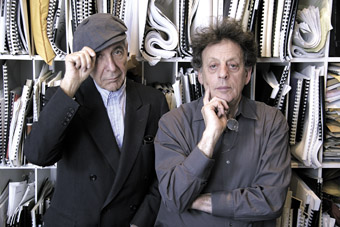
Leonard Cohen & Philip Glass
ALTHOUGH VERY DIFFERENTLY PROGRAMMED, THE 2008 SYDNEY AND ADELAIDE FESTIVALS SHARE A PASSION ABOVE ALL FOR MUSIC. SYDNEY’S ARTISTIC DIRECTOR, FERGUS LINEHAN, HAS MAXIMISED THE FESTIVAL’S POPULIST TENDENCIES (AT THE SERIOUS END OF THE SPECTRUM) WITH A MASSIVE MUSIC LINEUP RANGING FROM BRIAN WILSON AND BJORK TO AMERICAN INDIES, DETROIT DJS AND AUSTRALIAN INDIGENOUS PERFORMERS. ADELAIDE’S BRETT SHEEHY HAS GIVEN CENTRESTAGE TO AINADAMAR, GOLIJOV’S OPERA ABOUT FEDERICO GARCIA LORCA, AND PHILIP GLASS’ INTERPRETATION OF LEONARD COHEN’S RECENT COLLECTION OF POEMS AND DRAWINGS, BOOK OF LONGING. ON THE JAZZ FRONT, SHEEHY HAS BILLY COBHAM AND ORNETTE COLEMAN. ON CONTEMPORARY CLASSICAL THERE’S THOMAS ADES AND JOHN ADAMS AMONG OTHERS AND A DRAMATISED LIFE OF VIVALDI, THE RED PRIEST.
Sheehy’s final Adelaide Festival appears to be his best, at least on paper. It’s rich in potent content. However, compared with the thematically rich festivals of Kosky, Archer (in Adelaide and Melbourne) and certainly Kristy Edmund in her 2007 Melbourne Festival, Sheehy adheres to the conventional model of programmed diversity. Whether or not he’ll please Melbourne’s vociferous conservatives (desperate for opera, ballet, symphonies and great Shakespeares) when he takes over their festival in 2009 is another matter—he’s quite capable, as his 2008 Adelaide Festival attests, of programming challenges for his audience. Fergus Linehan has moved on from the diversity of his first two programs to something more ambitious and coherent—a massive celebration of music, diverse in itself, but focused especially on the riches of popular music yielded by the 20th century and still being mined and developed and doubtless bringing a new audience to the festival.
adelaide festival
Ainadamar (Fountain of Tears) is Oswaldo Golijov’s first opera. It premiered in 2003 and a revised version was directed by Peter Sellars in 2005. Golijov is an Argentinian composer of Eastern European Jewish extraction. He’s an adventurer in the weaving of instrumental and electronic sound, the juxtaposing and merging of music from various cultures (here Christian, Sephardic and Arabic, true to Spain’s history), but not adventurous in a modernist, avant-garde sense. His melodies are largely tonal, his harmonies immersive, his rhythms regular, his constructions familiar, but he can move and provoke and create passages of great beauty, capacities ideal for opera.
In the restrained theatricality of American David Henry Hwang’s libretto Lorca’s execution by the fascist Falangists is framed by the death of the revolutionary Mariana Pineda, executed in 1831 (and whom Lorca celebrated in the play named after her), and then principally by the coming death of Lorca’s actress friend Maria Xirgu, old and ill in Montevideo where she has carried on the writer’s theatrical tradition. She’s passing it on it to her young student Nuria but continues to suffer guilt for having failed to convince Lorca to flee with her from Spain in 1936. Maria and Nuria are performed by sopranos, Lorca by a mezzo, heightening the sense of the writer’s complex sexuality.
Lorca, himself a composer, was in love with flamenco and it quickly establishes itself as the principal musical mode of the opera. Ainadamar opens with the sound of a dark flood of water, heralding trumpets, castanets, the beating hooves of galloping horses, propulsive drumming and then the high whine of a female chorus singing of Mariana Pineda against strummed guitars and soaring strings. These constellate to frame Margarita Xirgu’s recollections (“the day I first took [Lorca’s] hand—soft like a baby, yet he was already a man”). Golijov immediately evokes the Spain we know through Spanish folk, classical and movie music, but manages to transcend pastiche with a sustained line and careful emotional shaping. Capturing the sense of a nation betraying itself, Lorca’s Falangist tormentor and executioner is sung in flamenco tenor. A rasping, recurring Radio Falange broadcast (“Whoever is not with us/ Is against us”) deepens the mood of threat.
The text of Hwang’s libretto is spare and uncomplex, replete with just enough striking images (“To Havana, ah! With my skull open to the sun,/ sand tasting like rum/ The breeze is my shepherd, /I shall not want”) in the manner of Lorca, and capturing the poet’s intensely personal notion of revolution, social yes but in search of other kinds of release and embodied in adoration of the suffering woman. Of Pineda, Lorca sings “Yet the revolution betrayed her/ for all she really wanted/ was love, only love.” Lorca himself is Christ-like, in his own words (“I walk singing, crowned with thorns”) and those of the chorus (“you carried your cross, /on his left, a school teacher, on his right, a bullfighter,/ and the fountain began to cry”). Some of the most affecting music is heard in the Voices of the Fountain and then in the pathos of Confession with its many gentle voices (including recorded village folk in prayer against high, delicate marimba arpeggios) and Lorca refusing death. The electronically treated gunshots come as a shock, sole accompaniment to the Falangist tenor and mutating into the sharp pulse of castanets.
The Adelaide production is to be directed by Graeme Murphy, with design elements by Brian Thompson and video by Tim Gruchy, and Slava and Leonard Gregorian featured on guitars, most prominently for a taut duet, Crepuscule deliriant (“Delirious sunset, an interlude of light and orchestra–guided by two Arab guitars”), prelude to the sublime trio of sopranos with guitar, Day mi sangria (Here is my blood), at the opera’s end. For some, Ainadamar will amount to no more than superior kitsch, a simplistic account of the last hours of a great poet and dramatist, for others it will be a deeply moving experience. A recording of this brief opera is available on one CD (DG 002894776165) with Dawn Upshaw, the composer’s favourite soprano in superb form as Xirgu (listen also to her remarkable performance on Golijov’s more provocative Ayre, DG 002894775414), with Kelley O’Connor excellent as Lorca (and appearing in the Adelaide production with Jessica Rivera as Xirgu).
In the 1990s Leonard Cohen spent eight years in a Buddhist monastery from which he emerged back into the world of song, sexuality and love and with a large collection of poems and drawings now published as Book of Longing. Cohen had read many of the poems to Philip Glass before their publication and the composer suggested he score them as a song cycle. The performance, described as “part concert, part cabaret”, features Glass, his ensemble, vocalists and projections of Cohen’s drawings, but not Cohen himself (except as occasional recorded reader of his poems), nor his tunes. This could be a very odd experience but the advance word is good. Even a seasoned Glass-watcher and doubter like the New Yorker’s Alex Ross finds that “the expected stretches of prefab Glass give way to sharply characterised [instrumental] solos…These set the stage for a potent reimagining of Cohen’s song ‘You Came to Me This Morning’—it becomes a languid ballad somewhat reminiscent of the Kurt Weill of ‘Rise and Fall of the City of Mahagonny’, driven along by an ominously seething ensemble accompaniment. In the right context, Glass’ music releases unexpected energies” (November 5).
The recently published Penguin paperback of Book of Longing is a generous offering of Cohen both profound and slight, and inherently tuneful—it’s easy to imagine many of the poems sung, and a couple, like “Because of”, have been on recent albums. The evocation of monastic life is strong, how tiny details, like insect life, become enormous, the denials and contradictions (the master priest Roshi’s love of Scotch whisky), and Cohen’s growing sense of a life not right for him. Side by side with resignation about a life nearing its end (“This is it”, or “Takanawa Prince Hotel Bar” where Cohen espouses the “the Great Resignation of Poetry”), there’s anger too, not just about the incapacities of an aging body and monastic deprivations, but also the fundamentalism inherent in his own questing: “I joined a tiny band of steel-jawed zealots/ who consider themselves/ the Marines of the spiritual world” (from “The party was over then too”). The Glass Book of Longing (also soon out on CD), should be nothing less than fascinating in performance with works sung and read—a reminder that Cohen started out as a poet in the 1950s; I remember reading and admiring him in the 60s, his novels as well, before his singing career commenced.
There’s much more music in the Adelaide Festival and some very strong theatre. Schaubuhne an Lehniner Platz Berlin present Tenessee Williams’ Cat on a Hot Tin Roof. Malthouse and the Sydney Opera House have commissioned Marius von Mayenberg’s Moving Target, directed by Australia’s Benedict Andrews (who impressively directed the writer’s Eldorado for Malthouse and directs at the Schaubuhne). The Netherlands’ company Kassys will present Kommer (Sorrow), a reverie about grieving that moves from stage action into film. Brink Productions will premiere Andrew Bovell’s When the Rain Stops Falling, Dash Arts will present A Midsummer Night’s Dream in Tim Supple’s multilingual production drawing on classical Indian dance and martial arts, and Lovers & Haters is a new play about Don Dunstan written by Rob George and Maureen Sherlock. South African State Theatre presents Township Stories, a serial killer thriller with a strong social perspective.
In dance, DV8 will perform To Be Straight with You, a work derived from interviews with people affected by various forms of discrimination; Akram Kahn and Sylvie Guillem will unite for Sacred Monsters; and Australia’s Force Majeure will collaborate with William Yang to present The Age I’m In (see page 4). The program also includes Chunky Move’s Glow and the Emmanuel Gat Dance Company from Israel. As always there’s a strong visual arts lineup in the festival, but more about that later.
sydney festival
Sydney Festival will open with a huge, free music party instead of the usual guests-only gig, encompassing Hyde Park, Angel Place, Macquarie Street, The Domain and beyond, and featuring Brian Wilson, Paul Kelly, New York’s Pink Martini and many others. The party is the prelude to an ambitious round of concerts, major ones featuring large bands, orchestras even. Brian Wilson and band will perform the classic Pet Sounds in one concert and a new work, That Lucky Old Sun (A Narrative), a hymn to California, in another. The festival’s previous celebrations of Leonard Cohen and Lou Reed (the staging of Berlin featuring Reed himself) have pulled huge audiences and aided some intriguing critical re-evaluations; the Wilson should do no less. Bjork, as popular with the art scene as with her fan mass, sold out within seconds: the anti-scalper unit is on alert.
American songwriter Sufjan Stevens has created an engaging, eccentric body of work with his curious take on Christianity and American culture in compositions rich in the idioms of hymns and folksong, and sometimes boosted to epic force with orchestral instrumentation. As with Brian Wilson and Bjork you’ll get something more than a nice set of songs. Stevens’ band will be supplemented with a wind and brass ensemble and video projections. Joanna Newsom, like Stevens another acquired taste, is also in symphonic mode, performing her album Ys with the Sydney Symphony Orchestra in arrangements by Van Dyke Parks (a key Beach Boys collaborator).
On the Australian front, Indigenous music is strongly represented in two concerts by an astonishing lineup of talent supported by prominent non-indigenous artists. In Cannot Buy My Soul, the truly idiosyncratic and bracingly political Kev Carmody will perform with Broome’s wonderful Pigram Brothers, Paul Kelly, The Herd, The Drones, Missy Higgins, Steve Kilbey and others. From Melbourne’s Arts House comes Murundak, a multimedia performance embracing a wide range of Aboriginal performers gathered as Black Arm Band, including singers, actors and didjeridu virtuoso Mark Atkins. Among the participants are Archie Roach, Ruby Hunter, Ursula Yovich, Stephen Pigram, Peter Rotumah, Dave Arden, Shellie Morris, Kutcha Edwards, Emma Donovan, Joe Geia, Dan Sultan and Jimmy Little. These concerts will present what has become a major body of Australian song, a rare opportunity to survey established work and new. In another act of reflection the remaining members of The Triffids will pay tribute to the late David McComb with songs popular and rare, and projections and readings—another opportunity for re-evaulation but now in live performance after the recent CD re-releases.
Among a host of other performers doing more intimate shows are Chicago-based singer-songwriter, multi-instrumentalist and whistler extraordinaire Andrew Bird (Armchair Apocrypha, 2007); France’s 10-piece Babylon Circus merging a multitude of styles from ska-punk to dancehall; the eagerly anticipated 6-piece Tunng from New York with their infectious experimental pop-folk-electronica; from South Africa, Third World Bunfight and performance poet Odidi Mfenyana in House of the Holy Afro; from the US, Grammy-winning hip-hop artists De La Soul and People Under the Stairs; Montreal’s electro-funk duo Chromeo; melodic New York-based indie band Mice Parade; Australia’s Martin Craft (back from London); influential Detroit house producer Moodymann; also generating high expectations, Brooklyn’s complex, dark-toned The National (Boxer, 2007) on the same bill as Clogs; Brazil’s dance-driving Monobloco; and Minnesota’s harmonising, richly minimalist Low.
Noite Brasil, with Oscar Castro-Neves, was a big success for the festival in 2007 and will be followed in 2008 by Jazz in The Domain: El Barrio with music rooted in New York’s eastside, specifically ‘salsa dura.’ The 13-piece Spanish Harlem Orchestra will be conducted by famed pianist and arranger Oscar Hernández and featuring one of jazz’s greatest trumpeters, Jon Faddis.
The Sydney Festival 2008 program has a substantial Australian dance program (see page 4). As well Spain’s Compañía Nacional de Danza will present Three Works by Nacho Duato, including the choreographer’s Alas (‘wings’ in Spanish), a version of the Wim Wenders film The Wings of Desire, created in collaboration with leading Slovenian theatre director Tomaz Pandur.
The theatre program has a strong political bent derived from works with a documentary impulse. At the centre of the program is the recently formed National Theatre of Scotland with Aalst, the company’s version of a Belgian play based on fact about a husband and wife who murdered their two children in 1999, and Gregory Burke’s Black Watch, again a work rooted in reality, here interviews with soldiers from the Iraq war.
Urban Theatre Projects from Sydney’s western suburbs return to the festival after the success of their 2007 show, Back Home. The new work, The Last Highway, is described thus: “In a 24-hour service station on the edge of the road through a remote industrial part of western Sydney, the paths of six late-night workers intersect in startling ways.” These are sex-workers, taxi-drivers and shift-workers and the performance focuses on their individual beliefs and larger issues of alienation and dispossession. Big hART’s Ngapartji Ngapartji features Trevor Jamieson and people from the Pitjantjatjara community in this performance (and language lesson) about land not only taken from a people but destroyed in nuclear blasts in the 1950s. Like Aalst and Black Watch, The Last Highway and Ngapartji Ngapartji have developed out of intensive research and consultation.
There’s more predictable festival fare in the exotic and expert circus theatre of La Clique, Cirque Ici and James Thiérrée’s Au Revoir Parapluie. Warranting particular attention is Meow Meow’s Insert the Name of the Person you Love, “inspired by an article on the time it takes to fall in love.” As ever the femme fatale is in trouble, which puts her on the edge—the best place for this risk taking performer and virtuosic vocalist. Meow Meow is a true international of the cabaret and performance scene—her solo cabaret show Beyond Glamour featured in David Bowie’s High Line Festival in New York.
For something out of the ordinary and in the open air, try US-based Australian artist Anita Fontaine’s Ghostgarden, in which d/Lux/MediaArts takes you “on a cinematic journey” through Sydney’s Botanic Gardens, relocating you in the 19th century when the site was a zoo and parklands. Using the worldwide Global Positioning System (GPS) and a pocket PC, you wander the gardens, a tale of love unfolding around you. For more of the surreal in the age of bio-mimickry, try Los Angeles-based Tim Hawkinson’s Mapping the Marvellous at the MCA, featuring found object creations that include animals— “among them a bat created from shredded black plastic bags and twistie ties—as well as inflatable and collaged self portraits, monstrous beings and fantastical structures that chatter, whistle, rotate and spin.” But if it’s visual arts you want, then Adelaide, as ever, has had the greater commitment of Australia’s international arts festivals.
Sydney Festival, Jan 5-26, www.sydneyfestival.org.au
Adelaide Festival, Feb 29-March 16, http://adelaidefestival.com.au
RealTime issue #82 Dec-Jan 2007 pg. 5
© Keith Gallasch; for permission to reproduce apply to realtime@realtimearts.net
<img src="http://www.realtime.org.au/wp-content/uploads/art/14/1424_walker_melb_merce.jpg" alt="Merce Cunningham Dance Company,
The Melbourne Event, Federation Square “>
Merce Cunningham Dance Company,
The Melbourne Event, Federation Square
photo Carla Gottgens
Merce Cunningham Dance Company,
The Melbourne Event, Federation Square
I WENT TO THE MELBOURNE FESTIVAL TO SEE THE MERCE CUNNINGHAM DANCE COMPANY, AND TO SEE MERCE CUNNINGHAM. I WENT TO SEE HIM IN CONVERSATION, IN THE FLESH THAT IS. I SAW HIM IN FEDERATION SQUARE FIRST THOUGH, ON A SATURDAY AFTERNOON, WATCHING HIS COMPANY REHEARSE FOR THE MELBOURNE EVENT, FREE FOR THE PUBLIC. IN A WHEELCHAIR, HE LOOKED BOTH VULNERABLE AND FRAGILE, BUT SOMETHING ELSE TOO, CONTAINED PERHAPS (GATHERED) IN HIS AGE (88).
event: federation square
The event was performed on two white raised stages, a little apart, with a matted red passage between them. The Music Committee (Christian Wolff, Takehisha Kosusgi, David Behrmann and John King—although I’m not sure now if all were present) accompanied the dancers on a stage nearby; a screen above them showed the performance close-up. For the viewer the scene was rich, looking between each of these and at the audience too; overall the given situation, the square and the sky and the helicopters, reflected the overall philosophy of the Cunningham way—that is, that there are multiple points of view, and that distraction can happen at any time and in any direction.
There were thousands of people, and the square was a perfect venue, and the weather was perfect, hot and overcast and still, rain hovering, and the performance was a perfect experience, an extremely moving ‘event.’ The 14 dancers used both stages, performing solo or together, and changing stages, the running between the stages part of the action. The event was about the event of dancing—the whole scene; we were in and of it; and the dancers were twisting and bending, unfolding, standing still, raising fingers, finding synchrony (for a second). The music/sound made its way through the time and space from its own realm, producing itself with and as the event; the dancers were precise in their own way, the musicians were precise in their own way, and we were watching in our own precise way, moving with our alert and longing bodies toward the dancers, being attentive to the intricate shapes they made, and were, external to themselves, as they found pleasure in the company and support of each other. Nothing big or spectacular, but endless ruptures and deferrals. Dance that could emerge once, and then once more (as if only just beginning to emerge), like water, like sand too.
in conversation
And then, on Monday evening Merce Cunningham was ‘in conversation’ with Lee Christofis and David Vaughan. And the sheer quiet elegance of his talk (I mean the tone of it, the good humour)—as this is what it was, just talk, in terms of his life-story as a matter of ‘fact’ and extraordinary at the same time, and never underestimating the situation in which he found himself, and the people he was fortunate to learn from, as it happened and as he ‘took it up’—was instructive and compelling, as ‘talk’ without command. It was a life lived—which is what he said ‘dance’ is—a way to be alive; that one is in the body of the dance, as a life, living.
What became clear was that we are each differently alone, and involved, always, despite our condition, in the actualising of ourselves as ‘movement’ (as vibrating creatures, even at rest); with dance we watch the body that we are performing before us, embodied (only) with its tuned flesh, blood and bones, and the thought-body of a philosophy. And we are mesmerised that it can make itself such an instrument; and that instrument manifests itself continually as rippling overlapping force-lines; that it is a line drawing energy through space (touching upon the terrible moment, recognised, of one’s own passing)—the picture never stills, the score is never settled, the drawing bursts out of its trajectory—in the next/to/nothing of a pattern that snaps, and pours or slides across another.
Dance, as Cunningham teaches it, is an inventive process, a learning without end that invites thought for thought’s sake; for the sake of thought’s own dance toward the unknown. The stage’s replete availability is acted on immediately, instantly, presently. There is no going back, no erasure, no hiding places. The stage is there, a zone/field, and the performer is there in real time, to dance for dance. It is in the doing that learning happens (said Cunningham), and it happens in unexpected, unforeseen ways; that is, it happens as it passes (in the acts of living/dying). It is this that passes that can be reflected upon, as if by chance (imagined), and by chance (amazement). As a reading, or a way of creating, it is the ‘present tense’ pressing forward, and paused by taking time to think with the ‘unpinned’, the glimpsed. It is though, to some extent, present(ed) to us through effort, this is its matrix, its begetting; that it arrives with ‘the times’—the political scene, the despair, the hope—of its making (its interminable repetition) and the times of its delivery (now, as we wait, hold our breath, and dream ‘freedom’) through (and this is a decades-long slow acceleration) the mind of Merce Cunningham. Dance, as he makes it (in the imaginal), is possibly the closest form of ‘making’ to our ordinary going-about in the world—or perhaps this is only a make-believe (imaginary) state of my own (believable nevertheless).
performances
Then there were the two performances at the State Theatre of five dances, dated between 1956 and 2006: Suite for Five, eyeSpace, BIPED (these were accompanied by live acoustic and electronic music played by Christian Wolff, Stephan Moore, Josephine Vains, Takehisa Kosugi and John King), Views on Stage, and Split Sides (with Christian Wolff, Josephine Vains, Takehisa Kosugi, and Sigur Rós). The music composed by John Cage, Mikel Rouse, Gavin Bryars, Radiohead and Sigur Rós. I will mention only three of the works.
Firstly Suite for Five (1956-58), the earliest one, with John Cage’s Music for Piano. This is spare, sparse dance, elegant even now—single steps, single notes, joinings, unjoinings, small classical references, funny too (solos, trios, quintets); one saw ‘instability’, the separation between dancers, and the body changing (how it adjusts, falls, leaps, lands, curls, reaches; the body’s contours bare as bones) from one shape to another; one could feel the intricacy of a step and a note, how they look and sound, and how far apart they are, as one watches and listens for their coming into the world, all by themselves, to find each other.
Then after an interval eyeSpace (2006). We all brought, or borrowed at the venue, an iPod, and when instructed turned it on. The set (called ‘décor’ in the program notes) was minimal but imposing, like a fragment of an architectural relic, and the dancers mostly, as I recall, in groups. A whole theatre of people were suddenly within their own aural space, each hearing whatever their shuffle was up to—from commissioned work by Mikel Rouse titled International Cloud Atlas (almost kitschy, post-pop, slightly dark, perhaps muzak). But through the headphones, coming from elsewhere, could be heard something different; there was another ambience being played; out there were urban noises, distant voices, a railway station, a scene of passage, of anonymous deeply resonant humanness. What one had then was ‘eyespace’, one was a looking-creature, shut in, but with freedom to ‘come out’ and hear the world, as can happen on a train, or bus, or plane—and there was no correspondence between elements, they just were as they were; one was moving inside the space of oneself and through the space of the universe—there was no easy way of conforming here; one could listen as one wanted. The dancers though seemed clumsy at times, tired even.
Split Sides (2003) was the very last work to be performed at the festival. It opened with Cunningham on stage explaining how the dance would be structured with the throwing of dice. Several people threw the dice, including festival director Kristy Edmunds. This was videoed, and we saw it on a stage screen. Odds or evens determined the order of the two parts of the dance, and of the decor, the costumes, the lighting, and the music—Radiohead or Sigur Rós. As it happened, Sigur Rós were second. And this for me was the highlight—seeing/hearing them perform live with the MC Dance Company. Sigur Rós are Jon Thor Birgisson, Orri Pall Dyrason, Georg Holm, and Kjartan Sveinsson. I’m a fan of this Icelandic group, so I was in heaven. Two of the group stood throughout the set, their darkly silhouetted heads sitting above the centre of the stage watching the dancers. And as the music rose and fell and wound its strangely ethereal and romantic tensions throughout the space the dancers came alive in a more intense way (connecting tenuously with the sound-landscape); perhaps I imagined this, but by the end of the dance they were sharper and at the edge of the sound, their bodies infused with the continual wooden wound-up clicking noise threaded through the sonic beauty.
to work with the work
And what to write, to close? There’s probably nothing to write, except that there is too much to write. When he was a young dancer, Merce Cunningham said “dancing is a spiritual exercise in physical form …” And one can sense this, a silence, a pause, that energises the actual act (makes of it a field)—a flash of exquisite timing, a body flying, a set of tiny shuffles, something releases, lets go, delivers, and it’s not the composite of someone/dancer, but another (other of oneself), a sensed thing. And then there is faith, to do it, and to be prepared for it. And that’s what he said in the ‘conversation’—to do it, is it (life).
The ‘work’ that is done is the key here, the freedom to do ‘work’, to do the work one has to do. It’s a political act, an imperfect act, and it is perfectly useless, it’s the least one can do for a world at war, for instance, or a world gripped by the economics-of-everything, in any case a world whose heart is breaking. It’s not hard to see this work, as the decors are relatively plain (that is, definite and artful), the bodies clearly shown (in body-suits), the lighting never a shelter, the music opening spaces for the rhythms (and imbalances) of the various bodies (leaving the dancers to find other ways of working in near unison besides beats); that is, the bodies have no narrative to dwell within, and as soon as you surmise that there might be, it flees—nothing develops, starts, stops, possibilities abound (maybe everything is/was practice, life as practice). “Our way of working is political, but not overtly so, rather in the way we work together…We have travelled all these years with separate individuals, each one doing their work; I don’t tell the musicians what they have to do, nor they me, and it’s the same with the artists. For me, this is a political movement…”
The Merce Cunningham Dance Company sets thought in motion; not because of seeing the dance-body, its restlessness, its difficult exuberance, but because of the philosophy it is imbued with, and the acts and interactions it has created across genres—the writings and art that it has engendered, the changes to dance itself, and the crucial personal and professional relationships sustained between two intellectual and poetic thinkers, John Cage and Merce Cunnigham. This work asks us to ‘work’ with it, and to investigate their ‘working’ methods, so as to act upon the world ourselves—outside of being present to-see.
Cunningham quotations are from Dee Reynolds, Rhythmic Subjects, Uses of Energy in the Dances of Mary Wigman, Martha Graham and Merce Cunningham, Dance Books, Hampshire, 2007
Melbourne International Arts Festival, Merce Cunningham Dance Company, The Melbourne Event, Federation Square, Oct 21; Merce Cunningham in Conversation, ACMI Cinema 2, Oct 22; Program A Oct 24, 25, Program B, Oct 26, 27 State Theatre, Arts Centre, Melbourne
RealTime issue #82 Dec-Jan 2007 pg. 6
© Linda Marie Walker; for permission to reproduce apply to realtime@realtimearts.net
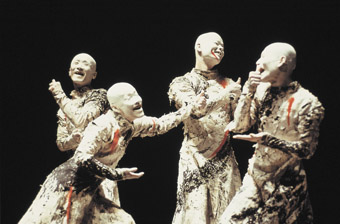
Sankai Juku, Kagemi, Beyond the Metaphors of Mirrors
photo Jacques Denarnaud
Sankai Juku, Kagemi, Beyond the Metaphors of Mirrors
THERE IS SOMETHING CHURCH-LIKE ABOUT THE VICTORIAN ARTS CENTRE, WITH ITS MELBOURNE FESTIVAL RITUALS OF MASS ATTENDANCE AND CELEBRATORY APPRECIATION. ROBERT WILSON ENHANCED THIS ELEMENT OF RELIGIOUS CEREMONY IN THE TEMPTATION OF SAINT ANTHONY, LIGHTING ITS CAVERNOUS STATE THEATRE ALONG THE LINES OF A MODERN-DAY CHURCH. HIS CAST OF AFRICAN-AMERICAN ARTISTS DULY PROCESSED INTO THE SPACE IN RICHLY COLORED ROBES, SITUATING FLAUBERT’S WORK ON SAINT ANTHONY WITHIN A PARTICULAR MUSICAL MILIEU.
robert wilson
Wilson’s esteemed collaborator, Bernice Johnson Reagon, exercised her extensive knowledge of the musical/spiritual heritage of African-American culture in writing the music and libretto for this work. Reagon’s background in civil rights, historical research and musical performance gave the production depth and credibility. Its series of songs progressed from the singing of spritiuals through to blues, jazz and into hip hop.
The story is embroidered around St Anthony’s ascetic retreat into the desert. Though pivotal, St Anthony was upstaged by a series of luscious figures and musical numbers embodying the temptations of sin, sex and worldly dominion, all aimed at corrupting the saint’s spiritual purpose. The power of colour, through costuming and Wilson’s characteristic fulsome washes, contrasted with the singularity of white —the sign of spiritual purity. Red, blue, purple, hellfire, sizzling sexual desire, the heat of passion and worldly seduction—I would have definitely opted for the snake over the rather wan St Anthony. The production incorporated a range of performers from young to old, lithe to substantial. If the older performers suggested frailty with their slow movements and walking sticks, their voices resonated with the aged richness of a Chambertin purloined from Flaubert’s celebrated cellar.
sankai juku
While Wilson’s distinctive usage of colour facilitated bold immersive experiences, the palette elaborated in Sankai Juku’s work was much more subtle, a set of tonal variations suited to the refined gestures of Amagatsu’s Butoh work. Kagami, Beyond the Metaphors of Mirrors opened with a square floor covered in white flowers, water lilies that were slowly elevated to expose intertwining bodies nestling underneath. The pace of the movement in Kagami invited the kind of visual contemplation often associated with its inspiring ikebana motif.
Although ikebana is sourced from the natural world, nature and culture come together to make art. The chalked bodies that constitute Sankai Juku are living, mobile subjects. Their juxtaposition created tableaux of human, cultural significance. The variations in pace, relationship to a defined field of action, and changing subordination to light and darkness created a level of abstraction that was simultaneously pure and contaminated. The purity of the abstraction was achieved by draining the whole scene of everyday colour, bleeding the mundane out of the movement. And yet, there is a limit to the abstraction of art. That limit was clearly breached in one scene where the performers drew red lines on each other, quietly desecrating the human dignity of the other. Dionysius ruptures the quiet clarity of Apollo. Like many Japanese artforms, this was a very pared back piece, delicate but clear.
merce cunningham
Writing about Merce Cunningham’s work I feel a certain ambivalence. Cunningham was a major influence in the development of modern dance, particularly in the US. He pursued a kind of abstraction and artistic collaboration that lent distinctive contingency to his work, in contrast to narrative forms or naturalist modes of dance. Although Balanchine also worked a kind of abstraction into ballet, Cunningham displaced ballet’s lexicon, incorporating spirals throughout the torso and parallel positions rather than turn-out. One of my difficulties is that, with the advantage of time and subsequent developments in dance, to my eyes, the dancing itself is nevertheless immersed in the legacy of ballet. This was suggested by a kinaesthetic texture in Program A, a terse sleekness to the movement which was enhanced by the choice of lycra, the pace of the movement and the muscular tone of the dancers. How then to afford proper historical respect to Cunnigham’s artistic significance for modern dance whilst dealing with a perception which is formed out of subsequent developments in (post)modern dance?
One way of doing this might be to draw out the differences between the pieces in Program A, which spans a colossal 50 years. Suite for Five was first performed in 1956, whereas eyeSpace premiered in 2006. In the latter work, the audience listened to iPods in order to experience the soundtrack independently of the dancers, to rupture the link between music and movement. The ability to shift between the onstage music and the aural difference of the headphones produced a really interesting experience of the flow and temporality of the dancing in eyeSpace. The sensory effect of the sound impacted on the experience of the movement, raising questions about the perception of rhythm in the body.
Since he has been less mobile, Cunningham has engaged with computer technologies in order to create new work. BIPED, which was first shown in 1999, drew on motion capture technologies to create a beautiful curtain of virtual movement, which was juxtaposed against working bodies in the space. The use of lighting created the feeling that the dancers were appearing from nowhere and likewise receding into nothingness—a nice parallel to the appearance and disappearance of the images. The movement also manifested a silicon syntax that somewhat decentred the ongoing distinctive character of Cunningham’s choreography. All in all, this was an enjoyable and instructive experience. It is rare to see seminal dance work that hails from so many years ago, still alive in the hands of its artistic creator.
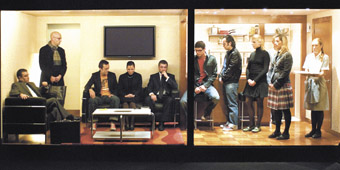
European House, Teatre Lliure
photo Ros Ribas
European House, Teatre Lliure
teatre lliure
Spanish company, Teatre Lliure presented European House, a contemporary reworking of Hamlet. All the main features are present, the death of the father, appearance of his ghost, seduction of the mother by the brother, a romantic liaison involving the young man. But the mise en scène is different—the drama unfolding simultaneously in an entire house opened up dolls-house style. There is no spoken text but each room is miked for sounds of urination, cooking, washing. We watch the family gathering after the funeral, ‘Hamlet’ taking a shower, the young people listening to music, the brother’s seduction of the new widow. Instead of Hamlet’s famous soliloquy, a message is flashed onscreen—”Choose to live and make changes or simply die in life”—a lesson in cultural critique instead of personal crisis.
This anatomy of bourgeois family life was shown but not spoken. Its presentation of modern-day funereal rites suggested very clear social rituals, which were set against improvised interactions between cast members. This made for a strange piece which was nonetheless compelling. Personally, I found the textual message didactic and simplistic, as if the lack of spoken text had to be compensated for. Instead of Hamlet’s questions, we are challenged from the anonymous vantage of the billboard. Are things that bad that we cannot bear to make our own interpretations without guidance from above? Maybe, maybe not—is that the question?
Melbourne International Arts Festival: The Temptation of St Anthony, direction, set, lighting design Robert Wilson, composer, librettist Bernice Johnson Reagon, State Theatre, Oct 11-14; Sankai Juku, Kagemi, Beyond the Metaphors of Mirrors, director, choreographer, designer Ushio Amagatsu, State Theatre, Oct 18-20; Merce Cunningham Dance Company, Program A, choreography Merce Cunningham, State Theatre, Oct 24-25; European House, Teatre Lliure, director Àlex Rigola, Playhouse, Oct 24-27; Victorian Arts Centre
RealTime issue #82 Dec-Jan 2007 pg. 10
© Philipa Rothfield; for permission to reproduce apply to realtime@realtimearts.net
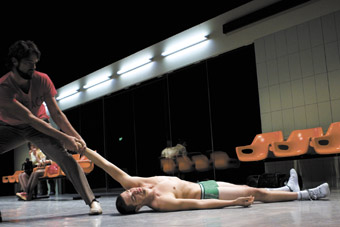
Guy Ryan, Matt Cornell, This Show Is About People
photo Stephen Oxenbury
Guy Ryan, Matt Cornell, This Show Is About People
JOHN BAILEY SEES AUSTRALIAN CHOREOGRAPHER SHAUN PARKER’S FIRST MAJOR WORK, THIS SHOW IS ABOUT PEOPLE, BARRIE KOSKY’S ADAPTATION FOR THE STAGE OF EDGAR ALLEN POE’S HORROR CLASSIC, THE TELL-TALE HEART PERFORMED BY AUSTRIAN ACTOR AND SINGER MARTIN NIEDERMAIR, PROVOCATIVE PARIS-BASED CHOREOGRAPHER JEROME BEL’S THE SHOW MUST GO ON, AND MELBOURNE’S MIXED ABILITY PERFORMING GROUP RAWCUS PRESENTING THEIR NEW WORK, HUNGER, IN COLLABORATION WITH THE MELBOURNE SYMPHONY ORCHESTRA.
shaun parker
Shaun Parker’s This Show is About People is a messy, incoherent furnace of competing forces. It is also entirely unique and utterly wonderful. It begins softly, a handful of ordinary-seeming people idling in a setting which could be a bus station waiting room, or an airport, or an underground bunker, or something other. But the moment a retiring man in vest and brown slacks suddenly bursts into an angelic medieval soprano and, somewhere else, a hulking boho-type begins dragging partially clad dancers from a vending machine, we know we’re in strange territory.
This aspect of the unexpected is what makes This Show such perfect arts festival fare. Throughout, its ability to provoke shock and wonder isn’t simply novelty for its own sake. It urges its audience to discover what exactly is happening here. Unlike much performance which revels in the play of ambiguity to hide an essential lack of meaning, This Show does promise something meaningful at its core—but you’ll have to work to find out what it is, and it’s likely that no two audience members will come away with the same conclusion.
Of course, the title gives a hint. But what about these people? There’s no narrative to the performance as such, which straddles contemporary dance (often heavily influenced by breakdancing with its floorwork, headspins and body rolls), spoken word, mime, theatre and more. The characters do maintain a certain consistency, but they’re not types—they’re fascinating assemblages of contradiction that develop in furtive, subtle ways, but are never pinned down in service of a grander function.
What does run throughout the piece, however, seems to be an interest in exploring the various ways people attempt to grapple with their own isolation in the universe. Philosophy and theology feature, as does war, work, art. A recurrent motif is the manipulation of one person by another—one dancer ‘paints’ another’s motion, for instance, her mimed brushstrokes mimicking a puppeteer’s control.
It doesn’t add up to any particular point, and even concepts such as war are injected with a giddy playfulness—mass combat played out by fingers engaging one another on the battlefield of a human body. At times beautiful and often gesturing toward the profound, This Show only stumbles during the occasional spoken section in which latent themes are rendered too starkly, losing their shimmering edge of transcendence by being addressed directly. At its best, it is during moments of silence or in the spaces between meanings that Parker’s work achieves the promise of something higher to which its subjects aspire.
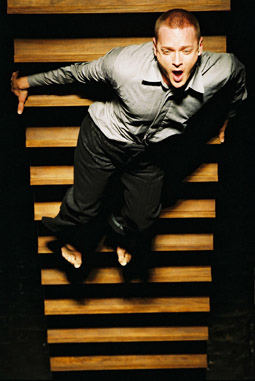
Martin Niedermair, The Tell Tale Heart
photo Nick Mangafas
Martin Niedermair, The Tell Tale Heart
barrie kosky
Silence also opens Barrie Kosky’s masterful new work, The Tell-Tale Heart. It begins before the deep red curtain is raised, the house lights dimming at an agonising, nearly imperceptible rate and leaving nothing but a heart-shaped after image disappearing from our retinas. It happens slowly, too slowly, but time, in this work, is of the essence.
Poe’s original story is a tiny one, all the more effective for its brevity. The strangeness of the narrator’s voice is sustained throughout, but by denying the reader a lengthier engagement with his fevered mind, the central question he puts to us—am I mad?—cannot be easily answered. Certainly, everything from his murderous admissions to his spurious motivations would seem on the face of it the rantings of a psychopath, but Poe does not provide a satisfactory and rounded portrait of a killer. Instead, he limits his reader’s understanding of this fractured consciousness by restricting our view of events to the first person.
The story is simple. A man recounts a murder he has committed and the (perhaps hallucinated) thudding heart—“such as a watch makes when enveloped in cotton”—that leads to his discovery. Kosky has admirably embraced the story’s deceptively uncanny effect in two ways—firstly by deliberately, and at times frustratingly, foregrounding time and duration as a crucial element in theatre. This is a theatre of ellipses, in which the unsaid holds as much weight as the spoken word. Kosky stretches the short text over more than an hour, but holds the attention with an iron grip by imbuing each pause with much freight.
Secondly, director and performer offer a counterpoint to the drama of a mental insularity through the extremes of the human body. The madness of The Tell-Tale Heart’s narrator is accented by his logic, his attempts to explain his actions by pouring them into the empty moulds of rhetoric and rationality. The absurdity of this process is emphasised through the corporeal hysteria of performer Martin Niedermair’s body. As he confesses his crimes in pleading and serious tones, his initially respectable figure—impeccably suited and clean-shaven—quickly becomes a mass of symptoms, a pyrotechnically neurotic body at odds with itself. In this respect alone, Niedermair’s performance makes for compelling viewing, his body soon drenched in perspiration, spittle and froth spraying intermittently, and blood—of course, blood—rising to fill his quivering cheeks.
The piece ends as it began, in darkness and silence, though the roar of an appreciative audience quickly dispels this final moment of contemplation. Audiences, in Melbourne at least, usually find a way to fill the void.
jerome bel
Jerome Bel’s contribution to this year’s festival, The Show Must Go On, saw a similarly uneasy attitude towards silence—at a crucial point, Simon and Garfunkel’s “The Sound of Silence” is played in darkness, but in keeping with the song’s lyrics is only heard during the chorus line that makes up its title. For the remainder of its duration, silence is all. Some audience members laugh, a few mutter to one another while others hush them loudly. Are we supposed to be silent? Why is this even happening?
We can’t look to Bel for answers, since he seems to have abdicated his role as creator. The work itself consists of a swag of popular songs, the chorus of each of which becomes a command for the 18 non-dancers who occasionally appear on stage. If there’s any actual choreography in play, it seems to be dictated by the songs themselves and interpreted by the performers alone. Bel even seems to clue us in on his unwillingness to take on the god-like role of artistic creator with the opening number from Hair, “Let the Sun Shine In.” But if there’s a god letting there be light here, he’s a retiring sort who rarely shows his hand again.
That so little actually occurs throughout the work’s running time seems important. The music is catchy and banal, from Queen to Edith Piaf, but each song provides only a single image, a punctum, and often offers nothing but a blank stage or a few bodies lying around. It is, for the most part, a show about negative space, about (I suppose) the vacuity of disposable popular music and the way untrained, spontaneous movement is as valid as the trained perfection of traditional choreography. But in so obviously refusing his audience an overarching authorial intent, Bel becomes a structuring absence, a choreographer who has simply made pedestrian, ordinary movement his thing.
This has done well to establish a fine reputation, and The Show Must Go On is certainly a lot of fun, but it doesn’t tread conceptual territory too distant from the blank canvases and silent scores of those working in other media half a century ago. If it does start a few audience scuffles, however, that might be something.
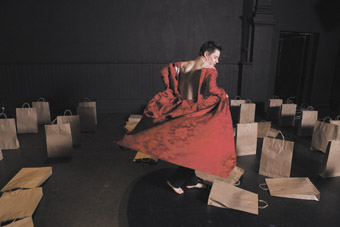
Paul Matley, Hunger, Rawcus
photo Brett Brogan
Paul Matley, Hunger, Rawcus
rawcus
In a few short years, Melbourne company rawcus has produced a small body of work of an outstanding quality which, for me, ranks among the most exciting of the moment. The company is composed of performers with and without disabilities and creates non-narrative works which explore the experiences of its members. The last work, Not Dead Yet, was an incredibly moving investigation of death and its effects on the lives of performers. Hunger turns the spotlight onto an equally rich topic, love, and while lacking the sublime effect of the previous work nonetheless contains moments of unforgettable power.
The new work was developed in collaboration with the Melbourne Symphony Orchestra, and features MSO musicians accompanying and frequently becoming a part of the action on stage. The music itself, by 19th century composers and Jethro Woodward, is gorgeous, but in conjunction with the performance becomes something more—a character itself.
Romantic imagery abounds, and much of the work plays with the tension between desire and the brute facts of life. For some this desire is to make a meaningful connection with another, for some it’s simply to be heard, and for others it’s hot sex or a caring boyfriend they’re longing for.
So far rawcus’ output has been small, but the company deserves far greater attention and support. Hunger, at least, is a festival event that could never be met by silence.
Melbourne International Arts Festival: This Show is About People, director, choreographer Shaun Parker, performers Anton, Matt Cornell, Marnie Palomares, Guy Ryan, Jarnie Birmingham, Tobias Coles, Sylvia Entcheva, Mara Kiek, Llew Kiek, musical directors Mara Kiek, Llew Kiek, designer Robert Cousins, sound design Peter Kennard, CUB Malthouse, Oct 11-14; The Tell-Tale Heart, director Barrie Kosky, performer Martin Niedermair, music played by Barrie Kosky, original music Barrie Kosky, dramaturgy Susanne Wolff, design Michael Zerz, Alfred Mayerhofer, set and costumes adapted by Anna Tregoan, lighting design adapted by Paul Jackson, Malthouse Theatre Workshop, Oct 10-20; The Show Must Go On, concept, direction Jérôme Bel, DJ Gilles, Gentner, Victorian Arts Centre, Oct 16-18; Hunger, devised by rawcus and the Melbourne Symphony Orchestra, director Kate Sulan, set & costume designer Emily Barrie, lighting Richard Vabre, sound designer Jethro Woodward, dramaturg Ingrid Voorendt, Arts house, Meat Market, Oct 22-24
RealTime issue #82 Dec-Jan 2007 pg. 8
© John Bailey; for permission to reproduce apply to realtime@realtimearts.net
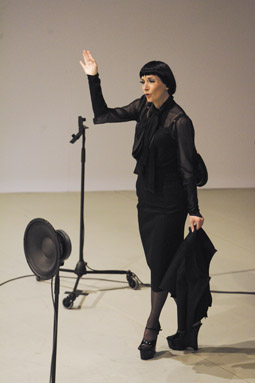
Joanna Dudley, The Scorpionfish
photo James Knowler
Joanna Dudley, The Scorpionfish
IT IS EASY TO FEEL UNEASY AT ALL TOO COMFORTABLE ENCOUNTERS WITH THE EXOTIC. THERE IS AN INDULGENT AIR OF LASSITUDE ABOUT THE ARMCHAIR TRAVELLER OF COLONIAL TIMES OR THE COLLECTOR OF OBJETS D’ART FROM FOREIGN PARTS. THEIR EXOTIC TASTES AND PLEASURES TAKEN NOW SEEM INSUPPORTABLE. THESE DAYS WE PREFER MORE ACTIVE, MORE ENGAGED ENCOUNTERS WITH THE UNFAMILIAR AND REMOTE. WE FAVOUR FULL IMMERSION OVER CONTEMPLATION FROM A DISTANCE.
Consider the allure of do-it-yourself backpacking, with its promise of cultural encounters and its marketing of culture shock. Such authenticity of immersion is denied those who prefer their holidays pre-packaged and their encounters mediated through the windows of a bus. But if in the future opportunities for excursions into foreign lands or the wilderness are to contract, we may come to value more acutely the exotic species in our own gardens, aquariums and zoos—and in those performances which extend an invitation to imaginatively encounter what lies beyond the horizons of the known. Indeed, theatrical performance excels at enabling encounters with the exotic, the unusual, the unfamiliar and the strange in humans and their cultures, and it does so under resource restricted conditions with relative comfort, easy access and minimal distress.
In many respects, this was the invitation of the OzAsia festival, the Adelaide Festival Centre’s inaugural celebration of culture and performance from Asia, Australia and Asian-Australia. OzAsia extended an invitation to encounter cultural difference, and it did so with the promise that we may recognise our own culture anew. However, global flows of culture and performance have created such convoluted mixtures of the familiar and the strange as to confound our certainties.
the scorpionfish
Kroncong, for example, is a kind of pop music from Java. It provides some of the musical score for The Scorpionfish, a piece of music theatre from Joanna Dudley and Rufus Didwiszus which had its premiere performance in Berlin in January. The rhythms, harmonies and instrumentation of kroncong are familiar enough to western ears. Historically, they are derived from fado, the songs sung by the Portuguese who established trading posts in eastern Indonesia in the 16th century.
But Kroncong is a hybrid style of music, a blend of European and Javanese, with a complex social history. Once the preserve of Jakarta’s urban poor, it was adopted by the nationalists in the 1940s as the people’s music and it has remained in nostalgic favour among the Sukarno generation, though younger people came to regard its nationalist associations with suspicion.
In Dudley and Didwiszus’s performance, however, kroncong is radically decontextualised. Its vocal qualities and lyrics, in particular, are thoroughly estranged from time and place. The work’s title is borrowed from Nicolas Bouvier’s book of travels in Sri Lanka. The subtitle, ‘Song and Dance in Tropical Downtown’, is geographically generic. The set–three white walls, white floor, no doors–is stark and post-dramatic.
Dudley, an Anglo-Australian performer originally from Adelaide, transforms herself into the Scorpionfish. An exotic creature from the abstract East, she lives in a tropical aquarium of urban oriental sounds emitted from ominous black speaker cones on stands. The soundscape is impressive: chirping frogs, rain and radio static, gamelan gongs and bird song.
Dudley performs solo, singing and dancing with nervously compelling diva poise. Her costumes form a minimalist suite of Eurasian femmes-fatale: from business style to geometric geisha, cabaret lingerie to Mandarin nightclub. Her European affectation of Asiatic grace is sustained to curtain call. The performance is executed with inscrutable precision, its tone is cute at times, even seductive, but always calculated and sometimes cold.
The Scorpionfish is a performance in the grand orientalist tradition. From the modernists (Craig, Yeats, Brecht and Artaud) to the interculturalists (Grotowski, Barba, Brook and Wilson), western artists have long sought inspiration for stylistic innovation in the performance traditions of Asia. Dudley’s cultural capital as a western artist enabled her to study song and dance in Java. It led to her “becoming embraced as a pop icon in the city of Surakarta”, according to the program.
Yet in The Scorpionfish, Dudley detaches kroncong from its cultural moorings in bodies, time and place. She redeploys it within a European context predetermined by the post-dramatic. In this decontextualising move, The Scorpionfish rendered apparent a latent orientalism propelling interest in OzAsia. I wondered if this work would find an audience in Java.
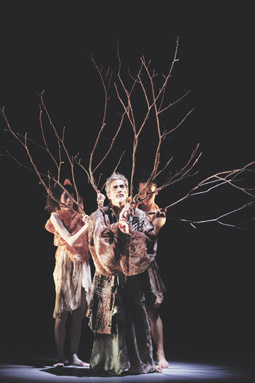
Leigh Warren & Dancers, Wanderlust
photo Hiroyasu Daid
Leigh Warren & Dancers, Wanderlust
wanderlust
Wanderlust, a collaboration between Leigh Warren & Dancers and Japanese dancer and choreographer Uno Man, transcends the orientalist attitude. It had its premiere in Japan in October 2006. Participating in that rich and well supported flow of people, culture and performance between Australia and Japan, Wanderlust followed a different path in search of encounters with the strange.
The work is inspired by the celebrated poetry of Matsuo Basho (1644-1694) who cultivated his haiku through an aesthetic practice of attentive wandering. According to philosopher Thomas Heyd, Basho found it difficult to write poetry “while remaining in one place for very long.” Basho’s wandering aimed to estrange him from the familiar and the known. This experience of estrangement he would deploy in poetry to apprehend the nature of the world anew.
Wanderlust is structured like the memory of a journey. It recalls not every step but scenes along the way. The opening scene, ‘Prelude/First Step’, consists of little more than dancers walking, fading in and out of view. From there the scenes unfold. Creatures are encountered as environments are traversed: Cicada, Stone Woman, Boy’s Day/Carp, Small Islands, Paddy Field, Deer and Forest, Waterfall, Hermitage Lantern and Battle Plain.
Alongside Uno Man, the dancers are Deon Hastie and Jo Roads from Australia, Mako Kawano and Tomohiko Tsujimoto from Japan. The choreography is supple, light and precise, rippling from the core to distal joints and arriving at positions with finely tuned decelerations. At times I feel they dance like birds with hollow bones. But where the pleasure of the work emerges is within the choreographic articulation of the environments.
According to Leigh Warren, the developmental process was unusual. Having analysed the dramaturgy of Basho’s texts, they first created environments of light, space and projection, before choreographing the work. The projected animations from visual designer Tetsutoshi Tabata are extraordinarily beautiful. Simple shapes in plain colours are softly projected onto diaphanous screens amongst which dancers move.
As the scenes unfold, the visual effect is dream-like and elusive. Like a journey, it is utterly compelling in the present, yet difficult to remember as a whole. In the final scene, Moon/Last Breath, Uno Man dances with the exhaustion of old age, but also with the sense of an arrival somewhere other than home.
dis-oriental
Yumi Umiumare’s 20-minute solo work, Dis-Oriental, is also motivated by an experience of estrangement, as attended in the work of Japanese architect Shigeru Ban whose emergency houses built from cardboard tubes address the need for comfort when disasters reduce homes to smoking piles of rubble and the familiar is rendered strange.
Toilet rolls, odd shoes and clothes, a book, a birdhouse and a balloon are the objects which Umiumare plays with and displays in this manic meditation on the necessity of comfort and self-care under conditions of estranged duress. Living well among the unfamiliar is a survival strategy for our time.
The Scorpionfish—Song and Dance in Tropical Downtown, created & performed by Joanna Dudley, creation & scenography Rufus Didwiszus, costumes Bernd Skodzig, choreography Nicola Mascia, sound design Dirk Dresselhaus, Space Theatre, Oct 1-2; Wanderlust by Leigh Warren & Dancers in association with Uno Man, direction, choreography Uno Man, Leigh Warren, dancers Uno Man, Mako Kawano, Tomohiko Tsujimoto, Jo Roads, Deon Hastie, visual design, screen media Tetsutoshi Tabata, composer Stuart Day, lighting Nic Mollison, costumes India Flint, Dunstan Playhouse, Oct 3-6; Dis-Oriental, choreographer, performer Yumi Umiumare, sound design Cat Hope, lighting Richard Vabre, Space Theatre, Adelaide Festival Centre, Sept 28-29; OzAsia Festival 2007: for full program see www.ozasiafestival.com.au
RealTime issue #82 Dec-Jan 2007 pg. 13
© Jonathan Bollen; for permission to reproduce apply to realtime@realtimearts.net
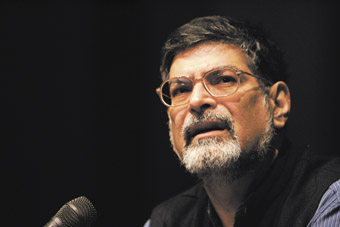
Rustom Bharucha
photo James Knowler
Rustom Bharucha
WHEN A NEW FESTIVAL SPRINGS INTO BEING, IT NEEDS TO DO SOME GROUND-CLEARING TO JUSTIFY ITS EXISTENCE. WHEN THAT FESTIVAL IS ONE DEVOTED TO THE CULTURAL CONNECTIONS BETWEEN AUSTRALIA AND ASIA IN A CITY AS TRADITIONALLY ANGLOCENTRIC AS ADELAIDE, YOU NEED TO ROLL UP YOUR SLEEVES BECAUSE THERE’S SOME SERIOUS WORK TO BE DONE. IT WAS IN THIS SPIRIT THAT WE HUNKERED DOWN TO A TWO-DAY SYMPOSIUM TO LAUNCH THE OZASIA FESTIVAL WHICH DOUGLAS GAUTIER, THE HEAD OF THE ADELAIDE FESTIVAL CENTRE, HOPES TO MAKE AN ANNUAL ADDITION TO HIS CITY’S CULTURAL LANDSCAPE.
Asia and Australia are both complicated places and a variety of issues must be considered when speaking of the possible connections between them: the economic and political contexts; questions of intercultural communication; the multicultural politics of Asian communities in Australia with the tricky business of hyphenated identities; and then the pragmatic stuff about how to turn all of this into a living for working artists. With such a disparate array of terrains in front of us, and with the desire to invite as many voices as possible into these debates, the challenge was for the participants to find points of common interest so that they didn’t simply talk past each other.
Bob Hawke’s opening keynote set up a range of ideas against which several subsequent speakers tried to define their positions. After a brief historical outline (ALP=Asia as opportunity=good; conservatives=Asia as threat=bad) Hawke based his argument on the primacy of economic and trade ties. His argued that Asia—read primarily as China—is increasingly important to Australia’s economic base and implied that the arts should be along for the ride in the superstructure. And besides, the takeaway food here was hell prior to Asian influence.
The challenges flung down were several: is there a justification for intercultural artistic practice that isn’t premised on placing art in the margins of economic life, and is the quality of the pad thai all there is to multiculturalism—an increased sense of cosmopolitanism for skippies to enjoy while they watch the footy on telly?
Penny Wong, Labor Senator from South Australia, showed scant respect for party elders as she rose to this bait, criticising the reduction of Asian influence to marginalised exotica within Australian culture. She pointed out that the central question is not so much the economic possibilities for Australia in Asia, but rather the ways that Asia is within Australia and not something external to it.
This way lies that most nebulous of territories, cultural identity. This is one of those large and comfortably amorphous terms which looks good on the menu but which usually leaves you hungry again pretty quickly. Send in the cultural theorists—or in this case, our second keynote speaker, Rustom Bharucha.
Bharucha, described in the program as a “leading practitioner and theorist of interculturalism,” led off the second day of the symposium with an abstract, yet immensely engaging talk (no easy combination), which considered the general issues on the table, and more specifically, his experiences with the National Cultural Diversity Cluster established in the Australian Performance Laboratory at Flinders University.
He pointed out that, from his position in India, he saw the category of Asia as a construction, in many ways imposed externally. Given the variety of identity positions through which we can all define ourselves, “Asia” is a fairly general one in relation to more immediate options such as nation, gender, class or profession. While Asianness can function as a form of western orientalism, it can also be invoked strategically from within Asia, though Bharucha had stern words for the ways in which this has been used as a pretext for state determinism, as in the case of Singapore.
Bharucha ended with a cogent analysis of Australian cultural policies in the Asia-Pacific, contrasting the Australian government’s increasing interest in expanding markets within the region with its populist cultural xenophobia on the home front. While many of the speakers couched their calls for increased cultural outwardness in the language of multiculturalism, Bharucha adopted a more critical approach to this rather vexed term, noting that mythicising ethnic origin was less important than other everyday negotiations. He criticised the construction of the national based on past traditions, and sought to replace it with a more complex (his favourite word) sense of the nation as an ongoing activity, the sum total of actions taken in the public sphere aimed at greater inclusivity.
The political analysis offered here lingered like a slightly bad smell over much of the symposium. Lachlan Strahan of the Department of Foreign Affairs and Trade noted that his department funds artistic activity as a form of cultural diplomacy in order to project an image of Australia “as a tolerant, innovative country.” This sat uneasily with the obvious fact that most people interested in exploring the cultural relations between Australia and Asian countries are frequently predisposed towards criticism of current Australian government policy. As much as cultural exchange eludes the control of governments, there is no escaping the way that the mechanisms through which working artists explore these more diffuse connections are intimately connected to the purse strings of foreign governments (those of China and Indonesia) and alien governments (those of John Howard and Alexander Downer).
If the initial fault line under analysis was the difference between Australia and Asia, other more immediate fissures were quick to appear. Primary among these was the problem of intersection between theoretical discourse and artistic practice. Bharucha’s keynote talk was followed by a panel discussion by the artists who had residencies at Flinders Cluster (and whose work, by the way, formed a hefty chunk of the OzAsia program.)
Artists as wildly different as monologist-photographer William Yang, violinist-stand up comic Hung Le and visual artist Hossein Valamanesh were asked to speak briefly on how they defined culture. The fragmentary and rather embarrassed responses pointed to the problems of practising artists being asked to reflect upon such abstract generalities, when what they normally do is something quite tangibly specific that doesn’t require such self-conscious abstractions.
If Bharucha’s favourite term was complexity, the value of many artists is that they can convert the complexities of the world into small chunks of insightful simplicity by filtering them through their craft. Woyciech Pisarek and Yumi Umiumare wanted to tell stories about how, unbeknownst to them, living in Australia imprinted a new culture on their bodies because, now when they return to their countries of birth, they physically experience themselves as foreigners in these defamiliarised lands. Others, such as playwright John Romeril and theatre entrepreneur Michiko Aoki, attempted to explain the connections across cultures as a matter of lived experience by narrating their own experiences as nothing more mysterious than going to new lands and showing an interest in what they saw there.
OzAsia 2007 raised a host of related issues in an unruly way—which is perhaps the best start you can hope for. Cultural debates only cohere easily in the hands of ideologues. If nations are about the way people imagine themselves and others, art clearly has a role to play in affecting those imaginings. But both art and nation states involve everyday actions as well as simply imagining. As the OzAsia festival gets people to think about the connections they have, and might have, to Asia, this will involve looking inward as well as outward, at abstract beliefs and at everyday practices, at how art and the social world intersect in constantly changing ways.
OzAsia Festival 2007, Cultural Symposium, OzAsia—The Big Ideas, Space Theatre, Adelaide Festival Centre, Adelaide, Sept 22-23
RealTime issue #82 Dec-Jan 2007 pg. 12
© Mike Walsh; for permission to reproduce apply to realtime@realtimearts.net

Gabriella Smart
photo Mark
Gabriella Smart
THE OZASIA FESTIVAL, BRAINCHILD OF ADELAIDE FESTIVAL CENTRE CEO DOUGLAS GAUTIER, IS A GREAT NEW ADDITION TO ADELAIDE’S CULTURAL CALENDAR; ONE CAN ONLY WONDER WHY IT HASN’T HAPPENED BEFORE. WHITE SHADOW, A CONCERT OF EAST ASIAN CONTEMPORARY MUSIC WITH A STRONG CHINESE REPRESENTATION, WAS AN OUTSTANDING EVENT IN THE FESTIVAL PROGRAM. PIANIST GABRIELLA SMART WAS BOTH THE CURATOR AND A VITAL PLAYER IN WHITE SHADOW, WHICH BROUGHT TOGETHER SOME OF THE COUNTRY’S BEST CONTEMPORARY PERFORMERS—VIOLINISTS NATSUKO YOSHIMOTO AND JAMES CUDDEFORD, PERCUSSIONISTS CLAIRE EDWARDES, VANESSA TOMLINSON AND PAUL LIN, AND OBOIST SEUNG-EUN LEE.
The story of the engagement of China with Western classical music is long, complex and fascinating. For nearly a century it has been a battlefield on which sometimes violent ideological conflicts have been conducted. It is a story of individual heroism and cowardice, of bureaucratic intrigue and political oppression, of tragedy and farce; great material indeed for a novel yet to be written.
The wholesale repression of Western music during the Cultural Revolution is a distant memory. The millions of young Chinese now studying the piano or the violin—more, it is said, than the entire population of Australia—were not even born then. But the ideological battles of the past cast a long shadow. The apparently insatiable appetite of the Chinese for bourgeois European music of the 19th century has not led to a corresponding interest in the music of its own composers, who have assimilated the techniques of the Western avant garde.
It is significant that the Chinese composer best known in the West today is Tan Dun, who settled in the United States and made his reputation there. Tan Dun was a celebrity in the West before he became well known in China. There is a parallel here to the Western fascination with contemporary Chinese art; it is primarily Western collectors paying big money for works by Chinese artists who are on the fringes of their own society. Tan Dun’s C-A-G-E (Fingering for Piano) is a tribute to John Cage, a composer whose fascination with chance procedures and the ancient classic I Ching could be expected to appeal to Chinese musicians, just as his reasoned espousal of anarchism would be anathema to the Chinese authorities. It was considerate of John Cage to be born with a surname of pronounced pentatonic character, allowing Tan Dun to use the letters of his name in a composition that alludes equally to Cage’s own innovative treatment of the piano, and to techniques of playing the pi’pa. It was superbly interpreted by Gabriella Smart.
Guo Wenjing creates an engaging piece of choreography in Parade, a work performed by three percussionists standing around a table on which are arrayed a collection of Chinese cymbals. It’s quite a tour-de-force for the players as they weave in and out of the narrowly constrained performance space; on this occasion a music stand prevented most of the audience from seeing exactly what was going on. Fortunately the work is as intriguing to the ear as it is to the eye.
The largest work on the program was Flavour of Bashu by Jia Daqun, which required the combined forces of two violinists, three percussionists and pianist. The title alludes to the province of Sichuan, famous for spicy food, the rapidly disappearing scenery of the Three Gorges, and its own unique brand of traditional opera. The latter two of these three themes are directly alluded to in the music—and if food is not specifically mentioned, that can only be because it is the ever-present subtext for all Chinese culture. This was an exciting performance, in which one could sense that the performers were taking risks in order to convey the vitality and intensity of the composer’s vision. James Cuddeford and Natsuko Yoshimoto were particularly effective in their use of portamento and microtonal intonation to convey the uniquely Chinese flavour of their parts. The percussion parts are full of colour, including the obligatory cymbal crashes with their distinctive pitch-bending character, while the piano seems to fulfil a continuo role in holding it all together.
The remainder of the program included Toru Takemitsu’s Rocking Mirror Daybreak, a series of four connected pieces for two violins—played by Cuddeford and Yoshimoto—which, in contrast to the highly coloured music around it, was a model of monochromatic restraint and a haven of tranquillity. It was certainly far removed from the convulsive gestures of White Shadow by Korean composer In-Sun Cho, who has thoroughly imbibed the language of the Central European avant-garde. This thorny piece, bristling with multiphonics and sudden, violent disruptions, was played with conviction and intensity by Seung-Eun Lee and Gabriella Smart.
OzAsia Festival: Soundstream Contemporary Music Ensemble, White Shadow, piano Gabriella Smart, violins Natsuko Yoshimoto, James Cuddeford, percussion Claire Edwardes, Vanessa Tomlinson, Paul Lin, oboe Seung-Eun Lee, Dunstan Playhouse, Adelaide Festival Centre, Sept 25
RealTime issue #82 Dec-Jan 2007 pg. 14
© Stephen Whittington; for permission to reproduce apply to realtime@realtimearts.net
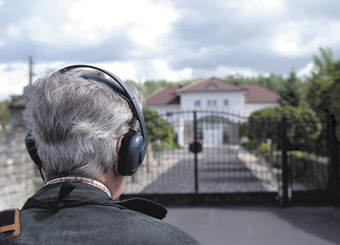
Audiowalk Gusen, The Invisible Camp
photo Christoph Mayer chm
Audiowalk Gusen, The Invisible Camp
THE OLD MAN IS QUIETLY PRUNING HIS ROSE BUSH BEHIND THE HEDGE AS THE VOICE IN MY HEADPHONES ASKS ME TO LOOK AT THE THREE STEPS THAT LEAD TO THE ENTRANCE OF THIS QUIET SUBURBAN DWELLING. IT WAS THROUGH THIS DOOR 60 YEARS AGO THAT SS OFFICERS FILED TO SEEK ‘COMFORT’ WITH FEMALE PRISONERS FORCED INTO PROSTITUTION. THE MALE VOICE CONTINUES WITH A DESCRIPTION OF HOW AFTER THE WAR, HE REMODELLED THE HOUSE, DEMOLISHING THE TWO METRE WIDE WOODEN CUBICLES TO MAKE DOMESTIC ROOMS. I LOOK AT THE OLD MAN PRUNING THE ROSES BUT HE DOESN’T RETURN MY GAZE.
A female voice leads me around the corner into another quiet street; it was here she says, that an SS soldier halted her during a visit to the camp dental clinic. While she waited, two men threw hessian sacks from a truck, dashing them against the wall exactly where I am now standing; the sacks contained children. When the woman was allowed to continue she saw the roadway was covered in blood.
I pass Spiegelplatzstrasse (playground street) walking past gaggles of happy, healthy kids, riding BMX bikes and drawing hopscotch grids in chalk. I am beginning to feel very uncomfortable and uncertain whether I should be nodding a greeting to the suburban housewives walking past with their baby strollers—they know what I am listening to, even though, as the work’s author later told me, no-one in the community has chosen to experience “The Invisible Camp.” This is an Ars Electronica project, and I am taking an audio tour through a small village built on the site of Gusen I and II, the most notorious forced labour camps of the Third Reich. Here 37,000 political prisoners were worked to death building the underground bunkers that housed the Messerschmitt Jet bomber factory. More powerful and disturbing than any filmed documentary, the juxtaposition of memory with the barely perceptible architectural traces of the camp that remain in this sleepy suburb of happy residents is chilling.
sous les pavés, la plage!
As they used to say in Paris ’68 (and may yet say again in Sarkoland), “beneath the street, the beach.” The Ars Electronica festival theme, Goodbye Privacy, was symbolised by images of a beach, more specifically Bondi Beach, which furnished the metaphor for a public space in which people choose to display, or rather expose, a good deal of themselves while maintaining a robust sense of individuality. Linz took the metaphor a step further, by physically constructing a sandy beach in Pfarrplatz (not a credible threat to Bondi!) and equipping it with a DJ kiosk, beach chairs et al. Unfortunately, chill was what this chill-out space did best, as the weather was worse than nasty and the opening took place in a covered courtyard of the nearby Kunst Universität where director Gerfried Stocker’s wistful remarks touched more than once upon topless Australian sunbathers!
At the Gala event at the Brüknerhaus, Australians had the front row seats and all the Austrian VIPs on stage had Second Life avatars floating behind them as they presented their speeches and awarded the Golden Nicas (Oscars with wings but no heads or arms) to the lucky winners. The obvious joke circulating among the winning SymbioticA crew from Australia was how we might grow the missing body parts back!
club med
The Second Life sub-theme manifested in the physical domain as an entire street of converted shops and restaurants, reminiscent of a Philip K Dick scenario—replete with an ex-Chinese restaurant, closed down for serving dog food, re-opened as a cyber-bar serving schnapps—and maybe dog food? Justine Cooper (Aus/US) set up shop (sic) peddling an almost believable parody [apparently believed by disappointed Americans according to recent press reports. Eds] of a Yuppie drug HAVIDOL™, a promise of effortless Gain and no Pain. Cloying American sales voices and spray-on smiles coax punters toward arrays of Baby Blue merchandise—actually the shiny blue pills in the large jars turned out to be a very tasty malted chocolate (at least I hope that’s what they were as I ate handfuls of them!). Reality hybridising with fantasy and fiction creeping into real life, I am even more convinced that Second Life is Club Med populated by Ken and Barbie dolls sporting repulsive jewellery, who in reality are accountants and dental receptionists. Anyhow, there is more than enough to keep most of us busy in Life No.1!
alternative interaction models
Ars Electronica encapsulates the broadest spectrum of ‘new media’ in both name and as an event, implying an embrace, for example, of the earliest experiments in electronic music or kinetic sculpture through to contemporary activist art and current commercial digital animation. Such a broad historical and thematic horizon makes Ars Electronica a robust event with a high degree of integrity and the capacity to be critically self-reflexive.
It is this breadth of vision, which permits the inclusion of the Conservation of Intimacy, a major installation of whimsical human-powered wooden kinetic sculptures by Bernie Lubell (USA). These anarchic Heath Robinson-style inventions, inspired by the 19th century physiological experiments of Etienne Jules Marey, demand a high level of direct physical engagement in order to activate pneumatic pumps that operate the work. Lubell’s oeuvre seems to originate from an era before electricity, let alone computers, and they playfully invert the slick, the polished and the super-cool auras that frequently plague new media practice (and practitioners).
Ashok Sukumaran (India), awarded the Golden Nica in the Interactive category for Park View Hotel, shares Lubell’s irreverence by establishing quite simple interactive relationships that allow the possibility of dysfunction; users can jam, upset and deny the system. Perhaps forms of interaction which are antagonistic, broken or refused are more realistic modes than those complicit ones implied in nearly all forms of new media arts. In general, most cultural forms propose interactive relationships that are ‘composed’ within hermetic worlds, not substantially different from the rules of Monopoly, and we all know how boring that is!
Another Award of Distinction in the Interactive category was pulled by Leon Cmielewski and Josephine Starrs (Aus) for their elegant work Seeker (RT78, p26) which, in the process of mapping one’s personal geospatial history, allows the interactor to access layers of data relating to global resource conflicts and associated human displacement. The highly resolved graphical display and beautiful panoramic landscape imagery belies the implied violence that the data visualisation represents; likewise I found the authors’ claim (made during the conference) that the work was non-political to be somewhat disingenuous. There is a Bermuda Triangle bounded on one side by subtle work that elicits a genuine ideological or political response, flanked on the second by old fashioned in-your-face agit-prop and, on the third, by work that simply aestheticises pain and disaster—only one of these strategies has integrity.
growing hybrids, selling shit
Ars Electronica inaugurated a new Hybrid category this year, noting a shift in the interests of new media artists beyond information technologies and computer networks towards the areas of materials technologies—biological, chemical, mechanical and (watch this space) nano-technology. Rather than simply working with the vectors of transmission and transformation of data, artists are now engaging with these others as material manifestations. The emphasis on hybridisation of forms and concomitant interdependencies and cultural mixing reformulates the easily jaded term ‘new media’, steering it away from the digital ghetto.
In this context, it is fitting that the inaugural Hybrid Golden Nica should be awarded to the work of the SymbioticA Laboratory, which is a paradigm of a collective, inter-disciplinary and hybrid practice. The Lab has recently become a “Centre” in the University of Western Australia and has initiated a Masters Degree in Biological Art, both developments attesting to the unique and vital opportunities SymbioticA offers and the high regard UWA has for its work.
The SymbioticA exhibition for Ars Electronica comprised five works, curated to demonstrate the wide scope of the work undertaken in the Lab. They included a DNA fingerprinting performance by Paul Vanouse (USA); a video projection work with a maze-like screen manufactured from collagen extracted from rats’ tails by Boo Chapple; an exquisite dress coloured by fungal material created by Donna Franklin; a live tissue culture work by Oron Catts and Ionat Zurr (aka Tissue Culture and Art) and a double data projection installation about sex, which included a (captive) audience of hundreds of crickets (by yours truly).
An unpleasant odour drifts down the corridor. Cloaco, by Belgian artist Wim Devoy, duplicates the human digestive tract, something Vaucanson attempted with his famous Canard Digérateur automata (The Digesting Duck, 1738), which the inventor falsely claimed could eat and shit. However, Cloaco really does the business as it mulches through several gourmet meals a day, but like all automata, it invokes the hubris of breaking the taboo of creating life. But I guess here we are only contemplating the rear end of creation and its manna from heaven. A secondary layer of critique connects the cycles of conspicuous consumption and attendant conspicuous waste directly to the controlling mechanism of Global Capital. Devoy has managed to register Cloaco Ltd on the Belgian stock exchange (using 100 Kilos of shit as equity) and now trades shit on the open market. Well, as they used to say in the old country, “Where there’s muck, there’s brass!”
Festival Ars Electronica 2007, Goodbye Privacy, Linz, Austria, Sept 5-11, www.aec.at/en/festival2007
RealTime issue #82 Dec-Jan 2007 pg. 15
© Nigel Helyer; for permission to reproduce apply to realtime@realtimearts.net
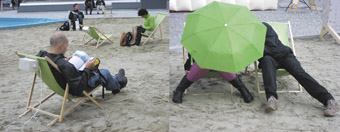
Pfarrplatz Lido (Second Life/Bondi Beach) – Ars Electronica Futurela
photo Somaya Langley
Pfarrplatz Lido (Second Life/Bondi Beach) – Ars Electronica Futurela
AN AUSTRALIAN MEDIA ARTIST ONCE TOLD ME TO BE CAUTIOUS WHEN NAMING AN ARTWORK AS THE VERY TITLE HAS THE POTENTIAL TO BRING FORTH ITS ESSENCE INTO EXISTENCE. I WAS REMINDED OF THIS CONVERSATION WHEN ARRIVING IN LINZ IN THE MIDST OF A HEAVY AFTERNOON DOWNPOUR WITH THE KNOWLEDGE THAT ONE OF THE SCHEDULED WORKS IN THIS YEAR’S ARS ELECTRONICA WAS AN EXCERPT FROM PETER WILLIAM HOLDEN’S AUTOGENE—UMBRELLAS SYNCHRONISED TO THE SOUNDS OF “SINGIN’ IN THE RAIN.” WHILE SINGING MIGHT NOT HAVE BEEN THE ACTIVITY OF CHOICE, ONE THAT QUICKLY CAPTURED ATTENTION OF MANY WAS THE OPPORTUNITY TO COMBAT THE COLD TEMPERATURES.
pfarrplatz lido
The drinking of hot punch at an artificial beach constructed by the Ars Electronica Futurelab in the likeness of Sydney’s Bondi Beach was a profoundly semi-virtual world experience. Over the first cup, we tried to comprehend the relationship between this patch of sand in Pfarrplatz and its apparent association with Second Life. While a comment about “Second Life invading my first” was bandied around, it was only during consecutive visits to this gathering place that the connections became obvious.
Protected, and therefore obscured, by white plastic tubs were laptops where individuals could log into Second Life, situated in the virtual equivalent of the Pfarrplatz beach, and ‘talk’ (in conventional SL style) with real-world participants. The twist was that that real-world participants were delivered the messages via computerised voices—some with particular idiosyncrasies, such as children screaming. Unfortunately, communication was unidirectional and real-world inhabitants had no way of replying apart from looking bewildered, annoyed or amused. Situated alongside the beach was a blow-up performance venue resembling a children’s jumping castle where a range of audiovisual acts performed, including Australia’s Botborg. Despite the weather, this location became a regular haunt for festival attendees. Who ever said that water, sand and technology don’t mix?
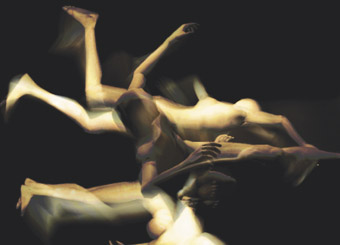
EED, Kurt Hentschläger
courtesy of the artist
EED, Kurt Hentschläger
feed
Kurt Hentschläger, an Austrian and long-time resident of the USA, re-staged FEED, originally commissioned for the 2005 Venice Biennale. The performance took place in an old underground bunker and, prior to admission, the sense of anticipation built as audience members were required to declare the state of their health. Anyone suffering from headaches, anxiety attacks, “anyone under the influence of medication for the treatment of depression” through to epilepsy, was to be excluded from attending if they did not sign a disclaimer.
FEED takes place in two parts, the first being an audiovisual experience in traditional surround-sound cinema mode. Animated clones float in space and at intervals jerk and twitch simultaneously. Without warning, smoke machines billow out clouds and in minutes the audience is engulfed in fog. I can’t see my hand inches from my nose and realise that now there is no way to back out. Sharp flickering patterns of interference and revolving coloured light emerge, evocative of a hallucinogenic experience and coupled with sound that vibrates not only your eardrums but your whole body. Hentschläger uses stroboscopic lighting accompanied by resonant drones so that his work “happens as much in your brain as in your eyes, and in the rest of your body”, adding that something initially scary can ultimately become peaceful and sublimely beautiful.
audiowalk gusen
Christoph Mayer chm’s AudioWalk Gusen, subtitled The Invisible Camp and created over a three-year period by a dozen-strong project team, far surpassed any expectations with its simplicity and elegance of construction. Technology was definitely not the focus, used only as the delivery tool, presenting previously unspoken and unheard accounts of numerous atrocities. Discussions with the creator on the way to the audio walk’s starting point gave no hint of what was to follow, or the very personal nature of the work. AudioWalk Gusen takes place on the former location of the Nazi concentration camps Gusen I and II.
A single iPod and set of headphones accompany you on the solo journey around the small town, allowing the past to emerge and become corporeal. Layers of present-day suburban tranquility are slowly peeled away to reveal a terrifying past. The juxtaposition of past and present climaxed for me when, listening to accounts of the mass graves located on a particular site, I saw a group of children with coloured chalk drawing an aerial view of a shopping centre in the middle of the asphalt road.
While the walk should have been straightforward, at one point tears obscured my ability to follow directions and, inevitably, I became lost. Existing in both the past and present became exceedingly difficult, given that I was rendered almost useless due to the intense nature of the work’s content. Careful construction of a woman’s narrative, a soundscape of noises of life inside and out of the camp grounds, and a sparse, minimal soundtrack were interwoven with testimonies from concentration camp survivors, past and current village members and former SS officers. Memories are forever imprinted upon these voices. One story impossible to forget is of a camp survivor’s childhood memory of witnessing other children, bound in sacks, thrown repeatedly against an apartment building wall until they were dead.
Two hours later I arrived at the endpoint as daylight was fading. AudioWalk Gusen continues to resonate with me—for weeks it entered my thoughts within minutes of waking up each morning. The work, available in an English translation, exists as an ongoing installation with the audio equipment available for hire from local restaurants nearby the Gusen Memorial.
post-immersion
Gusen Audiowalk and FEED each encourage my belief that embodied and immersive artworks are an incredibly powerful and very direct means of delivering concepts, of conveying the ‘other’s’ experience and developing empathy. Post-immersion, these artworks at Ars Electronica have significantly impacted on my daily life. This is how history should be learnt.
Festival Ars Electronica 2007, Goodbye Privacy, Linz, Austria, Sept 5-11,
www.aec.at/en/festival2007
RealTime issue #82 Dec-Jan 2007 pg. 16
© Somaya Langley; for permission to reproduce apply to realtime@realtimearts.net
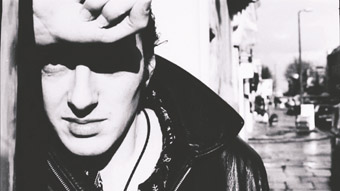
Strummer: The Future is Unwritten
courtesy Dendy Films
Strummer: The Future is Unwritten
PHILIP SEYMOUR HOFFMAN HAS SO MANY FACES AND VOICES THAT I’M CURIOUS TO FIND OUT WHAT HE LOOKS AND SOUNDS LIKE. THE ACIDIC WRITER TRUMAN IN CAPOTE (FOR WHICH HE WON AN OSCAR), THE HEAVY-BREATHER ALLEN IN HAPPINESS, THE LYRICAL JOURNO LESTER BANGS IN ALMOST FAMOUS AND, MY ALL-TIME FAVOURITE, THE TRY-HARD IN THE TOO-SMALL T-SHIRT, SCOTTY, DEFEATED BY THE POWER-PLAYERS IN BOOGIE NIGHTS. HOFFMAN IS IN SYDNEY TO DIRECT RIFLEMIND, ANDREW UPTON’S PLAY FOR THE SYDNEY THEATRE COMPANY. AT A RECENT Q+A BOTH HOFFMANN AND UPTON WERE ON STAGE DISCUSSING A MINI-FESTIVAL OF FILMS REVOLVING AROUND THE THEMES OF THE PLAY.
Hoffman takes the stage, scruffy and retiring; it’s hard not to position him as a character in exile, even now. He chooses to screen Round Midnight, Bertrand Tavernier’s sensual evocation of a jazz muso past his prime, battling alcoholism in a seedy hotel in Paris. He talks of directing his own ageing rockers in Riflemind (harnessing various circular character ‘needs’), about the difference between acting for the stage and screen (not much, just flexing different muscles). As Upton punctuates Hoffman’s silences with his own staccato style, the ghost of Cate Blanchett—Hoffman’s female equivalent in terms of taking on multi-faceted roles, and Upton’s wife—seems to hover offstage, directing from the wings.
I admit it. I bought a ticket to Riflemind because Hoffman was directing and Hugo Weaving was starring. I have struggled with theatre for many years. It doesn’t grab me like film does. Often as soon as the opening words are uttered I groan inwardly; if there’s a fake American accent, that’s it, I’m down for the count. If there’s a film connection I take the chance. And if there’s star power, I’m drawn in. Call me shallow. There’s something about being in the same physical space with a face you’ve seen up close for hours on the big screen. When I think about it, I’ve probably spent, adding up all his titles, 20 hours with Hoffman in an intimate space. Hugo Weaving, probably more.
riflemind
Riflemind is like The Big Chill for rock musos. An 80s band decides to think about re-forming (and reforming too), meeting in a mansion on the outskirts of a UK village, arriving by helicopter. It’s not Kevin Costner (yes, he played the corpse in the film) but there’s something dead in the water. Revolving around a simple set—a long benchtop kitchen and fridge, a couch near a stereo, a Mark Rothko painting—band members John (Hugo Weaving), Phil (the always charismatic Marton Csokas), Moon (Steve Rodgers), a young upstart from the States, Lee (Ewen Leslie—yep, there’s that ‘American’ accent), the band’s manager Sam (Jeremy Sims) and two girlfriends Cindy (the one with a history, Susie Porter) and Lynn (a new recruit but battling addictions of her own, Susan Prior), fire mis-timed missiles at each other.
In the Q+A with Hoffman, Upton was pretty harsh about Metallica (the subject of the 2004 documentary, Some Kind of Monster) and the band’s fans, talking in a derogatory way about their music being ‘crap’, and in the same way, he seems to despise his own characters. While we skim the surface of their despair, addictions and tenuous familial threads, we remain as disconnected as the lot of them. There’s some humour to relieve us (Jeremy Sims hams it up as a Rod Stewart-like pompous git and, damn, another fake accent) but you’ve got to wonder what Susie Porter saw in the role, other than I guess working with Hoffman. Cindy (shortened to ‘Cin’) goes from bleached to raw—yes, she’s sucked a lot of dick to get where she is, we get it. Vanilla ice layers of cliche, punctuated by the stub-stub-stubbing of cigarettes. Apart from Weaving’s opening monologue, a taut rhythmic tongue-play around the construction of a lyric, there’s no real sense of the music, beyond the occasional scene change effect of strobe-lighting with a rapid fire chunky guitar (Peter Black and Raymond Ahn from the Hard Ons) that makes my neighbour lean forward in her seat as if she’s been shot.
You don’t have to go much further than your local RSL to see real-life examples of these bands and we’re talking further back than the 80s. There’s a re-forming revolution going on. I used to cast scorn on my parents’ generation, queuing up for Countdown rerun concerts where even the band couldn’t get it together (see Katrina from Katrina and the Waves!), doing the stomp with knobbly knees to Eagle Rock (yep, those boys are back in town too, and on Sunrise). But then suddenly it was my teenage past that was coming back to haunt me at the Sydney Entertainment Centre. The Cure. Duran Duran. Psychedelic Furs. Hoodoo Gurus. Suddenly the past didn’t seem like that long ago, especially with current teenagers wearing the same clothes I did; bubble skirts and smock frocks were bad then and nothing’s changed. I knew I was heading down a slippery slope when I saw Violent Femmes at the Revesby Workers Club last year and stood on the perimeter of the dance floor with lots of bald, middle-aged accountants, screaming “day after day, I get angry, and I will say, that the day, is in my sight, when I’ll take a bow, and say goodnight.
film & rock
Filmmakers have also been riding the crest of this wave, fascinated with the idea of washed-up rockers giving it another go. The tour de force Some Kind of Monster—which Hoffman screened to his cast early in the rehearsal process—reveals the inner workings of a band, Metallica, who have reached their peak and are coming down the other side, the psychologising and gameplay that goes on to bring out a new album, and the strain to just keep on keeping on, battling 20-year-old habits and wives who expect more now they have children. The doco also deftly gets into the heads of the hangers-on, particularly the band’s somewhat delusional psychologist, who begins to see himself as an essential part of the band, unable to acknowledge his own co-dependency. Popular hits like Music and Lyrics, with Hugh Grant, and the Australian BoyTown, with Glenn Robbins and Mick Malloy, play with Riflemind’s themes in a comic way, making the most of bad 80s haircuts and worn-out dance routines.
strummer: the future is unwritten
The best of these films is Julien Temple’s passionate unearthing of an era in Strummer: The Future is Unwritten. This tender documentary has a cohesion often lacking in films where the protagonist is no longer with us. The film makes Joe Strummer breathe, in contrast to Riflemind, where the band is stifled and suffocating. At the Q+A, Upton said his play was influenced by Chekhovian rhythms, and yes, the characters seem trapped by their own inertia, their sense of ennui—but is that because Upton himself doesn’t quite know where to take them? Temple doesn’t have the same problem but of course he’s guided by the meandering narrative of a known musician who was frontman of The Clash. There are a million ways to approach the contradictory forces in Strummer’s life and he shapes the doco beautifully by interviewing family and friends, framed in front of a raging bonfire at night, the soft focus of flames encouraging spontaneous bursts of Clash songs. A radio broadcast—London Calling—acts as scaffolding, holding the narrative up, while it interweaves Strummer’s eclectic taste in music from around the globe with his captured archival history as a diplomat’s son in Iran, Malawi and Mexico.
What the doco manages, and where the play struggles, is to get into the complex yearnings of men who’ve had it all (fame, money, girls, drugs, success) and lost it. Temple has always been into punk. In the 70s he was one of the first to film the Sex Pistols and The Clash. He became a close friend of Strummer’s in the years before his death. In the film, over 25 years, Joe Strummer re-emerges in a series of identities, from rebel to hippie to punk back to hippie, shedding his slippery snake skin when it no longer fits. The band members in Riflemind seem trapped behind glass, like oddities in a museum with strap-on instruments, but then they are only captured at one moment in time. Perhaps the difference in what’s offered to the audience is that Temple comes to the subject as a passionate fan of the music first, while Upton seems more interested in what happens when the music dies.
Strummer: The Future is Unwritten, director Julien Temple, producer Amanda Temple, currently screening nationally, www.joestrummerthemovie.com
Riflemind, director Philip Seymour Hoffman, writer Andrew Upton, performers Marton Csokas, Ewen Leslie, Susie Porter, Susan Prior, Steve Rodgers, Jeremy Sims, Hugo Weaving, design Richard Roberts, lighting Damien Cooper, costumes Tess Schofield; Wharf 1, Sydney Theatre Company, Oct 5-Dec 10
RealTime issue #82 Dec-Jan 2007 pg. 17
© Kirsten Krauth; for permission to reproduce apply to realtime@realtimearts.net
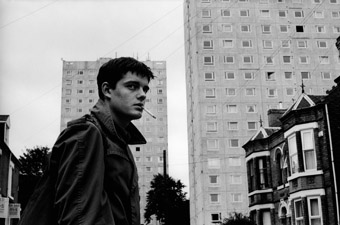
Control
courtesy Dendy Films
Control
IN 1980, ON THE EVE OF JOY DIVISION’S FIRST AMERICAN TOUR, SHORTLY BEFORE HIS 24TH BIRTHDAY, IAN CURTIS HANGED HIMSELF. ON A SMALL COMMEMORATIVE STONE—THAT ISN’T EASY TO FIND—IN MACCLESFIELD CEMETERY AND CREMATORIUM, IS WRITTEN “LOVE WILL TEAR US APART.” ALMOST THREE DECADES LATER, THE SINGER ATTRACTS INCREASING NUMBERS OF DEVOTEES, MANY OF THEM ARTISTS, INSPIRED BY THE SMALL BUT COMMANDING BODY OF WORK JOY DIVISION MADE AND THE INTENSE EMOTION CURTIS IMPARTED—A DESPONDENCY PERHAPS NEWLY RELEVANT IN OUR OWN TIME.
Dutch photographer Anton Corbijn—revered for his celebrity portraiture and award-winning film-clips, including Joy Division’s Atmosphere (1988)—was inspired to transform his practice and make his first feature film when offered the subject of Curtis, based on Touching from a Distance, a biographical account of the musician’s life written by his widow, Deborah. The crossover from still to moving image has taken Corbijn 30 years, but it seems appropriate that he waited to do it with Control. At a recent appearance at Melbourne’s Nova Cinema he told how he moved from The Netherlands to England in 1979 following the sounds of Joy Division, making a touching joke that he hasn’t washed his hands since he shook Curtis’. Photographing Joy Division in 1979 and 1980 was a personal and professional milestone in his life.
The transition from photography to filmmaking (or vice-versa) can be a logical progression, each medium an appendix of the other. Many artists work successfully across both media, for example Robert Frank, Wim Wenders and Larry Clark. Other contemporary artists narrow the divide even further; works by The Kingpins, Tracey Moffatt and Matthew Barney slide seamlessly between moving and still photography, not surprisingly given the high saleability of production stills as editioned works.
Working from his own and Deborah Curtis’ memories, Corbijn manages to capture the singer’s magnetism. From a mere hour of extant Joy Division footage, newcomer Sam Riley convincingly embodies Curtis, capturing the essence of his distinctive dance style. From portraying the band’s cocky, bold front man to the self-conscious epileptic, heavily dosed on medication (and alcohol), Riley’s performance is excellent. He reveals Curtis’ struggle to hold the disparate pieces of his life together, juggling a demanding tour schedule, a day job as a civil servant, a baby, a wife he married in his teens, and his feelings for the sophisticated-Belgian, Annik Honoré, with whom he fell in love.
Tormented and torn between moral obligation and the path to musical acclaim, on stage Riley’s Curtis completely surrenders to the music; off stage he fluctuates, naïve, sensitive and sincere, then cruel and selfish. Curtis incarnates the myth of the tortured artist, his tragic suicide fuelling the legend, yet Corbijn doesn’t exploit this—Curtis’ lack of control of his life is portrayed as less than romantic, as is the culture of the oppressive, post-industrial towns of Manchester and Macclesfield in the late 1970s. Corbijn’s decision to film in black and white heightens the sense of a relentlessly depressing England where the music scene in the pubs and clubs provided the only respite from cold, grey streets lined with cheerless council flats and offices. Corbijn explained that the medium perfectly captured the bleak atmosphere of the era, and exemplified Joy Division’s aesthetic—photographs of the band are virtually all monochrome (including Corbijn’s) as are their album covers (designed by Peter Saville).
Curtis and Joy Division have inspired more artists than Corbijn. Over a quarter of a century after Curtis’ tragic death, the band’s music has been covered by countless others. In fashion, Belgian-designer and curator Raf Simons designed men’s clothing and jewellery ranges based on Joy Division lyrics and album art. ‘Joy Division trainers’ have been designed for both Nike and New Balance (although neither as yet have gone into production). And, in visual art, there are many examples of the band’s influence.
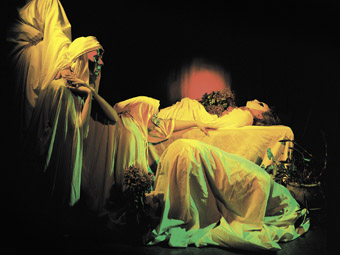
Darren Sylvester, No Fun, No More (2006)
courtesy of the artist
Darren Sylvester, No Fun, No More (2006)
In Australia, Melbourne-based artist Ronnie van Hout’s video I Remember Nothing (2004) appropriates the Joy Division song of the same name for its audio track. For the length of the song, a bewildered van Hout, in odd attire complete with mask, staggers blindly and senselessly through a grassy urban setting. Darren Sylvester’s No Fun, No More (2006), a restaged, colour version of Joy Division’s Closer album cover, was recently exhibited in Perfect for every occasion: photography today at Heide Museum of Modern Art. The accompanying catalogue reveals that Sylvester “wanted to return to a theme of that album, in which Ian Curtis was seemingly having no fun at all, to remind the viewer that sometimes nothing changes, by dragging the image closer to the modern age in lurid colour.”
In Melbourne, in 2003, the Centre for Contemporary Photography showed David Crawford’s Dance to the Radio—the chorus of Joy Division’s Transmission—three readymade music videos for Joy Division songs constructed from stock photos selected by keywords typed in by audience members. The same year, in Sydney, gallery WREN exhibited Dorothy Bona’s portrait of Curtis.
Internationally, Swiss artist Philippe Decrauzat’s Komakino (2006)—a Joy Division song title—is a wall decal (in black and white) inspired by the band. David Alker (UK) has made recreations of Joy Division album covers as part of his remade record collection series The Record Collections, while Glenn Brown (UK) has made paintings titled The Ever Popular Dead (painting for Ian Curtis) After Adolf Schaller and Ornamental Despair (Painting for Ian Curtis) After Chris Foss. The Museum of Contemporary Art in Chicago is currently showing Sympathy For The Devil: Art and Rock and Roll Since 1967, including Futurama (2004) by Scott King and Kevin Cummins—digital prints featuring portraits of Ian Curtis.
Slater Bradley (US) regularly pays homage to Joy Division, crediting Curtis in his catalogue acknowledgements and making work that includes paintings reproducing the band’s graphics; photographs of Bradley’s doppelganger, Benjamin Brock, posed as Curtis (with remarkable likeness in Bradley’s Doppelganger Trilogy, 2001-04); a video ‘recreating’ footage of Curtis (Brock) performing; and a project titled In a Lonely Place—one of Joy Division’s last songs, later recorded by New Order—in which Brock simply attends events (including exhibition openings) styled and dressed as Curtis.
The music and visual art crossover isn’t unusual, given that many visual artists are musicians and vice-versa, however the pervasiveness of Joy Division’s impact is significant. Reverberating across generations, the band’s music appears to have increasing relevance for contemporary audiences who recognise feelings of guilt and shame, of the despair that can come with falling in and out of love—as Sylvester rightly points out, “sometimes nothing changes.” Curtis’ lyrics are as compelling now as they were in the late 1970s.
Curtis’ legacy is just under 50 songs that are full of life: they are dark and oppressive, yet liberating and inspirational. They hold weight—his deep and haunting voice propelling the palpable despair at the heart of it. Cleverly, Corbijn uses Curtis’ lyrics for the singer’s thoughts throughout Control, which is the story of a private life—a revealing account of the man rather than the myth. Like the sounds of Joy Division, the film is genuinely moving, at times humorous, and heartbreaking, leaving us with a sense of longing for what might have been.
Control, director Anton Corbijn, screenwriter Matt Greenhalgh with Deborah Curtis, cinematography Martin Ruhe, John Watson, editor Andrew Hulme, music supervisor Ian Neil, score Joy Division, New Order, sound designer Peter Baldock. DVD release in Australia through Madman.
RealTime issue #82 Dec-Jan 2007 pg. 18
© Karra Rees; for permission to reproduce apply to realtime@realtimearts.net
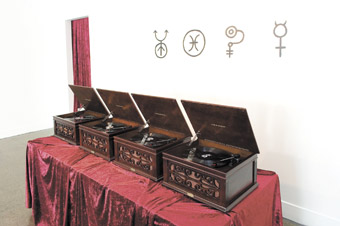
Zoso, A ritual of rock, runes & magick (detail)
photo Andrew Barcham, Screaming Pixel
Zoso, A ritual of rock, runes & magick (detail)
DID LED ZEPPELIN REALLY MAKE A PACT WITH THE DEVIL IN EXCHANGE FOR FAME AND RICHES? SO IT IS SAID IN A TALE THAT ECHOES THAT OF THE FAMOUS BLUES SINGER ROBERT JOHNSON.
Rock and roll is all about myth. And Led Zeppelin is a band of mythical stature. They are remembered as the band that set the bench-mark for three hour sets and 30 minute solos, for misbehaving with groupies and the art of hotel trashing, for excessive consumption and death by rock and roll. They helped define the music of the 70s till the arrival of punk, with its preference for three minutes of musical mayhem, stamped a use-by date on Zeppelin’s epic ballads, consigning the band to rock dinosaur status.
Zoso is an incarnation that once more unleashes the spirit of Zep. Demonic drawings and arcane symbols and sounds summon the lost icons of rock and invite the mage who never speaks and the golden god to walk among us again.
The exhibition, created by Ian Haig, Philip Samartzis and Darren Tofts, is an exploration of the mythology that Zeppelin created for themselves and with their fans—not just their status as legends of rock but the myths of their own construction that became a vital part of the culture of the band. Zeppelin’s most famous album, their Untitled IV (Runes) is an exercise in mythmaking. The album has no title and the name of the band appears nowhere, not even on the spine. The gate-fold jacket opens to reveal a drawing of the Hermit from the Tarot, a symbol of wisdom looking down from a cliff top at the ascent of a young man on a spiritual quest. In a further act of significance the band members are identified not by name but by four arcane symbols. Zoso is the timeless and sacred symbol that Zeppelin’s infamous guitarist Jimmy Page chose for himself.
According to rock journalist Simon Woods, Zeppelin had a “cool media image.” This draws on Marshall McLuhan’s theory of hot media as one “well filled out with data” while cold media requires the audience to “fill the gaps.” In contrast to the rich symbolic world that Zeppelin set out to create with their music and their albums, the band released very little information about themselves—rarely doing interviews or posing for photographs. Woods suggests that this helped create a mythology around the band. Fans imagined wild and fantastic lives for their heroes fed by the odd revelation, which would then be reverently shared; such as Jimmy Page’s purchase of eccentric British occultist Aleister Crowley’s legendary haunted castle, Boleskine House.
Zoso explores the codes of this secret society of fandom. Tofts is the hierophant of the group, taking pleasure in the language of Zeppelin—the borrowings from Celtic folklore, the pillaged blues lyrics and the curious marriage of the two. These, along with the ambiguous evocations of Page’s infatuation with the writings of Crowley and the promise of Tolkien’s imagined world without Christianity, create Zeppelin’s unique concoction of spirituality. The Boleskine Grimoire, the exhibition’s own sacred artefact, presents a text portentous with meaning. It is gleefully bubbling over with esoteric references, Zep arcana and laced with hidden messages for true believers.
Haig’s seven headed beast guitar (see this issue’s cover) is displayed in state within a private antechamber whose walls are scrawled with incarnations from Crowley and the names of demons, their unholy nature identified as the source of Page’s legendary prowess. The famous double-necked guitar was custom made for him so that he could perform multiple guitar parts at Zeppelin concerts and became both a symbol of his musical prowess and an icon of cock rock. The monster guitar complements Haig’s wall drawing of Page, which captures his uncanny feminine beauty in full thrusting rock glory.
Four lavish mock cedar record players, resplendent on crushed red velvet, symbolically support the six track recording celebrating Zeppelin’s generally overlooked importance as innovative experimental musicians. Zeppelin’s guitar virtuosity and their role in spawning Heavy Metal are common lore but their genuinely avant-garde experiments have been under acknowledged. These include the marriage of Page’s theremin playing with the Robert Plant’s vocal stylings. Also significant was Page’s bowing of the electric guitar. Samartzis reclaims Zeppelin for the avant-garde in a composition featuring gongs, cowbells, theremin, chanting and what could even be something played backwards. It is a ceremonial soundscape that is not for the faint hearted. A theremin in the gallery offers the believer an opportunity to partake in the ritual.
Zoso is an intriguing exhibition. It is first and foremost a celebration of the rich language of Led Zeppelin’s mythology and the importance of their fans in its construction. While the artists’ work is undoubtedly ironic, they have not forsaken their primary relationship as fans. Embracing the rich transformative possibilities of rock and roll, Zoso revisits adolescent dreams of Zeppelin’s promise of a world of sexuality, power and magick. This is not a dry academic reclamation but an honest fan boy confession of guilty and undying passion for the dreams of excess and dragon pants, of arcane secrets and words with two meanings and, most importantly, the pleasure of music and myth. It is an exhibition that can only be truly appreciated by the members of a secret society who rejoice in a playful nostalgia that not all its audiences will understand. In reawakening our awareness to these impulses in the confines of the gallery, Zoso also raises interesting questions about contemporary art practice, its mythologies and elite codes and the act of encryption within the gallery space.
And it makes me wonder.
Zoso, A ritual of rock, runes & magick, artwork Ian Haig, sound design Philip Samartzis, concept design and text Darren Tofts; Project Space/Spare Room, RMIT University, Melbourne, Oct 29-Nov 16
RealTime issue #82 Dec-Jan 2007 pg. 19
© Helen Stuckey; for permission to reproduce apply to realtime@realtimearts.net
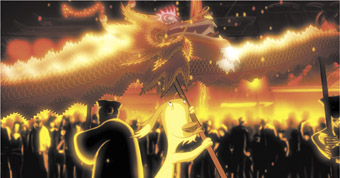
Sweet and Sour
CHINATOWNS HAVE LONG BEEN A KEY SITE OF CROSS-CULTURAL EXCHANGE IN AUSTRALIAN CITIES, SO IT’S APPROPRIATE THAT THE FIRST AUSTRALIA-CHINA ANIMATED CO-PRODUCTION TAKES AN IMAGINARY CHINATOWN AS ITS SETTING. BRINGING TOGETHER NEW TECHNOLOGY AND YOUTHFUL ANIMATORS WITH THE HAND-DRAWN WORK OF ONE OF THE WORLD’S OLDEST ANIMATION STUDIOS, THE 17-MINUTE SWEET AND SOUR MARKS AN EXCITING FORAY INTO ASIA FOR AN INDUSTRY TOO OFTEN BLIND TO THE DEVELOPMENTS, INNOVATIONS AND OPPORTUNITIES TO OUR NORTH.
Sweet and Sour originated with Adelaide’s youthful People’s Republic of Animation, a company whose short films like Carnivore Reflux and Fritz Gets Rich have quickly put them at the forefront of Australia’s small but active animation sector. The Chinese contribution came from the venerable Shanghai Animation Film Studio (SAFS), renowned for hand-drawn animation work evidenced in such classics as Sun Wu Kong (The Monkey King, aka Uproar in Heaven, 1965) and Nezha nao hai (aka Prince Nezha's Triumph Against the Dragon King, 1979).
Sweet and Sour revolves around a cute stray dog living in a cold, bleak metropolis, whose world is transformed one night when he inadvertently stumbles upon Chinatown’s golden carved gateway. He enters, passing into a warm, dynamic world of startling sights and tantalising aromas. Like so many others, the little dog begins his love affair with Chinese culture by sampling the myriad culinary delights on offer, from noodles to soups to steamed dumplings. However, after revelling in the richness of all things Chinese for several nights, the romantic image is suddenly shattered when he realises that he and his canine comrades may be destined for the menu. Chinatown’s hospitable ambience is suddenly transformed into a threatening air of menace, full of monsters and knife-wielding chefs, and the dog flees in terror. Enticing scents eventually lure him back, and before the film’s end he manages to find salvation, along with his four-legged friends (including one stray turtle!), in Madame Li’s Vegetarian Restaurant.
Given the vast cultural and linguistic differences between China and Australia, Sweet and Sour’s writer-director Eddie White knew he would need some serious help when he dreamt up the idea of an animated co-production between the two nations. Fortunately, the Australian Shanghai-based producer Barry Plews and his company Reckless Moments were already working with the Shanghai studio developing an animated TV series when the PRA approached them with the co-production proposal. Aware of the PRA’s reputation and track record in Australia, and always eager to further the cause of transnational artistic partnerships, Plews agreed to come on board as executive producer, and the first animated China-Australia co-production was born.
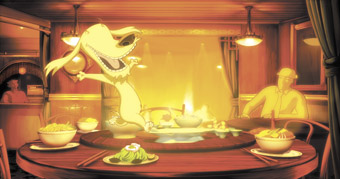
Sweet and Sour
Ironically, the concept of Chinatown was the first cultural stumbling block when the Shanghai animators read Eddy White's script. “It took quite some time to get the 'idea' of a Chinatown in a foreign country across to the Shanghai animators”, recalls Plews. ” They had no concept of it. One of the issues that needed clarification was that 'Chinatown' was not China…we had to do sessions where we showed the Chinese animators extensive folios of Chinatown photos from around the globe.”
Despite the SAFS’ international reputation, Sweet and Sour is only the second co-production undertaken by the studio. Plews and his associate producer Hu He “ended up being the conduit and the bridge, interpreting each side's expectations and looking after both side's creative interests.”
The result of all these cross-cultural negotiations is best seen in the film’s gorgeously sensuous Chinatown. Modeled on a dream-like 1930s Shanghai-style reality of bright colours, sensual women, raucous restaurants, gambling dens and bustling street life, the astonishingly detailed setting and expressive fluidity of the main character’s movements were borne of the two teams’ respective strengths. The backgrounds and some characters relied on the PRA’s skilful use of digital technology, while the cute lead was designed by the Australians and drawn by the Shanghai team. The finished film marries the SAFS’ hand-drawn characters with the PRA’s warm, digitally-generated backgrounds to beautiful effect.
Since premiering at the 2007 Adelaide Film Festival, Sweet and Sour has played at festivals around the country and garnered the Yoram Gross Award for Best Short Animation at the Sydney Film Festival last June. The Hong Kong International Film Festival will unveil the film for Chinese audiences in March 2008, and approval for Chinese mainland screenings was granted at the end of October 2007.
Perhaps more exciting than Sweet and Sour’s current success is the prospect of future collaborations. Despite the cultural divides that had to be bridged in the course of working with an Australia company, according to Plews the Chinese animators greatly enjoyed the experience. The two sides are now working on developing a feature-length project. A 'Memorandum of Understanding' was signed in June and two potential movies are currently being discussed: a film entitled Train to Never Was, and another about Christmas. Plews says they’re “leaning towards the former”, but will make up their minds before the end of 2007.
Given the level of artistry achieved in Sweet and Sour, the prospect of a feature-length co-production is an exciting one for animation fans. If Sweet and Sour has a weakness it’s the lack of narrative sophistication that so often characterises Australian animation. A longer work will hopefully facilitate the kind of rich storytelling the Shanghai studio has demonstrated in earlier works such as Sun Wu Kong.
China is a nation whose culture is only just beginning to meaningfully respond to outside influences, while Australia’s film community can be depressingly myopic when it comes to influences beyond America or Europe. Joint projects between the two countries can only provide a healthy artistic shot in the arm for both. As Barry Plews says of the many Australian-Chinese collaborations on which he has worked, “The most satisfying aspect is that the collaborations actually happen and that they realise such interesting outcomes. These are often very difficult and complex undertakings and they test everyone involved. Many of the Chinese artists with whom we work have never worked with foreign artists or producers before. Collaborations confront cultural differences head on, and the artists have to create within a moving landscape of cultural chasms and fault lines. It's no mean feat for any of them. The pleasure is the journey's end. Always.”
Sweet and Sour, director Eddie White, producers Sam White, Hugh Nguyen and Ren Zhong Lun, The People's Republic of Animation, Shanghai Animation Film Studio, Reckless Moments, 2007
RealTime issue #82 Dec-Jan 2007 pg. 20
© Dan Edwards; for permission to reproduce apply to realtime@realtimearts.net
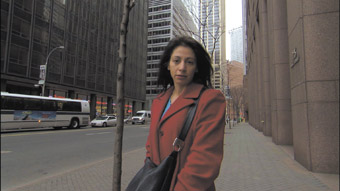
Norma Khouri in New York, Forbidden Lie$
AUSTRALIAN DOCUMENTARY FILMMAKER ANNA BROINOWSKI HAS A HISTORY OF TAKING ON THE STORIES OF STRONG AND CONFRONTING WOMEN. IN HELEN’S WAR (2004 AFI AWARD WINNER FOR BEST DIRECTION IN A DOCUMENTARY) SHE GETS TO THE HEART (AND HEAD) OF PHYSICIAN AND ANTI-NUCLEAR CAMPAIGNER HELEN CALDICOTT (SHE’S ALSO HER NIECE). WITH FORBIDDEN LIE$, SHE HAS AN ENGROSSING READY-MADE MYSTERY AT HER FINGERTIPS: WHO EXACTLY IS NORMA KHOURI? IS SHE A CON OR AN ARTIST (AS THE PROMOS ASK THE AUDIENCE)? AND DID THE EVENTS THAT SHE DETAILS IN HER BESTSELLER FORBIDDEN LOVE—AN APPARENTLY TRUE STORY ABOUT A JORDANIAN ‘HONOUR KILLING’—REALLY
HAPPEN?
Forbidden Love reads like a Mills and Boon romance of two star-crossed lovers: a dashing army hero and a pretty damsel in distress. It never sat right with me as autobiography or even as a recreation of real events. Stylistically it’s a Hollywood blockbuster transposed to a hairdressing salon in Jordan, dressed up as melodrama and, finally, horror as Dalia (the damsel) ends up murdered by her brothers and father. The dialogue is excruciating and the descriptions fail to create any real sense of place, but there’s no doubt it’s a page turner, and that many readers loved it. It also worked to fuel a sense of outrage—that women are still being treated this way—and fed into the current Western trend of positioning the Islamic community and their beliefs as morally and spiritually questionable and/or Arab Muslim men as embodiments of evil. Through all the drama, Khouri places herself firmly in the middle of the story—as the loyal friend willing to risk her life so the lovebirds can escape and live happily ever after—which, judging by Broinowski’s observations, is Khouri’s favourite place to be.
At the start of the film, we are introduced to Norma Khouri as she reads from her book, sitting in a white minimalist set where the windows have been painted on. As her words and voice linger, we zoom through the faux-glass into windswept desert sand. High-blown and arch, her narrative of Dalia—best friend since childhood—soon begins to drift, like those quickly disappearing footsteps wandering up into the sand dunes. From this brilliant beginning, Broinowski plays with poetic devices and metaphor throughout, and uses a great selection of music, like Sade’s classic 80s hit Smooth Operator, to highlight the possibility that Khouri might not be all that she appears.
But this ambiguity just seems to add a dollop on top of the woman’s already intense charisma. It helps that she’s gorgeous and gregarious, a natural in front of the camera; she looks straight down the barrel of the lens. Footage from the Byron Bay Writers Festival shows her treated like a rock star; the crowd want to touch her—“if there’d been music, I would have been in the mosh pit.” But with Broinowski now playing the detective you sense Khouri’s met her match. This filmmaker knows all about layers of manipulation and it’s intriguing to watch her tread a careful line between encouragement and scepticism as she tries to get to the nitty gritty, find some grain of truth. Like her subject Broinowski is in a gradual process of hiding and revealing what she knows (both to Khouri and in the way she structures the film) and at its best the film becomes a kind of bike race, the women hovering just in and out of each other’s sights, taking off in spurts and starts, slowing then waiting for that split-second moment to start the Olympic sprint.
As Broinowski convinces Khouri to travel back to Jordan to help sift fact from fiction, the filmmaker starts to get the upper hand. We meet a parade of historical experts, human rights activists, journalists (like Australian novelist Malcolm Knox, who initially exposed Khouri as a fraud) and Jordanian women going about their daily lives, who reel off lists of dates, locations and local beliefs that start to jar: a woman would never cut a man’s hair at a unisex salon; a certain brand of cigarettes hadn’t then been introduced into the country; the hotel chain, Hyatt, was still under construction; many women can travel alone without male escort—revealing Khouri’s writing to be, at best, historical fiction; at worst, a series of cliches wrapped up in great packaging in a bid to make a quick buck. On the ground in Jordan and increasingly under pressure on camera, Khouri says, “I don’t want her [Dalia’s real] name in the limelight. Everything here is smoke and mirrors.”
But, still, Khouri refuses to admit that her work is faction, or to call it a novel. Her refrain is that it came out of a promise to Dalia (at her gravesite) that her death would not be in vain. Khouri repeatedly states that her vision is to increase international awareness of the mistreatment of women in Jordan and encourage political pressure so that it does not keep happening. But although Khouri claims to send funds received from her book to charities fighting for women’s rights in Jordan, as with all her other leads, Broinowski can’t find proof of any philanthropy either. It’s all about controversy—and controversy sells. In a poignant moment, the killing is recreated for us with Dalia in bed repeatedly stabbed by her brother, a mindless knife attack in a frenzy of blood and chaos. And just as the horror has reached its peak, the girl sits up and laughs, pulls out a pillow that’s borne the brunt of this violent act, throwing us from real life to artifice in a split second. Just another actor working for the camera.
Which brings us to Norma Khouri’s ‘Oscar-winning’ performance. As she takes us and the filmmaker into her labyrinth of hidden lies and half-truths, we leave the book behind on the shelf, a curiosity to ponder along with Helen Demidenko’s The Hand that Signed the Paper. A Chicago cop on Khouri’s case reveals that a con artist likes to rub their victim’s face in the faeces of the crime; if Norma Khouri admitted her book was a fake there’d be no more story to tell. So here she is, still smiling for the camera as she strides down a New York street, bright red coat wrapped around her as if she’s just stepped off the set of Sex and the City—confident in the knowledge that while we may not know what’s fairytale and what isn’t, if she keeps this up she just might get away with it. And if Broinowski knows any diffferent, she’s not letting on.
Forbidden Lie$, writer, director, producer Anna Broinowski, cinematographers Kathryn Milliss, Toby Oliver, editors Alison Croft, Vanessa Milton, producer Sally Regan; nominated for the 2007 AFI Award for Best Documentary.
RealTime issue #82 Dec-Jan 2007 pg. 21
© Kirsten Krauth; for permission to reproduce apply to realtime@realtimearts.net
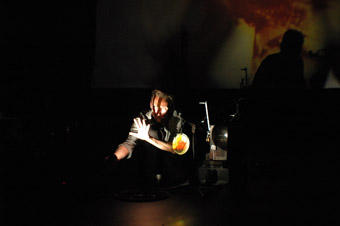
Christophe Auger
photo Tom Hall
Christophe Auger
EXPANDED CINEMA GREATS CELLULE D’INTERVENTION METAMKINE VISITED THEIR INFAMOUS LIGHT-AND-SOUND PERFORMANCE EXPERIENCE ON BRISBANE, SYDNEY AND MELBOURNE AUDIENCES IN JULY 2007 FOR LIQUID ARCHITECTURE. THEIR STYLE OF AUDIOVISUAL GROUP IMPROVISATION HAS BEEN HONED THROUGH COLLABORATION OVER A DECADE AND REVOLVES AROUND THE PERFORMANCE OF MULTIPLE 16MM PROJECTIONS AND LIVE ELECTRO-ACOUSTIC COMPOSITION.
Musical lynchpin Jerome Noetinger’s tape loops are a signature element of the band’s highly evolved but still frenetic shows which combine spectacularly sensual audiovisual experiences with a subtle critique of digital hegemony. Noetinger has said that he still hasn’t “exhausted the tape recorder” as he discovers things every time the band plays. He argues that “today there’s this spurious idea of ‘progress’, this imposition of new technology by the market. There’s something totalitarian about it. It’s like asking a violinist why he doesn’t play a computer.”
Noetinger’s description of Cellule d’Intervention Metamkine as “a band” is instructive. Key to the Metamkine approach and aesthetic is the careful positioning of the players; projectionists Christophe Auger and Xavier Querel face the audience like musicians, bouncing their beams off two large mirrors at the front of the stage, ‘playing’ their projectors like musical instruments. In the band’s shows at film festivals and music events, Auger and Querel operate up to eight aged 16mm film projectors, ‘performing’ the projection with various creative interventions into the beams, including moving projectors, using prisms and lacing up custom-made loops of the band’s distinctive luscious hand-processed abstract film. On their 2007 Australian tour, Querel spoke about the group’s approach and aesthetics.
Querel recalls that his “first experience of expanded cinema was through Christophe Auger, whom I’d come to know socially. I went along to one of the performances in the early days and really liked it. I was born in Saint Gervaus, a small skiing village in the French Alps, with only one cinema, and it was bullshit. No art cinema, just ‘classics’—‘the movies,’ in other words. As soon as I could I got out, and got to Grenoble with the wish of seeing lots of different films. And then…I discovered Metamkine performances. My grandfather and father were electricians so I used to work with them a lot and I am sensitive to light, but when I arrived, I had absolutely no background in film, cinema or music. But I was curious about everything—and, most importantly, I was in that state of mind to find avant-garde film. When I discovered Metamkine, even though it was only slides at that point, I thought immediately about Man Ray’s and other avant-garde films, and I understood: this is a new type of cinema. I was excited. Pretty soon I began to help Christophe and the other guys. The band and I clicked and we decided to work together, processing the films.”
For Metamkine, the key question, says Querel, is “What is cinema?” He explains, “For this we have a very empiric procedure—we try something, if it works, great, if it doesn’t, why? We are always asking ourselves, ‘where can I make a modification?’ We have an empirical method, not a structure.”
The other motivation was “the wish to be independent, to make films by ourselves, that special political situation, that led to Cellule d’Intervention Metamkine. Why? It’s political, of course: it’s to be outside the market. But it’s two things, really, it’s political/economical, but also aesthetic. On the one hand we want to control everything, make everything ourselves, take control of the process! Most people, even filmmakers, are happy to shoot film themselves, but then they have to hand it over to a lab for processing [where] it will be processed to exactly the same ‘standard’ as everywhere…This is why it’s very important to us to have our own lab, to process and explore film ourselves…the processing is as much a part of the filmmaking as the filming. To do it without participating in the industry is both an aesthetic and a political agenda.”
Querel says that when you take control of processing “you can make crazy experiments, such as the lab could never allow! This is more about aesthetics, obviously. A big part of our aesthetics, actually. We explore with black and white film a lot, processing it to two-colour separation, for example. Working with film, learning its ways, coming to know it, love it, work with it constantly, we have ‘become’ our own style of image. We’re not working on reproducing reality; it’s more to go deep into what film is as a ‘thing’, as matter, or substance, material, a tool rather than a medium for representation. Yes, I suppose there is some illusionism in our performances…it’s not with characters and reality, though, it’s not using recognisable images, and we don’t mean to have signification of some ‘thing’—it’s about matter, grain, colour, rhythm, light, particles, cells, flow…If there is an illusion, it’s a trick of your eye, or of the light itself.”
On his attitude to mainstream cinema Querel says he’s not really hostile. “I can accept the cinema for what it has become today—mass entertainment, it’s an industry, sure. An enormous amount of money involved—yes, I’m a bit hostile to that, sure…when I think about what it could have been. There are still some things that are interesting for me in the cinema—South American film, South East Asian film, African films can be quite intense. That intensity is critical to my creative life, it’s why I do Metamkine—the important thing to me is the play, that live moment, because it gives me such great pleasure. It’s intensely pleasurable to work with the loops and lenses and prisms and make something that’s different to normal cinema, something that’s unpredictable, where you have to react and really be there in that unique moment, that ‘now.’”
Querel recounts the many moments he loves in performance: “I actually love the space in between the so-called ‘perfect’ moments most of all; sure, it’s great when it’s all going well, but there is also excitement when I see something not going right and think, ‘oh, shit…’ There are always accidents occurring; it’s a door opening, where you can discover all sorts of new things. People tend to think of film as very fragile and get precious about it, but I don’t; if I break a loop or ruin a length, no problem, I react, improvise. I’ll just make some more. It’s great that it (the film) had a good death! Film for us [is] matter, demystified, you can work with it, and love it, and also love the destruction of it, scratch it, burn it, damage it voluntarily, and then you can create more. And we’re always creating more. When we’re playing, I am responding to Christophe and Jerome and they are responding to me…as well as to the venue, the performance space, the ambient light, the day you had before and maybe will have tomorrow, the audience…These things will all interfere a little bit, and charge up the performance with a unique energy each time.”
Read reviews of Metamkine in RT81, p46 & RT80, p51; www.metamkine.com
RealTime issue #82 Dec-Jan 2007 pg. 22
© Danni Zuvela; for permission to reproduce apply to realtime@realtimearts.net
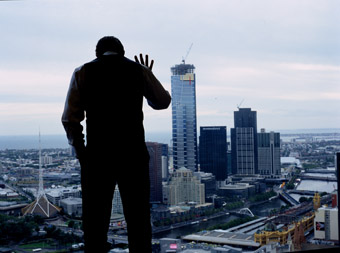
Meditations #2 (2007), BORIS + NATASCHA, production still
courtesy of the artists
Meditations #2 (2007), BORIS + NATASCHA, production still
THE BIENNALE OF ELECTRONIC ARTS PERTH IS A LITTER OF SQUIRMING CONFERENCES, SUCKLING AT THE CROSS-PROMOTIONAL TEAT OF A GALLERY PROGRAM LARGE ENOUGH TO FILL SEVEN VENUES. NOT QUITE ENOUGH TO PRODUCE A COFFEE TABLE BOOK AS A CATALOGUE, BUT ENOUGH TO MERIT DOING THE ROUNDS ON A BICYCLE. THERE IS A SATISFYING DIVERSITY OF STUFF GOING ON, WHICH IS NOT APPARENT FROM BEAP’S INSCRUTABLY MESSY 90s-STYLE WEBSITE. IT SEEMS THAT ‘ELECTRONIC ARTS’ NO LONGER INCLUDES THE INTERNET. OR PERHAPS THE FLASHY, CONSUMER-DRIVEN INTERACTIVITY OF THE NEW FANGLED WEB 2.0 MACHINE IS UNSUITED TO THE CENTRE-PERIPHERY MODEL OF CONTENT DELIVERY THAT MAKES UP THE GENRE OF ‘BIENNALE’ WHERE CURATORS RULE AND ART IN THE UNRULY NEW MEDIA IS GIVEN LEGITIMACY BY ITS DISTRIBUTION IN ANCIENT AND VENERATED FORMATS, AND WHERE IT IS JUDGED BY ART CRITICS INSTEAD OF SOCIAL TAGGING.
And this, I suppose, is why I’m here; it’s just not what I expect from a festival of technology. Mind you, I’m enjoying it, once I turn up and get my hands on one of the print catalogues, where the actual design effort seems to have gone. I still itch for some kind of search function, though. Not to worry. Steeling myself to experience art the Old Way I depart clutching a program, mounted on a bicycle borrowed from my grandfather.
I confess, it’s a rewarding ride. First left after the train station, Hannah Mathews has curated a cracker of a show at the Perth Institute of Contemporary Art, entitled I took a deep breath…. The darkened main gallery is completely occupied by Ulf Langheinrich’s WAVEFORM B, a monolithic strobe-lit piece on a horizontal screen. From the ceiling, subtly filtered white noise is projected in between strobes. The pattern hidden in the chaos is apparently rippling water, so barely present as to be hallucinatory. The catalogue assures me that couples “spontaneously” dance on the surface of the work, so moving is this piece. But not Australia’s demure gallery going public, it seems. We are stuck motionless to the edge like moths on a designer bug zapper. Even without the terpsichorean urge, it makes for an unforgettable entrance, mind you. Ulf Langheinrich, puts the capital “E” in “Electronic Art.”
Upstairs is the equally contemplative work by BORIS+NATASCHA. Now, “meditative” is a term that’s usually classified as ‘damning with faint praise’, but Meditations 1-5 decisively moves to reclaim that word for people with an ounce of irony left in their art-wracked frames. The pair have partitioned the gallery space into five discretely curtained meditation chambers. In each, a single channel video piece encourages us to contemplate the tightening of our muscles as we are guided into the transcendental depths of suburban paranoia and insecurity. A hypnagogic voice intones histrionic scripts reconstructed from discount bin new age chill-out cassettes, backed by synth pads and reverberating gongs and all: “Now think… when was the last time you changed the battery of the outside motion detector?”/”Keep focusing on the feeling that you will always be this stupid, that you will always be this low, and that you are a genuine phoney.” The dialogue sways between internal monologue and instructional recording as the faces of suburbanites depicted on the screen sway into and out of ill-contained anxiety and painful self-consciousness. It’s enough to put me off yoga for a month.
A bit further down the road, in Artrage’s The Bakery, Still, Living goes for a different sort of immersion. The show features an assortment of gut-churning, stinky, sticky work that plays with the boundaries of the body in all the least comfortable ways. This is a show centring on the practice of using living things in art, and it has the Frankenstein chic for which the various other SymbioticA-affiliated shows are infamous, but with a fecund rainforest diversity where others tend to cultivated monoculture. It is also a literal sensory immersion; the black back room of the gallery space is rich with a stale-wine funk from S. Chandrasekaran and Gary Cass’ Bleeding Angel, which uses live bacteria to produce the ‘blood’ that flows from their sculpture. This microbe-slick sculpture-cum-performance piece is surviving well post launch, slimy and alive and metabolising quietly. This is what I mean by the boundaries of the body; it’s rare that work gets up my nose in precisely this way, or makes me long for a glass of red quite so much.
In questioning blind science—gleeful biotechnologists playing with the stuff of life—these artists weirdly ape their subjects even as they parody them; blind art, its practitioners gleefully toying with the stuff of ethics. Brandon Ballengée’s work presses this line most deliberately. His piece is simple; a display of the documentation of the artist’s controlled frog breeding program in series of slides and preserved bodies, and it is both chilling and revolting. The eventual goal is to breed a line of frogs back to an extinct variety known from preserved specimens. Tame, mind you, compared to animal experimentation going on in every tertiary institution and cosmetics company worldwide, and not so far from the natural history concerns of your renaissance artists, but still disturbing. The artist’s assertion that each generation of his experimental amphibian population is precisely a new work of art unearths all sorts of unquiet ideas about genetic engineering, about eugenics, about volition in art…Even if the idea of selective breeding is the same in form as the aesthetic at any dog show, the presentation casts our history of animal husbandry in a harsh, clinical light, and scuffs the line drawn around playing god. Is it the vanity of breeding your own frog species that makes this unsettling, or the presentation of them amidst all the trappings of scientific research? What has happened to our notion of life to elicit this response? And yes, anatomically stained frogs are, simply, gorgeous.
This show is an exceedingly interactive one, in the pre-new media sense of that term. A cunningly contrived overlap between the attendees at the various conferences and the exhibiting artists sees the bulk of each personally present at the show launch. Sure enough, the place heaves with enthusiastic Igors explaining their exotic programs of animal-dissection-as-art and what have you. Not only is it congenial, it’s necessary to get your head around this show. Zbigniew Oksiuta’s semi-organic inflatable forms are as sad as abandoned beachballs, until you see the artist waxing excitable about their genesis in his research into breeding underwater habitats, where they become prototypes for an alien but delicious future enacted in organic subaquatic membranes. Beatriz Da Costa’s PigeonBlog, in the gallery, is a bunch of stuffed birds on plinths. Paired with her deadpan background presentation, however, it is a journey through ideas of ownership of space, of collaboration, of environmental decay, and a dig at the fashionable ‘collective intelligence’ of online communities. She has been strapping pollution detectors to the backs of pigeons to map the ebb and flow of toxic gas in the air they pass through in flight, and if taxidermy is all that remains of the project proper when it emerges into the gallery it is still an intriguing entry point into a fascinating project. These are works on the edge of what can reasonably be crammed into a gallery, and the fit is uncomfortable. But in a show that is already so disquieting, that’s half the point.
The word on the street is that Still, Living was intended for the suburban-gothic surrounds of the WA Museum, but that it pulled out due to the controversial nature of some of the works. That is disappointing, especially given the bizarre formaldehyde horror show in the museum’s own basement. However for this show the simple exhibition resources of the Bakery are congruous; gaffer tape would surely be the construction medium of choice of the modern mad scientist on the go and the show is a winner for reasons all about the hospitable informality of the space. It’s an unconventional curatorial effort by Jens Hauser, not without awkwardness, but he pulls it off with style. The dark walls enclose a show stronger and more compelling than any of the works that make it up, which is surely the ultimate mark of a well-conceived show.
Contrast this grungy fun with the more proper show at the John Curtin Gallery, where a few, mostly high profile works have been lavished with top notch presentation. I acknowledge that this is an important thing to do for reasons that have a lot to do with the need to get people turning out for your shows, and it is a marvellous excuse to pull out all the stops. The Bill Viola and Daniel Lee pieces here are excellent, but I’ve seen them before, and so have you. Possibly on a t-shirt. And yes, they are yet more impressive in real life. Ultimately these familiar objects aren’t the pieces which will make me squeal involuntarily like a five-year-old, though, and that’s what I really want.
What does the job is Lynette Wallworth’s Still: Waiting 2, a strong work which benefits from meticulous presentation. The piece is a high definition video recording of corellas in the Flinders Ranges, seamlessly edited to compress the details into a comprehensible chunk of time and space. You don’t have to do much to turn the colours of the landscape into something spectacular, where the million year habits of birds are set in a landscape scarred from a billion years of sunlight. It’s minimally interactive. You walk in, the startled birds take off. Done. But then the numberless flock leap from the remote fossilised landscape against the back wall into the immediacy of the gallery, and your head twists to follow the intricately granular swarm of shrill squalling…It’s a kind of eco-evolutionary panorama, where the forty thousand year human occupation of this continent is too tiny to notice. It brings the smell of sun warmed rocks to my nose, and makes me check my shoulders for birdshit. A must see.
Stillness, The Biennale of Electronic Arts Perth, Sept 10-23, http://beap.org/
RealTime issue #82 Dec-Jan 2007 pg. 23
© Dan MacKinlay; for permission to reproduce apply to realtime@realtimearts.net
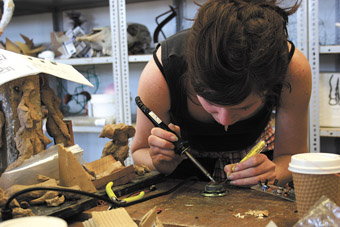
Dorkbot Workshop, Electrofringe
photo Mardy Dean
Dorkbot Workshop, Electrofringe
ELECTROFRINGE TURNED 10 THIS YEAR. THIS MEANS THAT THOSE OF US WHO HAVE BEEN ATTENDING THE FESTIVAL FOR A GOOD PART OF THE LAST DECADE ARE NO LONGER YOUNG.
Surrounded on all sides by aggressively marketed ‘youth’ events, there’s been a growing suspicion among some regulars that perhaps they’d outgrown This Is Not Art, the festival of which Electrofringe is a part. However, what distinguished TINA 2007 was an unwillingness to take these sorts of assumptions lying down. Instead, the festival hit back with a refreshingly self-reflective program that included panel discussions and artistic interventions designed to unpack ideas about the philosophy and future of the event as it edges towards double digits.
Take, for example, the panel on culture and generationalism cheekily titled You are all going to die. Facilitator Simon Cox had envisioned a throwdown between the young(er) and old(er) panelists about who’s monopolising arts funding and who’s blocking the doorway so that other generations can’t get a foot in. Interestingly however, the panelists including Kate Crawford, Marcus Westbury, Alice Gage and Gabrielle Carey didn’t turn on each other, but on the concept of generationalism itself. This point was deftly laid down by Crawford, author of Adult Themes, who argued that generational battle lines are essentially media chalk-ups and that real differences between groups are more likely to occur in relation to socio-economic factors.
But if generational divisions are not all they are hyped-up to be, what does this mean for the festival itself? Is TINA a cross-generational platform or an event specifically directed towards emerging practitioners? The discussion titled Is TINA a Critical Animal? (epistemological raisons d’être) pulled a sharp focus on these issues. Featuring Crawford, former Electrofringe co-director Gail Priest and 2007 Critical Animal co-director Sass Nicholson, the panel speculated on the cultural philosophy of TINA: is the festival facing a crisis in identity or should it hold fast to its consciously slippery position as a series of shifting possibilities. It is, after all, an arts festival called This is Not Art.
I tend to side with those who see the festival’s rejection of any clear mission statement as one of its fundamental strengths, enabling the event to be fluid and responsive to shifts in culture. The Electrofringe camp of the festival would seem particularly in keeping with this ethos, having—unlike the Young’ Writers Festival arm of TINA–never attempted to wear a youth demographic on its sleeve. As a festival simply geared to the showcasing of experimental electronic arts, Electrofringe also has certain mechanisms in place aimed at combating programming stasis.
To this end, Electrofringe’s biannual turnaround of directors this year teamed Alex White, Ben Byrne and Cat Jones. They engineered a tight program that seemed to preference organisation over anarchy, providing a distinctly different feel to some of the more deliriously chaotic Electrofringes of the past (I’m thinking in particular of the 2005 festival which, among other things, spawned its own irreverent talent show, Plover Idol). Significant new territory covered by the 2007 team included a thorough examination of issues of disability and accessibility in the electronic arts, presented in partnership with Accessible Arts NSW.
Of course, just because Electrofringe has the potential to change doesn’t mean that it necessarily will—there is always the danger of too much familiarity creeping into the programming. For this reason I would argue that it’s often the more specifically focused presentations that really hit the mark, plugging into people’s desire to walk away from each event with a new arsenal of skills, Dorkbot’s Pia Van Gelder not only gave an introductory presentation on her electronic learning group, but also ran an inspired series of practical Dorkshops on wiring circuits, sensors and controls. Other program highlights included the screening of Good Copy, Bad Copy (2007), a brilliant Danish documentary on audio remix practices (the panel on copyright which followed was irritatingly conservative, but that’s another story) and Clinton Green and Robin Fox’s compelling history of Australian electronic music otherwise virtually unrecorded.
In the visual arts corner, emerging collaborative outfit spat+loogie packed a huge crowd as they explained their intriguing and ambitious brand of low-fi art magic. The pair talked through their major projects including a Redfern community-based performance project, a fictional supermarket and their plans for a virtual travel agency. Although at TINA it is common for artists to be placed in the service of panel discussions, spat+loogie’s presentation confirmed just how rewarding it can be when the hour time-slot is given over to a single presentation.
In a similar vein, I could not help but wonder whether Electrofringe’s long standing video program would benefit from a rethinking of its format. Pieced together from an annual international call for entries, Electroprojections always showcases engaging works but the content of the program tends to suffer from a lack of variety from year to year. Curatorially this year’s program held together better than most, which is unsurprising considering that the guest curators were the seriously clued-in Keir Smith and Daniel Heckenberg (co-ordinators of the monthly Sydney-based film night Camera Obscura). Given their credentials, however, it would have been fascinating to see what they could have brought to Electroprojections had they not been restricted to selecting from a pool of submissions.
Ingeniously anticipating criticisms that TINA might have become dangerously institutionalised or formulaic, a number of artists were tasked to perform interventions designed to disrupt the efficiency of the festival. Dressed in beige military get-up, collaborative group Brown Council took aim at TINA’s ambiguous identity, instituting their own splinter event, the This IS Art Festival. Throughout the weekend they could be found (clipboard folders in hand) inspecting presentations and workshops for signs of legitimate “art.” But perhaps the most wildly disruptive interventions were the terror(art)ist antics of Melbourne’s Black Lung Theatre. Ambushing one unsuspecting panel discussion, two performers raided the stage and gaffa-taping, stripping, urinating and urine drinking ensued. Whether or not this organised anarchy was entirely successful in every instance, it was indispensable as an affirmation of the healthy future of TINA. It seems to me that any festival that is conscientiously concerned with its own undoing is not in danger of forfeiting its life-force anytime soon.
Electrofringe/This Is Not Art 2007, Newcastle, Sept 26-30
RealTime issue #82 Dec-Jan 2007 pg. 24
© Dominique Angeloro; for permission to reproduce apply to realtime@realtimearts.net
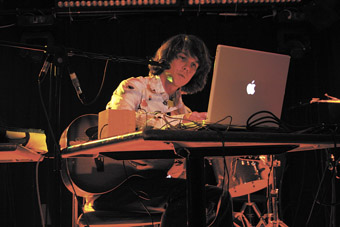
Leafcutter John, Electrofringe
photo Mardy Dean
Leafcutter John, Electrofringe
ELECTROFRINGE. IT’S A TRICKY TIME FOR A FESTIVAL TO CLAIM FRINGE CREDIBILITY WHILE DEFINING ITSELF IN TERMS OF TECHNOLOGY. BACK IN THE EARLY DAYS THE BACKBONE OF ELECTROFRINGE WAS WORKSHOPS ON NEW IDEAS FOR EKING SOME SKERRICK OF AUDIOVISUAL PROCESSING POWER OUT OF A ZERO BUDGET. THAT WILL GET YOU NOWHERE IN 2007. ACCESS TO TECHNOLOGY IS NOT THE LIMITING FACTOR HERE, IN THIS FESTIVAL WHERE THE NON-LAPTOP WIELDERS HANG OUT AT THE EDGE OF THE PLAYGROUND AND SULK. IT IS NO LONGER ENOUGH FOR IDEAS TO BE NEW, THEY MUST ALSO BE GOOD.
That said, this is still an egalitarian festival. If some festivals are agricultural fairs where all you see is the produce in its presentation box, Electrofringe is still closer to Backyard Blitz where we aren’t quite sure what we’re planting ahead of time. But we’re doing it fast, and in teams. One question is whether, in the YouTube generation, the focus on co-creation of the experience is at all fringe—or are the less participatory festivals beginning to be increasingly marginal?
One indicator of the way the mainstream wind is blowing must surely be the ABC, out in force at Electrofringe. Firstly, The Night Air radio-and-podcast performance is back from last year, bigger than ever. Secondly, sure enough, one of the various launches in this festival is an ABC-run social content-sharing website. Radio National’s John Jacobs and Sherre Delys have turned up to get feedback on their plan to produce an online collaborative A/V content repository, which will combine user generated content and archival material from the ABC itself, released under remix-friendly Creative Commons licences. You can smell the online content Zeitgeist.
More interestingly for the cool hunters among us, VJs are out this season, as out as surely as hoodies this month are preppy. The random video artists jamming along with psychedelic video clips to generic beats seem not to have put in an appearance. The venues are blissfully free from any manner of fractals, CGI robots attempting any kind of beatmatching, or oscilloscopes (except for the ubiquitous Robin Fox’s re-interpretation of that idea, and he doesn’t count). The electronic gig, then, tends to the genre of headphone music, the lie-down-and-close-your eyes school of performance. Sadly, the Cambridge Hotel, where the major gigs appear, is not the most suited to this in that no-one has provided spatulas to detach those foolish enough to lie down on the unidentifiable tar-like substance that the hotel classifies as ‘floor.’
Part of the backlash against the two-shy-blokes-with-laptops style is that we all seem concerned with performance aesthetics this year in general, and whether we are using Nintendo Wii game controllers in our art in particular. Paul Gough aka Pimmon declares his allegiance to the principle that computer music doesn’t need to justify itself by buying into the intensely manual modes of performance on acoustic instruments; it’s fine to press play and check your email. Although headliner Tim Hecker concurs during the discussion on their aesthetics panel, their juxtaposed sets in the final gig couldn’t be less similar. True to his word, the abstract soundscapes Pimmon produces are accompanied by little more interaction than the gentle oscillations of his eyebrows. It’s tightly controlled material, although I feel a little disappointed to recognise some of it coming straight off, for example, the *snaps*crackles*pops* album. Hecker’s sound is less tight, but his total engagement with the process and the audience and a very gestural style gives his piece the kind of emotional force that a gig in this venue needs to cut through the background fog of beer. More than that, it must be the most booty shaking ambient harmonic soundscape to convulse the sticky dancefloor, if anyone is keeping records. You can see the bituminous floor slime arrange itself into concentric ripples around the speakers. Or at least I can. The cold light of day might tell a more prosaic tale, but you can get the sober version by turning up to Electrofringe yourself and sticking to orange juice.
More gestural and improvisational still is Leafcutter John. He riffs on prompts and heckles from the crowd, with the sarcastic humour of the smartarse kid up the back of the class on a ten kilowatt PA. Oh, but with more toys. He jams with game controllers, springs, sticks, wooden boxes and an acoustic guitar and whatever else, working our anticipation each time he reaches for a new instrument, each time one of the audience yells out. He latches on to the injunction “Make us dance!” and summons the speaker onto the stage for a short bracket of loose-dancing ballroom moves. It turns out the belligerent heckler in spray-on trousers is Thug Quota, of Melbourne ur-rock ensemble Bum Creek, not to mention lead clarinet in Chalga Party, the hit Gypsy band from last night’s acoustic gig. It also turns out that neither of them knows how to ballroom dance. The ensuing jam between the two strangers, on half-assembled drumkit and guitar, is interesting musically and fascinating dramatically.
The traditional Electrofringe story from this point goes on to climax with further debauchery, possibly in a warehouse party of some description. Hell, possibly even with cheesy VJs. But this late and drunk in the evening, when we have let our hair down enough to consider such unfashionable activity, we are amazed to discover that after the close of the pub there is nothing else on. Damn, I thought we weren’t serious about all that nonsense about such stuff being out of fashion. Where’s the homemade zero-budget sound system when you need it?
Electrofringe/This Is Not Art 2007, Newcastle, Sept 26-30
RealTime issue #82 Dec-Jan 2007 pg. 25
© Dan MacKinlay; for permission to reproduce apply to realtime@realtimearts.net
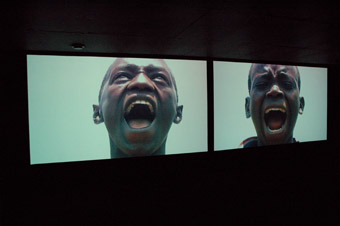
In Still Waters Crocodiles Lurk, Marcel Odenbach
courtesy of the artist
In Still Waters Crocodiles Lurk, Marcel Odenbach
FLYING SOUTH BEYOND AOTEAROA, ACROSS THE ARC OF THE GREAT SOUTHERN OCEAN, TO CROSS THE COAST OF CHILE BEFORE HEADING NORTH OVER THE SNOW-CAPPED ANDES, TO DESCEND LATE AT NIGHT INTO A SOMNAMBULANT SAO PAULO, WAS A VOYAGE ACROSS VAST DISTANCES AND ALSO THE REACHES OF THE IMAGINATION. THE 16TH VIDEOBRASIL INTERNATIONAL FESTIVAL OF ELECTRONIC ARTS IS LIKEWISE EXTENDING SCREEN-BASED ARTS BOTH GEOGRAPHICALLY AND CONCEPTUALLY. THE MAJOR THEME FOR 2007, LIMITE: MOVING IMAGE AND LOTS OF STRANGENESS, WAS UNDERPINNED BY A CLUSTER OF SUB-PROGRAMS THROUGH WHICH THE CONFLUENCE OF ART, VIDEO AND CINEMA WERE TO BE EXPLORED.
Sao Paulo is a city of staggering complexity and scale, and is Brazil’s economic and cultural powerhouse, with over 20 million inhabitants. This year’s Videobrasil had moved to a new venue in the unlikely and unpromising 14-storey office block, the SESC (Social Service of Commerce, a private cultural agency) Centre, on the grand Avenue Paulista in the city centre. Over 10 days SESC was the hub of a glittering constellation of filmmakers, critics, curators and artists gathered from around the globe to participate in a formidable program of retrospective exhibitions, cinema screenings, forums and critical debate.
going up
The five floors of the former office block now the heart of Videobrasil have been stripped bare and skilfully reconfigured as a series of galleries for the huge audience that the festival attracts, shuttled up and down in packed elevators between the successive floors, each dedicated to invited artists.
ground floor
There’s an outdoor video installation by Eder Santor and, in the foyer, a light installation by Angel Detanico Rafael Lain leading to the adjacent cinema and auditorium used for a daily program of screenings and forums.
mezzanine
The videotheque comprises a mini auditorium for forums and presentations, a video library browsing space and a catalogue shop including a rich collection of Videobrasil archive programs.
level 3
Here, the Loop video program, presented on plasma screens, comprised selected entries from the screening program and included works shot on mobile by Giselle Beiguelman and two of the eventual award winning works by other Brazilian artists Ayson Heraclito (As Maos Do Epo) and Alice Micelli’s short tribute to Andy Warhol titled Jerk Off 2. Level 3 also featured installations and exhibition screening spaces for retrospective exhibitions of two significant South America video artists: Arthur Omar and Carlos Adriano. It was a rare excursion into tracing the trajectory of video art development in this region. As a first engagement, what was striking was both the specificity and universality of visual languages. Nuanced cultural references, themes and techniques—borne out of a South American experimental tradition strongly informed by a social documentary style of filmmaking—proved characteristic of a significant number of works presented in this year’s Videobrasil.
level 4
Peter Greenaway’s Tulse Luper, an installation of 92 ‘suitcases’ extraordinaire, was stunningly baroque in its intensity. You are confronted with a dimly lit room with shelves of open cases filled with dusty old shoes, a train set, lingerie, small LCD monitors running video from films etc. For the audience this becomes a curious forensic exercise in deducing the significance of this material in the life of the enigmatic character of Tulse Luper. For the full story go to http://petergreenaway.co.uk/tulse.htm
level 5
An entire floor is devoted to one of the pioneers of western video art, Marcel Odenbach (Germany) with a major exhibition of 15 works dating back to 1978, culminating in a new single channel video installation, Disturbed Places—Five Variations on India (2007). This single channel work, characteristically presented in a complex and meditative documentary style, reflects on an idealized India—as promulgated through the 1960s counter culture—and evoked by the subtle interweaving of soundtracks from films of that era against footage from a recent journey.
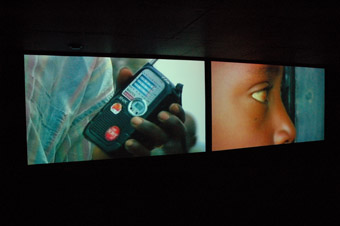
In Still Waters Crocodiles Lurk, Marcel Odenbach
courtesy of the artist
In Still Waters Crocodiles Lurk, Marcel Odenbach
hybridity & a new cinema
The theme of “hybridity of form” between art and cinema has been echoing around major film festivals over the past year including Toronto and Rio de Janeiro. The curator and director of Videobrasil, Solange Oliveira Farkas aimed to develop a common understanding about the ways the imaginative and theoretical spaces of hybridity have been charted and might be navigated in the future.
Explorations of a prospective ‘new’ cinema were grounded against the historical backdrop of a seminal experimental film from 1932, Limite: Movimentação de imagem e muita estranheza (Limite: Moving Image and Lots of Strangeness). A rare screening of this work by Brazilian filmmaker Mario Peixoto provided a central motif for this year’s event, as a precedent in form and technique and a departure from narrative. It is regarded as a film that has nourished and encouraged contemporary videographic language and a deterritorialized cinema.
greenaway festival launch
Peter Greenaway launched the festival in grand style with a massive three-channel outdoor projection component of his Tulse Luper project. More a performative cinema event, it comprised images and scenes conjured live from the artist’s huge database of cinematic works. Here Greenaway re-mixed and jammed with Serge Dodwell aka DJ Radar via a sophisticated touch screen interface. Over an hour the booming club-like atmosphere of the performance was completed by the crush of a street jam-packed with thousands of fans mixed with bewildered onlookers.
True to form, Greenaway’s strident and contentious critique and his experimentation with the formal language of film echoed throughout the week’s program. In an interview he stated, “Cinema is wasted on cinema—we really must put it to better use.” His notion that cinema is ‘dead’ was fiercely contested in a debate between Greenaway and French critic Jean-Paul Fargier who rightly asserted that it was “a claim too far.” The compromise reached was that we are seeing the birth of a ‘new cinema’ for which Greenaway was claiming some sort of paternity
What new forms art and cinema in the digital era might take was further explored in an extensive programs of exhibitions, retrospective screenings and forums which included works by Kenneth Anger, Marcel Odenbach, Arthur Omar, Carlos Adriano, Edgard Navarro and a huge program of recent screen works from around the world.
jury duty
Regrettably, I was unable to see all of the programs. I was there to work. A small group of jurors, our task was to deliberate on the subject of the confluence of art and cinema, and award three major and three supplementary prizes from a pre-selected program of 66 new works drawn from a total pool of more than 700 entries.
Australian artists have a significant history of participation and achievement at Videobrasil over many years. Peter Callas, Deborah Petrovich and Norie Neumark are among the dozens of Australians represented since the 90s. Australian artists on exhibition this year were Bridget E Walker, John Gillies, Alexandra and David Beesley and Shaun Gladwell together with a program I curated of Australian video works, titled Panoramas of the Imagination.
Likewise the other jury members were invited to curate and present their own video programs. These included Berta Sichel, Senior Curator of film and video at the National Museum of Art, Madrid, Tanzanian filmmaker, academic and director of the Zanzibar Film Festival Martin Mhando, Jean-Paul Fargier, author and art and cinema critic for Les Cahiers du Cinema and Daniela Bousso, Brazilian media art curator, writer and critic.
the future now
What Videobrasil so eloquently proposed and demonstrated is that we have entered a new space where boundaries fall away and that we can intelligently move into a creative and critical space where a new language of the screen can accommodate and embrace the wealth of possibilities that have been developed by artists and filmmakers over the past 80 years. We have this within our grasp. One work by Marcel Odenbach, about post-genocide Rwanda, elegantly and powerfully articulated what a new cinema might be. A simple two-channel installation titled In Still Waters Crocodiles Lurk (1995-2004), it dissolved the interminable dispute over narrative and form.
For more about Videobrasil, including this year’s award winners, go to www.sescsp.org.br/sesc/videobrasil/site/festivais/festival_16_en.asp
Videobrasil, 16th International Electronic Arts Festival, SESC, Sao Paulo, Sept 30-Oct 25
In RealTime 83 Nigel Helyer reports on Mexico’s Transitio_MX02 Mexico new media and video festival.
RealTime issue #82 Dec-Jan 2007 pg. 26
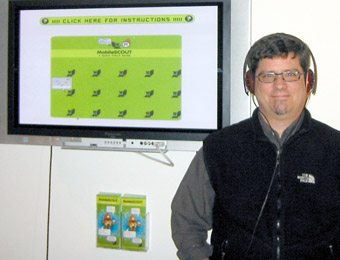
Steve Dietz listening to Mobile Scout at the Database Imaginary exhibition, Walter Phillips Gallery, Banff, Canada
THE VISUAL ARTS BOARD OF THE AUSTRALIA COUNCIL INVITED STEVE DIETZ, A SEMINAL FIGURE IN AMERICAN CURATION OF NEW MEDIA ARTS AND CURRENTLY DIRECTOR OF THE ZERO ONE BIENNIAL FESTIVAL IN SAN JOSE, CALIFORNIA, TO COME TO AUSTRALIA TO MEET ARTISTS AS PART OF ITS INTERNATIONAL MEDIA ARTS STRATEGY. TAKING ADVANTAGE OF THE VISIT, REALTIME, D/LUX/MEDIA ARTS AND PERFORMANCE SPACE COLLABORATED WITH THE VISUAL ARTS BOARD TO HOLD AN OPEN DISCUSSION BETWEEN DIETZ, SYDNEY ARTISTS AND CURATORS AT CARRIAGEWORKS. THE CONVERSATION FOCUSED PRINCIPALLY, EVEN RELENTLESSLY, ON THE STATUS OF TECHNOLOGY IN MEDIA ARTS, NOT LEAST ON THE WORD THAT WON’T GO AWAY—NEW. A TRANSCRIPT OF THE MEETING, INCLUDING DISCUSSION OF THE RUNME.ORG SOFTWARE ART SITE AND THE GUGGENHEIM VARIABLE MEDIA INITIATIVE, CAN BE READ AT WWW.REALTIMEARTS.NET/FEATURES. HERE ARE SOME EDITED EXCERPTS.
Anna Waldman, Director, Visual Arts Board, introduced Dietz to the gathering, detailing his extensive media arts career since the 1990s, including 1996-2003 as curator of new media at the Walker Arts Centre in Minneapolis in the US, where he founded the new media initiative Beyond Line Art Gallery 9 and the Digital Arts study collection. Dietz has written and edited extensively and organised and curated many new media exhibitions including some of the first online exhibitions. He was director of ISEA 2006, Symposium Zero One, San Jose and is artistic director of the biennale Zero One, Global Festival of Art on the Edge in San Jose, 2008. Waldman was pleased, she said, that Dietz had “positioned Zero One as an event where artists are making art”, rather than making work about technology, and reported that he had “described his curatorial role as being polymorphously inquisitive”—as the full transcript of the meeting attests.
Keith Gallasch In one of your essays, you quoted Tom Stoppard, from his play Arcadia, saying, “It is the best of all possible times to be alive when everything we thought we knew is wrong.” Has your own career been like the twists and turns of media and media arts developments?
Steve Dietz I did go to art school and very smartly knew that I shouldn’t try and be an artist after that. But I was always interested in the combination of art and text, you know, sort of multiple things at once, and I think probably for many people around the circle here, the so called ‘new media’ was a place where you didn’t quite fit in as an architect or an engineer or a programmer or painter, and somehow this sort of combination of things was an amazing opportunity. And that was what Tom Stoppard [was referring to], that we didn’t know exactly what was going to happen but there was a kind of excitement and enthusiasm and it wasn’t about success in traditional terms, it was about exploration and energy and for me it was around text and images and that photography is both an artform and a system of communication, and digital media was sort of that on steroids.
What actually grabbed me was the CD-Rom. I saw it and I thought this is what I want to do, and I went back and sort of founded the New Media Department at the Smithsonian American Art Museum. But I think net art was interesting because it was, kind of oddly, a substantiation of a virtual world. It’s a kind of platform that one could talk about that historically, I think, didn’t exist quite in the same way until the advent of the internet and especially the world wide web. So that’s where a lot of my early curatorial energy was focused because for me one of the roles of the curator is to be a follower not a leader. There were lots of artists, I think, who were doing things on the net that were interesting to me and I wanted to make them interesting to both my colleagues and the general public.
KG Later on you wrote an important paper called “Just Art: Contemporary Art after the Art formerly known as New Media.” I was wondering, how did you arrive at the ‘Just Art’ position having been so heavily involved in the promotion of new media art? Was this a rhetorical point? In what way was it strategic, because in the same essay, although you say it’s “formerly known as new media art”, you defend artists against the charge of technophilia. You say, in fact, that new media art would save contemporary art because it would never be curated in the same way, and you say at the end, new media art won. New media art is dead, long live new media art. Are you having it both ways?
SD Yes, exactly. For a time I was very interested in championing and understanding the sort of differences and the new possibilities and capabilities and especially network and computational based artwork. But I think at a certain point there started to be a kind of ghetto happening, a kind of division, of conversations that weren’t happening between contemporary artists and so-called new media artists. And one of the things I write is that every single artist and curator I talk to says it’s not about the technology, it’s about the art.
My argument is, and not everyone agrees with this, that the best way to understand contemporary art is though the lens of new media art. It’s ephemeral, it’s performative, it’s real time, it’s all these things that everyone is dealing with and new media artists in particular have been dealing with them for a long time. So it’s a bit of a stretch—in the real world, in the pragmatic world—to say that new media art is “now.” But I do think that a lot of the issues that we have been dealing with for however many years are ones that are also front and centre in the contemporary art world and so, we need to have that conversation.
KG And so in your own festival, Zero One, in San Jose, what kind of art do you include if you want to realise more expansive vision?
SD Well, I think that the goal of the festival is to be about contemporary art that intersects with technology but is not medium specific. So it has nothing to do with whether it’s a computer or projector or a network. It could be a painting, it could be a sculpture, it could be, you know, some version of nature. And so in that sense it’s a very open field. But I do feel like a whole range of artists are looking at how technology has impacted on the universe for better and worse over the past 40 years and to separate those artificially into media arts and contemporary art is no longer a very interesting proposition. So when I go to the Sao Paulo Biennale and see fantastic work and really interesting ideas and there are no artists who actually use technology in a compelling way, it’s depressing…Many new media artists are very cogniscent of their relationship to the ideas of the contemporary art world. It’s the institutions and curators that I think are keeping or creating the separation, for some odd reason.
Lizzie Muller You were saying you’ve spoken to lots of new media artists who say their work is not about the technology, it’s about the art. But I wonder if that’s one of the distinctions that’s becoming a bit of a problem because if technology is someone’s medium, it might be fair to say that their art is very much about the technology…Another possibility is that the division between art and technology has held for such a long time that if, as new media people, we continue to say it’s not about the technology, we are kind of refusing to allow our medium to be brought into contemporary art spaces, whereas if we started to say, actually it’s very much about the technology and we work with technology, as a material, that might start to create some of those conversations between contemporary and technological art.
SD …[T]echnology is changing how society works and this is my sort of core argument. [T]he computerisation of society, the combination of computation and networks has changed the world. And the world includes art. But my experience, and frankly my own interest, is not that artists formerly known as new media artists are interested in their art being understood as being about technology.
Denis Beaubois It’s very interesting for me because I don’t think it’s an either/or argument, I don’t think it’s polarised like that. I think part of the debate about new media, in my understanding is, that it is a fluid thing, a developing field, something that is active, and shouldn’t be pinned down by a medium.
LM Is it not possible to say that you couldn’t make an artwork now that wouldn’t be dealing with the impact of technology on experience, on one’s life? But that, on the other hand, some artists are really confronting that impact in an explicit way.
SD That is very well put in terms of how I would like to think about Zero One, because one shorthand way of saying it is that it’s not medium specific. And I think the other thing is that it is a complicated argument and I’m not trying to say that there is contemporary art sitting up here, and we’re all trying to be there. We have to actively support a heterogenous environment, the idea of experimentation and the support of new practices, and you know, those are really critical issues that can’t be ignored, or shouldn’t be shoved away. At the same time, I also think we have a certain responsibility, whether we’re curators or critics or artists, of not limiting ourselves to our most comfortable circle, so to speak.
David Cranswick The thing I’m thinking most about at the moment is the technology, which is the substance of what the artists are working with…People now have fluency with navigating and understanding networks and systems—everyone has been drilled in the revolution …but again, artists have been working for decades now, have been doing great stuff with this.
SD Exactly my argument—I would say everyone except the institutions and the curators, right? The argument is not with the artists, the artists are not the problem…On the face of it, there is no adequate generalised appreciation of the amazing work that artists formerly known as new media artists are doing. And that’s, you know, bordering on criminal.
DC We’ve talked with you about ecologies and GPS and locative media. In recent months more and more people, and organisations like the City of Sydney, have alerted themselves to the fact that there are new channels, and they’re interested in how people traverse the city and how we might communicate with people, say within an arts festival or a biennale or so on. Thinking about five years from now, I’m not asking you to name the technologies [that will dominate], but is it GPS or some super network? Where are the movements do you think?
SD I was talking to someone here earlier about Second Life as an instantiation of a larger issue around virtuality and networks. And at one level, I couldn’t care less about Second Life per se. It’s a particular thing of the moment. So I do think that networks and computation are critical and what’s happened is that there’s this convergence…of mobility, the power of computing and the global network always being available. And that creates new possibilities, and I think that the larger issue there is how do we think about a universe that’s always online everywhere, all the time. And, yes, I absolutely think that that’s a direction that’s happening, whether it’s the iPhone or the Palm Pilot or GPS or a new set of satellites that the Chinese will put up into orbit—I don’t know, but I think that will change things. But the interpenetration of the network of computation into the physical world is only going to get more and more dense, and artists are going to do more and more interesting things with that.
See Features: RealTime/Performance Space Forums for full transcript.
–
Meeting Steve Dietz, presented by RealTime, Performance Space, d/Lux/MediaArts and the Visual Arts Board of the Australia Council for the Arts at Performance Space, Sydney, Australia, Aug 21, hosted by Keith Gallasch, Managing Editor of RealTime and David Cranswick, Director d/Lux/MediaArts.
Further information about Steve Dietz can be found at www.yproductions.com
Steve Dietz visited Australia as a guest of the Visual Arts Board of the Australia Council for the Arts as part of its International Media Arts Strategy.
RealTime issue #82 Dec-Jan 2007 pg. 27
© Keith Gallasch; for permission to reproduce apply to realtime@realtimearts.net
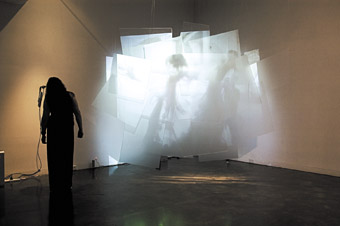
Impossible Geographies, Memory
photo Nicholas Goldhourst
Impossible Geographies, Memory
IT’S A WET AND COLD AFTERNOON IN EARLY SPRING AS I SLIP THROUGH THE DOORS OF THE TIN SHEDS ON SYDNEY’S ROARING CITY ROAD. THE PHYSICAL GEOGRAPHY OF SO MANY THOROUGHFARES IN THIS CITY IS UGLY AND ANTI-PEDESTRIAN—LONG WAITS BETWEEN MULTIPLE TRAFFIC LIGHTS TO CROSS THE ROAD; BUS STOPS EXPOSING COMMUTERS TO THE FORCE OF THE ELEMENTS; SEMI-TRAILERS THUNDERING PAST AND PELTING OUT SMOG. WHAT A DELIGHT, THEN, TO ENTER INTO AN UTTERLY DIFFERENT TERRAIN: THE UNHURRIED, LUMINOUS AND IMPERCEPTIBLE SPACES OF PETRA GEMEINBOECK’S EXHIBITION, IMPOSSIBLE GEOGRAPHIES.
Here we encounter two installations that stretch and fracture screen space, stitching and splitting image projection, surface and interaction. Installations that amplify the weird radiance of digital light—to the point where it becomes the material substrate constituting the works’ visual field. Installations that mesmerise in the minutiae of their movements or in the slow image disintegration that they perform.
The two installations that form the topography of this other space—Memory and Urban Fiction—both depend on maintaining a relation to physical, encountered and imagined spaces outside the refuge of gallery walls. Memory is a restaging of an installation that Gemeinboeck exhibited previously in Singapore, the US and UK. This was its Australian premiere and this fact alone attests to the lag we still experience in curating and providing access for our audiences to experimental new media arts. Memory captures audience members’ images as we pass into its net of Mission Impossible style laser beams. These ethereal bounding mechanisms trigger image captures, which end up spread both across the work’s fractured and layered screens and deposited in a databank. We join up with the ghosts of audiences long past and become slots in the computer’s memory to be accessed according to its algorithmic and rhythmic processing. That space of computational processing—utterly impossible for human memory to inhabit—nonetheless returns on the installation’s screens. We find our own real time gallery movements conjoined with the traces of previous visitors and of movements we have made in the gallery only five minutes before.
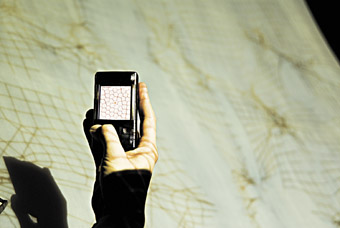
Impossible Geographies, left – Urban Fiction
photo Felicity Jenkins
Impossible Geographies, left – Urban Fiction
We expect a mirror, conversation or cause and effect response as we interact with Memory. We are met instead with distribution, fragmentation and filtering of the relations between image/trace, computer/embodied human and processing/thinking. What is delightful and pleasurable about Memory is that these are impossible spaces to navigate, if by navigation we mean to steer or move in a purposeful manner toward obtaining a goal. But this impossibility makes the interaction all the more enjoyable, provoking us to experiment with virtual and actual space and action.
We are also impossibly tiptoeing through something else in Memory—time. Although digital media have long been flaunted as ‘nonlinear’, much of our experience of them tends really to be multilinear. We branch through options in an interactive story; we go forwards, backwards, even sideways but advance through levels in gaming. Memory, however, gives us no such pathways: visitors’ images from the installation’s past are entangled with our own in a visual dynamic and in the software dynamically processing its present and prior captures. There are gaps and syntheses between the present and past and the installation’s future only materialises from this interplay. Memory is one of those rare interactive experiences where we momentarily perceive the impossible temporality of the nonlinear.
A fracturing aesthetic and experimentation with dynamic human-machine interaction connect the installations Memory and Urban Fiction, within the gallery. What threads together the two works visually is the distribution and layering of screen spaces. Rather than just a convenient wall to absorb projection, Gemeinboeck treats screens viscerally. They are the fabric and fabrication place of digital production, to be ripped, stitched, piled upon and scattered. In Urban Fiction, three screens are stretched in mid-air, catching their projections but also letting the edges of the moving image spill out onto the floor. Everything is beautifully positioned and executed yet simultaneously unshackled.
But what are we actually looking at? Pulsations become patterns; dots march imperceptibly across the screen space; deforming lines and grids slowly unravel. This feels like a fragment from a map of planet ‘Information’ or the twisted, skeletal wire-frame of 3D-generated space or computer code run through a visualiser of the imagination. If Urban Fiction is a map, then it is not of familiar territory and it defies all formal cartographic conventions. And yet, the barely moving images are all generated through engagement with the surrounding geography of Darlington. Participants use customised mobile phones to walk around the vicinity of the gallery. The installation also logs signals from unwitting mobiles on the same network within specified parameters surrounding the gallery. These signals all aggregate via custom software into forces and tensions that interfere, are sutured into and deform the image fields.
As we stand in the gallery, we begin to realise we are watching the formation of vast movement patterns beyond singular instances of navigation through urban space. We keep time instead with collective city rhythms beyond immediate visibility. Indeed we see more than we would when looking at a map or image of the city. For here the surrounding buildings block, refract and lose network signal and these processes affect the absorption of signal into the data capture process. An image scape emerges of the urban landscape we think we know but to which many histories, forces and traces also belong. What emerges is not cartographic but topological—the nonphysical yet ever-present ground of shifting relations between people, between people, buildings and urban cultures, buildings and signals, signals and signs, all contributing to contemporary urbanity.
Petra Gemeinboeck, who lectures in digital media in the University of Sydney’s Faculty of Architecture, is one of those rare new media artists whose work is equally aesthetic and intellectual. The sensation of inhabiting her impossible geographies is visceral but also a jolt that provokes thought: the thought of inhabiting the impossible. Like that of Jorge Louis Borges’ writing fragment, The Garden of Forking Paths, Gemeinboeck’s ‘impossible’ is actually a space and time of infinite possibilities.
Petra Gemeinboeck, Impossible Geographies: Memory (in collaboration with Mary Agnes Krell), Urban Fiction, Tin Sheds, Sydney, Aug 21–Sept 8
RealTime issue #82 Dec-Jan 2007 pg. 28
© Anna Munster; for permission to reproduce apply to realtime@realtimearts.net
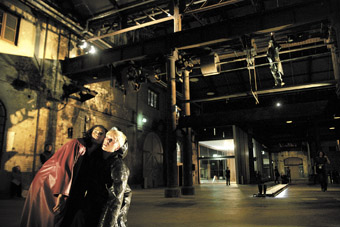
Henrietta Baird, Tess de Quincey, The Stirring
photo Heidrun Löhr
Henrietta Baird, Tess de Quincey, The Stirring
IN DE QUINCEY CO’S THE STIRRING, THE AUDIENCE MOVES ABOUT A CARRIAGEWORKS BOTH REAL AND IMAGINED. WELL BEYOND THE WATCHING OF PERFORMANCE, WE ARE PLUNGED INTO AN INTERROGATION OF INTERSECTING TEMPORALITIES BOTH MATERIAL AND IMMATERIAL.
The nature of roaming spectatorship precludes engagement with everything performed in the variously titled rooms (Shrine for a Whale, Snort Room etc) and corridors (Kandinsky’s Loop, Long Rails) of this industrial palace. Yet, I am somehow privy to all that happens because of the tangibility of response in movement quality between performers, and the piecemeal dissonance of stories continuously told, repeated in apocalyptic paroxysms or announced with statesmanlike cheer from a manhole.
First, I catch sight of Victoria Hunt’s shrouded body suspended from one of the vertical balusters, rapidly recoiling and arriving at prostrate gestures that loom over Tess de Quincey’s invocations at the mouth of a ‘river’ (lined rails filled with oil). A single motif (straight hand and arm held aloft) by de Quincey registers the relationship between performers. It’s picked up and signaled by Henrietta Baird who is enveloped by Oguri in quiet, quickly paced circles. The scattering of performers from this point is equally marked in the pattern of audience movement.
High in the gantry, Alan Schacher, in scurried motion, screams “There are no angels”, his performance, in distinct contrast to the others, approaching well-formed character. Meanwhile beneath, Baird negotiates another tongue with others not visible. It fills her with a sense of urgency netted by hesitation. Intricate shapes are formed in her hand, her movement punctuated by jumps and sporadic runs halting in stillness. Later she floats like a siren from unfathomable depths while hanging by her ankles—the pained quivering and twitching of the body yielding a striking illusion of beauty. Simple non-mediatised techniques meddle with perception.
In the Snort Room a piece of industrial balustrade precariously swings from a short chain, playing paradoxically with my sense of weight. Further away in the distance three figures in white stand motionless, empty, just there, until the passing of a train jiggles them into animated conversation. It is a vignette powerful in its use of serendipity, and intimate despite the distance.
Inside the Shrine for a Whale room, a huge mound of stones steams steadily. A thin spray of water falls imperceptibly at first until I feel the moisture on my lips and move to another position. Oguri’s hunched being dances effortlessly. His already soiled, hooded white coat sculpts his tiny body and hides his face. He steps cautiously with great delicacy in the unfolding landscape, his head escaping the hood like a mouthing infant finally leading him to climb the obstacle before him. The crunching of stone provides an underscore to the sonic tabernacle of mechanical polyrhythms and noise tectonics composed by Natasha Anderson. The voice of the building participates in the dialogue connecting rooms, notably silencing when the performers do. De Quincey and Oguri join each other briefly. Object composition, incidental shadows and patches of stasis juxtaposed with motion function to displace our beingness in this place, especially through oddities of scale. The dance devolves into the swallowing of Oguri’s shadow by de Quincey’s body.
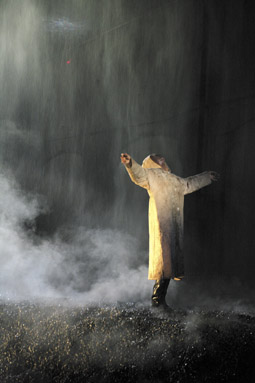
Oguri, The Stirring
photos Heidrun Löhr
Oguri, The Stirring
The costumes by Lian Loke pronounce the weathering of elements inside this world of water, steel, stone and concrete. They offer material documentation in their exposure to the rolling, pressing and rubbing of the performers. Like wearable flats, the performers seem to use the hooded coats to transit scenes.
The five performers in The Stirring dwell resolutely in the tension between points of definitive arrival and unsettled dissipation. The cheek to cheek duet between de Quincey and Baird is a soothing communion, a reckoning that has all five performers walk toward two drums of bubbling fire in a final potent image. We are invited to stand opposite them. They smile, their hands outstretched. Silence.
The Stirring plumbs the temporal dimension of the CarriageWorks, reconstituting its past, present and possible future ecology with the many palpable languages found onsite.
–
De Quincey Co, The Stirring, concept and direction Tess de Quincey, choreography, performance Tess de Quincey, Henrietta Baird, Peter Fraser, Victoria Hunt, Oguri, Alan Schacher; composer/installation Natasha Anderson, lighting Travis Hodgson, costumes Lian Loke; CarriageWorks, Sydney, Nov 8-17
RealTime issue #82 Dec-Jan 2007 pg. 29
© Jodie McNeilly; for permission to reproduce apply to realtime@realtimearts.net
BLENDING DANCE WITH SPOKEN TEXT, LEHMEN LERNT IS A WITTY MEDITATION ON LIFE AS A NEVER-ENDING LEARNING PROCESS. CLAD IN A BLUE WORKMAN’S OVERALL, THOMAS LEHMEN PERFORMS ON AN ENTIRELY WHITE STAGE. HE SPEAKS GERMAN; ENGLISH SURTITLES ARE PROJECTED AGAINST THE BACK. THE WORK’S PREMISE IS DECEPTIVELY SIMPLE. LEHMEN RECITES A LONG LIST OF THINGS HE HAS LEARNED IN LIFE, EACH STARTING WITH “I LEARNED TO…” MANY OF THE STATEMENTS ARE FOLLOWED BY PHYSICAL DEMONSTRATIONS.
The German choreographer and performer is widely regarded as one of Europe’s most innovative and forward-thinking dance artists of recent years. Regularly presenting work at dance festivals worldwide, Lehmen recently paid his first visit to Australia. He was brought out to teach workshops for STRUT Dance in Perth and Critical Path in Sydney. In Sydney, Lehmen also presented his solo Lehmen Lernt (Lehmen Learns), for one night only, as part of the Goethe Institut’s GerMANY FACES australia arts festival.
Lehmen’s learning list is eclectic, detailing a wide range of activities. At first it seems as if it’s chronological, starting with the skills Lehmen acquired as a newborn—screaming, breathing, drinking, looking. Then he learns to crawl, walk, play, speak. And later to read, write, count, calculate, ask questions. It is not until Lehmen tells us that he learned to construct machines and build houses, bridges, schools and theatres that we realise that he is not necessarily only talking about himself. Lehmen Lernt explores the art of learning as a universal phenomenon but the artist keeps listing his alleged learning experiences in the first person—navigating a rocket to the moon, giving birth, organising wars, taming wild animals.
Lehmen’s physical interpretations of his statements are often amusing, especially when he moves away from the purely illustrative. “I learned to make art” is followed by Lehmen standing on a spot with his back to the audience, lifting his arms to the sides and screaming “art.” For “I learned self hypnosis” Lehmen assumes the roles both of hypnotist and hypnotised, engaging in a hilarious dialogue. “I learnt to avoid my problems” has him navigate the empty stage as if dodging invisible obstacles.
Towards the end, Lehmen puts on a red nose and tells the audience, in the persona of a clown, what his original intention for the work was—to bring together on stage a group of people, each one with a different set of skills. They would then share their knowledge, profit from each other and in this way try and make the world a better place. There is no doubt that this idea is as fabulous as it is silly. But then, Lehmen had already told us: “I learned to be naïve, dumb, full of pathos and, again and again, empty and stupid.”
Thomas Lehmen tackles his subject matter with humour and intelligence in equal measure. Every aspect of the performance seems thoroughly thought through. This applies to the concise writing and its crisp delivery as well as to the predominantly gestural movement vocabulary that is executed with impeccable precision. There is also a tremendous conceptual rigour evident in the work. The extent of the artist’s research is revealed later in the piece when a film is screened showing him with various teachers. He learns, among other things, to bake a cake, sweep the streets, fly a small plane, whistle to musical accompaniment, fish, beatbox and speak Japanese.
Through the film, we learn how strongly Lehmen’s research has fed the creation of the piece. For example, the blue overall was the one he wore when he developed his clown persona, under the attentive instructions of a clowning teacher. We also discover that many of the moves Lehmen uses on stage are inspired by his training in dance and martial arts. It is striking to see how committed Lehmen is to his numerous lessons and how seriously he takes the act of learning. He is clearly an astute observer, driven by great curiosity.
Lehmen Lernt treads a fine line between being truly profound and utterly banal. But then maybe the difference between the two is not as great as often perceived. Thomas Lehmen certainly seems to believe that learning is not only about acquiring skills but also a way of trying to make sense of the absurdities and complexities of life. It is this belief that, ultimately, makes Lehmen Lernt a deeply humanist work and a highly entertaining and intellectually satisfying one.
Lehmen Lernt; concept, choreography, dance, text by Thomas Lehmen, Performance Space, Goethe Institut, gerMANY FACES australia, CarriageWorks, Sydney, Oct 6
RealTime issue #82 Dec-Jan 2007 pg. 29
© Martin del Amo; for permission to reproduce apply to realtime@realtimearts.net
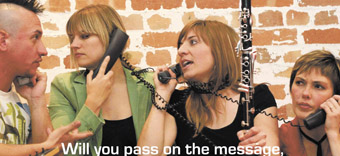
Harm Te Kuru, Nerida Matthaei, Nicole Canham, Skye Sewell, Phluxus dance collective program image, Chinese Whispers/Broken Telephone
PHLUXUS DANCE COLLECTIVE IS AN ENGAGING NEW BRISBANE COMPANY. THEIR FIRST WORK, THE MACHINE THAT CARRIES THE SOUL, WAS RECENTLY AWARDED THE CRITICS CHOICE AWARD IN THE 2007 SHORT AND SWEET AND DANCE FESTIVAL IN SYDNEY, HAVING ALREADY BEEN AWARDED RUNNER-UP FOR BEST DANCE/MOVEMENT PERFORMANCE AT LAST YEAR’S MELBOURNE FRINGE FESTIVAL.
The designation ‘collective’ is a nostalgic one nowadays, and Phluxus seemingly connotes both the name and spirit of the Fluxus art movement of the 1960s. There is a ‘family’ connection across time and across art boundaries, and in the relaxed and playful familiarity of the performers with each other and with their audience. I enjoy the fact that clarinetist Nicole Canham’s creative partnership with founder and performing artist Nerida Matthaei began many years ago singing Count Basie tunes together while decorating the Christmas tree.
We are at the Hot Gossip Lounge, cabaret style. Coloured globes float like planets in space above a minimal stage. There is a joke (at John Cage’s expense?) of a grand piano that is never played. Chinese Whispers/Broken Telephone is an exploration of the children’s party game which, at core, involves “cumulative error and communication breakdown…subtle shifts and changes moving between what you hear and what you see.” New York Counterpoint composed by Steve Reich has the soloist live accompanying a prerecorded tape of herself. Shifts and changes between the two modes of musical presentation create different inflections that extend into literal footnotes of commentary and baroque, Borges-like addenda by dancers Matthaei and Skye Sewell whose entwined hieroglyphic hand and arm movements sometimes evoke Chinese opera or Tai Chi.
The choreography adds different layers of concatenation and syntheses as the music becomes shriller and the moves smaller, tightening into exquisite focus on Canham’s fingers on the clarinet. Although music and dance are non-discursive, formally independent of semantic meaning, they are nevertheless constituted by their own phrases and syntax that, in this subtly abstract and contemplative piece, mix and merge, effecting a kinesiology of signals and signs that achieves a highly satisfying interface. Reich’s aural sculpture, Pendulum Music, with its haunting feedback effects, likewise interfaces with the kinetic installation created by Marisa Cuzzolaro’s video projections and pendulously swinging lights winding down to reinforce the perception of language and the body (by its absence) in fluid permutation but mutually subject, perhaps, to gravity.
Touching on a more accessible human dimension, the vaudevillian take on The Three Etudes on Themes of Gershwin by Paul Harvey, provides a change of pace, looking at role reversals between a ventriloquist and her doll. Matthaei and Sewell are superbly and entertainingly acrobatic in routines involving possession of a chair. Snatches of familiar melodies evoke nostalgia for sense in a world that is constantly being subverted by clowns. There is an interlude for participation, the audience dividing into three sections to be briskly (no time to think!) inducted into the reproduction of simple sounds and dance movements in a good-humoured, non-threatening manner that democratises as well as demystifies what is, after all, a highly sophisticated avant garde undertaking.
There follows a competitive, rapid-fire game-show version of Chinese Whispers with the audience as two teams. The last piece evolves through movement reminiscent of contact improvisation as a choreographed argument which finally subsides through the imposition of a yellow card, orange card and red card. Although well constructed and witty, this is perhaps the least successful as a discrete movement piece as it lacks full expression of the ritual nature of antagonism and its implicit rhythms. This aside, the composition Chinese Whispers by the group Alchemist was given an interesting electronic treatment by Harm Te Kuru “trying to capture the density of texture found in heavy metal music but using less familiar devices.” Canham’s clarinet comes through the filter of an effects processor.
Nicole Canham’s onstage presence was a bulwark of the evening, with Matthael and Sewell compellingly watchable, effortlessly stitching together in their movement work the remarkable (and contrary) strengths of teflon and toffee. Apart from sheer enjoyment, I liked the non-hierarchical nature of the performance (and the dues paid to the ‘silent partners’), a refreshing ingredient in itself.
Phluxus Dance Collective, Chinese Whispers/Broken Telephone, clarinet Nicole Canham, performers Nerida Matthaei, Skye Sewell, video & photography Marisa Cuzzolaro, electronica Harm Te Kuru, sound & lighting Chris Neehause, Ben Hughes, Matt Cody, Don Mackenzie, Corrin Matthews; Judith Wright Centre for Contemporary Arts, Nov 1
RealTime issue #82 Dec-Jan 2007 pg. 30
© Doug Leonard; for permission to reproduce apply to realtime@realtimearts.net
DANCER AISLING DONOVAN RECENTLY DISTINGUISHED HERSELF AS THE LEAD IN AIMEE SMITH’S COURAGEOUSLY HEROIC GALLANTRY, A DEMANDING PIECE WHICH EMPLOYED HARD ARTICULATIONS AND FOLDS OF LIMBS SPRINGING BACK AND FORTH BETWEEN AWKWARD AND ABSURD POSITIONS (RT 78, P33). A NEW WORK FROM DONOVAN FEATURED IN STRUT’S LATEST PROGRAM, DANCE #2, CONTRASTING REVEALINGLY WITH NEW WORKS FROM FLOEUR ALDER AND DEBORAH ROBERSTON.
aisling donovan
Donovan’s choreography, like Smith’s, also employed fierce limb extensions, carving up a corner with her arms and legs. Nevertheless, her Room With A View suggested a goth, if not melodramatic, ambience, unlike the bleak humour and cool detachment of Gallantry. The willowy dancer’s swathes of long, flying hair supported the work’s emotional tenor, Donovan presenting a figure on the verge of emotional self-destruction. Never quite fully dramatic, after a relatively static and introspective opening the dancer’s frenetic pacing and jagged twists were suggestive of the dark night of the soul. The ‘never-quite-there’ of the emotion was part of the work’s appeal, as well as its weakness. Theatrically, Donovan provided little to guide the audience through the emotional journey presented, beyond the heavy-handed music by Tool. This created a strange vacuum at the heart of the work around which Donovan’s muscular, bony poses moved. Overall, Donovan has established that she could dance a telephone book superbly, but the connection between form and affect here was uncertain—she needs to explore this further or throw herself deeper into expressive angst.
floeur alder
The use of a youthful muscular body to suggest emotional states from amidst a whirl of activity appears to ally Donovan with Floeur Alder. Donovan’s choreography and her work with Smith links her to the hard muscularity and performance art allusions of Australian postmodernism (Guerin, Adams, Stewart etc). By contrast, Alder has returned to Modernism’s heritage to produce a wonderful solo which could have come out of the Denishawn School of the 1930s. Using a suitably ‘exoticist’ score in tune with the primitivist allusions of Euro-American Modernism, Alder’s endlessly tensed body, and her expansions in and out of the chest, were executed in concert with clawed hands and spikily bent arms which recalled Wigman’s Hexentantz of 1926. Martha Graham and her predecessors trawled the cultures of those they called “pre-modern” for the primal rhythms of humanity, and Alder was well served by her choice of nuevo flamenco to accompany her own vibrant Expressionism. While Alder avoided the radical arching of the back in favour of a fluid, perching pose, settling into the ground and tearing out of it, every stance and spasm was nevertheless informed by the breath and energy clasped beneath her sternum. Despite the long history of this approach—to say nothing of how many consider it a politically problematic aesthetic—there is no denying Floeur Alder’s command over the material, nor her ability to craft these gestures and affects into a compelling study. Closer to Graham than Wigman, Alder’s dance too (not unlike Donovan’s) teetered on the edge of an emotional explosion. But where Donovan offered a curiously excessive body centred on an absence, Alder’s was a deep pool. Even so, the force beneath these waters was not released. Energy surged in tightly constrained, anguished pathways, imprisoning the body within its own richly affective forces.
deborah robertson et al
Choreographer Deborah Robertson’s task-based, performance art-like work offered something more than Alder’s intensity and Donovan’s emotional displacements. Robertson, Aimee Smith and Laura Boynes exhibited striking physical diversity. Robertson is a highly sensate dancer, proceeding from a quietly measured, inward self-awareness akin to Rosalind Crisp’s. Boynes and Smith are not indifferent to such subtle internal shifts, but their movement—both in this piece and in other projects—comes initially from outside the body, from form, shape, or political ideas. This dissonance suited the piece in that the often deliberately pedestrian movement revolved around a failure to fully connect; on rejection and ignoring one’s fellow. Smith was a lone rejected figure on a chair at the front while Boyne’s rapid move from her chair or away from Smith gave her movement a nasty edge. Robertson by contrast seemed a gentle focal point shifting throughout the space, but her mild articulations and reassuring self-awareness nevertheless failed to resolve this drama of dislocated individuals. Sounds of cars and city noises added a further layer to the sense of urban alienation. However, a work about the disarticulation of society risks drifting apart. Nevertheless, Robertson disarmingly sustained a sense of both accusation and forgiveness, of atomisation and socialisation in this simple work, providing a wonderful richness to its otherwise spartan form—an affective strategy far removed from the works by Alder and Donovan.
Strut Dance, Dance #2 2007, artistic director, curator Sue Peacock; Room With A View, choreographer, performer Aisling Donovan; Confessional, choreographer Deborah Robertson, performers Robertson, Aimee Smith, Laura Boynes; Seven choreographer, performer Floeur Alder; plus works by Keira Mason-Hill, Simon Green and Gerard Veltre, Bianca Martin, Lena John, Sally Blatchford and Shannon Riggs, Sarah Neville, and Valli Batchelor; King Street Arts Centre, Perth Oct 18-21
RealTime issue #82 Dec-Jan 2007 pg. 30
© Jonathan Marshall; for permission to reproduce apply to realtime@realtimearts.net
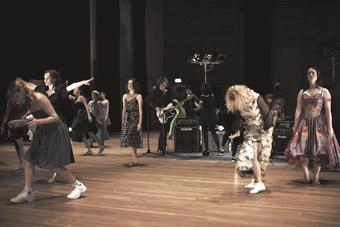
The Fondue Set, Evening Magic 2
photo Irèn Skaarnes
The Fondue Set, Evening Magic 2
THE HUGE PERFORMANCE AREA IS EVENLY DOTTED WITH DANCERS DANCING. THEY ARE PERFORMING BLANCHED VERSIONS OF ‘TYPICAL’ EXERCISE ROUTINES FROM A ‘TYPICAL’ DANCE CLASS. AT FIRST THE OVERLY DECOROUS AND BALLETIC MOVEMENTS SEEM AT ODDS WITH THE VIOLENCE OF THRASHING INDY ROCK. BUT IN CONTEMPORARY PERFORMANCE, DISJUNCTURE SEAMLESSLY MUTATES INTO SARDONIC COUNTERPOINT. THERE ARE TRAINED AND NOVICE DANCERS. ALL HAVE DETERMINEDLY BLANK FACES. I REGISTER THIS AS THE FIRST OF MANY IN-HOUSE STATEMENTS ON THE STATE OF CONTEMPORARY DANCE.
Like sedated inmates of an asylum the dancers obediently dissolve their formality and sit at tables in front of us—an audience within an audience. The Fondue Set appear, and from this point Evening Magic 2 becomes distinctly episodic. The first spoken/moved/sculptural vignette bursts with self referential text and coded dance references. In a Brechtian gesture we are handed directions to the toilets and emergency exits. The trio that is the Fondue Set form a sculptured image, meant none too subtly to disparage the very flexibility and dancerliness they display.
Despite this drastic plunge in energy levels, from frenzy to fancy, the Fondues maintain the intensity and audience fascination stirred by the opening. They do this through crafted performance skills, pithily witty text and compelling personas. They have been around for a while, extending the tendrils of modern dance into broader recesses of existence like pubs and clubs. These exuberant women, in signature red boots, employ text, mime, slapstick, theatrical production systems and music in equal weight with movement. Or maybe the weight is not so equal.
Clearly, coldly, palpably there came a point in this performance when I just wanted to see these women take their tongues from their cheeks and dance. Not sardonically but indulgently. Not ironically but gorgeously. Not generically but idiosyncratically. For these are gorgeous dancers. But here is raised the ugly head of expectation. I came here tonight knowing these women are trained in dance. I came wanting dance. The program tells me that this work aims at “broad communicative appeal…work that pushes the boundaries of what is considered dance, deals with original movement vocabulary and constantly questions existing theatrical dance forms”. These are big ambitions and I’m not so sure if they were realised on the night.
Involuted and coded messages about dancerliness only make sense to dance aficionados, actually tightening “communicative appeal.” While one audience member called it “anti-dance” I thought it not quite punk enough for this moniker. And traditional dancerliness was evident throughout. It’s in their athletic bodies and flexible extensions, their turned-out hips, in their lengthened muscles and in the very fibre of their being. It also lies in their deep familiarity with the canons of ballet and modern dance. Maybe in trying to be unique, in self consciously attempting to ‘push the boundaries’ they unwittingly place themselves on the same ground as those they would seek distance from. They appear tied to the very forms they revile.
But it was fun. I had a rollicking good time watching a show that ended before I was full. I loved the complexity of the sensorial experience as the guitar ripped into my ears, almost hurting, making me feel old. Production techniques and spatial largesse continually provided multiple and mutating points of interest. Costumes were whimsical, thoughtful and thematic while all the time flattering these fine female forms. I found Emma Saunders’ humorous posturing particularly infectious.
And I know the rest of the audience had a good time too. People ambled out smiling, aping bits of choreography and generally humming with aliveness, leaving the theatre as if it were a pub, as if we had been to a gig. And maybe this is the evidence of broadened “communicative appeal” as the Fondue Set lighten dance and set it free from the confines of serious art and the chin scratching search for meaning.
And Evening Magic 2 is unique. It was distinctive in the use of such a large group of dancers, calling up spectres of early modernist choreographers like Doris Humphries and Rudolph Laban who prized the communality of movement choirs. And yet dancers stood out, individuated against a sameness which ultimately highlighted idiosyncrasy. All were the same, all were different. Some grabbed my attention for lingering moments, but rarely did I lose sight of the organic wholeness of a group who were truly working together. This crowd of dancers congealed a potentially unwieldy space into a moving entity, and did so through an admirable admixture of focus and joyous indulgence. Groupness was never more evident than in the tap dance that wasn’t. A highlight of the night, gimpy hoofers faked a tap routine simply by making it sound right. It was hilarious. Other group vignettes, such as the milk crate choir, lacked vim and conviction and left me asking ‘why.’
Subtending and supporting often frenetic energy was technical proficiency. Evening Magic was thickly and slicky produced; exits and entrances of the large group went off without a hitch or a stumble. Large letters on wheels moved around seamlessly to create pertinent words just in case we didn’t get the message. The musicians appeared and disappeared silently and there was a general confidence with the material that let me know this was the result of dedicated hours of talking, dancing, thinking, planning and dreaming. The Fondue Set work through process. They create substance where there could be a frappe. And the ending was great and sad as we all knew it was over a bit too soon when the final word on wheels was rolled out: ENOUGH.
Fondue Set, Evening Magic 2: Don’t Stop ‘til You Get Enough, Fondue Set, Emma Saunders, Jane Mckernan, Elizabeth Ryan, with The Exiles, Hot Box, members of Decoder Ring, La Huva and Youth Group, design Agatha Gothe-Snape; Performance Space, CarriageWorks, Sydney, Oct 19-20
RealTime issue #82 Dec-Jan 2007 pg. 31
© Pauline Manley; for permission to reproduce apply to realtime@realtimearts.net
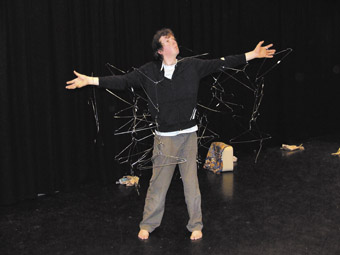
Weave Movement Theatre, Capsule
CAPSULE ENGAGES THE NOTION OF FLIGHT AT MANY LEVELS—FROM ITS MOST LITERAL INCARNATION OF AEROPLANE TRAVEL, TO THE ANALOGUE OF THE JOURNEY, THROUGH TO THE MYTHICAL FIGURE OF ICARUS.
Each of these incarnations signifies a certain vulnerability related to Icarus’ meltdown. The variety of dancers who make up the mixed ability Weave Movement Theatre embody our mortality by opening up our sense of who we might be. If dancing bodies tend to reinforce norms of beauty and facility, Janice Florence’s choreography engages a wider palette of human capacity. The result is a greater variety in the timbre of movement. What is it to watch action which must discover itself in the doing, rather than presuppose control? Nietzsche argues that there is no doer behind the deed, simply the deed itself. Here, the deed casts light on our presumptions about the doer. Is this to fly too close to the sun? Not at all. The use of irony, humour and parody alongside the poetic made Capsule much bigger and more resilient than us all.
Weave Movement Theatre, Capsule, director Janice Florence, choreographic advisor Michelle Heaven, performers Trevor Dunn, Janice Florence, Tom Hope, Sarah Mainwaring, Kate Middleweek, Noelle Rees-Hatton, Anthony Riddell, Ariel Verona; Dancehouse, Melbourne, Sept 13-15
RealTime issue #82 Dec-Jan 2007 pg. 31
© Philipa Rothfield; for permission to reproduce apply to realtime@realtimearts.net
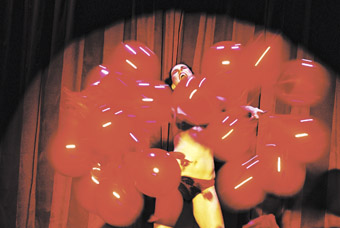
Moira Finucane, Burlesque Macabre, The Queen of Hearts,
photo Heidrun Löhr
Moira Finucane, Burlesque Macabre, The Queen of Hearts,
2007 DRAWS TO A CLOSE ON AN EXTRAORDINARILY BUSY YEAR OF INTERNATIONAL TOURING FOR AUSTRALIAN CONTEMPORARY PERFORMANCE. ASIDE FROM THE MAJOR COMPANIES RESOURCED TO TRAVEL (BANGARRA DANCE THEATRE, SYDNEY DANCE COMPANY ETC) SMALLER ORGANISATIONS AND INDIVIDUALS HAVE BEEN FINDING SUCCESS OVERSEAS. BACK TO BACK THEATRE, BRANCH NEBULA, ADT, URBAN THEATRE PROJECTS, DANCE NORTH, CHUNKY MOVE, LUCY GUERIN INC, CIRCA, ACROBAT, ROSIE DENNIS, CLARE DYSON, MOIRA FINUCANE, MEOW MEOW, MEN OF STEEL, TOM TOM CLUB…THE LIST GOES ON. WHAT IS BEHIND THIS UPSWING IN ACTIVITY? IS IT FASHION, CHANCE OR THE RESULT OF A SLOW ACCUMULATION OF SHEER HARD WORK? WHAT ARE THE MOTIVATIONS AND MACHINATIONS OF AUSTRALIAN ARTISTS ON THE INTERNATIONAL SCENE AND THOSE WHO SUPPORT THEM?
I talked to the few producers promoting Australian performing artists internationally and, as you’ll read in the next edition of RealTime, to the companies themselves. Wendy Blacklock at Performing Lines has been in the business for over 25 years, first taking an Australian Indigenous theatre company overseas in 1982. Marguerite Pepper has a similar history and both refer to Justin McDonnell, now in the US, as another pioneer of their generation. Certain funders have been around long enough to follow the work of these producers and their artists, including Amanda Browne, who has over a decade of experience as manager of the International program of Arts Victoria.
motivation
All these individuals agree on why artists choose to tour. There is the fundamental drive to keep working, to fill the calendar and preserve livelihoods. There is the sense of relevance and connection to a world of diverse cultural contexts. There is the chance to meet other artists and absorb new ideas. There is, sometimes, a financial benefit to be gained. With luck, new presenters with touring connections see your work. Occasionally there are even commissions and collaborations. Always there is the increased cachet and resultant opportunities at home that follow success overseas.
Nobody can be sure whether the increase in touring of 2007 is an all-time high. There is no consolidated data, yet producers and funding bodies confirm that activity has been building over the last decade and looks set to continue. All recognise that success breeds success. A large part of international touring is confidence. Any sense of disenfranchisement, because of Australia’s great distance from other markets, is quickly dispelled by a sell-out season at a major arts festival. The producers elaborated how much of their role is about coaching and encouraging artists, as much as it is about tour booking and negotiations.
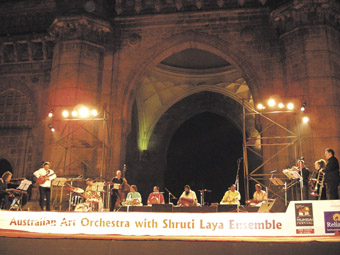
Australian Art Orchestra Sruthi Laya Ensemble, Into the Fire, Gateway of India Mumbai
global engagement, global issues
All agreed that Australian contemporary performance is currently expressing an unprecedented self-confidence, particularly in Indigenous and cross-cultural idioms. Mature performers such as didjeridu player Mark Atkins are leading new generations of artists into rich cultural dialogue. Amongst cross-cultural productions touring in 2007, Marrugeku’s Burning Daylight featured in Zurich’s Theaterspektakel festival and Urban Theatre Project’s Back Home travelled to Toronto’s Harbourfront Centre. And the rest of the world is particularly interested in this distinctive Australian discourse. Marguerite Pepper noted that the Pacific Rim focus of the 2007 Australian International Music Market in Brisbane was extraordinarly well received, by Europeans in particular. She cites the young Brisbane-based didjeridu player, Tjupurru, as a runaway success. Pepper talks of a coming of age of the sector but also of a more enlightened support structure which allows for risks to be taken with less proven artists or projects of scale, unconventional settings and more complex contexts.
Contributing to a global discourse is a sign of Australia’s cultural maturity. Benefiting from a cyclical change of taste and fashion is a less predictable but equally energetic connection. Australian dance, physical theatre and circus is the choice of European presenters jaded by their own artists’ current predilection for conceptual anti-theatre. Just as Meryl Tankard’s ADT, Legs on the Wall, Stalker and Circus Oz were feted in the early 90s, Splinter Group, Circa and Garry Stewart’s ADT now break into markets where virtuosity is thin on the ground. The hybridity of Australian work and its ease in cutting across forms, media and ethnicity has been praised by presenters such as Maria Magdalena Schwaegermann who favoured Australian work in her Theaterspektakel festivals in Zurich.
support mechanisms
While fashions have always come and gone, the difference now is that Australian artists are resourced to take advantage of them and are aware of and involved in the international arts market in ways impossible to imagine a mere decade ago. Web-based communication is making promotion easier as are cheaper travel costs. Blacklock spoke vividly about her trials raising a seemingly impossibly $100K to tour to Expo86 in Vancouver. In those days there were no specific programs to which companies could apply for travel support and this alone created an enormous hurdle. Now, as all agree, the range of sources of support encourages companies to invest in international presentation as a viable aspect of their business.
Producers and funders alike found it difficult to say if funding programs drive activity or vice versa. There was unanimity that Australian artists are professionalising apace and that many have formed coherent strategies for international activities. While some have done this in response to specific new funds designated for business development, such as Victoria’s SCOOP program, or the Australia Council Theatre Board’s International Market Development Strategy for Theatre for Young People, others have siphoned core funding into international activity as the most sustainable aspect of their business. Circa and Strut & Fret Production House (both companies are Brisbane-based) are examples of this entrepreneurial approach. Acrobat, who invested heavily in their career ever since their early borrowed bus and starvation tours, did it the hard way but are finally making a reasonable living not least in the UK and Europe where they are enormously popular.
the big picture
Sandra Bender, the new Director of Market Development at The Australia Council, is a Canadian who comes to the current situation with a perceptive take upon the successes and limitations of previous programs designed to promote Australian contemporary culture internationally. She recognises the intention of programs such as Undergrowth in the UK and the multi-year investment in Berlin as serious attempts by the Council to engage in reciprocity and exchange. She also realises however that such high profile, focused activity can be supplemented by subtler, smaller projects with longer lifespans. The Australia Council’s investment in arts markets is likely to diminish, and whilst the producers cited APAM, CINARS and APAP as the source of many of their most productive international relationships, they all agreed that nothing much materialised from the conversations engaged in there for years, and sometimes not at all. Bender plans to resource companies to tailor-make their international networking and relationships more strategic, aiming for future collaborations, co-productions and commissions. This approach has borne fruit for Arts Victoria, which has offered specific programs for international activity since 1995. Encouraging Victorian companies to make their own explorations, while still taking advantage of national initiatives such as The Barbican’s Ozmosis project or the Pittsburg Cultural Trust’s Australia Festival in 2007 makes the best of both worlds.
As the sources of support for touring proliferate the volume of activity naturally increases. The federal government’s recent announcement of the Australia on the World Stage program, to be implemented by AICC (the Australia International Cultural Council, a consultative group chaired by the Minister for Foreign Affairs and composed of leaders from government, the arts and business) is a promising new source of support, the details of which are not yet available. While this program will continue the focus upon key markets shared by the Department of Foreign Affiars and Trade (DFAT) and the Australia Council, the producers all noted that new markets are opening up to Australian artists. As the populations of Asian countries such as South Korea and China become more prosperous and more attuned to their role as global citizens, the doors to their cultural institutions are opening. Through proximity, something of a track record (at least compared with European artists) and the out-and-out encouragement by funders, Australian artists are making headway in Japan, Korea, Singapore and China. Artists in Western Australia recognise that performances in Asia are often less expensive to organise than a national tour.
pleasures & pitfalls
While there is a unanimous and hearty engagement with international touring among artists, producers and funders, it’s clear that there is an equal distribution of pleasures and pitfalls along the path to international success. Tales of lost freight, visa shenanigans, critics without context and language issues are balanced with accounts of budgets surpassed, standing ovations, return invitations and five star reviews. Most companies and artists report a fine balance between the cost and gain of their international activity and iterate the comments of funders and producers, confirming a lively interest and investment in this area and optimistic, if cautious views of the international future for Australian contemporary performing arts. In RealTime 83 I’ll report on how individual artists and companies view the value of their international touring.
RealTime issue #82 Dec-Jan 2007 pg. 32
© Sophie Travers; for permission to reproduce apply to realtime@realtimearts.net
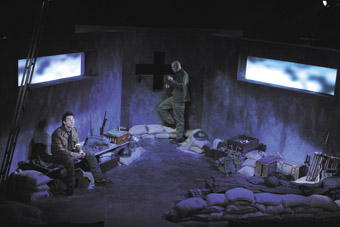
Joseph Del Re, Brendan Rock, Dogfall
photo Nic Mollison
Joseph Del Re, Brendan Rock, Dogfall
THE ‘THEATRE OF WAR’ IS A CURIOUS PHRASE WITH AN IRONIC RING. IT CONJURES AN IMAGE OF GENERALS, COMFORTABLY AT WAR, GATHERED AROUND A MAP ON A TABLE IN THE OFFICERS’ TENT, ARRAYING THEIR FORCES, THEIR PAWNS, IN WHAT SEEMS AN IMAGINARY GAME, A REPRESENTATIONAL FRAME, DIVORCED FROM THE ACTUALITY OF THOSE FIGHTING THE WAR.
That great 19th century theatrical shift—from actor-manager on the stage to theatre director in the auditorium—had an antecedent in military practice. By the time Carl von Clauswitz coined the phrase in his book On War (1832), the generals had long ceased leading armies into battle. Like the leading men of the theatre, they had retreated from the main action on stage. Modern war, like modern theatre, was to be directed from a distance.
These days wars fill our screens with their spectacle. Their ‘shock and awe’ imitates the animated splatter of computer games while, in the intimacy of our theatre, playwrights, actors and directors conduct laboratory experiments in the trauma psychology of men at war. Caleb Lewis’s Dogfall is a well-pedigreed play, declared ‘wonderful’ by American playwright Edward Albee, with whom the Australian Lewis undertook a two-week workshop on another of his plays. The wonder, I think, is Lewis’s imaginative insight into war and what can make us care.
The scenario is a war-time convention. Will (Brendan Rock) and Jack (Joseph Del Re) are soldiers, mates in the adversity of war. Life in the trenches means living it rough and doing it tough, while the battle rages and rumbles like thunder off-stage. They are disturbed by a third. A boy soldier, Alousha (Martin Hissey), becomes the unwitting target for their rough love, their piss-anguished fear, their gut-empty catharsis.
Director Justin McGuinness commands the energies of emotional realism from the actors. They sweat with fear and eat tinned food for real. They smoke on stage and drink and swear like troopers. They piss and shit copiously off stage to dysenteric sound effect. With the synaesthesia of intimate theatre, the production’s signifiers mingle in my nostrils: whatever the conflict, war stinks.
Lewis arrays the wars of past and present like tin cans in a rough-shot shooting gallery. While the characters conform to the continuities of drama, the theatre of their war changes with each scene—the Somme, Edessa, Guernica, Nanking, Northern Ireland, London, Treblinka, Stalingrad, Japan, Korea, Vietnam, Phnom Penh, Israel, Mogadishu, Kuwait, Home (as comic interlude), Bosnia, Rwanda, New York, Guantanamo Bay—till we end up bogged down in mud, mired in oil and blood with the dying and the dead.
Yet sitting in the audience, it’s for neither Will, Jack nor Alousha that I care. Their suffering is tarnished by the complicity of their guilt. In this theatre of war, there are no conscientious objectors, no women and children to be spared. I am desensitised to all but dogs, that fall mysteriously from the sky on the screens behind. I see an Alsatian falling, a Saint Bernard, a Dalmation. A spotty mongrel falls. I yelp in pain. “It’s just meat”, says Will. But not to me. I care.
TheimaGen, Dogfall, writer Caleb Lewis, director Justin McGuinness, performers Brendan Rock, Joseph Del Re, Martin Hissey, design TheimaGen, Tsubi Du, sound Peter Nielsen, lighting Nic Mollison; Bakehouse Theatre, Adelaide, Nov 2-17
RealTime issue #82 Dec-Jan 2007 pg. 33
© Jonathan Bollen; for permission to reproduce apply to realtime@realtimearts.net
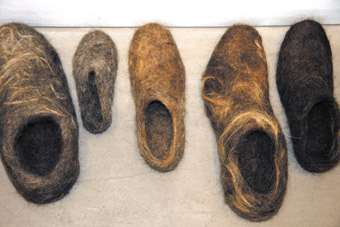
Roza Ilgen, In My Shoes
photo The Bellasis Bros
Roza Ilgen, In My Shoes
IN A RANGE OF EVENTS IN GALLERIES AND MUSEUMS AND CULTURAL CENTRES THROUGHOUT THE UK, 2007 IS BEING COMMEMORATED AS THE 200 YEAR ANNIVERSARY OF THE ABOLITION OF THE SLAVE TRADE. IN BRISTOL, ARNOLFINI’S RESPONSE TO THE ANNIVERSARY IS DISCURSIVE, RATHER THAN DIRECT, AN EXAMINATION OF THE WEST’S IMPLICATION IN PAST AND CONTEMPORARY PATTERNS OF GLOBAL EXPLOITATION. THE RESULT, PORT CITY, IS A MAJOR CROSS-ARTFORM PROJECT EXPLORING ISSUES OF MIGRATION, TRADE AND CONTEMPORARY SLAVERY, CONCERNED WITH THE SIGNIFICANCE OF THE PORT “AS GATEWAY TO A WIDER WORLD…A SYMBOLIC SITE OF CULTURAL EXCHANGE.”
During the Port City Live Art Weekender at Arnolfini, I felt I was truly being engaged as a global citizen, by other global citizens, the artists: an unruly bunch of compromised, ambivalent, intercultural border-crossers. Much of the work was about being in one place with roots in another; translating/making analogies between one situation and another.
brennan, speakman
Both Tim Brennan and Duncan Speakman invoked a sense of moving through the English landscape, crossing long lines of traffic or transport or time, connecting urban to rural, historical to immediate. Brennan, in Performing Northumbria: Empire, mediated his story through deliberately informal, low technology journal keeping and conversation, reading aloud from William Hutton’s early 19th century account of walking Hadrian’s Wall. Assisted by rather gauchely literal props—an actor dressed as a Roman legionary, a large stuffed eagle, a child’s umbrella with mouse ears—he had audience members volunteering for various story-assisting duties, including several people reading extracts from Hutton’s journal in a chorus of overlapping voices.
Speakman, using high-tech recording and mixing in For Every Step You Take, I Take A Thousand, constructed a sound picture of a four-day walk taken through countryside fields into Bristol. Recordings made during that journey—Eastern European farm workers, drinkers in a pub, birds in hedges, an aeroplane passing, traffic—could be listened to either through the studio speakers or, more intensely, through headphones. Speakman mixed and processed the sound live for the audience in a tightly-controlled, evocative work.
curious
In (Be)longing, Curious made play for us with their culturally-determined, authentically inauthentic selves—middle-class English intelligentsia and dislocated Texan—in a delicate, funny piece about longing and identity. Under a glowing neon road sign they addressed the audience, wryly performing failure to be a shit-hot guitarist, or failure to evolve into a higher being through yoga; gently demonstrated the ordinariness of disappointed aspirations. Also showing was a short video piece bu curious in which a group of young women, teenage asylum seekers, were asked about their wishes, hopes and fears. All are likely to be deported once they reach the age of 18, fracturing any sort of continuity in their lives and educations. The link between video and performance was tenuous, but there was an attempt to find common ground between very different women’s lives, and to use the empathy thus poetically engendered as the basis of political awareness.
patel and bradley
In Morris Dancing, a piece about cultural exchange and mirroring, Hetain Patel and Alex Bradley posed adjacent to each other. The skin of each was decorated with henna in patterns derived from William Morris wallpaper, a deliberately hybridised system of signs highlighting a specific moment in their two countries’ long history together, echoing down from the British Raj into the present. Spotlit but separate in a dark space edged by the boundary marking of a strip of wallpaper, each fell into their own rhythm and style of display, relaxation and camouflage, sometimes resting, sometimes seated, sometimes laid against the wallpaper as if to match the pattern on it.
jiva pathipan
Jiva Parthipan’s Necessary Journey related the snafu details of an attempted trip to take up an artist’s residency. Seated at a desk, Parthipan (an Asian artist of Sri Lankan heritage) read out official letters he had received from embassies, from the Home Office, from the Arts Council, accumulating the narrative of a completely thwarted journey to Mexico and the US. He would periodically interrupt himself to step to one side of the desk, take some of his clothes off and transform, through mannerisms, into first a dog, then a monkey, and finally, nakedly, into plain humanity, explicitly glossed in the program notes as ‘godhead’, the divine.
That evening, from the same artist, we had a treat in the shape of cabaret from the Al-Quaeda State Ballet, supported by free rum for the audience. It would have been alarming if it hadn’t been so impish—there was jumping and gyrating and a sort of Ninja can-can—clothes came off at some stage—there were black tights involved but those could have been on his head…
harminder singh judge
A godlike man, his bearded face and head painted blue, delivered his urgent, incomprehensible Live Sermon to us, the audience in the dark, from a speaker placed in his mouth. Dressed in a heavy silk skirt, Harminder Singh Judge (whose work is rooted in Hindu and Sikh religion) stood in a wide shallow dish of luminous-looking milk—an effigy, a mouthpiece, a resonating instrument, an avatar. Afterwards an almost invisible trace of his presence was left in the milk, a cloudy blue shadow, an indecipherable portent, a stain from the hem of his skirt.
qasim riza shaheen
In the Light Studio for Qasim Riza Shaheen’s Queer Courtesan, I’m instructed to select one of a bunch of old vinyl 45s scattered by a portable record player, one of those 60’s affairs that folds up into a little briefcase. I discard an old pop song and a couple of discs with Urdu titles in Roman script to choose a polka. There’s a booth to the side, fairground colours, a plastic strip curtain in the entrance. I’m ushered inside. I sit down.
I can see a shadowed human figure behind a transparent sheet of plexiglass just in front of me. The light changes and I’m in the dark, the figure spotlit. Dressed in a heavily embroidered silk sari, fanfared by the music, a gaunt, graceful, heavily made up man with a martyred, ecstatic expression begins to primp and preen and touch himself up. It’s suggestive, but tasteful.
I’m just relaxing into it when the light goes off, the music stops, that’s it, that’s my lot. No more technicolor, no more polka, no more tease. It was so well-timed for maximum frustration, I was sure he’d been looking at me (the program notes explain he only sees his own reflection). If I’d been a punter I’d be angrily banging on the glass—but I’d also pay up for another five minutes. Seduction, I guess, has to be about something you can’t get: a satisfied client has no further reason to pay. However I remain unenlightened about the relationship, mentioned in the program notes, between dance and prostitution.
Queer Courtesan manifests too as a video installation in the Dark Gallery with six telly-sized video screens across a wall. In each the artist presents a cameo of a different individual: he impersonates, or represents, one of the Khusra, transgendered sex workers of Lahore he worked with over a period of two years. He wears that person’s clothes (elegant female clothing) against a backdrop of their habitat—their room, or their street corner. One of the rooms is white and shiny, full of electrical equipment and speakers. Another screen shows a couch on the street beside a smoking fire and a tyre swinging from a rope. On another screen the artist sits in an armchair; on another he dances. His costumes are ornate and appear expensive. Looking straight at the camera he strikes attitudes, displays cleavage, plays with a scarf, tears his hair.
A studied invocation of The Virtuous Woman haunts each of these drag acts, trailing implications of forbearance and tenderness and of sacrifices made on the altar of love; meanwhile the tease is tremendously aggressive. It lures you in, so to speak, only to slam the door in your face. One of the cameos actually does this: the artist comes closer and closer to the camera until his face fills the frame; he seems to be just on the verge of being available and, then, bang! The door of the booth slams shut, with you, the client, on the outside, in darkness.
Shaheen impersonates Khusra for the gallery in a way that could not be done without their justified cooperation and trust. The artist places himself as a conduit between the community and the outside world: he does it with beauty and one hell of an attitude. Histrionic and very alluring, at the heart of the work one can discern contempt for the client combined with a yearning for love (maybe clients are to be punished for not being that mythical creature, ‘a real man’). The performances ooze with a defiant sense of entitlement which is linked to the visual portrayal of an ideal of exquisite suffering; and the viewer is uncomfortably cast in the role of john, with all the complicity and self-deception that entails.
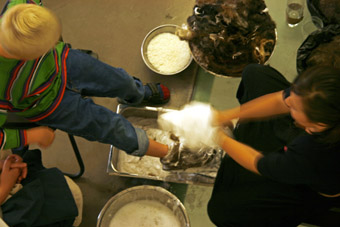
Roza Ilgen, In My Shoes
photo The Bellasis Bros
Roza Ilgen, In My Shoes
roza ilgen
The foyer at Arnolfini is open all the way up the stairwell to the top floor, all clean white angles around the brushed steel lift-column. A young woman sets up camp here. The niche she creates is untidy, like a market stall. She sits on a low stool, with a dish of viscous white liquid to her left. Two chairs face her, and on her right are big metal basins heaped with dark fuzzy patties of what looks like felt. It’s a terribly organic colonisation of that clean white space.
She’s an attractive, personable presence, facing onlookers with friendly engagement. She could be…Southern European? Latina? South Asian? Her dress contains a nod towards the Orient in that she’s wearing calf-length black jersey shalwar; these look, however, as if they could have come from Gap. In other words, this woman in her untidy territory looks completely cosmopolitan.
On enquiring what she’s doing, you could find yourself seated in front of her with one foot on a low stool placed in a basin of soapy water, while she smears suds over a disc of human hair placed round your foot to make a felt slipper. Similar slippers line the walls of the foyer, all sizes from toddler to galumphing size 12, and in all colours. Of hair, that is, which means in fact brindled. It seems the colour of human hair in Europe, while not absolutely mousy, averages out to brown. When I speculated that in a different country this base colour would be different my assumptions about Scandinavians were quickly corrected! Bin bags full of hair had been collected from 20 different hairdressers in the city and the artist had prepared a supply of felted discs ready for the installation.
Looking at the circles of hair packed into the bowls, you begin to conjure up presences. That person, a rarity, has black hair, and had a complete change of style judging from the quantity cut off; that must be a child with fine blond curls; that person just had a trim; that one is going grey, and oh vivid, there’s a redhead! The spectre of these invisible donors is urgent, and you’d imagine that having your foot swaddled in their off-cuts would be intrusively intimate, but it isn’t. It’s workaday, mundane, like getting a manicure or being measured for a bra. Distancing kicks in, and the process feels like just another variant of the service industry.
Roza Ilgen wrapped my foot in cling film, shaped a circle of human felt around my heel with warm soapy water, moulding more patches onto it to make up a slip-on bootie. She really got into it, kneading and squeezing gently, pouring on more soapy water, covering the toes, building up the throat. When she was satisfied she tackled it with a hair dryer, felting the material more. Then she eased the boot off. It was still damp but held it’s shape, looking sturdy and, already, well-used.
As a black woman I bring such a heavy set of interpretations to the symbolism of hair, I was in danger of missing what was happening here. I wondered about the rows of empty shoes bounding the space, facing the wall, the possible ethnic presences or absences indicated by hair type and colour. I missed the analogy with shoes removed at the door of the mosque—in this case facing a blank wall rather than pointing towards a place of worship.
I nearly missed this beautiful, pragmatic, deeply subversive gesture for what it was: a stubborn exercise in de-mystification and defiance. Ilgren performs a personal service for an audience, engaging them, drawing them in. Meaning streams from her presence in the middle of the activity: she is a Kurdish artist, one of the people without a country, just for now treating the gallery like a cottage industry squat. She takes a material attribute of humans that is, within Islam, culturally loaded and prescribed in a specifically gendered way: with this she makes public, workmanlike, hardy artefacts. Artefacts that are meant to be trodden on. Artefacts that somehow infect the conceptually clean gallery space with some of their own physical fuzziness.
Port City Live Art Weekender, Arnoflini, Bristol, UK, Sept 28-30
RealTime issue #82 Dec-Jan 2007 pg. 34
© Osunwunmi ; for permission to reproduce apply to realtime@realtimearts.net
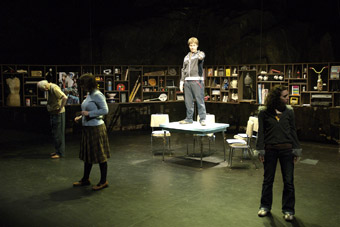
l-r – Ron Haddrick, Sara Cooper, Jonathan auf der Heide, Jemma Gates, Beyond the Neck
photo Tony McKendrick
l-r – Ron Haddrick, Sara Cooper, Jonathan auf der Heide, Jemma Gates, Beyond the Neck
TOM HOLLOWAY WAS 17 YEARS OLD AND WORKING IN A PIZZA SHOP IN HOBART WHEN THE TRAGEDY AT PORT ARTHUR UNFOLDED IN 1996. HIS PLAY, BEYOND THE NECK, A STORY PERFORMED 10 YEARS LATER, IS HIS POWERFUL RESPONSE TO THE EVENTS OF THAT DAY.
An arc of shelving containing family memorabilia wraps around the performance space. Isolated in compartments these artifacts include a transistor, phone radio, wireless, pair of binoculars, traffic cone, model ship, horseshoe, red safety helmet, photo developer, dartboard, pair of red shoes and a model of a colourful Montgolfier balloon. Most of these embody a nostalgia for childhood and the shared times of family life. Because we are alert to the symbolic significance of many of the items, this miscellany of memory also evokes a sense of menace and foreboding.
Four strangers are seated at a table. They introduce themselves as a boy (Jonathan auf de Heide), teenage girl (Jemma Gates), young mother (Sara Cooper) and a tour guide (Ron Haddrick). They offer fragments of their story interspersed with interruption and disjuncture. Each character strategically draws on the device of a closing imperative such as “No!”, “Stop!” and “What!” These intercessions deflect a specific or difficult strand of thought that threatens to summon terror, blame or dread.
It’s Sunday. Making their separate journeys by car or coach are the boy, the teenage girl and the young mother. Inevitably someone is whingeing. The teenage girl is cramped in the back of a car with her knees jammed under her chin. She resents her mother’s intimacy with the driver, her father’s best friend. The boy is hyper-excited because his friend Michael is traveling with him—or is he? The young mother is part of a mystery bus tour with a blue-rinse mob. She turns toward the rear of the bus to ensure that her husband David and daughter Molly are present—or are they?
It is this indeterminacy of past, present and future that contributes to an inexorable build of tension. Our knowing and imaginings are already filling in the spaces. Through an interweaving of narrative and back-story, our apprehensions hover about the temporal uncertainty and the indeterminate fate of these Sunday travellers.
The Neck is a narrow strip of land a few hundred metres wide, 83 kilometres from Hobart. To cross The Neck is to be inexorably drawn to the former penal settlement of Port Arthur. This prison was modelled on Jeremy Bentham’s Panopticon which functioned as a round-the-clock surveillance machine where each prisoner was left alone in the dark without sound or name, inevitably raving into madness. We are similarly seated in the darkness of the auditorium while observing each character’s terror, grief and compassion unfold.
Waiting at Tassie’s top tourist attraction to meet his next tour group and unleash his “old fart’s bad jokes” is the tour guide (Ron Haddrick). When he welcomes us to the Visitors’ Centre our indeterminate journey begins. The impact of that day on each of the characters is gradually revealed. Again we are reminded of the cruelty of sudden absence: the boy hears his friend Michael urging him to act, the teenage girl grieves the loss of her father, the young mother recalls her terror when she is locked in the darkness of a solitary cell. Ten years later the tour guide is still fending off intrusive questions and angrily refers to the “bullshit” of ‘closure.’ “Were you there?”, the teenage girl asks the tour guide and an autumn chill slaps our necks.
Beyond the Neck was one of five plays out of 400 entries to be chosen for presentation as part of the Royal Court Theatre’s International Young Playwrights’ Festival in London. Holloway structures his play so that through fragments and overlays of story, through the fluctuation of presence and absence, four strangers find connection, solace and possible redemption.
The events at Port Arthur reverberated around the world. To echo the words carved in stone at the memorial site: “…cherish life for the sake of those who died. Cherish compassion for those who gave aid. Cherish peace for the sake of those in pain.” Holloway’s tautly crafted work offers a theatre of renewal for and of our time.
Beyond the Neck, writer Tom Holloway, director Iain Sinclair, performers Jonathon auf der Heide, Sara Cooper, Jemma Gates, Ron Haddrick, design Jamie Clennett, lighting design Daniel Zika, composer, sound designer Steve Toulmin, An Argy Bargy Production presented by Tasmania Performs; Peacock Theatre, Hobart, Sept 12-15
RealTime issue #82 Dec-Jan 2007 pg. 35
© Sue Moss; for permission to reproduce apply to realtime@realtimearts.net
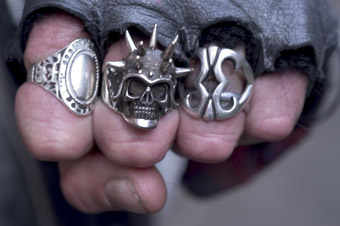
Hotel Obsino
I MUST CONFESS TO HAVING SPENT A SOLITARY NIGHT IN THE SIR CHARLES HOTHAM HOTEL, SPENCER STREET MELBOURNE. AS THE INSPIRATION BEHIND ADAM BROINOWSKI’S PLAY HOTEL OBSINO, I ALMOST FEEL AT HOME AMONG THE STICK BOOKS AND SYRINGES LURKING WITHIN THE FLOTSAM ON LA MAMA’S FLOOR. IN A BOOTH BENEATH THE STAIRCASE SITS A SO DESCRIBED CURRY-MUNCHING CARETAKER. CORNERED BY BOUTS OF CROSSWORD CONTRIVED WISDOM, BUDDHIST RHETORIC, OUTBREAKS OF RESIDENTIAL MADNESS AND INCOMING INDUCTEES, HE IS BOTH MANAGER AND MADMAN. ENTER NOAH, ON THE RUN FROM EVERYONE, INCLUDING HIMSELF.
Searching for solace in this ark of decay, Noah is the ballast Hotel Obsino requires. Well, somebody’s gotta ‘keep it real’ amidst death, drugs, life sentences in rooms that resemble Sadean dungeons, madness, despair and the Devil’s delight circulating within a purgatorial twilight…In doing so, Noah discovers that he also is an accomplice of the criminally insane.
A parade of dying souls descends the staircase, beginning with a young woman wearing a negligee and carrying a bucket. Miss Jones squats and piddles, then pats her pubis with a sheet of toilet paper. Singing “It’s a fine line between pleasure and pain”, she exits stage left. Obsino is a man’s world, and I cannot help but wonder what the women in the audience are feeling… Excluded perhaps, like the Aboriginal, Noodles, who after unleashing a moment of squawking madness, is only ever seen wandering alone through corridors, sitting invisible, listening to whitefella attempts at camaraderie, or crossing off the days in chalk on a wall in what might be his room, but could also be a memory of incarceration at Grafton Prison. Bigotry never takes a holiday, and nor do the relentless days and nights filtering through cracks in walls from an outside world that is only ever referred to in paranoid terms. A tourist with a typewriter, Noah will eventually jump this Ship of Fools. As for the other residents, they’re down here for the the term of their natural lives.
Dave has a swastika tattooed on his neck and may have been baton raped while doing three with a five. Fabio dreams of having sex while his cock is wrapped in a nail studded towel. Gold is a jive talkin’ junkie hybrid of the Wogboy and the Universal Soldier. Felix and Doug are curious creatures. The former is a sentimental European who recreates his mother in his room; the latter, a religious nut primed with a fear of the Devil that is explosive when unleashed upon Noah. As confidante, Noah commiserates, and is complicit in the anti-life of each fruitloop. But all are united by survival on the edge of a metropolis that itself may be a manifestation of insanity. Common to all these characters is a fear of religious damnation. In this sense, Hotel Obsino is an examination of people trapped in purgatory. Driven mad by an inability to relinquish a belief in the Divine, each slowly self-immolates.
Having myself spent seven years living in a notorious St. Kilda dive, I can vouch for the authenticity of Hotel Obsino’s characters.
Hotel Obsino, writer, director Adam Broinowski, performers Le Roy Parsons, Eric Mitsak, Tahir Cambis, Tom Davies, Brendan Bacon, Melanie Douglas, Craig Hedger, Dylan Lloyd, Polish Larsen, Greg Ulfan; La Mama, Melbourne, Sept 12-30
RealTime issue #82 Dec-Jan 2007 pg. 35
© Tony Reck; for permission to reproduce apply to realtime@realtimearts.net
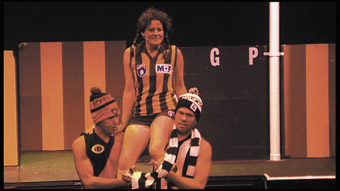
Raymond Wright, Tanya Langdon, Donald Mallard, Barracking
photo David Nixon
Raymond Wright, Tanya Langdon, Donald Mallard, Barracking
AWARENESS OF THE HUGE CULTURAL SIGNIFICANCE OF AUSTRALIAN RULES FOOTBALL FOR INDIGENOUS PEOPLES IN THE NORTHERN TERRITORY HAS ONLY RECENTLY BEGUN TO DAWN ON WHITE URBAN AUSTRALIANS. THIS HAS BEEN DESPITE THE FAME OF INDIVIDUAL ABORIGINAL PLAYERS FROM THE REGION WHO HAVE SUBSTANTIALLY LIFTED THE GAME OF LEAGUE TEAMS IN THE SOUTH. IN THE WAKE OF THEIR SUCCESS WITH MICHAEL WATTS’ NOT LIKE BECKETT (RT81, P32), ALICE SPRINGS’ RED DUST THEATRE HAS NURTURED ANOTHER FASCINATING PLAY, THIS TIME ABOUT FOOTBALL, AND TOURED IT THROUGH THE TERRITORY.
Katherine-based writer Toni Tapp Coutts, who saw the play in her home town, describes its tone as “although heart-wrenchingly honest, essentially comic.” She writes,”Barracking does not take the easy road. You squirm in your seat as Cuz tells the ambitious young footballer Brownie in no uncertain terms what it can be like to be a blackfella in the city. Coutts thinks that “the focus on the shared faith of football, almost a religion for many Australians, allows the play to confront issues of racism, love, family pressure, community demands and the internal struggle of a young man who wants to be a great footballer in the city, playing for his beloved Hawks, but doesn’t want to let down his home team, family and friends.”
Written by Jane Leonard (a long-time writer who moved to Alice Springs nine years ago) and Steve Gumerungi Hodder (a Mornington Island man who has lived much of his life in the Alice as an actor and broadcaster), Barracking is, on the page, a brisk and engaging account of a developing romance between Brownie and a Melbourne writer, Goldie, who has moved to Alice Springs after the death of her father. A series of brief encounters where Goldie is sometimes the only white person at a community match bring the two closer together, a shared passion for the Melbourne-based team Hawthorn providing common ground. Brownie has the talent to play for the Hawks and yearns for the accompanying luxuries in contrast to the poverty and despair that surround him. His cousin, Cuz, has lived the life of the footballer in the city, a venture undone by white racism and his own stubborness. Brownie is undeterred, he already knows racism. However, when the ‘draft’, the search by white coaches for black talent, ensues and Brownie is told by his coach to give up his community team coaching, his love for Goldie and a vision of a Northern Territory team taking on the south creates a new future for him and his community.
Threaded through this tale are scenes, often comic, of Goldie’s evolution as football fan (and writer, as she mimics sports broadcasters) from childhood to adolescence and university, in each period having to restrain her passion for the Hawks in the interest of not upsetting male domination of footy fandom. The exception is her beloved father with whose ghost she affectingly chats to in a cemetery before taking off for Alice Springs, saddened by her loss and deploring the corporatisation of the AFL. In the Alice she finds both love and a community-based football that reminds her of better times.
Barracking is often overtly didactic (Goldie’s Armenian heritage, for example, is a loaded late addition to the story) and in the end it’s wilfully and jovially sentimental, largely because there is no scene where we witness the emergence of Brownie’s vision and the struggle to realise it—we find out about it after the event. Similarly, although the developing relationship between the lovers is nicely handled, the challenges to it becoming a marriage are sidestepped (even though Brownie is elsewhere as frank about Aboriginal racism as white) and the birth of their first child simply announced. Although there are clues to Brownie’s background in his chats with Cuz, there’s not the same attention paid to his growing up as there is to Goldie’s—how did he become a footballer, what of his relationship with his relatives, how is it he’s escaped the pull of alcohol and other traps?
The great strength of Barracking, however, is in its language—the footy coach with his mouthfuls of mixed metaphors, the droll humour that seems an inherent part of the riches of Aboriginal English, and the playwrights’ often deft handling of dialogue. There are ample engaging cultural details, for example in an exchange on playing aids: “Cuz: He was cheating anyway. Them Nungkara rub that ndura on his legs. Brownie: Can’t be. May as well be on steroids, dirty camp dog! So where you get that stuff?” Later, Goldie comments that a player “leaps like one of these big red roos.” Brownie explains: “You know why? He been sung. Them old men sing all night for him, then they call for that wallaby, eagle, kangaroo, anything. Transform him. He’s that kangaroo now.”
Issues of race and culture are woven through the narrative: “Cuz: How any white blokes know your skin, your totem? They don’t know our language, our country. They don’t know ‘cause they got none either.” Brownie is shocked when his white team mates treat him as one of them while using racist language: “like I wasn’t there…it was like them pretty boys didn’t even think I’m black.” And Cuz speculates on cultural difference: “Why you think they don’t have a Territory team in the league? We got enough talent here for a half decent team…Money, that’s why, footy all shop now. Them management take care of business, not spirit. That’s why us blackfellas all over the shop. White man worry ‘bout money first, then spirit after.”
In performance, says Tapp Coutts, “Brownie and Goldie are surrounded by an assortment of characters capably played by just two actors: the bitchy girls on the netball team in Goldie’s teenage years, a university professor, a beatnik boyfriend, the disillusioned Indigenous player who has returned to the Territory, the ghost of Goldie’s father and even an AFL ‘Bishop.’ Raymond Wright, who plays Brownie and has enormous promise, was sighted by director Craig Mathewson at a shopping centre only five weeks before the tour.”
Tapp Coutts reports that “Barracking toured remote regional Northern Territory during August, playing to small crowds of devoted theatre-goers in the Ti Tree Indigenous Community, the Ali Curung Indigenous Community, Tennant Creek, Katherine, Timber Creek and at the Darwin Festival and the Alice Desert Festival. It was a miracle that the performance went ahead in the small town of Timber Creek, 300km west of Katherine, as the road crew vehicle and trailer—with all the staging, sound and lighting—rolled over three times, the equipment strewn across the highway. In true Territorian style the actors proceeded to Timber Creek with a clothes rack and costumes and performed, without sound or theatre lighting against a sheet-covered whiteboard backdrop, to an enthralled 40-strong crowd. Aboriginal children squealed with joy, calling out their favourite footy teams.”
–
Barracking, writers Jane Leonard, Steve Gumerungi Hodder, director Craig Mathewson, performers Tanya Langdon, Raymond Wright, John Robb Laidlaw, Donald Mallard, costume designer Franca Barraclough, lighting Greg Thompson, sound design Steve Gumerungi Hodder, Craig Mathewson, producer Danielle Loy, Red Dust Theatre, Alice Springs; Aug 14-Sept 8
Written by Keith Gallasch with Toni Tapp Coutts, a Katherine-based short story writer who works in remote indigenous communities as Project Coordinator for Katherine Regional Arts.
RealTime issue #82 Dec-Jan 2007 pg. 36
© Toni Tapp Coutts & Keith Gallasch; for permission to reproduce apply to realtime@realtimearts.net
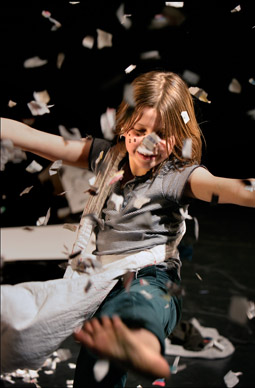
Martha Marthe Mathilde Matthieu, De Kopergietery
photo Phile Deprez
Martha Marthe Mathilde Matthieu, De Kopergietery
THE 11TH EXPLOSIVE! INTERNATIONAL YOUTH THEATRE FESTIVAL IS, ACCORDING TO THE PUBLICITY MATERIAL, ITS MOST POLITICAL PROGRAM TO DATE, THOUGH YOU WOULD NEVER GUESS IT FROM THE OPENING NIGHT’S SHOW, AMAZONIA, BY BRAZIL’S COMPANHIA APLAUSO. THE SHOW BEGINS WITH PERFORMERS TUMBLING ACROSS THE STAGE AND SCALING UP THE SILKS, ALL WHILE MAKING MONKEY NOISES. WELCOME TO THE JUNGLE. UNFORTUNATELY, THE POLITICS OF THIS PIECE ABOUT A RAINFOREST THAT HAS BEEN RAVAGED BY BOTH COLONIALISM AND NEO-COLONIALISM ARE COMPLETELY AT ODDS WITH THE POLITICS OF ITS PRESENTATION.
There were many uncomfortable moments but the image of a black man standing on stage in a leopard-print loincloth, beaming out at a largely Anglo-Saxon audience, and singing “Brasil!” stands out. Forget the jungle, welcome back to the 19th century, where bare brown bodies are displayed as exotica/erotica for your viewing pleasure. Skin, sex and some capoeira to boot—the Brazilians seemed to confirm every stereotype imaginable in a single performance.
I’m in Bremen, Germany, to perform with Sydney’s PACT Youth Theatre in The Speech Givers, a show which draws on the themes of previous PACT shows such as Toxic Dreams (RT73, p16) and Whistling Man (RT77, p44) but which was developed especially for this festival. After watching Amazonia we are beginning to wonder about what we are doing and why. What exactly is international about an international youth theatre festival? To what extent are companies expected to confirm or contest national stereotypes? And what would the audience make of an Australian show about a series of speech acts that only sometimes succeed?
Perhaps the highlight of the festival was Sehnsucht (Longing or Desire), directed and choreographed by Belgian Ives Thuwis and performed by the Forum Freies Theater from Dusseldorf. It begins with the director dancing, slowly at first and then with increasing rapidity until his breath becomes laboured and loud and he retreats to the side of the stage. In what follows, 11 performers aged between 10 and 20 proceed to evoke the barely contained chaos of a party without parents. To the strains of Dusty Springfield’s “Son of a Preacher Man”, Audrey Hepburn’s rendition of “Moon River”, and Sonny and Cher’s “I Got You Babe”, a young woman sips water through a straw from the crevices (ribs, clavicle, navel) of a young man’s torso. There is a tense pas de deux between two teenage boys, which proves too much for one of them so he heads across stage and tackles a teenage girl to the ground. She escapes his grasp and stalks off to the couch to sit in a silent sulk, trying but failing to avoid the early onset of post-party blues.
The younger children are oblivious to all this teenage angst, busy as they are playing ping pong, hiding under the table and sending out a string of paper boats across the floor. Once in a while the two groups interact—a young boy spies the sulky girl changing and decides to steal her dress. One tender moment has three of the older members of the group spooning their slightly younger counterparts. It is as if they are already dancing with younger selves, a reminder that you are never too young to experience nostalgia and that even at 16 you can still miss your 10-year-old self. More importantly, it reminds us that there is no such thing as a singular ‘youth’ and therefore no such thing as a singular ‘youth theatre.’ The piece comes to climax with an ecstatic version of Lesley Gore’s “You Don’t Own Me” before the director, who has been standing and watching the entire time, comes back on and dances again.
The songs are the soundtrack of the director’s youth not the performers’ but because the work is so accomplished we tend to forgive him the indulgent framing device. Besides, perhaps it’s a metaphor for working in youth theatre where one is forever standing ‘in the wings’, casting an adult eye over the chaos, trying to harness erratic energy while instilling a degree of discipline in those beautiful bodies that, ultimately, are not yours to inhabit or even to inhibit. Indeed, they always emphatically reply, “You Don’t Own Me.”
Thuwis also collaborated on a performance on the next night, Martha Marthe Mathilde Matthieu by De Kopergietery (Gent, Belgium). Each child of the title worked with a professional choreographer, resulting in four curious portraits. These might also have been called Bedroom Boredom because they are about what children do—or more accurately what adults think they might do—when left to their own devices. The first girl walks in wearing what looks like a red party dress but she soon throws it off in favour of some far more comfortable black pants and a loose blouse, freeing her to gallop around the room. She flings cushions about with abandon, turning them into a trampoline to bounce on, a sea to swim in, and skates to glide on. She is utterly absorbed and utterly absorbing but when an older girl comes in wearing her party outfit and carrying a birthday cake, the smaller one scampers off.
Alas, this new girl does little more than loll about on the floor like Lolita. While the piece itself is uninteresting, the juxtaposition with the previous portrait is arresting. What is it that happens to girls? How can someone be so full of agility and agency and then a few short years later be boring beyond belief, desiring nothing more than to be desired? The contrast between this learned feminine passivity and masculine activity becomes even more apparent when a teenage boy enters. He doesn’t have half her grace but he is far more intriguing. Loud music blares from his laptop and he lurches around the room, doing bad stunts and telling bad jokes but thinking sweet thoughts. Eventually he steadies himself while listening to the Counting Crows intoning, “I am ready, I am ready, I am ready, I am.”
The extensive use of popular music—entire songs played back to back—recurs throughout the festival though not always to the same effect. In fact, the songs in Schauspiel Essen’s show Homestories (ballads for the girls and hip hop for the boys) are interspersed with the personal stories of the performers, as well as some odd but occasionally compelling video footage they shot in and around their home town of Essen-Katernberg. Unlike Sehnsucht and Martha Marthe Mathilde Matthieu, Homestories is instantly recognisable as ‘youth theatre.’ The production was facilitated by Armenian director Nuran David Calis who lived in the city of Essen’s troubled social district of Katernberg for six months while collecting the stories of the young collaborators, many of whom are migrants. Homestories had been awarded the Sociale Stadt 2006 (Social City 2006) prize so perhaps the social coherence it promotes is more important than the artistic coherence it lacks.
What is obvious from these three performances, as well as from the production of Hamlet (co-produced by the festival’s German hosts, the Schlachthof theatre, with the Dutch company Growing Up in Public theatre and the Danish director Jeroen Kriek) is that they do not explicitly engage with notions of nationality. Indeed, through the very fact of their being, these ‘international’ collaborations simultaneously ignore and problematise the idea of the nation. This implicit approach contrasts with the rather blunt approach of the last show, k-ENTER-n, which looks at issues of globalisation through a regrettably rudimentary lens. If Amazonia resorts to national caricatures then k-ENTER-n, which was also produced by Schlachthof theatre, resurrects socialist clichés. The play has evil corporations threatening to take over the world via the internet and the program even refers to the “stormy oceans of capitalism.” PACT’s The Speech Givers is neither an international collaboration, nor agit-prop theatre, nor an attempt to think through the identity of Australia. Even so, it may have been interpreted that way, with people commenting that the show was ‘very athletic’ or that they were expecting something ‘sunnier.’
Far from sunny, The Speech Givers depicts the necessity and impossibility of speaking in general, and of speaking up and speaking out in particular. The six performers prepare the space and then themselves to stand and deliver the speech of a lifetime. These public speeches are well-intended but ill-executed—white noise overwhelms one speaker while a wave of mass hysteria sinks another. More private speeches happen when performers accost one another as they stride across the stage, cruising the corridors of power. Once again, the speakers are inaudible, inscrutable, impossible. Ultimately, whether public or private, promising or compromising, these speech acts are also solitary acts, monologues that may or may not be understood by the addressee. The piece finishes with the six performers and the sound artist walking to the front of the stage and sitting face to face with the audience. Together they listen to the strains of Elgar’s Chanson de Matin and look at the strain on each other’s faces, suggesting that perhaps the most radical speech act of all is to sit and listen, to try and move beyond monologues towards dialogue.
Perhaps this is the point of the festival more generally: to introduce artists to other artists and to other audiences and in doing so to start a quiet conversation. Nothing more and nothing less, but still no mean feat in an age of megaphone diplomacy.
1tth Explosive International Youth Theatre Festival, Bremen, Germany, Sept 14-15, www.explosive-info.de
RealTime issue #82 Dec-Jan 2007 pg. 38
© Caroline Wake; for permission to reproduce apply to realtime@realtimearts.net
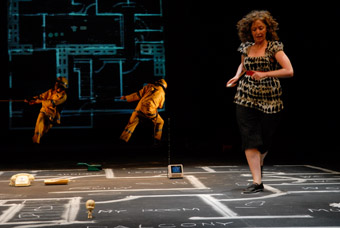
Louis Fitzpatrick, David Buckley,
Deborah Pollard, Blue Print
photo Heidrun Löhr
Louis Fitzpatrick, David Buckley,
Deborah Pollard, Blue Print
FOR FRENCH PHILOSOPHER GASTON BACHELARD, THE CHILDHOOD HOUSE REPRESENTS THE SHAPE OF THE HUMAN PSYCHE: A MEMORY CONTAINER STACKED WITH DELICATE OR DANGEROUS TRACES OF THE PAST. STAIRWAYS, LINEAR AND ANGULAR; OPEN-PLANNED SPACES LEADING INTO LIGHT AND SHADE; UNDERGROUND CELLARS THAT REPLAY THE DARKER RECESSES OF THE MIND. THESE ARE THE CAVITIES AND GEOMETRIES IN WHICH WE GROW ACROSS TIME. WE EMBODY THESE SHAPES AS THEY SHAPE US. THINGS GET STORED IN SUCH SPACES: OUR OBJECTS (A BROTHER’S LOUD‘N’DUSTY LED ZEPPELIN COLLECTION) AND OUR MEMORIES (ANGER, GRIEF, RAGE…A PETRIFYING AND ANGUISHED SCREAM ACROSS THE TELEPHONE…).
Deborah Pollard’s personal reflection on the loss of her childhood home in Blue Print is a reverie in response to the devastation of the 2003 Canberra bushfires. “After a firestorm”, the opening projections explain, “there is silence…no lawnmowers…no trees.” These bushfires are remembered for their absolute destruction, swallowing two thirds of the region in flames, gutting 501 houses and killing four people. For Pollard, it is the 501st house that offers a statistic of humanity amidst such mammoth anonymity. She likes to think of the oddly numbered house as her house; the one uniquely singled out amidst those many others.
A phone sits centre stage, ominous symbol of events to unfold. Around this, Pollard paces out the plan of her childhood house, using a linemarker to chalk the floor with rhythmic precision to reveal stairways and doorframes. Her poise is strong and calm but her actions (obsessively precise) tell a different story. In her act of both retrieval and grief, we watch the house emerge from muddied beginnings into a vision of its former glory. Recorded interviews are cut against Pollard’s action, and we hear relatives recollecting the moments leading up to what is now (we know) predestined destruction. Anecdotes, memories—the minute administrivia of everyday families in the thick of everyday life—crackle across the audio sphere. At times emotive, at times teetering unnervingly towards the feel of Australian Story reportage, voices fill the space with an empty, nostalgic echo.
Sentiment in words and action is undercut by the presence of three anonymous firefighters. Like bright yellow stock characters, they sprint across the space, pull ropes, or convalesce, blackened and exhausted, against a smoking Christmas tree. These are the uniformed tricksters who animate Pollard’s backstage psyche. They have moments of partytime, exhaustingly head-banging to Led Zeppelin’s Dazed and Confused (a comment on the dubious commitment of ACT authorities to the prevention of the fires?). They also have to deal with staggering grimness, pulling a heavy, life-sized dead horse—inanimate, flopping and falling across the space. The horse is rendered in a lifeless darkish purple, making it a metaphor for all the loss that this scene has witnessed. It is pathetic, ironic, tragic, disgusting: a striking image against the mundane simplicity of Pollard’s home world.
Sound (Gail Priest) and video (Samuel James) also introduce curious signifiers into the space. A door frame seemingly grows and retracts like a worm on the upstage projection screen. The door bleeds into visions of a burnt-out, trunk-laden landscape against the searing horizon sun: that archetypal image of an Australian bush summer, holding smells of Christmas and heat and soggy roast chicken in its iconography. Sound evokes an ambient melancholy, occasionally mimicking the gentle crackle of fire, but often gestures emotively, underlining stage action and story.
Blue Print is less about smoke and fire than the innate trauma of time passing: of losing the touchstone of what is most familiar and known. And yet, amidst such potency, there is an aura of stasis in Pollard’s theatre of recollection. We watch the performer looking at her leftovers—the psychic residue of her childhood home—without much hope of revelation. Memory is like this too. Cyclic and unrelenting, it can make inertia out of the very catharsis that it would rather seek. The poetic transcendence that theatre brings to stories of trauma can elevate the personal into a shared sense of insight and healing. In Blue Print I was strangely unmoved by the scenescape of recuperated bits and pieces. I couldn’t help thinking that all childhood houses disappear in one way or another—it’s how their corners and geometries have shaped us that counts.
Blue Print, devisor, performer Deborah Pollard, performers David Buckley, Daniel Fenech, Louis Fitzpatrick, dramaturg John Baylis, video design Samuel James, horse design erth, sound Gail Priest; Performance Space, CarriagWorks, Sydney, Oct 26–Nov 4
RealTime issue #82 Dec-Jan 2007 pg. 39
© Bryoni Trezise; for permission to reproduce apply to realtime@realtimearts.net
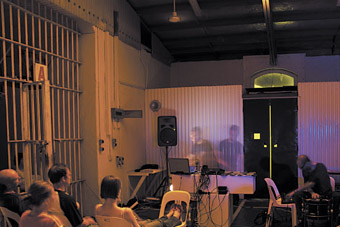
Sounds Unusual, Fannie Bay Gaol
photo Tanja Kimme
Sounds Unusual, Fannie Bay Gaol
THE 2007 SOUNDS UNUSUAL EVENT BEGAN IN ALICE SPRINGS THIS YEAR AS PART OF THE ALICE DESERT FESTIVAL BEFORE MAKING THE JOURNEY THROUGH DESERT TO COAST TO DARWIN TO PRESENT SURREALESTATE AT FANNIE BAY GAOL AND ISLANDS:CROSSING IN WHICH FIELD RECORDINGS BOTH AUDITORY AND VISUAL WERE COMBINED FOR MULTICHANNEL SOUND AND NEW MEDIA INSTALLATION AT THE DARWIN VISUAL ARTS ASSOCIATION (DVAA).
Director Rob Curgenven likes to gather audiences in historical Darwin sites, previously the WWII oil tunnels and this year Fannie Bay Gaol. These significant sites provide more than a backdrop, often dictating the overall listening compass. The essence of these events is an individual’s experience of a textured and tactile listening world, performed in a venue with great acoustic potential and theatrical presence.
The opportunity to explore the grounds and in particular the maximum security building where surrealestate was performed provided sombre reflections on 96 years of incarceration including that of Lindy Chamberlain. Many of the inmates gaoled here languished under appalling colonial policies which were racially prejudiced against Chinese and Aboriginal Australians.
Blastcorp (aka Kris Keogh), one of Darwin’s most invigorating performers, teamed with newcomer Ruben from The Fairweather Dolls to provide an appropriate ‘Welcome to Darwin’ set. Jason Kahn from Switzerland performed a solo for analog synthesizer and percussion, and then completed the event in an improvised duet with Curgenven’s field recordings and instrumental harmonics.
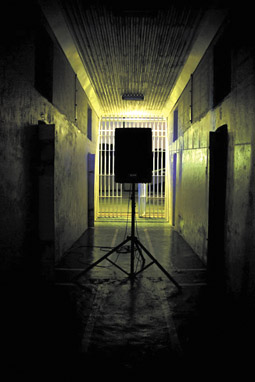
Sounds Unusual, Fannie Bay Gaol
photo Tanja Kimme
Sounds Unusual, Fannie Bay Gaol
Kahn’s sleight of hand across the snare drum created a gradual, entropic state change which was mesmerising. His right hand shimmered over an inverted cymbal while his left deftly controlled the output on the analog synthesizer. Minute changes to the position of the cymbal over the drum created dramatic sonic resonance via an overhead microphone. It seemed the slightest movement from the audience within the cell blocks also impacted on the sounds in the space.
There was a cyclonic build-up of volume as superseded sounds echoed down the darkened tunnels of cell blocks A & B. Speakers formed horizontal columns of sound either side of the audience.
The performance paralleled Darwin’s most famous sound recording, Cyclone Tracy, which plays in a dark room at the Northern Territory Museum & Art Gallery. The gaol is one of the survivors of that disaster. Kahn, perhaps unaware of this uncanny connection, drew us to an immersive finish of gentle dissipation.
Curgenven makes the point that sounds are fundamental to our perception of the world and significant to notions of the familiar and our sensing of otherness. Nature’s presence is pervasively felt in the Top End, not least in terms of time and place. Curvengen’s field recordings, a collection of over 250 CDs stacked in neat piles next to various portable CD players, was the result of many hours of recording from Alice Springs and Central Australia to Darwin via the Tanami Highway.
The complex micro and meso-structure of these field recordings suggested a time pattern for Jason Kahn’s processing. Curvengen’s collection included familiar sounds such as twilight crickets and dogs barking, as well as more all-encompassing sound events evoking specific places. The listener’s recognition of the source material completed the extension Kahn shaped for the overall composition and created an interesting counterpoint to his own continuum. Our ability to completely hear the complexities of a place and time is intersected by memories of the familiar which are in turn displaced and transformed.
The new media installation Islands:Crossing at DVAA featured Rob Curgenven’s field recordings and Katie Hepworth and Tanja Kimme’s photographs and video. A culmination of the journey these artists took from Alice to Darwin, the work recounts through stops and starts the visual and audio journey undertaken. For those who have experienced this road trip the travelling felt familiar. The distance expressed visually seems vast and often is told through zooming towards a point in the horizon. The moments of deceleration are quiet and reflect the field recordings heard.
As a diary piece Islands:Crossing suggests a rich source of material for continued performance.
Sounds Unusual, Northern Territory Festival of New Music, Alice Springs, Sept 8-18, Darwin, Sept 25-28; artists’ field trips: Central Australia, Sept 10-14, Alice Springs to Darwin, Sept 19-24; www.soundsunusual.com
RealTime issue #82 Dec-Jan 2007 pg. 40
© Sarah Pirrie; for permission to reproduce apply to realtime@realtimearts.net
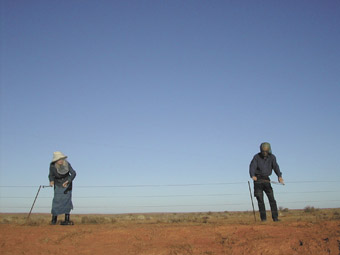
Hollis Taylor & Jon Rose, Twin Lakes, NSW
photo Jon Rose
Hollis Taylor & Jon Rose, Twin Lakes, NSW
AUSTRALIAN VIOLINIST, COMPOSER AND INSTRUMENT MAKER JON ROSE’S PASSION FOR BOWING FENCES GOES BACK TO 1983. BARELY INTO THE ‘LET’S LIVE TOGETHER STAGE’ OF HER RELATIONSHIP WITH ROSE IN 2002, AMERICAN CLASSICAL VIOLINIST, CHAMPION FIDDLER AND COMPOSER HOLLIS TAYLOR FINDS HERSELF CHAUFFERING HER PARTNER ACROSS AUSTRALIA, ATTACHING CONTACT MICROPHONES TO THE WIRES AND POLES OF FENCES THEY WILL PLAY—NEW AND OLD, TAUT AND COLLAPSED, IN LANDSCAPES PUBLIC, PRIVATE AND RESTRICTED, WIND-BLASTED, COOKED AND BEAUTIFUL, IF ALIEN. TAYLOR HAS DOCUMENTED THE EXPERIENCE IN A FASCINATING BOOK.
Rose and Taylor stroke and tap fence wires gently and aggressively. They shorten and extend lengths with spare hands, bending and damping wires to yield a remarkable sonic range. The resulting layers of metallic squeal, mellow hum and strange harmonics sound nonetheless like kin to the sounds the wind draws less extrovertly from these remote fences. The book’s accompanying DVD provides numerous examples of the fences, landscapes and playing with occasional striking images of Rose’s head swathed in gauze (amidst a plague of flies) and Taylor a gothic figure in black against ochred or ghostly, bleached landscapes and battered fences.
The book is a funny, frank, finely written account of an artistic adventure and a personal and intellectual relationship in formation—there’s a liberal supply of Jon Rose’s ideas and observations too. Taylor’s evocations of the Australian landscape as witnessed by an outsider are vivid, so too accounts of the demands on the body, not least the hands. Post Impressions offers the pleasures of a good travel book (rare locations plus the hell that becomes fun in retrospect) and an informative account of the wider reaches of music. RT
Hollis Taylor, Post Impressions: A Travel Book for Tragic Intellectuals, A TwiSted Fiddle Production, 2007, order from www.hollistaylor.com
RealTime issue #82 Dec-Jan 2007 pg. 40
© RealTime ; for permission to reproduce apply to realtime@realtimearts.net
SIAL SOUND STUDIOS, IN COOPERATION WITH THE CITY OF MELBOURNE, STAGED THREE PERFORMANCES OF EXPERIMENTAL MUSIC AS A LUNCHTIME CONCERT SERIES IN THE MELBOURNE CBD. THE FIRST CONCERT WAS HELD IN THE TOWN HALL, BUT THE REMAINING TWO WERE HELD OUTDOORS, BRINGING NEW MUSIC TO A PUBLIC OUTSIDE THE CONCERT HALL. SIAL—SPATIAL INFORMATION ARCHITECTURE LABORATORY, PART OF THE SCHOOL OF ARCHITECTURE AND DESIGN AT RMIT UNIVERSITY—TAKES AN INTERDISCIPLINARY INTEREST IN SPATIAL AWARENESS, SOUND IN THE ENVIRONMENT AND THE INTERRELATIONSHIP BETWEEN SOUND AND ARCHITECTURE.
Concert two was held in Fulham Place, off Flinders Lane, an area densely populated with shopping malls and office blocks. Fulham Place is an urban canyon, about 4m wide, 80m long and four to five storeys high, with gracious neo-classical architecture on one side and a bare concrete wall on the other. Performer Karen Heath’s work Artemis occupied the program, a work paying homage to the Greek goddess whose sacred animal was the deer, and she was suitably attired in antlers, fur and makeup. Playing a miked bass clarinet, Heath steps ritualistically around the space as the work unfolds. The sound is slow, with gentle, simple motifs repeated and blended with pre-recorded voice and percussion, as well as ambient noise picked up by microphones in the laneway. An array of loudspeakers projects the sound into the reflective walls, and live processing by Lawrence Harvey and Jeffrey Hannam creates a complex, layered orchestration. There is a delay of variable length in the rebroadcasting of the live clarinet, creating an artificial echo of shifting dimensions to contrast the acoustic character of the space.
Heath’s performance concludes as the sun reaches its zenith and floods the laneway with light, and she kneels to blow into the clarinet’s microphone, creating the sound of wind. At nearly an hour in length, this is a demanding work for the soloist. Artemis is a delightful composition, and its mythological references, especially in this location, create a sense of longing for an unachievable past in a world of decline.
Concert three was located on the north bank of the Yarra River, outside Flinders Street Railway station. The work was Karlheinz Stockhausen’s Spirale, performed by Michael Fowler, a post-doctoral fellow at SIAL. Spirale, composed in 1968 for short-wave radio receiver and an instrument of the performer’s choice, is an important work in Stockhausen’s oeuvre. The performer must broadcast a moment of sound from the radio, which might not be tuned to any station, imitate it and then use the resulting sound as thematic material to develop variations and elaborations. Fowler used a Doepfer analogue synthesiser and Korg micro synthesiser in conjunction with the radio, and worked from a score that outlines overall parameters but leaves much to the performer. The result — carefully executed hissing and whining signals and staccato beeps and squeaks, of varying pitch, duration, frequency and volume, interspersed with occasional keyboard notes—was highly musical, with a delicate subtlety.
The performance utilised the north bank’s Signal sound system—16 pairs of speakers mounted just above head height at intervals along a 100 metre stretch of the path bordering the river. The use of a 50 millisecond delay between each pair of speakers added to the spaciousness of the sound. In this setting, the listener’s attention is not focused as it is in an auditorium. Rather than reaching us from a fixed point, the sound floats in the air and blends with ambient sound, especially the clatter of suburban trains from the adjacent station. The listener becomes aware of the parallel universe of radio waves and of the electronic communication that permeates our lives, and also of other sound in the space. Such a realisation of the Stockhausen work adds considerably to it through its integration into a space already alive with sound and movement.
Artistic director Lawrence Harvey indicated that the intention of these outdoor lunchtime concerts was to bring experimental music to the city public. Fulham Place was chosen for its acoustics and, being a dead-end, it would normally attract little through traffic, but the north bank of the Yarra is a busy promenade, especially on a workday lunchtime, and numerous passersby heard at least a few moments of Spirale. Importantly, both concerts explore the shifting of spatial awareness and the incorporation of environmental sound into the material—sound both as installation and as a mutable, dynamic element of its environment. As well as bringing new music to the public, locating these events in public space adds significant sonic and conceptual dimensions to the works themselves.
SIAL Sound Studios, Lunchtime Concert Series, Karen Heath, Artemis, Fulham Place, Nov 9; Michael Fowler, Spirale, composer Stockhausen, Yarra River, Melbourne Nov 16
RealTime issue #82 Dec-Jan 2007 pg. 41
© Chris Reid; for permission to reproduce apply to realtime@realtimearts.net
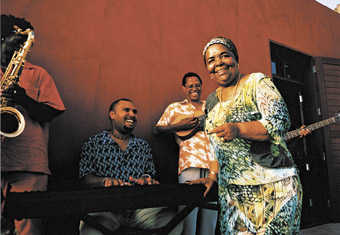
Cesaria Evora
THE LABEL ‘FOLKSINGER’ SOMETIMES APPLIED TO CAPE VERDE’S “BAREFOOT DIVA”, CESARIA EVORA, SEEMS INADEQUATE, PERHAPS BECAUSE THE FORM SHE HAS INHERITED AND DEVELOPED, MORNA (SONGS OF SADNESS WITH LYRICS IN THE AFRICAN-PORTUGUESE CAPE VERDEAN CREOLE), IS A SUBTLE, SOPHISTICATED HYBRID, DRAWING ON ANGOLAN LANDU (LAMENT), PORTUGUESE FADO AND BRAZILIAN MODINHA WITH A TOUCH, POSSIBLY, OF ARGENTINIAN TANGO. EVORA’S DISTINCTIVE SOULFUL LYRICISM AND HER ACUTE SENSE OF PHRASING LEAVE MANY A JAZZ SINGER IN THE SHADE.
Cape Verde is a volcanic archipelago 500km off Senegal in western Africa. Breaking from Portugal it became an independent state in 1975. Evora was born on the island of Sao Vincente in 1941, her father a musician, her uncle a morna composer, but she didn’t become a star until 1988, and thanks then to French patronage.
Morna is most often described as soulful, the songs focusing on separation, homesickness and lost love. They have been composed by many hands, the topics often quite local and frequently idiosyncratic—a wasted salary (“Oh little Theresa/ The money from Angola is gone/ I do not have a penny left/ to spend with you”), the decline of the city of Mindelo, getting drunk (“There were three of us/ Drinking rum punch/ We emerged/ Quite out of control /and walked like/ ‘Crooked’ Mr Antoine”), while others are more broadly romantic, even nostalgic. But the mood is never depressed, rarely dark, certainly often sad and yearning but always with a supple buoyancy that suggests reflection and even stoicism.
The classic lilting morna accompaniment comprises guitar, cavaquinho (a small four-stringed Portuguese guitar), violin, clarinet and accordion, but Evora uses a wide range of instrumentation album to album while maintaining a distinctive morna feel or invigorating the sexy dancerliness of the other Cape Verde musical idiom, coladera. Cesaria Evora is a major figure, much more than a World Music icon. Her appearance at WOMADelaide 2008 should be one to relish and treasure. RT
WOMADelaide, Botanic Park, Adelaide, March 7-9, 2008, www.womadelaide.com.au
RealTime issue #82 Dec-Jan 2007 pg. 41
© Keith Gallasch; for permission to reproduce apply to realtime@realtimearts.net
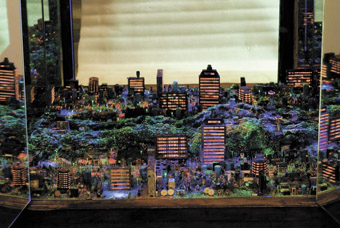
Glance Back, Na Mo
THE SCULPTURED INDUSTRIAL LANDSCAPES CREATED BY KOREAN ARTIST NA MO (KIM NAM OH) WOULD RESONATE ANYWHERE IN THE CONTEMPORARY WORLD, BUT SEEM PARTICULARLY POIGNANT WHEN SEEN IN CHINA’S CAPITAL. YOU DON’T HAVE TO BE IN BEIJING LONG TO FEEL ALL THE WONDERFUL SENSORY, CULTURAL AND SOCIAL STIMULI OF THIS 21ST CENTURY MEGA-METROPOLIS, JUST AS SURELY AS THE CITY MAKES PLAIN THE UGLY CONSEQUENCES OF UNFETTERED URBAN EXPANSION. SIMILARLY, NA MO’S WORK CONVEYS THIS SENSE OF HOPE AND IMPENDING ENVIRONMENTAL DISASTER IN EQUAL MEASURE.
Na Mo first came to China in 1993 to study Chinese ink painting, graduating from Beijing’s Central Academy of Fine Arts in 1999. He returned to Korea to teach for five years, but found himself drawn back to the Chinese capital. “I’m interested in Chinese traditional things, especially Chinese antiques. I wanted to do some research on antiques and find a way to combine modern and traditional things in my art.” This aim has borne fruit in his recent work, evidenced by the Glance Back—Environmental Pollution exhibition recently staged at Omin ART, a small gallery in Beijing’s famous 798 arts district.
Entering the converted factory space of Omin ART, visitors are confronted with two large works hung on the wall like paintings. They are anything but conventional canvases however. The black surface of each is peppered with tiny protrusions, laid out in grids dissected by ‘roads.' Upon closer inspection, the tiny ‘buildings’, ‘silos’ and ‘factories’ forming each block turn out to be circuit boards and assorted electrical parts such as transistors, capacitors and wires. One work features a shiny river of resin dissecting the miniature ‘city’, washing around the buildings like a stream of industrial runoff that’s burst its banks. The other work is marked by a red blotch splashed across the darkened surface, like a bloodstain left by some omnipotent being. It takes a few moments to realise the red patch is in the shape of China.
The next room contains a series of cityscapes also constructed from rusted electrical and computer parts, set in sculpted landscapes made from resin and fibreglass. Some are set into tables, while others reside in traditional looking Chinese cabinets, complete with wooden doors. The largest work, Environmental Pollution, is set into a table over two and half metres long and a metre wide, and depicts a darkened industrial cityscape interspersed with large boulders, surrounded by bubbling volcanoes in the hills. The volcanoes look like fetid pools of industrial outflow, or perhaps primordial forces attempting to burst through humankind’s imagined domination of nature.
The cityscapes set in cabinets are collectively entitled Glance Back, and exude a more ambiguous but less menacing air. The ‘buildings’ in these cities are covered by a furry looking substance in dayglo colours growing across the landscape like psychedelic moss. Fluorescent lights enhance the sense of iridescent splendour, simultaneously suggesting some horrific irradiating disaster that’s washed over the landscape, and nature reclaiming the city.
Superficially, the works in this exhibition bear little relation to the classical landscape painting Na Mo studied at art school, but in the exhibition catalogue, Lily Hope Chumley notes a certain continuity in the artist’s concerns: “Landscape painting has always served both to represent real places and to reimagine them, excising or exaggerating their flaws and charms. In these works, Na Mo on the one hand engages with the ugliness of the modern city and, on the other, strives to develop a visual language with which to describe its beauties.”
Na Mo’s cities in miniature, constructed from the technological detritus of the recent past, signify and critique both the material conditions and philosophical questions of the era in which we live. The eerily depopulated cityscapes have a melancholy air, memorials to the end of the industrial era and its dreams of unlimited production. The only signs of life in Environmental Pollution are the bubbling pools of sludge in the hills surrounding the city and the winking pinpricks of light along each street. Have the inhabitants been annihilated by some unspecified disaster, or has the unrestrained pursuit of industrialised production simply rendered this city uninhabitable? Perhaps the population has moved on, leaving the city as a deserted monument to a dream now abandoned or transcended.
The glowing scenes set inside traditional furniture suggest a more hopeful, sustainable future, in which old and new, people and the environment, exist in more harmonious balance. The buildings here are lit from within, suggesting warmth and an ongoing interior life. The walls of the cabinets in which the landscapes are set are mirrored, reflecting the face of the observer looking down on these scenes as if investing him or her with the power to realize the potential of a more balanced mode of urban existence.
Na Mo says that in creating these works he sought to make art that would speak directly to ordinary people about contemporary concerns. Judging by the obvious fascination of many visitors, both Chinese and non-Chinese, these concerns require little translation for an international audience. We are surrounded by irrefutable evidence of the untold damage we have inflicted on the planet, yet we have at our fingertips productive power and collective wealth unimaginable to earlier generations. The course we take at this crucial juncture will determine whether we harness this power to move to a more balanced way of life, or simply exist in an ever more degraded environment of life-destroying pollutants and industrial fallout. Nowhere does this choice seem starker than in the People’s Republic.
At the centre of Na Mo’s exhibition is a final work, quite different from the surrounding landscapes. It depicts a human shape completely encased in circuit boards, covered with tiny lights and lying on a bed of fine black dust. Twentieth century man laid to rest, or 21st century man ready to emerge from the dust of the industrial era? Na Mo’s art embodies some of the fundamental questions of the 21st century, suspended as we are between the death of one era and the boundless potential of another.
Glance Back—Environmental Pollution, artist Na Mo, Omin ART, 798 Art Zone, Beijing, October 1-19
Many thanks to Wang Yi for her assistance in translating the writer’s interview with the artist.
RealTime issue #82 Dec-Jan 2007 pg. 42
© Dan Edwards; for permission to reproduce apply to realtime@realtimearts.net

Ballad(s) for Quiet Horizons, video still, Scott Morrison
WITH A LITTLE PERSEVERANCE AND THE RIGHT STATE OF MIND, SCOTT MORRISON’S BALLAD(S) FOR QUIET HORIZONS IS A REWARDING EXHIBITION, OFFERING A UNIQUE SPACE FOR INNER REFLECTION. LIKE STARTING POINTS FOR MEDITATION, THE THREE VIDEO INSTALLATIONS IN CCAS MAIN SPACE USE THE FAMILIAR IMAGERY OF GRASS, CLOUDS AND LEAVES TO SPARK A PERSONAL AND EMOTIONAL RESPONSE. TRIGGERING MEMORIES AND AWARENESS OF CURRENT THOUGHTS, BALLAD(S)… IS SOMEWHAT OF A ‘MAKE YOUR OWN EXPERIENCE’, DEPENDENT ON THE DESIRE AND CAPACITY TO STUDY THE WORKINGS OF YOUR MIND.
Transforming the open gallery space into a dark haven, Morrison mesmerises his viewer, the senses adjusting to the rhythmic light and sound, eyes drawn to four monitors sitting in a pile of dirt and wood chips. In this first installation, Les echos de l’ocean, a large wall projection of a 12-second shot of grass has been edited and processed so that the stems become mere lines and shapes, flickering rhythmically. This clean-cut imagery contrasts with the bed of earth and wood, its smell and texture alerting us to the physicality of the installation; as if under hypnosis, we are aware of Morrison’s spell but are unable to stop ourselves succumbing.
Morrison reinforces this repetitive imagery with a complex layering of sound. A musical score, derived from the original audio, complements the motion of the blades of grass and is layered over the sound of wind. In the background, the music of the other two projections floats in and out of my consciousness. Turning away from Les echos de l’ocean, I almost fall over a large monitor which reflects the large grass projection. On another in the the back corner of the room, the image of a blue, cloud-swept sky builds a horizon for the endless field of grass. The constant interplay of sound and image means that Ballad(s) for Quiet Horizons simultaneously comprises one whole and three discrete ballads, immersing the viewer in a harmony of sight and sound.
By providing headphones for two of the three installations Morrison allows for more intimate ruminations over each of the works. For A push and a shove but we fell out of this together, the audience is invited to don earphones, blocking out the sounds of the other two installations. Suddenly, the blurry imagery projected on the adjacent wall becomes clearer. Slowly, the layered music and rhythmic overlaying of leaves—glowing in the darkened space—engulfs the senses. The burning desire to make sense of the exhibition dissipates. Within the bubble of the headphones, I am content to sit, gradually becoming aware of a jumble of racing thoughts.
In Drift, the ambient sound arrangement of the previous two works becomes background to Adrian Klumpes’s more structured musical score. Memories of afternoons spent lying on my back, finding shapes in the clouds above, come flooding in as I watch Morrison’s peaceful projection of sky. Compared with the flickering speed of its companion works, Drift imbues a feeling of serenity.
Ballads for Quiet Horizons highlights how the layering and intertwining of images and sounds shapes responses, forming textured personal journeys, but without beginnings, middles and endings, journeys as rich as everything we bring to the work and how far we let ourselves surrender to it.
Scott Morrison, Ballad(s) for Quiet Horizons, Canberra Contemporary Art Space, Oct 12–Nov 24
RealTime issue #82 Dec-Jan 2007 pg. 43
© Cheree Mack; for permission to reproduce apply to realtime@realtimearts.net
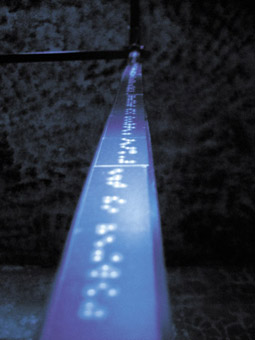
:the braille box:, Jessica Tyrrell
CANTERBURY ROAD ALWAYS SEEMS TO BE HOT, NOISY AND BRIGHT—THAT WHITE, RELENTLESS LIGHT OF A SYDNEY SUBURBAN SUMMER. BUT SLIPPING THROUGH THE MAKESHIFT BLACK CURTAINS INTO THE FRONT ALCOVE OF THE DON’T LOOK NOW GALLERY, THE SHIFT INTO THE DARK IS MORE THAN JUST THE ABSENCE OF LIGHT REQUIRED FOR VIDEO PRESENTATION—IT’S THE REALM OF THE WORK ITSELF.
In the middle of the almost claustrophobic front space is a smaller metal skeleton of a room. Connecting the four planes of the scaffold is a thin shelf on which strips of braille are pasted, dimly lit, inviting you to touch. As I run my fingers along the bumps, a voice emerges abruptly from behind me out of the darkness, and a snippet of video appears projected on the low ceiling, directly above the cube. I react, remove my fingers and the action stops. Soon I learn to play the box: closer to the corners is louder and more intense, moving towards the centre vision and sound begin to fade, eventually shifting into another voice at the far end.
Jessica Tyrrell has drawn the content for :the braille box: from interviews with people (curiously, mainly men), discussing what it is to be blind, how they lost their sight, the progression of their blindness and their reactions, both psychological and physical. The video sequences use grey/blue hues and show the interviewees’ faces, partially obscured by shadow, overlaid with light patterns and textures. Like the sound, these visions respond with varying levels of clarity and intensity to the actions of fingers on the braille.
The interviews in themselves are totally absorbing as the subjects speak in strikingly honest yet quite detached tones about their experiences. One man who has become blind in mid-career, talks of the sensation of his life peeling away, all sense of identity based on what he ‘did’ stripped from him, forcing him to reconstruct himself as the person he actually ‘is.’ A woman wonders whether blind people feel more intensely, not just through heightened senses, but emotionally. A calm acceptance and wisdom comes across in these conversations that makes me feel an honoured witness.
In some ways :the braille box: could stand as a purely interactive audio installation, as the voices are fluidly manipulated and augmented with subtle under-rumbles and reverbs and are interestingly spatialised. However the use of the video emphasises the feeling of disorientation and loss. The constant shifting and obscuring of the image serves to construct a visual parallel for the sensation of blindness—an intriguing contradiction for a seeing audience.
Jessica Tyrrell has been very canny in her design of the interactive interface. The cause and effect is quickly discernible, but you need to constantly run your fingers across the braille to keep the content playing. While the installation may initially appear to be touch sensitive, further play reveals the use of video tracking registering the movement of the fingers to control the audiovisual material. Using distance from the camera as a key parameter the results are slightly unpredictable providing just enough frustration to keep you exploring and seeking more of the content, which is at once educational without being didactic, and moving without lapsing into sentimentality. So engrossing was the experience that when I stumbled back out into the shockingly sunny street not only the tips of my fingers were tingling.
Jessica Tyrrell, :the braille box:, Don’t Look Now Gallery, Sydney, Nov 8-17
RealTime issue #82 Dec-Jan 2007 pg. 43
© Gail Priest; for permission to reproduce apply to realtime@realtimearts.net
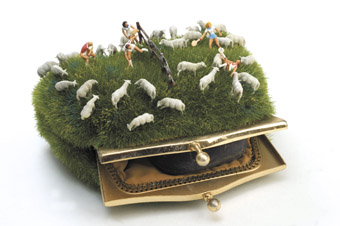
Kendal Murray, Game, Aim, Blame, Proclaim
courtesy of the artist
Kendal Murray, Game, Aim, Blame, Proclaim
THE FRENCH ROMANTIC POET OF THE 1870s, ISIDORE DUCASSE, AKA THE COMTE DE LAUTRÉAMONT, HIT ON AN IMAGE OF BEAUTY THAT WOULD LATER BE CHAMPIONED BY ANDRÉ BRETON AND HIS COLLEAGUES AS AN EPIGRAM FOR SURREALISM: THE RANDOM ENCOUNTER OF AN UMBRELLA AND A SEWING MACHINE ON A DISSECTING TABLE. ACCORDING TO BRETON ET AL, THE PROPHETIC DUCASSE HAD NAILED THE SURREALIST SHTICK 50 YEARS AHEAD OF TIME. IN MAX ERNST’S LOOSE PARAPHRASE OF THE SELF-STYLED COUNT, IT’S ALL ABOUT THE COUPLING OF INCOMPATIBLE REALITIES IN AN INAPPROPRIATE PLACE.
Such random encounters and oddball couplings abound in Kendal Murray’s exquisite An Enchanted Life, with its insistently surrealistic undertow. Here, the dissecting table is a vintage facepowder compact, purse, or teapot, diminutive proscenia in which everyday objects and tiny, naturalistic plastic figures collide in complicated dramas of startling illogic. Not for her the pop-kitsch of the melting clock school of surrealism. Murray’s are the whip-smart inversions of causality and torsions of logic of, say, Meret Oppenheim’s alarming fur cup-and-saucer set (Breakfast in fur), or Magritte’s La reproduction interdit, the low-key nightmare in which an anonymous everyman fronts up to a mirror which reflects only the back of his own head.
As did the surrealists’ work, Murray’s Enchanted Life inhabits the terrain of fantasy, dream and the unconscious as it irrupts into conscious life. Many of the 36 sculptures that make up the show mine the rich lode of metaphor and metonymy that, in psychoanalysis, characterises dreamwork, some leavened by offbeat humour. Motifs include water, the sylvan glades of nature, and the deepseated thrum of anxiety played out in the archetypal dreams of falling from heights or appearing unclothed in public. Murray’s scenarios feature objects of perceptual framing or of transition from interior to exterior space—windows, ladders. And in the pieces using vintage powder compacts, the mirrored backdrop is omnipresent, multiplying the hermetic mise en scene of the miniature, a trope of the unconscious, as the outside is likewise reflected in.
In Advance, Romance, Perchance, a man and woman sit with their backs to each other on opposite sides of a bed, his arms folded defiantly. A tall tree with lush foliage sprouts between them from the marital mattress—a rebus, perhaps, for existential disconnection and loss, potently metaphorising what it is to grow apart. In Implore, Ignore, Done For, a relationship is frozen in moment of chaotic meltdown worthy of a feverish Albee. A woman stands with arms akimbo precariously teetering on a towering jumble of chairs, a cleaner in the corner sweeping up the scattered debris surrounding her. The female protagonist looks expectantly to a man with his back to her, standing on a table, leaning out of a window. His escape, if that’s what it is, is thwarted by the mirror/wall that occludes the window and visually loops him back into the chaos, enmeshing him in the domestic maelstrom. In another riff on coupledom, oblivious young lovers embrace on top of a parked car overrun by a luxuriant blanket of grass, as time, for them, telescopes into one crowded hour.
Elsewhere, a high diver launches headfirst into a backward swandive off a precipitously high ladder into a half-filled bathtub. Simultaneously, in what seems to be another temporal dislocation—a flash-forward to the unpretty ending?—cleaning women scrub the tiled bathroom floor. In another watery scene, two boatmen in a tiny craft battle the roiling, treacherous seas of a storm in a compact. A neat play complicates the dream/wakefulness, inside/outside divide: one flings the boat’s wildly outsized anchor right over the compact’s gilded edge, shattering the fourth wall.
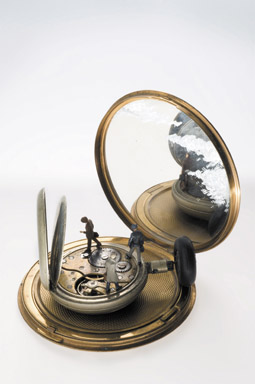
Kendal Murray, Chase, Replace, Erase
courtesy of the artist
Kendal Murray, Chase, Replace, Erase
Murray’s Lilliputian tableaux are no less compelling for being short on the vivant. A signature of the show is the surprisingly full sense of subjectivity that animates the inert plastic toys in Murray’s itty-bitty theatre of the absurd. These figures, and the vignettes which they play out, possess the slightly perplexing capacity to touch the viewer, eliciting emotional and psychological investment in the characters’ backstories. It’s oddly hard not to care about the psychodramas of these two-cent toys, or involuntarily project into the scenes the freight of a lifetime of psychic flotsam, improvising mini-narratives for them shot-through with the pulse of personal memory, anxieties and desire.
Some works are not so enigmatic, but still powerful and curiously moving. In Chase, Replace, Erase, three drab-suited briefcase-carrying workers endlessly walk the circumference of a splayed-open gold fobwatch, damned to the Sisyphean grind and anonymity of the salaryman. In Distance, Resistance, Existence, down at heel eastern-European émigrés lugging shabby suitcases stand mesmerised by a shopping trolley set on a verdant circle of grass. They’re cut off from the steely grail by a ring of rubble and rocks. The work here has a cast of political theatre, with its poignant take on the diaspora and swipe at the all-consuming commodity fetishism that shorthands late global capitalism.
Murray’s achievement is enduring in several ways. There’s the sheer beauty of her miniatures and the prodigious dexterity of their construction. Then there’s her creation of multiple parallel universes, each layered over with allusion, and each peopled by human-shaped bits of plastic imbued with unexpectedly complex interior life. Most striking is her adroitness of touch in inflecting everyday scenarios with the sudden, disorienting punch of dreamscape and hallucination, exploiting in the most evocative way the convulsive juxtapositions of the surreal.
Kendal Murray, An Enchanted Life, Arthouse Gallery, Sydney, Sept 16-Nov 13
RealTime issue #82 Dec-Jan 2007 pg.
© Annemarie Jonson; for permission to reproduce apply to realtime@realtimearts.net
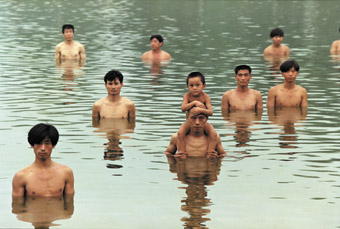
To Raise the Level of Water in a Fishpond (1997), Zhang Huan
ROBERT LEONARD CURATED GREY WATER, AS PART OF BRISBANE’S RIVER FESTIVAL, IN RESPONSE TO THE CURRENT ANXIETIES ABOUT WATER AND IMMIGRATION—ANXIETIES ABOUT “PURITY”, AS HE PUTS IT IN THE CATALOGUE. JUST INSIDE THE DOOR, HIGH IN A LITTLE ROOM OF THEIR OWN AND SPEWING FORTH SOAP BUBBLES LIKE A CHILDHOOD PARTY DREAM, ARE TERESA MARGOLLES’ BUBBLE MACHINES, LOADED WITH THE SOAPY WATER USED TO WASH DOWN CORPSES IN MEXICO (HOW DID THAT GET PAST QUARANTINE?). TO ENTER THE ROOM IS TO BREATHE IN TINY LITTLE BITS OF THE DEAD, MOLECULES FROM THE SKIN, WATERY HOMEOPATHIC VIBRATIONS. IT’S HARD NOT TO HOLD ONE’S BREATH, BREATHE SHALLOW, INVOKE THE FIVE-SECOND RULE OF FOOD DROPPED TO THE GROUND AND GET OUT QUICK. DEATH IS THE GREAT POLLUTER, SOMEONE ELSE’S PROBLEM, SOMETHING TO QUIETLY DO LATER. MARGOLLES BRINGS DEATH HOME, OUT OF DENIAL AND INTO THE MIDST.
Down the hall and in a largish room are Marian Drew’s longitudinal photograms of water, made by direct exposure of submerged photographic paper. The effect is microscopic, clinical and forensic. Slowly sinking to the bottom of the clearest lake and looking up in one last frozen moment at leaves, moths, tadpoles, the sprayed droplets from a hose, ripples running like a creek.
To the back a Peter Greenaway video is running, bodies being dragged from the Seine, the sound up a bit too loud and dominating the room. At different spots in the room, the artist not wanting them displayed together, are photos of the surface of the Thames by Roni Horn. The photos are arranged with image above and footnotes below—definitions, asides, stray thoughts about water and the Thames. The river’s motion is frozen, its surface brought close, where it glistens like the skin of an ancient traveler, tanned and leaden from centuries in an Irish bog.
Also in this room are two portraits by Roland Fischer. In each an individual woman stands in water to the shoulders so that she becomes like a marble bust—like one of the thousands that litter European museums as remnants of ‘Rome’ and ‘Greece.’ At first I thought the two portraits were of the same person but they are not—they just share the same even makeup, impassive gaze and icy, no-fucking-I’m-glamorous stare. Shot in LA, they seem immersed in the cool green waters of commodification.
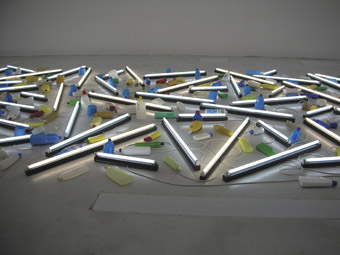
Flotsam, Bill Culbert, 1992/2007
Courtesy Sue Crockford Gallery, Auckland
Flotsam, Bill Culbert, 1992/2007
Next door is the hit-you-in-the-eye show stopper—Bill Culbert’s Flotsam. Lying on the floor, scattered amongst a few dozen fluorescent tubes, are beautifully cleaned de-identified plastic bottles—detergent bottles, home cleansers, bottles that once came with safety instructions—all plopped on the floor in some sort of display of equivalence—rubbish as a condition of equity. Some of the bottles are cut to make them appear to sink into the floor, but most are not—it’s a sort of nod to illusion. The fluoros glint, the white electrical cords curl like ripples on the cement floor of the gallery. Although Culbert is a tad older, I am reminded of work by Tony Cragg, David Mach and Bill Woodrow—art in the transformation of detritus.
There are a couple of rooms set aside for video works. Zhang Huan is one of the big successes of the Chinese art scene and has a short video documenting a 1997 performance from Beijing where he recruited various migrant labourers “to raise the water level in a fish pond.” It’s a rural idyll of a pond in the same way that a feedlot is a bucolic grassland. The men gather around the pond stripped down to underpants which look as if they were designed by an unsympathetic committee in a time of great sadness. Embarrassed grins all round. Nearby, people drive tractors, buy fruit and generally carry on regardless. The men disperse themselves around the perimeter of the fish pond and look at it for a bit. They walk into the water, form a line, then move about until positioned in a sort of random clump. The artist gets in, a bit gingerly. He’s carrying a boy on his head. He starts walking and doesn’t stop until he gets out at the other end and…that’s it. It’s a ritual without substrate, perfunctory and functional, the boy now initiated into the adult world of disengaged labour.
The other video is Memorial Project Minamata: Neither Either nor Neither—A Love Story by Jun Nguyen-Hatsushiba. Starts off with footage of Minamata, the fishing village in Japan where thousands of people contracted methyl mercury poisoning through industrial pollution. Kids laugh and play. There is a truly awful sentimental soundtrack that is both comforting and disquieting. Orange dye blooms in water, referencing mercury orange, a stain that shows where mercury goes in biological tissues—showing the parts mercury takes out.
Cut from the village to underwater, murky, a small group of divers. Bathers, no goggles. The divers are contained within a large dome-like plastic frame which, unaccountably, they try to manoeuvre along the ocean floor. The divers don’t carry their own air, their own life support. That’s supplied by attendants in full scuba gear. This is a high maintenance struggle.
Now cut from underwater to people dancing, bad disco music, shots of their feet, taken low. Anonymous glimpses of someone lying still on a bed. A fan turns. A mosquito net hangs like a hospital curtain. In the languid reverie of their illness perhaps they dream of the water, their breath slow and murky, now underwater, weightless, free, threatened with suffocation.
Grey Water, curator Robert Leonard, artists Bill Culbert (Britain), Marian Drew (Australia), Lawrence English (Australia) and Toshiya Tsunoda (Japan), Roland Fischer (Germany), Peter Greenaway (Britain), Roni Horn (USA), Zhang Huan (China), Abie Jangala (Australia), Rosemary Laing (Australia) with Stephen Birch (Australia), Teresa Margolles (Mexico), Jun Nguyen-Hatsushiba (Vietnam) and Lawrence Weiner (USA); Brisbane River Festival; Institute of Modern Art, Aug 4-Oct 6
RealTime issue #82 Dec-Jan 2007 pg. 46
© Greg Hooper; for permission to reproduce apply to realtime@realtimearts.net
AERIALIZE, SYDNEY'S CIRCUS ARTS TRAINING CENTRE, CERTAINLY KNOWS HOW TO PUT ON A SHOW, A BIG ONE THAT TRUMPETS THE TALENTS OF ITS MULTITUDINOUS STUDENTS, PLAYING TO PROUD PARENTS AND FRIENDS AND THE EAGER GENERAL PUBLIC THAT PACKED THE ADDISON ROAD COMMUNITY CENTRE GREAT HALL FOR THE THREE PERFORMANCES OF OFF THE RAILS.
While a huge forestage accommodated a host of artists of trapeze, tissu, hoop, web, stilts, acrobatics, juggling, mime, song and much more, a towering proscenium set reproduced a railway station mutating from its Victorian origins and British India to the Orient Express and on to the present Sydney Rail timetable delays, the fear of unattended bags and, above all, rail crashes.
All of this was accompanied by a gaggle of historically asynchronous recorded pop songs that one way or another suggested trains. But no matter in a show as happily impressionistic as this in which every beat and image is an opportunity to release the body from the thrall of gravity.
Tiny children filled the stage en masse, hoisting themselves unselfconsciously aloft with rough agility while older students and practiced professionals displayed poise and took risks. Among the standouts were Scott Walker and Tanya Richards in duo tissu in the Melodrama Station scene and, in British India Markets, Megan Bolton on handstand bars, Heidi Holmes and Elli Huber on tissu and again, on spanish web, Richards and Walker.
It was fascinating to watch a show that time-travelled the history of railway travel to reveal that its pleasures and anxieties haven't changed a lot, and nor have the ancient circus arts lovingly preserved and passed on here.
Aerialize, Off the Rails, producer, director Sha McGovern, co-directors Bel Macedone, Leanne Kelly, script Rebecca Conroy, lighting Dave Ferguson, set design James Browne, The Great Hall, Addison Rd, Marrickville, Sydney, Sept 21-23, www.aerialize.com.au
RealTime issue #82 Dec-Jan 2007 pg. online
© Keith Gallasch; for permission to reproduce apply to realtime@realtimearts.net
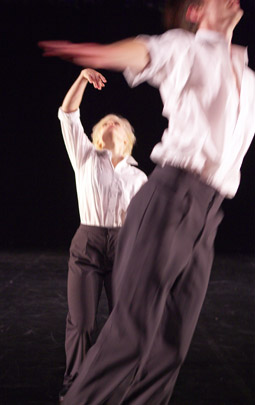
Link Dance Company, The Fugue
photo Jon Green
Link Dance Company, The Fugue
THE US HAS A LOVE-HATE RELATIONSHIP WITH TWYLA THARP. IN MANY WAYS QUINTESSENTIALLY AMERICAN, THARP’S CHOREOGRAPHY IS BRASH, ATHLETIC AND YOUTHFUL, AN EXPLOSION OF WIT AND SHOWY ACTIVITY, WHILE HER DRAMATIC CONTENT HAS COVERED 1960s COUNTERCULTURE (HAIR), THE VIETNAM WAR (HER BILLY JOEL MUSICAL, MOVIN’ OUT) AND THE NATION’S RUSTIC RELIGIOUS BASE (THE SHAKER-INSPIRED SWEET FIELDS). NOW 66, THARP IS MAKING CONCERTED EFFORTS TO SECURE HER LEGACY.
2003 saw the publication of Tharp’s second monograph, while the first critical biography on the artist appeared in 2006. Tharp has even secured her presence on the somewhat nauseating website, the Academy of Achievement.
This rush of activity was accompanied in 2006 by the spectacular flop of Tharp’s dance-theatre-musical The Times They Are A Changin’, a mawkish setting of Bob Dylan’s lyrics to a circus narrative. Critics hated it so much they gave up all pretence of even-handedness and openly mocked it. It is this oscillation in quality not only Tharp’s work, but more particularly her critical standing, which led one New York Times reviewer to remark that if Tharp “were an automobile, she’d be a 1960s Jaguar: fast, stylish, high profile…and unreliable.”
Despite such setbacks, Tharp wishes to situate herself alongside such key figures in US dance as Martha Graham, Hanya Holm and Ruth St Denis. Tharp has long called for a “cross-over” dancer who “could genuinely work as comfortably on the so-called modern techniques as on the classical technique.” And she more recently suggested that her own works could act as “scores and pedagogical material” akin to those developed by classical music “composers to produce better musicians.”
With this in mind, in 2003 Tharp began to licence her works to teaching institutions. Since 2005, more than eight US colleges have staged Tharp’s pieces, including Sarah Lawrence College, where Tharp’s early collaborator Sarah Rudner works.
Tharp has influenced Australian dance. Lucy Guerin began working in Rudner’s company, while the influential Russell Dumas has worked with both Tharp and Rudner. The Australian Ballet staged Tharp’s popular athletic ballet of 1986, In The Upper Room, several times, its brash combination of energised pedestrian movement (running and jogging) with ballet and the pulsing music of Phillip Glass continued to draw audiences. Interestingly though, the first of Tharp’s early works to be staged in Australia as part of this repositioning are Torelli and The Fugue, performed by the West Australian Academy of Performing Arts’ Link Dance Company.
Fugue is a key piece in the canon, originally danced by Tharp, Rudner and Rose Marie Wright. Although austere in presentation, lacking any music beyond the tap-derived stamps of the trio and the silent rhythmic counterpoints of the dance itself, Fugue meshes easily with classicism. It is precise and mathematical, demanding every pose be done just so, and although it has a touch of postmodern pedestrianism in that none of the actual physical phrases or gestures are in themselves all that difficult (arms held horizontal as the body drops into bent legs, slowly, like a perching bird; crossing of the feet to mark out triangles and lines on the floor etc), the speed of the transitions and the intricate ebb and flow of the timing makes for virtuosic performance. Indeed, Fugue has been in the repertoire of the American Ballet Theatre since 1988.
Torelli however is more difficult to fit into any tradition, not least as it has no formal precedent as such. Never performed quite the way Tharp envisaged it, Torelli was to be danced on a barge around Manhattan Island. It ended up being staged only once, in 1971, as an environmental, installed work, performed in a park during sunset, with Tharp et al dressed in everyday winter clothing. The 2005 Marymount College production evoked this unbounded ambience by seating spectators on stage, but the Link Dance Company production was poorly served by the oppressive concrete proscenium arch of WAAPA’s theatre.
The process of reinventing Torelli runs the risk of over-formalising it, of turning it into something closer to Tharp’s later works for Broadway than her earlier productions staged in the last years of the Judson Church movement and postmodernism’s arrival on the US dance scene. After executing a set of pedestrian phrases of arm swings, shoulder shakes and so on, the performers begin to improvise on this material, a deep, slow drop into the floor as the legs spread apart being a notable gesture used to not only pace and segment material, but also as an amusing response to fellow dancers.
While the discipline—or more accurately, the deliberate ill-discipline—of learning such a work is pedagogically useful, the piece offers less for audiences. Its theatrical staging does not attain the sense of countercultural fun and radicalism which it once had, coming across as a historical curio. Fugue by contrast offers much in its temporal delights, while the various gender combinations which today’s companies like Link are playing with present many opportunities for lightly enunciated sass and sex. The current costuming—the slacks, black shoes and open-necked white shirt of a classic Broadway hoofer—gives a touch of transvestite subversion. This was particularly true with one of the Link female dancers’ platinum blonde bob evoking that ambiguous goddess herself, Marlene Dietrich. Fugue is brimming with a sexy, presentational “look-at-me!” execution, while the more introspective Torelli does not directly address the audience, and once taken from the park to the stage, this is problematic.
As far as America is concerned, the jury is still out on where to place Tharp. The choreographer’s transition from postmodern rebel to an almost neo-classical populist makes one wary of quite what effects the institutionalisation of her style might have for the opening out or closing off of physical plasticity today. Tharp has even less in common with deliberately formless and resolutely anti-classical approaches like butoh or Body Weather than Merce Cunningham. Nevertheless, Tharp remains a commanding presence in dance, here as well as in the US, and further opportunities to revisit her work, such as provided by Link, are to be welcomed.
Link Dance Company, artistic director Michael Whaites; Torelli (1971), choreographer Twyla Tharp, new costuming Emily Frederickson, lighting Jayne Ottens, performers Helen Duncan, Russell Leonard, Jade Dibblee, Rhiannon Newton, Laura Boynes, Elanor Webber; The Fugue (1968-71), choreographer Twyla Tharp, lighting from design by Charlie Hodges, costume recreation Santo Loquasto, performers Sophie Burgoyne, Luke Hickmott, Chimene Steele-Prior; Western Australian Academy of Performing Arts, Edith Cowan University, Perth, Nov 1-3
RealTime issue #82 Dec-Jan 2007 pg. online
© Jonathan Marshall; for permission to reproduce apply to realtime@realtimearts.net
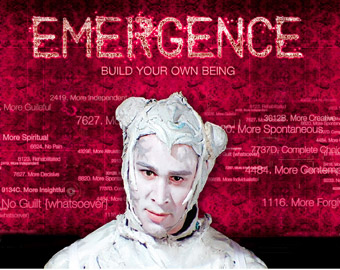
Synarcade Audio-Visuals, Emergence
THE PROCESS OF LABOUR IS LONG, AND SO IT IS THAT EMERGENCE (PRODUCED BY SYDNEY'S SYNARCADE AUDIO-VISUALS) BEGINS NOT AT THE NORTH MELBOURNE TOWN HALL BUT ON THE INTERNET AT MY HOME IN RICHMOND. LOGGING ON TO WWW.BULDYOUROWNBEING.COM I’M ASKED WHICH PERSONALITY TRAIT I WOULD LIKE TO INSTILL IN MY YET TO BE CONCEIVED OFFSPRING.
Later that night, when the performance proper is about to begin, I’m standing in a hi-tech operating theatre surrounded by four screens and a sound system emitting a mesothelial rasp and throbbing gristle. I see the personality trait I chose earlier imprinted on one of the screens: “Walk the Talk Between Eros and Thanatos” says more about me than my bouncing bubba. Having endowed my child with such a precarious awareness I’m reminded of an obsessive father at an Under 9’s football match. Oh the joys of parenting. Thank god I can disavow any responsibility in that area.
Back inside the operating theatre, I’m wearing a fluorescent green halo and feeling like a cross between Astro Boy and Victor Frankenstein. Luckily, 30 other patrons have their heads adorned in the same luminous loop. Above and to my right, a cocoon shaped head projected upon an oval screen implores me not to remove my halo, as it is part of a universal tracking system. Our offspring, appropriately named RAM, will be shaped by our wants, needs, passions and eccentricities. We will vote for characteristics such as ‘Cooperative’ and ‘More Individualistic.' Our responses will be monitored via our halos, fed into the universal tracking system, then recorded percentage-wise and used to shape the personality of RAM.
We skip from screen to screen, voting with our feet. There is some tantrum throwing among the audience as each tries to persuade the ‘Swinging Voter’ that RAM should become ‘Completely Honest’ or “More Critical.' One woman claims there resides amongst us a phallocentric tendril of conspiratorial males hellbent on control of RAM’S development. She’s probably right, for RAM is regressing into childish episodes of chest beating and thumb sucking by the minute. Swept by moments of cheap sentimentality, our monstrous metrosexual has become a being in need of quiet resolution. So, after a second governmental intervention, RAM, as we have created him, is simply discontinued, replaced by a feminised version named Zye who slides down a birth canal and pops out a slit hidden in a screen. Standing on a plinth before us, Zye wants us to help set her free. Beset by the mindless principle of consumer class Individualism, we offer her all the assistance she needs. Some members of the audience even prompt Zye to ‘Find her own path’ and ‘Discover who she really is.' The perils of parenting, it would seem, are irresistible.
Synarcade's Emergence is a sly take on the very human desire to control the lives of others, without realising that the monster residing within has been unleashed and our ‘Inner Tyrant’ set free.
Synarcade Audio-Visuals, Emergence: Build Your Own Being, writer, director Mark Bolotin, performers Nick Currow, Lindsay Farris, Anna-lea Russo, Nicole da Silva, Gary Boulter, Richard Cartwright, multi media production Synarcadia; Arts House, North Melbourne Town Hall, Sep18 – 23; www.buildyourownbeing.com
RealTime issue #82 Dec-Jan 2007 pg. online
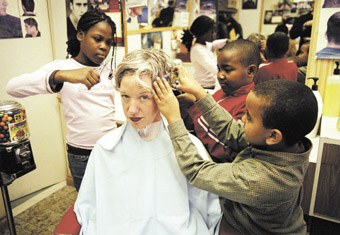
Haircuts by Children
The RealTime Editors and a team of six Canadian writers from the RealTime-PuSh
review-writing workshop will be posting reviews of the festival as it unfolds at
www.realtimearts.net/features
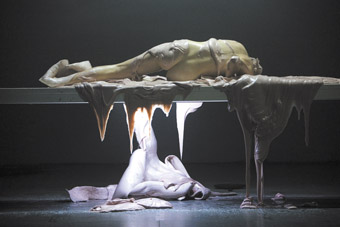
Hey Girl!
Read about these shows & more
Romeo Castelluci [Italy]: Hey Girl!
Boca del Lupo [Vancouver]: My Dad, My Dog
Nigel Charnock [UK] : Fever, Shakespeare sonnets in voice, dance & music
Mammalian Diving Reflex [Toronto]: Haircuts by Children
Catalyst [Edmonton]: Frankenstein
November Theatre [Edmonton-Vancouver]: The Black Rider by Waits, Wilson & Burroughs
Electric Company [Vancouver]: Jonathan Young in Palace Grand
newworld theatre [Vancouver] & Teesri Duniya Theatre [Montreal]: My Name is Rachel Corrie
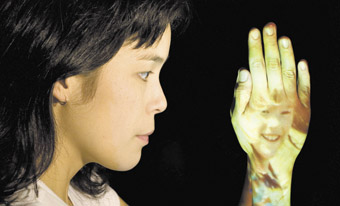
My Name Is Rachel Corrie
and from Australia
CIRCA: The Space Between and 46 Circus Acts in 45 Minutes
Back to Back Theatre: Small Metal Objects
Chunky Move: GLOW
www.pushfestival.ca
RealTime’s participation in PuSh 2007 has been made possible by the Canada Council and the Australia Council for the Arts.
RealTime issue #82 Dec-Jan 2007 pg.
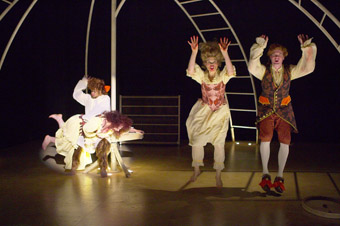
Memmie Le Blanc Deckchair & Vitalstatistix
photo Jon Green
Memmie Le Blanc Deckchair & Vitalstatistix
THE WILD CHILD RAISED IN NATURE WAS A PARTICULARLY ENLIGHTENMENT FIGURE, SEEN AS A LIVING EXEMPLAR OF ‘NATURAL MAN’ UNGOVERNED BY REASON, AND DEBATED BY HOBBES (WHO SAW SUCH ESSENTIALLY SELFISH BEINGS LIVING A LIFE “NASTY, BRUTAL AND SHORT”) AND ROUSSEAU (WHOSE “NOBLE SAVAGE” REPRESENTED A PRELAPSARIAN IDEAL WHICH MANKIND HAD LOST THROUGH THE OPPRESSIVE ACCRETIONS OF FEUDAL SOCIABILITY). ONE FAMOUS WILD CHILD WAS MEMMIE LEBLANC, A GIRL CAUGHT IN THE WOODS OF CHAMPAGNE IN 1731, AGED 10. MEMMIE IS THE SUBJECT OF HILARY BELL’S LATEST PLAY.
Directed for Adelaide’s Vitalstatistix and Perth’s Deckchair Theatre by Angela Chaplin, Memmie Le Blanc is a strong, subtle four-hander which riffs on the girl’s teens, when she was passed from the local Marquis to the (fictional) Duchess Catherine Michel (Netta Yaschin). The production benefits from a wonderful design by Andrew Lake, evoking both the sparseness of Bell’s straightforward narrative treatment while also hinting at the rich excesses of Rococco lifestyle.
On the simple, cream coloured stage floor is a domed climbing frame on which the prime actions are performed, while two holes bounded by jute on the floor act as perforations through which stage elements such as candles, soil and mice appear and descend. Isaac Lummis’ costumes are a particular treat, dresses bulging out in an echo of the frame above them, and each waistcoat, skirt and jacket decorated with ochred orangutans.
Memmie (Anni Lindner) initially appears in a simple white shift, but is entranced by the Duchesses’ coiffure and stitched clothing. An early sign of Memmie’s apparent socialisation is when Yaschin forcefully straps Lindner into new corsetry, each pull of the bindings signifying the social strictures which 18th century theorists recognised as the necessary cost of the ‘social contract’ which prevented men and women from murdering each other. The audience is encouraged to ask itself if the orangutans (an ape attracting much interest in Europe at the time for its supposed facility at imitating humans) sewn onto these dresses really lay outside or within the characters. With the arrival of Dr Legendre (Adam McGurk) and his orangutan companion, Robert (Sete Tele), the question became moot.
Bell based her portrayal on Michael Newton’s Savage Girls And Wild Boys (2002), an erudite but popular account of feral children which historian James Steintrager notes lies uneasily between a “trade book and a work of scholarship” (Eighteenth Century Studies, 38.4, 2005). Although Newton and the play give due attention to historical context, both slip into an ahistorical interpretation of the Wild Child as a universal symbol of the impenetrable depths of human emotion. In the end, Bell and Chaplin are not principally interested in the implications which this attempt to civilise a subject like Memmie—who was explicitly identified as someone of low class—might have for the founding of modern colonialism, racism, capitalism and patriarchy. Robert the orangutan is after all a prize of empire, and played by the only black actor in the cast.
These concerns are not however absent and are played out in a wonderfully creative, abstract fashion as a series of near ‘blackface’ song’n’dance routines accompanying 1920s exoticist and primitivist popular song like “Get Cannibal” and “The Princess Of Poo-Poo-Ly”, during which a deeply ironic but still apelike Robert spanks a delighted Duchess. The spectres of dangerously unleashed, primitive sexual appetites, of empire and of Britain’s Enlightenment hero Captain Cook, seem implied if not named in these actions.
In the end though, Bell and Chaplin are chiefly concerned to reject Hobbes’ construction of humanity. The critical sign of Memmie’s socialisation is that she loves the Duchess. Some of Le Blanc’s contemporaries like Louis Racine had imputed lesbianism to her, seeing this as another sign of her monstrosity, and although the production hovers close to allowing this reading, in the end Le Blanc’s gesture of affection is read in filial rather than erotic terms. In short, although it could perhaps benefit from more forceful treatment, this is a wonderful, suggestive production
Deckchair Theatre and Vitalstatistix, Memmie Le Blanc, writer Hilary Bell, director Angela Chaplin, performers Anni Lindner, Netta Yaschin, Adam McGurk, Sete Tele, choreographer Sete Tele, designer Andrew Lake, costumes Isaac Lummis, sound Phil Bailey; Deckchair Theatre Fremantle, Nov 8-Dec 2
Memmie Le Blanc can be seen at the Adelaide Fringe, Queen’s Theatre, Feb 15-March 8, 2008
RealTime issue #82 Dec-Jan 2007 pg. online
© Jonathan Marshall; for permission to reproduce apply to realtime@realtimearts.net
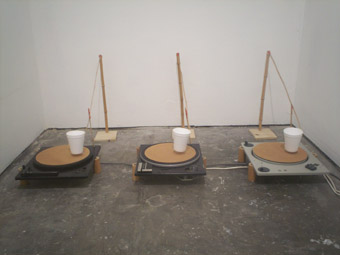
Vaucanson’s Duck, installation, Ernie Althoff
photo Robbie Avenaim
Vaucanson’s Duck, installation, Ernie Althoff
FRENCH ENGINEER AND INVENTOR JACQUES DE VAUCANSON’S THREE AUTOMATED FIGURES—THE FLUTE-PLAYER, THE DRUMMER AND THE DUCK—OF THE LATE 1730S SEEMED TO BE AS MUCH ABOUT REVEALING THE INNER WORKINGS OF LIVING CREATURES AS BEING A FORM OF ENTERTAINMENT AND SPECTACLE. THROUGH THE DUCK’S OPEN ABDOMEN ONE COULD OBSERVE THE HUNDREDS OF MOVING PARTS AS THE LIFE-SIZED REPLICA ATE AND APPEARED TO DIGEST FOOD. IN VAUCANSON’S DUCK, ERNIE ALTHOFF, ROBBIE AVENAIM AND DALE GORFINKEL APPEAR TO HAVE PRODUCED A SIMILAR ARRAY OF MOVING PARTS, HOUSED WITHIN THE THREE ROOMS (AND FOYER) OF BUS GALLERY, WHILST ALSO REVEALING, VIA A TWO-WEEK SERIES OF CONCERTS WITH SPECIAL GUESTS, THEIR OWN INTERNAL WORKINGS AND PROCESSES AS ARTISTS.
The installation component of Vaucanson’s Duck features a collection of constructed and deconstructed sound-making objects. Each is accompanied by fictitious museum-style labeling attributing all of the works to Jacques Vaucanson, with titles such as Self-portrait with Duck, Duck Egg Blues, Two Left Webbed Feet and Duck Photographed by Edweard Muybridge.
Althoff’s constructions are the first to be encountered in the foyer and the long room adjoining it. Most feature either a record player or tape player as the driving mechanism for an object that strikes various other constructions placed in its path. One in particular has three polystyrene cups held in place on three turntables by split bamboo structures. Pointed legs attached to the bases of the cups inscribe marks onto masonite discs on the record players producing a drone of rough, scraping sounds; this in contrast to the mainly percussive textures that Althoff’s other instruments produce.
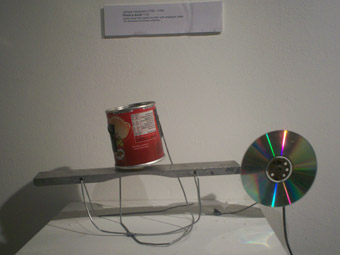
Vaucanson’s Duck, installation, Dale Gorfinkel
photo Robbie Avenaim
Vaucanson’s Duck, installation, Dale Gorfinkel
Gorfinkel also employs the polystyrene cup in his deconstruction of the vibraphone. Along with other vessels—tin cans, tennis ball canisters, plastic cups—he resonates vibraphone bars by placing motorised discs (predominantly CDs and Meccano wheels) against them. Suspended from the ceiling, or propped up on makeshift wire stands, the previously percussive instrument becomes a rich drone-making device while the vessels, swaying over the bars, shift the timbre as the sound is trapped within their small empty spaces and vibrate sympathetically.
Avenaim turns the percussive into drone by resonating the skin of a suspended kick drum with a vibrating spring attached to its lower surface. Another instrument features a suspended motorised drumstick, set off kilter by a fifty cent piece which jitters over an array of objects resting on another drum. Metal discs, rocks, bells, a spanner, wood, bamboo and a tambourine are some of the objects that the rapidly paced drumstick encounters. A motorised kick drum pedal with variable speed, a super 8mm projector with a circular saw blade instead of a film reel, and various resonating motors and objects also form some of Avenaim’s explorations into instrument making.
The performances included a selection of the instruments from the installation, additional elements and guests performing with the trio on most nights. The second night comprised a duet between Althoff and Avenaim concluding with a solo by Gorfinkel. Althoff played a pair of children’s coloured spinning bells, a wind-up frog and some of his percussive instruments while Avenaim played his haptic, jittering motorised drumstick, drone kick drum and some small motors on varying surfaces. The percussive sounds bounced about the space tingling the ears. A vibraphone with a series of Meccano wheels grinding away at the ends of vibraphone bars seemed to cue Gorfinkel to begin his solo, activating the bar instruments throughout the space and creating a dense, shimmering drone of medium to high pitched tones. He then distributed other bars, each with a fishing line handle and a mallet, to the audience who added their own percussive elements to the tones.
The final night’s performance featured a duet between Althoff and Philip Samartzis with Avenaim and Gorfinkel joining in. Althoff’s fan instrument swayed, striking a series of pewter bowls and other metal objects, while another fan knocked large sake bottles containing varying amounts of liquid. Samartzis responded with creeping fluttering tones which hovered and then moved into the foreground, transforming the space and setting Althoff’s live instruments in a new sound environment. Althoff came back with a wood and metal whirring instrument spun from an adjustable fishing line until Samartzis retreated, giving us the ‘actual’ acoustic space again. We saw more of the interior of the duck when there appeared to be a break in the communication flow as the concert’s end was announced while Avenaim and Gorfinkel were just getting started. The result was cymbals crashing into and scraping along the walls, drones from aluminium bars, fast thudding kick drum and scattering percussion creating a rock‘n’roll ending to a previously subdued yet engaging sound art performance.
Vaucanson’s Duck, sound installation by Ernie Althoff, Robbie Avenaim, Dale Gorfinkel, performances by Ernie Althoff, Robbie Avenaim, Dale Gorfinkel and guests Dave Brown, James Wilkinson, Rosalind Hall, Oren Ambarchi, Robin Fox, Erick Mitsak, Sean Baxter, Paul Wain, Graeme Leak, Rod Cooper, Anthony Pateras, Natasha Anderson, Philip Samartzis, Bus Gallery, Melbourne, Nov 9-23
RealTime issue #82 Dec-Jan 2007 pg.
© Dean Linguey; for permission to reproduce apply to realtime@realtimearts.net
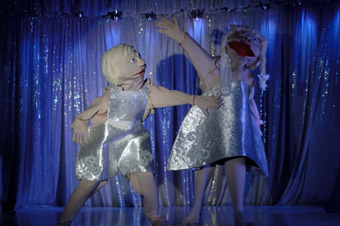
Snuff Puppets, Snuff Clubb
photo Ben Richards
Snuff Puppets, Snuff Clubb
OUR SNUFF CLUBB MC HAS IN HIS MOUTH A SET OF CHOPPERS THAT YOU WOULD NOT WISH ON YOUR WORST ENEMY. AN ARCHIPELAGO OF UNINSCRIBED TOMBSTONES TRANSFIXED IN A SLEAZY GRIN, THEY HOVER ABOVE A BOTTOM LIP THAT HAS A LIFE ALL ITS OWN.
The show begins with the reluctant appearance of Inside Outside Man, poked onstage by a woman wielding an iron probe. Initially constipated in his attempts to evolve beyond his flesh coloured costume, he eventually succeeds, confronting us with crimson muscle and flapping liver. Inside Outside Man is banished backstage. The freakshow continues with the appearance of The Great White Nanna. An incarnation of that huge breasted, maniacal madwoman residing in the haberdashery of your dreams, her hysterical cogito here finds expression in a falsetto and a head of hair self-styled with trowel and concrete. Just what the Great White Nanna sings about remains unclear. But the audience is unperturbed. We know this woman, and she has known our darkest secrets since earliest childhood.
An exploration of the perverse binds this show, and that limelight hog the Puppet Master MC is no exception. Accompanied onstage by a prancing Japanese diva, our MC answers the question we have all been asking. Stripped naked by the MC, it is revealed that six inches of masculinity lurks beneath the ditzy diva’s dress. Our MC then produces a pair of dressmaker’s scissors, reduces six inches to three, and transforms the poor tranny’s bleeding stump into an exquisitely detailed pink vulva. But wait, there’s more. Attaching his colossal nose to his groin, the MC nasal fucks this nascent vulva while the tranny is restrained in a chair. Obscenity charges pending, what makes all this palatable is the astute sense of craft from the puppet design team, and Snuff Puppet’s measured commitment to pushing bad taste to its extreme. Snuff Clubb shows that a relentless exhibition of the most base human acts can prove entertaining when removed from any abject or realistic display of that same base material.
Watching an irritating transvestite receive the John Wayne Bobbit punishment for infidelity was superseded by the Sadean ritual of the puppet pensioner sex act, live on stage. An elderly rural couple slaughter a cow and chicken, then use an extrusion machine to make 12 inch lengths of salami. Wife Beryl straps on the salty prosthesis, and fulfills Farmer Bob’s desire for back passage, extracurricular activity. While not as morbidly fascinating as genital transmutation, the above scene was played out with a sense of inevitability usually reserved for Jacobean drama. At show’s end, after being slithered over by a huge white grub, an entertained audience proffered generous and unrestrained applause for a job well done. Thoroughly perverted, this was the most indirectly disturbing act of appreciation I saw during a very funny night in the theatre.
Snuff Puppets, Snuff Clubb, direction Adam Broinowski, Andy Freer, Ian Pidd, text Lally Katz, performers Andy Freer, Adam Pierzchalski, KT Prescott, Emma Bathgate, Ryota Harada, Graeme Leak, Earl Rosas, lighting design Jenny Hector; East Brunswick Club, Melbourne, Nov 15-16
RealTime issue #82 Dec-Jan 2007 pg. online
© Tony Reck; for permission to reproduce apply to realtime@realtimearts.net
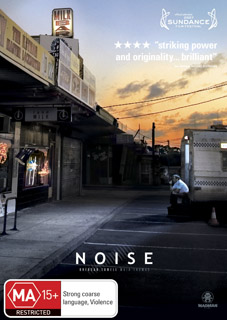
Noise
Matthew Saville’s feature film Noise on DVD
Noise is a sharply observed, suspenseful and often quietly funny account of a naive young policeman (Graham McGann played superbly by Brendan Cowell) struggling with tinnitus, incipient deafness and the fear of something worse, like a tumour. He’s unknowingly on a fateful journey amidst murder investigations in suburban Australia. With the tinnitus as their starting point, Saville, composer Bryony Marks and sound designer Emma Bortignon, have created one of the most involving, haunting and deeply integrated sound worlds in Australian cinema. See the review, page 24.
Noise, Retro Active Films, Australian distributor Madman Films
5 copies courtesy of Madman Films
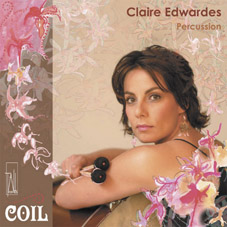
Claire Edwardes, Coil
Coil: percussionist Claire Edwardes' first solo CD
Having just seen Claire Edwardes performing with great subtlety in the bracing Song Company/Ensemble Offspring Cage Uncaged celebration and, a week before, in a superb concert in duet with guitarist Geoffrey Morris, i was eager to immerse myself in the percussionist’s first CD, titled Coil after the magical first track, composed by Gerard Brophy. My expectations of textured, nuanced and characterful playing were fully met. See page 48 for review and read Danielle Carey’s interview with Edwardes on page 14.
5 copies courtesy of Tall Poppies CDs
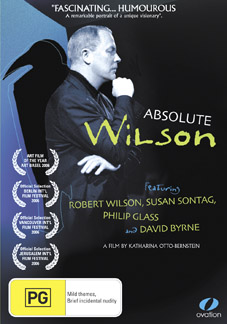
Absolute Wilson
Absolutely Wilson: the Robert Wilson
documentary on DVD
For those who missed Robert Wilson’s surprisingly animated, performative and very funny talk about his life, art and career at the 2006 Sydney Festival, Absolute Wilson (2006), a generous 105-minute documentary by Katharina Otto-Bernstein, is more than compensation. The film offers a talkative Wilson, words from Tom Waits, Susan Sontag (who saw every performance of some works), William Burroughs, David Byrne, Phillip Glass and others, along with images and tantalising footage from many shows.
See page 34.
6 copies courtesy of DV1
Nominate ONE ONLY of the above and email us at realtime@realtimearts.net with your name,
postal address and telephone number.
Please include “Giveaway” and the name of the item on the subject line.
RealTime issue #81 Oct-Nov 2007 pg. 56
© RealTime ; for permission to reproduce apply to realtime@realtimearts.net
Download it. Read it now. It could be your future. It’s election season and the Labor Party’s policy paper New Directions for the Arts has been released. It’s an intriguing document and an excitingly comprehensive one from Shadow Arts Minister, Peter Garrett. There are many promises, although ‘could’ and ‘will consider’ recur a little too often, making this a sometimes tentative policy document, but at least some very important issues have been put on the agenda. Hopefully costing will be forthcoming once the election campaign commences in earnest. The proposals are a mix of business as usual, if much improved, the regaining of ground lost in the Howard decade and in Australia Council restructurings, some new initiatives and a partial reorganisation of the arts funding chain of command. Given the Howard government’s failure to position Australia in global digital culture, new media art—“some of the most innovative and exciting work produced by artists”—is prominent in the document. It’s expressed in terms of a new generation audience of participant consumers, creative industries and Australian digital content issues.
The Australia Council for the Arts appears frequently in the document, with a commitment from Labor to maintaining the peer review process, making council and artform board appointments transparent, getting the artform board mix right (“practising artists, young people and arts entrepreneurs”), speeding up the grant process (“simplified and faster application processes”), increasing support for R&D and for risk in new work, and supporting artists “through the course of their careers” (including a new approach to the artist and social security). The Australia Council is also seen as a new home for the conservative Australian Business and Arts Foundation and “all suitable existing programs” run by the Department of Communications, Information Technology & the Arts (DCITA), doubtless including Playing Australia, a natural fit for the Council’s Market Development division.
Among other Council-related promises are the development of an Arts and Disability Strategy, a commitment “to dance and to small to medium theatre organisations”, involving a fresh look at Dance and Theatre Board reviews of recent years, and increased attention to regional arts. Council might get to police this one: “Labor will implement a program of mandatory presentations by major performing companies of work created by and featuring young and emerging Australian artists.” Under a Labor government the Australia Council looks set to grow and grow (although the wisdom of monolith-making needs some reflection). Likewise Labor approves of the current government’s AFC-FFC-Film Australia merger, although it will review the associated reforms in terms of their impact on independents. The odd exception is the promised “de-merger of the National Film and Sound Archive from the AFC.”
As well there’s the much publicised Labor Party commitment to music education; Indigenous artists, including the introduction of the resale royalty scheme; reduction of “barriers to live music performance”; a review of the effects of free trade agreements on Australian content; and the establishment of a charter requiring minimal levels of Australian content on the ABC. There’s much in the policy statement to inspire hope in the hearts of artists, producers and audiences. Mention of artists and their needs to Arts Minister Senator George Brandis and Treasurer Peter Costello, however, seems to yield only elitist dismissiveness. Under the Coalition it will be business as usual, and bad business for many artists. If Labor’s arts policy can be made fact and its vision of art as “an integral part of culture and economy” realised, then the impact of many years of neglect by successive federal governments might at last be diminished. RT
http://www.alp.org.au/media/0907/msart140.php
RealTime issue #81 Oct-Nov 2007 pg. 1
© RealTime ; for permission to reproduce apply to realtime@realtimearts.net
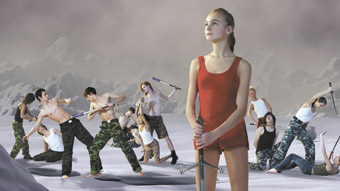
AES+F group, The Last Riot, Russian Pavilion Biennale of Venice
AS IN A FAIRYTALE, ONCE EVERY TEN YEARS THE STARS ALIGN IN EUROPA AND WITHIN A SPACE OF TWO WEEKS A SERIES OF MASSIVE EXHIBITIONS DRAWS HUGE CROWDS OF AFICIONADOS. THIS YEAR THE SPECTACLE WAS SPUN INTO A GRAND TOUR WITH THE CULTURAL EQUIVALENT OF SOCCER TRAINS LINKING VENICE, BASEL, KASSEL AND MÜNSTER INTO A PORTABLE VISUAL FEAST. BUT BEYOND THE BABBLE OF ARTSPEAK IN THE EXPRESS TRAIN DINING CARS, NO OVERARCHING CONCEPTUAL THEMATIC COULD POSSIBLY UNIFY THIS EXCESS OF CREATIVITY, UNLESS IT IS A TALE OF THE POWER OF THE MARKETPLACE.
venice, beuys & barney
Ah Venice! where the streets are paved with aqua, where advertising exclusively promotes cultural events (don’t they buy mobile phones or white-goods?) and where Australian taxpayer dollars could be seen in the form of fluorescent yellow show-bags, spreading like a cholera epidemic throughout the city (well at least for the preview days).
Elite and elitist, those Janus-faced words! In Australian parlance the word “elite” is proudly applied to sportspeople and the more dangerous elements of the armed forces. The word “elitist”, however, is reserved as a term of derision applied to the upper echelons of the art world, to serious intellectuals and occasionally to the filthy rich. As a rule of thumb it is not desirable to be one of the elite in this context (although the very wealthy are unlikely to take any heed).
The Joseph Beuys and Mathew Barney exhibition at the Peggy Guggenheim gallery, proved to be the pre-opening gala event of Venice. The Italian door bitches proved to be no push-over for the naively un-ticketed, like me, so gaining access to the event required a combination of charm, persistence and psychology.
The B+B exhibition was ploddingly curated as a series of back-to-back displays; a Beuys drawing mirroring a Barney drawing, a Beuys video facing off a Barney video and, of course, Beuys Fat and Barney Fat smeared alongside one another in what seemed a concussively unsubtle attempt at transubstantiation. The spirit of Beuys decanted into the veins of Barney; an undisguised act of deification; or simply smart market re-badging?
Naturally there are parallels between the two artists, each equally possessed of an Asperger-like obsession with ‘self’ coupled with a savvy ‘showman’ persona, eager to manipulate the media. But how do B+B fit into the elite and elitist schema?
As it turns out both could claim to be elite from a sporting perspective, each incorporating physical challenge as part of their creative practice. Barney for instance amalgamates abseiling with mark making and his semi-athletic, semi-balletic performances that have seen him scale the ramparts of the NYC Guggenheim (see page 10 for Barney’s performance in Il Tempo del Destino).
Beuys with typical Germanic pragmatism went in for noses bloodied in boxing matches for Direct Democracy, and how can one be an elitist with a bleeding snout?
Recall the image of Beuys cradling a dead hare, engaged in a deep discussion about contemporary art, claiming that despite being deceased, the hare would have a better natural comprehension that an elitist academic or art critic.
This is the time to reveal the skeleton in my cupboard—I must confess to being a Beuys Scout as a young and earnest art student, even meeting him on a couple of occasions, which only amplified my total awe of his practice and its ethic of RealPolitik but, equally so, of his persona. Beuys was amongst the vanguard of artists who re-established a European cultural agenda, reclaiming it from the thrall of (CIA backed) American abstract art that had dominated museums on the continent throughout the 1960s. One can only suppose that the Guggenheim’s B&B voodoo is an insidious form of neo-colonialism now operating as a globalised cultural industry.
What is conveniently forgotten in the Guggenheim’s attempted transaction is that despite being a mercurial shape shifter, Beuys held a passion for social democracy, for a cultural openness and for art that operated simultaneously in the mundane world and at a deeper spiritual level. This attempt to bring into close association the saintly relics of Beuys (now entirely dissociated from his cultural politics) with the Hollywood scale indulgences of Mathew Barney, illustrates how dumb the übermench of the art world can be, or at least how dumb they think we all are.
venice: in the pavilions
La Russie, Douze points…La France, Dix points…La Mexique, Huit points…
There is a certain irony in the faux cultural identity associated with the individual national pavilions when placed in the context of a powerfully globalised (or at least internationalised) cultural economy. Interestingly enough the coalition of the willing offered rather thin pickings at Venice, whilst in true EuroVision style the non-aligned nations delivered.
Douze points: inside the Russian Pavilion, Wagner’s Flying Dutchman announced an animated, post-apocalyptic cyber-epic, The Last Riot (AES+F group), in which androgynously beautiful but heavily armed teenagers suggest the dissolution of collective Utopias under the fracturing pressure of Global Capital.
The dystopia of The Last Riot was sharply contrasted by the Kabakov’s beautiful installation at the Arsenale where a model utopian city recouped the visionary architecture of 1920s Soviet culture, an interesting foil to the generation currently witnessing the economic chaos and ideological vacuum of a Russia unbound and directionless.
Dix Points: the French Pavilion housed a massive and sophisticated project by Sophie Calle. Unlike many grandstand attempts at Venice, Calle never de-rails into the trite or formulaic (as is the fate of so much successful art!). She is possessed of an emotional focus and obsessive attention to detail that allows her to take a simple, but emotionally charged text (in this case an email) and submit it to a process of collective inquisition that she subsequently manages and produces as a communal response. The result is a combination of Calle’s own creative agenda but also an embrace (and confidence in) a plural voice. The role of ego here is sublimated into one of social responsibility.
Huit Points: some of the most interesting exhibitions in Venice kept away from the zoo of the Giardini and the Arsenale, preferring to be tucked away in elegantly decaying palazzos. The Mexican Pavilion housed a series of mature and engaging interactive works by Rafael Lozano-Hemmer which stood out as some of the only interactive new media works in what was otherwise a very conservative curatorial vision of contemporary practice, and because they functioned at a strongly visceral level.
Hemmer’s Pulse Room contains a lectern-like object sporting two hand-held sensors. At eye level is a single low wattage filament lamp. Each participant stands for a few seconds breathing calmly while staring at the lamp which soon begins to pulse with the heart-beat of the visitor. A friendly attendant then ‘migrates’ the pulse into the ceiling space that supports hundreds of identical lamps, each twinkling with the heart-beats of previous visitors. It is not often that such simple technology can have such an emotional effect, but Pulse Room gives each participant the gift of ascension into a temporary communal heaven.
L’Australie…Daniel von Sturmer’s attempt to transform Cox’s beach-house into a plausible exhibition space functioned well enough in an architectonic way, with its Ikea-smooth mobius strip of plywood snaking through the space; the inclusion of video vignettes on this support was however unproductive and underwhelming.
video hell
I’m beginning to think that the ubiquitous and seemingly mandatory presence of video in art festivals is a conspiratorial form of low-level torture, as yet unrecognised by human rights groups. In this context video consistently fails to adequately differentiate itself from familiar televisual and cinematic formats and formulae. In the rare case that video makes a substantial claim to otherness (say Viola or Ousler) they still short circuit the process of contemplation.
From the perspective of a card-carrying videophobe there are two factors that combine to undermine videographic practice as a truly engaging medium rather than one that primarily signals an economy of informatics and infotainment. The Pavlovian training that most people receive in screen-culture from early childhood generates a deeply ingrained response to video; in McLuhan’s words, The Medium is the Message (or was it Massage?); by adulthood, content is hardly the issue, the format itself is hypnotic.
Notwithstanding the above, the fundamental modality by which we engage with architectural space and sculptural form is radically different and essentially incommensurate with the manner of engaging with the video screen. The former demands a dynamic, spatial engagement that draws upon kinaesthetic and haptic processing, while the latter demands an unblinking, static focus; there are scant examples of work that accomplish a fusion of these modalities.
Ciao Venezia — and so onto the Express Train for an encounter with market forces!
basel bypass
Art fairs are of course, not to be taken seriously—that would plunge one into terminal despair! They are however extremely instructive in the fickle ways of the marketplace and its grip on many aspects of creative production. Adopting the morphology of an Easter show mixed with a rambling American art school graduation exhibition, the Basel Art Fair was all booths, business cards and cash-flow.
The essence of the Basel Fair is ironically exemplified by a work which was not on show but which was on the tip of every dealer’s tongue—Damien Hirst’s For the Love of God, a human skull in platinum and encrusted with 8,601 diamonds, conservatively priced at US $100 million. The terms of Hirst’s Mephistophelean contract are such that while it offers him unlimited fiscal success it progressively robs him of the capacity to be meaningful, stripping him even of irony.
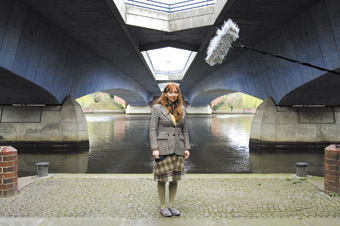
Susan Philipsz, The Lost Reflection, Munster Skulptur Projekt
photo Roman Mensing
Susan Philipsz, The Lost Reflection, Munster Skulptur Projekt
kassel and münster
A tale of two cities: both pounded into oblivion by the close of WWII due to their enthusiasm for Kristallnacht and their capacity to produce panzers. Kassel rebuilt in a hurried Sovietesque reconstruction style, all concrete and rectilinear; Münster choosing a Disneyland simulacra of its medieval past, but both cities adopting art as the focus for their long-term rehabilitation.
As a city venue Kassel has visibly matured over the past decade, the pizza bars and ice-cream parlours now replaced by a host of good restaurants. The city boasts some wonderful open spaces and fantastic public transport; less can be said for Documenta itself, however, which over the past two incarnations has lost the plot. In 1997 the combined Documenta and Innenseit exhibitions pumped the city’s architectural and public spaces full of ambitious, high production value projects, setting a benchmark that the subsequent festival in 2003 failed to match in its rather literal translation of Documenta into documents and documentaries! The current offering is totally anaemic by comparison, the curatorial team pouring energy into devising a typically Germanic polemic schema that they subsequently find impossible to embody in practical terms. The result is a rather perplexing assortment of non-sequiturs stranded in a matrix of curatorial idiosyncracies: irrelevant colour schemes, silly curtains, very low lighting and a penchant for hanging as many large Juan Davila paintings as possible at each of the festival venues, much to the horror of many European critics who found them gauche and ugly, and who am I to disagree? Davila once named a painting As Stupid as a Painter; after Documenta 2007 we could maybe stretch this to As Conceited as a Curator!
The good thing about the Skulptur Projekte Münster is that it is an outdoor event best seen from the saddle of a bicycle so even if the art is crap one cannot avoid having a pleasant time zooming around the cobbled streets and old city ramparts. At its best the work in Münster engages with the architectural and historical fabric of the city in a critically reflexive manner which was certainly the case for the last incarnation in 1997. Again however, the German curatorial team fumbled the ball, delivering the current festival with fewer than half the works shown last time and most of these less directly engaged with an articulation of the urban cultural fabric. Many of the best works are however retained in the city, accumulating as a permanent sculpture park.
One exemplary project is a site specific installation by Rebecca Horn that places small mechanical hammers inside an old fortified tower, once used by the Nazis as a meeting place and by the SS as a torture chamber. The hammers are slowly and quietly chipping away at the decaying walls of the bastion and ipso facto into the difficult history of the Fatherland. Ten years ago this project was flanked by an equally impressive work by Hans Haacke. Morphologically similar to the tower, it took the form of a vertical cylinder built from scaffold planks that contained a fairground carousel. Squinting between the planks one could just see the painted horses merrily dancing by to the fair-ground organ refrain of “Deutschland Über Alles.” Further along the promenade is a German war memorial, once again in the shape of a turret, resonating with both projects.
This year it was hard not to be amused by Mike Kelly’s animal Petting Zoo, we are all suckers for donkeys after all. One could be charmed by Lost Reflections, Suzan Philipsz’ haunting sonic installation in which the barcarole from Offenbach’s Tales of Hoffmann drifted across the lake, or engaged by the humanist discussions in the marquee that housed Beautiful City, a social sculpture produced by Maria Park. However the perception by many visitors that the level of ambition and quality are declining makes me nervous.
kiefer in paris
Back on the train to Paris to see Anselm Kiefer’s Falling Stars, the first work in the aptly named Monumenta series at Paris’ Grand Palais. In German, Kiefer may be referred to as a ‘Malerfürst’, a term that compresses painter with duke and this is more than appropriate when regarding his Rabelaisian scale exhibition at the Grande Palais. The Palais contains a series of shattered concrete towers, entwined with iron forged sunflowers as well as a series of hangars, containing arrays of massive paintings, reliefs and free standing sculptures. A tour de force, speaking not only of the creative impulse, but flaunting the sheer economic power that the artist commands.
It is the issue of scale, in a variety of guises that strikes a chord. In the first instance the very concept of hosting a solo exhibition in a structure designed to house entire nineteenth century international trade fairs proposes an eccentric vision of how art operates, anachronistically valorising heroic actions and epic forms.
From a personal perspective Kiefer’s work contains interesting scalar contradictions in that the conceptual source is frequently of an intimate and indeed scale-less nature, for example an extract from a poem or text such as Voyage au bout de la nuit by Céline, but which is then manifest at Wagnerian proportions in a surfeit of production.
The second scalar transformation concerns the artist’s touch. Kiefer’s oeuvre is, above all else, tactile and organic, bearing the mark of the skilful hand. At the same time it is not only heroic in physical scale but also appears to multiply in a serial, one might say industrial, scale production. The modest Kiefer show at the AGNSW recently was in fact a small clone of the gargantuan Paris exhibition, palm tree and all. The touch of the hand is therefore deceptive, and may well not be Kiefer’s!
Anselm Kiefer has perhaps mastered the art of eating his cake and keeping it too! Although I’m pretty sure that he is obliged to share it around with the army of elves that he obviously retains in the underground tunnels of his studio in France. I like to imagine him spending time each evening before he retires, laying out the snacks for his willing helpers.
52nd Biennale of Venice, June 10-Sept 5; Basel Art Fair, June 12-17; Documenta 12, Kassel, June 6-Sept 23; Skulptur Projekte Münster 07, Sept 22-30; Monumenta 2007, Anselm Kiefer, Falling Stars, Grand Palais, Paris, opened May 30
See page 25 for Zanny Begg’s report on Hito Steyerl’s Documenta screenings
RealTime issue #81 Oct-Nov 2007 pg. 2,3
© Nigel Helyer; for permission to reproduce apply to realtime@realtimearts.net
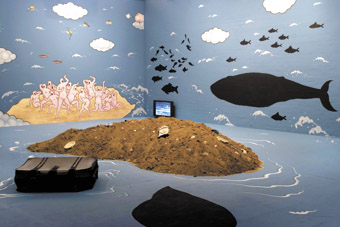
Rising Sea Level, Guan Wei
photo Jennifer Leahey;
Rising Sea Level, Guan Wei
CAMPBELLTOWN ART CENTRE’S NEWS FROM ISLANDS IS AN EXHIBITION OF A SCALE RARELY SEEN OUTSIDE OF AUSTRALIAN CAPITAL CITIES AND IS EVIDENCE NOT ONLY OF THE BURGEONING ARTS SCENE IN WESTERN SYDNEY BUT OF THE WISE INVESTMENT BY NSW STATE AND LOCAL GOVERNMENTS IN MULTI-PURPOSE ARTS CENTRES IN THE REGION. A WONDERFUL OPENING EVENT COMBINED AN ABORIGINAL SMOKING CEREMONY, TRADITIONAL DANCE AND CONTEMPORARY AUDIO-VISUAL SPECTACLE, ALONG WITH A PREVIEW OF AN ENGAGING, IMMERSIVE EXHIBITION OF 20 ARTWORKS IN THE CENTRE’S GALLERY SPACES, INCLUDING NEW WORKS AND COMMISSIONS.
As we arrived we witnessed New Zealand born Michel Tuffery’s massive projection mix, First Contact, onto the facade of the centre juxtaposing traditional South Pacific performances, from found silent film footage, and their contemporary equivalents. Tuffery’s dynamic vision was melded with iconic patterns and a modern oscilloscopic wave, evoking both ocean and new technology. It seemed to aptly match one of the key questions Aaron Seeto posed in his curator’s statement: “How are ideas of ‘locality’ reinvented within…larger social and geopolitical frameworks which swirl around us like water surrounding islands.”
The large opening night crowd comprised local and visiting artists from around New South Wales and the western Pacific rim along with Campbelltown residents, many of them part of the huge South Pacific diaspora living in the region. There was a palpable sense of occasion and celebration with the smoking ceremony conducted by Uncle Ivan Wellington segueing into Mayor Mollie Thomas’ speech to launch News from Islands.
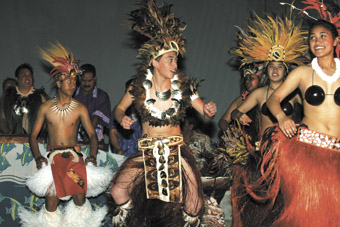
Echoes of Polynesia dancers
Haka director Paraone Taitin and members of the South West Youth Peer Education program presented the Haka Peruperu (part of Reuben Paterson’s new work Te Puu Oa: the first step in the history of walking). More welcoming came in the form of a spoken and sung Maori powhiri, with the female participants displaying powerful voices. Traditional dance from the Campbelltown-based Cook Islander group, Echoes of Polynesia, successive groups of children, adolescents and adults, was performed with grace and vigour in brightly coloured costumes and high, feathered headdresses. It was here that we saw and felt the full effect of Tuffery’s First Contact as images of the live performers mingled with their forbears.
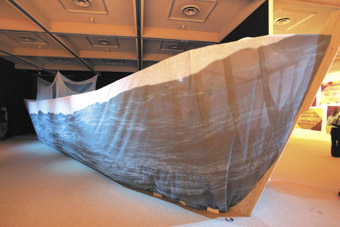
The Boat (2001), Dacchi Dang
Inside the centre Aaron Seeto has presented works both traditional (exquisitely crafted clothing, shields, bags) and contemporary (photography, video, traditional clothing wittily reworked with modern synthetics, and a range of installations). The large scale walk-in installations (see the photographs on this page) by Guan Wei (a painted oceanscape room with cultural and political dimensions) and Dacchi Dang (a fabric walled refugee boat gathering images from the past) are particularly engaging, while Simryn Gill offers Magrittean wit and Michael Mel provocation in the video of his performance, Am I Black or White (Mel performed another work in person on the next day). It’s a very satisfying exhibition, constantly intriguing both from work to work and in its overall cultural perspective, with contributions by artists from Samoa, Tonga, Papua New Guinea, Indonesia, China, Vietnam, New Zealand and Australia.
Thirteen of the artists have been in-residence during the program, there have been artist and curator talks, a related Campbelltown Community Project and there’s an invaluable, handsomely designed accompanying 120-page book of essays and interviews edited by Claire Armstrong.
News from Islands runs to almost the end of October, offering an opportunity to visit Sydney’s south-west to see an impressive exhibition at an innovative regional gallery now making its mark on the Australian cultural landscape. RT
News from Islands, curator Aaron Seeto, Campbelltown Arts Centre, Sept 1-Oct 28
RealTime issue #81 Oct-Nov 2007 pg. 4
© Keith Gallasch; for permission to reproduce apply to realtime@realtimearts.net
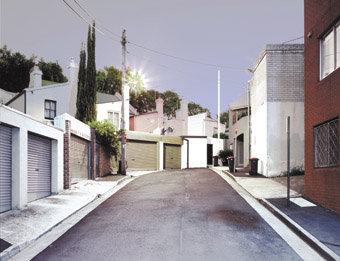
Verona (2007), Lux Loci,
Thomas Weinberger
courtesy of thirtysevendegrees – Contemporary Fine Art Gallery, Sydney
Verona (2007), Lux Loci,
Thomas Weinberger
AN AURA OF WEIRDNESS HOVERS OVER ACP EXHIBITIONS, EMANATING FROM EVOCATIONS OF SURREAL WORLDS, LATERAL DOCUMENTATION OF THE OUTER LIMITS OF SOCIAL LIFE AND THE EVERYDAY MADE STRANGE, AN ENLIGHTENING UNEASINESS COMPOUNDED BY THE GALLERY’S STRATEGY OF CREATING IMMERSIVE INSTALLATIONS OF PHOTOGRAPHIC AND VIDEO WORKS. THE NEW GERMAN PHOTOMEDIA EXHIBITION IS NO EXCEPTION.
In the plain white front room, the walls are lined with architect-cum-photographer Thomas Weinberger’s Lux Loci—unpeopled inner city Sydney suburban street scenes, seemingly shot at night, but glowing eerily with something of that odd neutrality, beyond colour terms, of the sky at the moment between the blue of day and the black of night. Some of these streets are mine and I find myself seeing them, literally, in a new light—as not quiet real, almost as if painted, cleansed of superfluity and oddly transcendent, the streetlights’ rays the epitome of the image’s glow. Apparently Weinberger achieves this defamiliarisation by merging long day and night-time exposures of the same site. The effect is unnerving, especially in the largest of the photographs, seen above, yielding a rich if indeterminate suggestiveness.
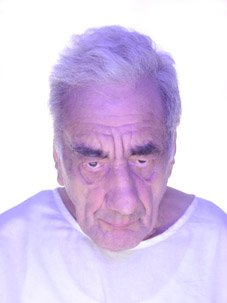
No Cure, 2006, production still
Boris Eldagsen
No Cure, 2006, production still
In the darkened main gallery, you find yourself surrounded by the four huge screens of Boris Eldagsen’s No Cure on which are projected four elderly figures in white hospital gowns, their deeply etched physiognomies tinged with a blue that might be bleeding from a medical scanner. These giants speak in turn, sadly, anxiously, even angrily, as if to you, or across the space to each other, their German recital of bleak song lyrics from The Cure subtitled in English on the opposite screen and counterpointed with Australian composer David Chisholm’s subterranean murmuring of Siegfried’s funeral march. This stillness of the subjects makes this work portraiture, their movements and utterances make it drama.
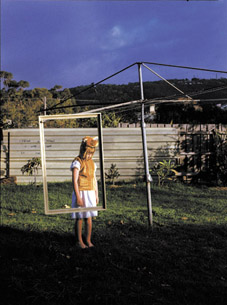
Natascha Stellmach, Good Girl #3,
courtesy ACP
Natascha Stellmach, Good Girl #3,
Nearby there’s an old white wardrobe. You open it, enter and find yourself in the ACP’s back gallery and, like Alice, somewhere even stranger. On the wall in front of you are roadkill frog skins and a small cut-out photo of a falling acrobat, the bodies all curiously alike; behind you is a doll in a kangaroo suit, the words “Nazi Girl” emblazoned on her t-shirted chest; and in the room itself a bed under which a television set glows with scattered raw images, among them the slaughter of a fowl. On a tree stump sits a copy of the artist’s book, The Book of Back (the title too of the installation) in which a family history is bizarrely (and attractively) documented with fact, fantasy, collage and family photographs. This bedroom is a haunted hearth, its book a bubbling cauldron of the unconscious. The maker, Natascha Stellmach, was born in Germany and lives and works in Australia.
The heightened detail in the imagery of Weinberger and Eldagsen and their mutual, unearthly, transforming radiance is countered by the raw physicality of Stellmach’s objects and her room’s threatening darkness; but all three collectively conjure other states of being that take us into and beyond ourselves. It’s quite an experience. New German Photomedia was part of the Goethe Institut’s innovative gerMANY FACES australia festival.
gerMANY FACES australia, New German Photomedia, Australian Centre for Photography, Aug 24-Sept 29
See also a review of Faust/Murnau on page 26.
RealTime issue #81 Oct-Nov 2007 pg. 5
© Keith Gallasch; for permission to reproduce apply to realtime@realtimearts.net
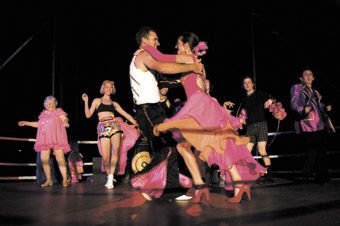
You Dance Funny, Tracks
photo Peter Eve
You Dance Funny, Tracks
THE TOWN WAS ONLY JUST RECOVERING FROM THE EXCITEMENT OF OUR NICOLE AND HER KEITH ACTUALLY DRINKING COFFEE IN THE LOCAL COFFEE PALACE, THE ROMA BAR, CAUSING A STAMPEDE OF PAPARAZZI OUTSIDE AND THE SUBSEQUENT DESIGNATION OF THE FRONT CORNER TABLE AS A SACRED SITE TO BE VIEWED AND PHOTOGRAPHED BY PILGRIMS IN SEARCH OF WHAT NICOLE WAS HAVING. PERHAPS ARTIST CHAYNI HENRY WHO MAKES RETABLO STYLE PAINTINGS OF ORDINARY MOMENTS IN HER OWN LIFE COULD BE COMMISSIONED TO CREATE THE NICOLE SHRINE. THE FEBRILE FLURRY SURROUNDING THE FILM PEOPLE SEGUED NICELY INTO AUGUST FESTIVAL TIME.
And have we got festivals and events for you! The Darwin Cup, followed by Garma, then the Telstra Aboriginal Art Award and Art Fair, and the Darwin Festival itself; as the glossy copy from travelNT.com says, “vibraNT, enchaNTment, eNTertainment”, but not a word about iNTervention. On the waterfront, relentless development proceeds, turning the place from a piece of paradise into yet another condominium capital in the north, Gold Coast mirages and gallerias dependent on air conditioning to celebrate what the locals now tout as their unparalleled lifestyle in their own schmick mag, Resident, or should that be resideNT. “Down disconsolate streets” indeed in a town that seems to have forgotten its history, its uniqueness, and which is in danger of perjuring its soul in the pursuit of aspirational lifestyles. Was it ever thus—always waiting to be discovered?
guan wei
Culture Trackers at 24HR Art showed the results of a two-week artists’ camp in Arnhem Land at Injalak bringing together local Indigenous artists and a group of non-Territorian, non-indigenous artists for a potential exchange. On the evidence presented not a lot got exchanged and most of the artists retreated to familiar territory, except for the marvelous Guan Wei in his A Mysterious Land series. Wei places himself smack in the middle of the work as a plump, naked pink figure peering shyly out from behind trees or termite mounds, or scurrying up a likely branch to escape from crocodiles or to slyly observe the natives dancing. In black ink on Chinese scrolls, he exquisitely details images like paper cutouts of every plant and creature encountered in “the forest” or in an entire billabong. These run over 19 delicately drawn panels, all done in situ, one panel at a time .
Meanwhile the festival thrives under balmy night skies down in the Botanical Gardens. You can eat Jimmy Shu’s raita, roti and rendang under the golden paper lanterns strung in the big trees, watch Indigenous dance in the Starshell every sunset, and even look at art. This year the palm tree gallery, Galuku, includes Yolgnu barks and an installation of larritj (poles) as well as the usual range of framed prints. The flow on from Garma includes Sing Sing, featuring the master songman George Telek with David Bridie, and introduced the Morning Star marvel, Hein Arumisore, dancer extraordinaire in concert with Ari Ingram and Darwin’s PNG community choir. At the Supreme Court, the Gyuto Monks are back, installed, chanting and scraping fine coloured sands to make delicate ephemeral art, and sharing sumptuous barbeques every evening courtesy of their sponsor, Fannie Bay Butchers.
constance drinkwater
The sunsets over the silver sea are redder than ever and the markets at Mindil beach and Parap as frantic as ever. Territorians all seem to have adapted very well to the vicissitudes of the tropics, and Darwin is finally a destination as well as the gateway to Kakadu. The prospects are good and the real estate is booming—unimaginable a hundred years ago on the eve of Federation to the desperate denizens of Stephen Carleton’s creation, the northern outpost of Somerset. Constance Drinkwater and the Final Days of Somerset is a gothic, possibly baroque melodrama that references Capricornia and Coonardoo, and is laced with deadly white powder: strychnine in the damper, arsenic in the scones. The surviving matriarch, Constance Drinkwater, maintains that the English language recollected and practiced amidst increasing unease and disease is her only defence, but it is not enough. A deadly mélange of racial and sexual politics, Darwinian science and sectarian utopianism, Federalism and White Australia fuels the drama and fans the hysteria. The damaged centre resides in her last two surviving daughters, played with compelling intensity by Ella Watson-Russell and Daniel Cunningham as Fortitude and Hope, no less, who may or may not be turning into shrieking curlews foretelling an horrific future as they attempt to outwit the plague that has engulfed Somerset. In a joint venture between Darwin Theatre Company and Cairns Jute theatre, Merrilee Mills has directed a good enough ensemble cast but Carleton’s apocalyptic vision was compromised by unimaginative staging, in particular indifferent lighting and a lacklustre and inconsistent soundscape.
At Browns Mart, The Theatre Practice, a Singapore-based company, presented Play Play. Touted as physical theatre at its most whimsical from a multi-lingual company that celebrates diversity, it failed on all counts. Serving up inane and glorified mime with a plethora of cute sounds created by the four performers in the style of Tinky Winky from the Teletubbies, and staged within a pristine Brooksian white cube by white clad performers, the production lacked insight or élan. Others enjoyed it greatly, but clearly my inner child had been put down for the evening.
the tangled garden
By contrast, The Tangled Garden made by Sydney’s Sidetrack Theatre in collaboration with Komunitas CCL from Bandung, Indonesia, is genuinely whimsical and an utterly beguiling depiction of Sundanese life through the prism of high German romanticism, a genuine celebration of diversity. In part based on Thomas Mann’s story, The Transposed Heads, the intense friendship and concomitant rivalry of the male protagonists propelling the drama and the tragedy is pure blutbruderschaft, and as powerful a myth as any thrown up by the Sundanese. While the music, lighting and mise en scene is captivating the narrative meanders and you begin to wonder if it will come together, but then suddenly it does by way of the galvanizing performance of Gusjur Mahesa. He is the journeyman actor who takes on many roles including an absolutely startling rooster, but to all of these small parts he brings finely observed textures and subtly expressed feeling.
you dance funny
Tracks Dance Company rarely disappoints and You Dance Funny is no exception. Concept, writing and directing is shared by David McMicken and Gail Evans. Evans’ script is biting, political and very funny. McMicken has made dancers from actors and made them dance so good it’s funny. Set in a boxing ring outdoors and presided over by the Strictly Salsa Infernal Couple, Gail Evans and Yoris Wilson, it’s a mixture of carnival tent show and reality television, without either tent or television. La Famiglia Del’Inferno, a Pirandelloesque troupe of dancers, auditions local contenders to fill the vacancy in their troupe. They engage the audience at every level, teach them en masse to dance various hilarious routines and provide points of identification for everyone from Grey Nomad nostalgia, to martial arts, rave party glow girls and everything in between.
Each segment is mercilessly judged by The Producer, Kin Leong in Iron Chef style, and the matriarch nonna, Crena Hemmings, who does a great line in droll delivery reminiscent of Graham Kennedy. You Dance Funny abounds with loving local references and acerbic national and global power points. Everyone dances, every dance style and fad is lampooned, no one gets hurt and everyone laughs. It is profoundly inclusive and sharply critical. No mean feat to dance funny and say something as well. In You Dance Funny, Darwin delivered a unique eveNT, and entertainmeNT.
Darwin Festival, Aug 9-26
For more on the Darwin Festival see page 40 for a report on the Interpositions live art program and go to www.realtimearts.net for a review of Red Dust Theatre’s Barracking
RealTime issue #81 Oct-Nov 2007 pg. 6
© Suzanne Spunner; for permission to reproduce apply to realtime@realtimearts.net
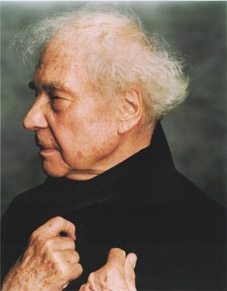
Merce Cunningham
photo Mark Seliger
Merce Cunningham
IN HIS EIGHTY-EIGHTH YEAR OF ‘FACTUAL’ ACTIVITY, MERCE CUNNINGHAM, SLIGHT AS ALWAYS, IF NOW PHYSICALLY FRAIL, CONTINUES TO EXERT A TOWERING INFLUENCE ON THE ART OF DANCE. HIS IS A MARVELLOUS LIFE THAT REFUSES TO STOP MOVING PERHAPS BECAUSE ABOVE ALL HE HIMSELF MARVELS OVER THE INFINITE POSSIBILITIES OF DISCOVERY THAT HUMAN LIFE CAN GIVE. CUNNINGHAM IS SAID TO BE ONE OF THOSE ARTISTS WHO CONCERN THEMSELVES WITH THE PROFOUND MYSTERIES OF EVERYDAY-NESS, OF THE PROFUNDITY OF THIS ACT OF MOVEMENT WHICH HE FONDLY REFERS TO AS A ‘FACT.’ ACT AND FACT FIGURE IN HIS PRONOUNCEMENTS AS IDEAS THAT RUN DEEP IN SPITE OF HIS INSISTENCE ON THEIR SIMPLICITY. IN 1952, THIS YOUNG MAN’S STATEMENT ON “SPACE, TIME AND THE DANCE” REVEALS SOMETHING OF THE INTRICATE PATTERN OF CONTRADICTIONS THAT A CONCEPTUAL FACT MIGHT REPRESENT:
For me, it seems enough that dancing is a spiritual exercise in physical form, and that what is seen, is what it is. And I do not believe it is possible to be ‘too simple.’ What the dancer does is the most realistic of all possible things, and to pretend that a man standing on a hill could be doing everything except standing is simply to divorce—divorce from life, from the sun coming up and going down, from clouds in front of the sun, from that rain that comes from the clouds and sends you into the drugstore for a cup of coffee, from each thing that succeeds each thing. Dancing is a visible action of life.
That ‘action of life’ became astoundingly visible when I scurried to catch the Cunningham Company’s free performance event at Cottesloe Beach in 2001. The traffic jam, that I imagined was an infuriating encounter with Perth’s peak-hour, proved to be crowds pouring down to the same beach appointment as mine. They converged, as I discovered breathless and all-too-late, with their chickens and champagne, with the kids’ swimsuits, balls and bats, to witness or more acutely to become part of an experience which fused dance and sand, sunset and gossip in an unrepeatable combination. As I stood on the crowd’s edge, the dancers moved, mere specks on a manifold horizon, sweeping together the Indian Ocean, an exquisite interplay of cloud and reclining light, and people chatting, swimming and gnawing on chicken bones, I had a glimpse of what Cunningham conceived as an event. It had everything to do with fact and, at the same time, exposed the spun wheel of chance, of ordinary things coming together with extraordinary force. Sensuously, I was stunned. The tiny image of the man feted at the end of the performance on the constructed stage evaded many in the crowd. That too seemed an apt expression of Cunningham’s ability to provoke a coalescence of life and art and, then, eloquently exit the spectacle.
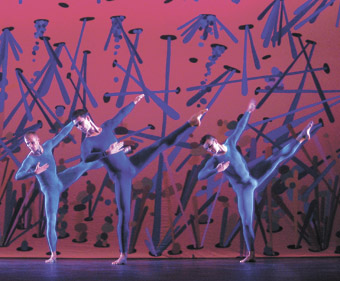
Merce Cunningham’s eyeSpace
photo Anna Finke
Merce Cunningham’s eyeSpace
Chance, factuality, spirituality and wonder were all there in time and space, breaking effortlessly in and out of complexity. Dance performance achieved in a half hour or so at Cottesloe Beach more significance than ever before, moreso even than in the subsequent and ‘marvellous’ theatre performances of the company. Coexistence within the disparate ecology resonated with such lucidity that it was impossible not to ponder John Cage’s explanation of the Zen Buddhist perspective wherein arbitrariness is but another expression of interconnectivity. In the after-glow, movement, sound and design ebbed and flowed like the unfathomable ocean.
But who is Merce Cunningham and why should the Melbourne International Arts Festival celebrate him and his associates in a comprehensive residency programme? Bluntly, Cunningham and his long term partnership with John Cage established a precedent of artists who think. While this statement might appear counter-intuitive to current practitioners jealously guarding their licence to embody relationships with the world, Cunningham and Cage along with the constellation of artists they gathered into their orbit over the years, interrogated, analysed and proceeded to imagine what making dance, music and design might autonomously and democratically be. Though Cunningham protests its matter-of-factness, the approach exploded performance conventions. Influenced in turn by artists like Marcel Duchamp and James Joyce, by Cage’s immersion in Zen, by Cunningham’s affinity with Einstein’s pronouncements on the time-space continuum, by the growing affluence of the US in postwar conditions, the partnership provoked a quiet and unstoppable revolution.
Their radical point of departure concerns their belief in the innate expressivity of movement, sound and design. Moreover, echoing Duchamp’s ‘ready-mades’, any action or noise could contribute to this expressivity if so composed within the art work. Lines, jumps and squeaks are, simply in their Joycean ‘thing-ness,’ without any recourse to external narratives or overlays, expressive. In order to realise this unadorned expressivity, choreographer, composer and designer would agree upon the duration of the work and then disperse to action their constructions separately. The process created performances whereby relations between elements operating as free agents were dependent on what spectators might detect as meaningful in their coexistence. To further eliminate habitual instincts and preferences, Cunningham’s choreographic processes gravitated around manipulating movement phrases by throwing dice or the I-Ching sticks to determine how units of the phrases were re-built by whom and where and when. The effect of stripping away personal feelings enabled Cunningham to paint the stage as if a canvas: “Imitating the way nature makes a space and puts lots of things into it, heavy and light, little and big, all unrelated, yet each affecting all the others.” Significantly, as well as predicting our current preoccupations with human beings as but one component in complex environmental systems, the compositional methods also foreground process over product, a motivating factor of subsequent postmodern approaches to art.
With Cage’s interest in technological interventions into sound production, it was inevitable that Cunningham would harness film/video and, later, computer programs into his projects. The camera became another dancer through which Cunningham could play with Einstein’s observation that there are no fixed points in space, shifting expectations of focus and increasing relationship variations between things. The LifeForms computer software program likewise provided him with unpredictable wire figures whose shapes and transitions proved ideal partners in his objective screening of choice. Together with digital artists Paul Kaiser and Shelley Eshkar, Cunningham extended the computer’s transformational capacities into giant body sketches and graphic explosions which project into the spatial cosmos of BIPED (1999). If time has proven reassuringly constant throughout Cunningham’s oeuvre, space has been elastic, the tensile stretches encompassing black-box and proscenium arch, arena and now the promised sightlines of Federation Square.
Central to the conceptual unravelling of the Cunningham-Cage partnership lies the collaborative act, the one theatrical premise which, though given alternative parameters, has been reinforced rather than challenged in their life’s work. A host of the most celebrated names in North American art have collaborated with Cunningham across the 60-year span of his company. These musicians, designers, digital artists and filmmakers of past and present—Robert Rauschenberg, Jasper Johns, Andy Warhol, Gavin Bryars, David Behrman, Takehisa Kosugi, Charles Atlas, Elliot Caplan and Nam June Paik constitute a random selection from the impossibly long list—have each left imprints in the traceries of relationships that propel the spatio-temporal imagination and the delightful, if deceptive, ‘fact’ of Cunningham. Everything and everyone are likely to turn up in a Cunningham exposition of the art of time-space. The Melbourne residency is a testament to the collaborative inventiveness and reinventions of this most thoughtful of artists: to the significance of his steadfast belief in the power of discovery within the ceaseless dance of our planet.
Cunningham quotations from David Vaughan’s Merce Cunningham: Fifty Years, Aperture, New York, 1997
For program details of Cunningham performances and related Melbourne International Art Festival events, go to www.melbournefestival.com.au
RealTime issue #81 Oct-Nov 2007 pg. 8
© Maggi Phillips; for permission to reproduce apply to realtime@realtimearts.net
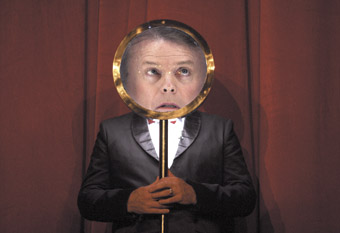
Philippe Parreno, Il Tempo del Postino
photo Joel Fildes
Philippe Parreno, Il Tempo del Postino
ON THE STAGE OF THE MANCHESTER OPERA THEATRE, CO-CURATORS HANS ULRICH OBRIST AND PHILLIPE PARRENO CHALLENGE LARGE AUDIENCES IN IL TEMPO DEL POSTINO; THREE HOURS OF REFLECTIVE AND EDGE OF YOUR SEAT PERFORMANCE FROM 14 OF THE WORLD’S LEADING VISUAL ARTISTS, TRANSFORMING GALLERY INTO THEATRE. CHEN SHI-ZHENG AND COLLABORATORS RADICALLY REWRITE CHINESE OPERA IN MONKEY: JOURNEY TO THE WEST, A SPECTACULAR ENGAGEMENT WITH RECENT CHINESE HISTORY AND EMERGING YOUTH CULTURE. ON A MUCH SMALLER SCALE, INTERIORS TAKES AUDIENCES OF 20 INTO A SUBURBAN HOME, WHICH COMEDIAN JOHNNY VEGAS IS ATTEMPTING TO SELL. THESE THREE WORKS EXEMPLIFIED THE FOCUS OF THE INAUGURAL MANCHESTER INTERNATIONAL FESTIVAL, IN WHICH INNOVATIVE, SOMETIMES PROVOCATIVE PROGRAMMING (ALSO INCLUDING HESTON BLUMENTHAL, PJ HARVEY, LOU REED, DANCER CARLOS ACOSTA, PERFORMANCE ARTIST DAVID HOYLE AND THEATRE DIRECTOR LIES PAUWELS) LOOKS LIKE CONTRIBUTING TO MANCHESTER’S BRANDING OF CHOICE AS THE ‘ORIGINAL, MODERN’ CITY.
interiors
Interiors was a project involving an audience of 20 who travelled together in a bus to a house in the outer suburbs of Manchester to be met by Jeffrey Parkin (Johnny Vegas). Parkin was trying to sell his two up, two down house and the performance, which started in the entrance hall of the house with Parkin asking everyone if the house had ‘spoken’ to them as they had walked in, began a journey through the psyche of a vulnerable man. Offering everyone a drink, Parkin, who fancies himself as a man with a real sense of style because he has watched DIY, home-renovation, reality TV programs, begins explaining why he is leaving this house. He has put his heart and soul into beautifying it with designer wallpaper features, bespoke pan rails and decorative carpets which, as he explains, make it not just a house but a home, and not just “renovation, but romance.”
Drawing on a narrative about a broken man who, it was revealed in the course of the show, had failed business arrangements in Montenegro and a failed marriage, the performance hinged around an effective interplay between the semiotic narrative of the house and the objects within it and the impromptu banter between the performer and his audience. Vegas was both believable and poignant as protagonist, using his skills as stand-up comedian to great effect by interacting with his guests. The house provided a kind of physical manifestation of Jeffrey Parkin’s psyche, with photos, books, mugs, magazines, furniture, DVDs and most importantly the empty nursery, providing hilarious and deeply moving insights into his situation. Despite the moments of comedy it was, however, an uncomfortable audience experience. Deeply voyeuristic and intrusive, the show ended with the audience quietly letting themselves out of the house as our host sat silently slumped at his kitchen table, wearing a cap emblazoned with the Montenegran flag.
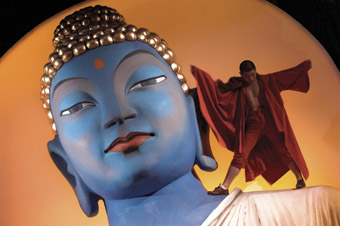
Monkey: Journey to the West, Manchester International Festival
photo Joel Fildes
Monkey: Journey to the West, Manchester International Festival
monkey: journey to the west
Monkey: Journey to the West was one of featured festival events and involved the unique collaboration between the duo behind the British pop phenomenon Gorillaz (illustrator Jamie Hewlett and musician Damon Albarn of British band Blur) and China’s rising star in theatre direction, Chen Shi-Zeng. This classic Chinese fable from the 1590s is an account of how the Buddhist sutras were brought to China from India by a supernatural monkey, a miserable sand demon, a monk and a pig man. The journey involves all kinds of magical characters: beautiful sirens spinning from floor to ceiling on red ribbons, amazing underwater sojourns with mermaids and flying, singing starfish as well as a raging volcano protected by a fan princess with a black belt. All the while, Monkey is battling the gold band Buddha has attached to his head as a punishment, which floors him with pain every time he acts violently or with anger. Chen Shi-Zeng’s performance as Monkey is one of the show’s highlights; in full body costume the actor creates an idiosyncratic physicality that combines an ape-like walk with a confident lad’s swagger.
The performance is a bold pastiche of traditional and contemporary theatrical styles including projected animation sequences, kung-fu, circus and Chinese opera. The result is a visual feast; spectacular live action and theatrical imagery dovetailing into brilliant cartoons.
Chen Shi-Zeng believes that the story of Journey to the West offers a unique perspective on Mao’s bloody Cultural Revolution of the 1970s, and the show features footage of Mao and military marching in Tiananmen Square. The political message of the work pivots on twin notions of individual and state. In a contemporary context, the show offers an interesting perspective on the rapidly emerging youth culture in contemporary China, represented through the lively and subversive central character.
il tempo del postino
Perhaps the most ambitious production of the festival was a group show co-curated by Hans Ulrich Obrist and Philippe Parreno, Il Tempo del Postino. It provided a theoretical challenge to 14 of the world’s leading visual artists, asking, “what if an exhibition was not about occupying space, but about occupying time?” With the aim of redefining how visual arts can be framed, experienced and interpreted, artists were each given 15 minutes to transform the established gallery exhibition model into a unique shared audience extravaganza.
The event featured works from artists such as Merce Cunningham, Tacita Dean, Douglas Gordon, Tino Sehgal and Anri Sala as well as highly visual theatrical imagery such as gynocentric, dancing stage curtains, interactive mirrors implicating the audience, a symphonic chorus of American auctioneers and Chinese butterflies and surreal Sesame Street-like characters playing tennis. The performances were diverse, exhilarating, visceral and, at times, shocking. The juxtaposing of works forced the audience to work to make meaning of the show as either an integrated whole or a series of disparate works.
French artist Dominique Gonzalez-Foerster had the 50-piece orchestra (providing the score for the first part of the performance) play a Beethoven symphony and gradually, one musician at a time, leave the orchestra pit, in some cases carrying their instruments, exiting by crossing the stage.
As the sound from the orchestra pit became thinner and the tension of the symphony built, the audience were on the edges of their seats, waiting to see the last instrument left, and hear how the solo would sound. A simple metaphor emerged from the work about power and clarity in numbers, of talented groups slowly going their separate ways and the gradual and inevitable demise of generations. By distinguishing each performer and having them emerge from the orchestra pit, where they are usually invisible, Gonzalez-Foerster’s intriguing ‘ending’ to act one was a literal deconstruction of conditioned theatrical expectations.
Act two comprised American artist Matthew Barney’s controversial and shambolic The Guardian of the Veil. The corpse of a sequinned and feathered woman is carried through the auditorium and placed on top of a burnt-out car wreck by four pall bearers in military gear. Barney himself enters the auditorium and makes his way on stage, wearing a black plastic apron and the head of a dog, a representation of Anubis, the Egyptian God of the Dead.
Barney symbolically ‘embalms’ the dead woman, removing engine parts from the hood of the burnt-out vehicle and placing them in funerary urns. Throughout, a female contortionist stands on stage with her back to the audience and her fist positioned between her buttocks. Two men in paramilitary gear drape her in a black rubber veil from head to waist, a sort of literal representation of woman as penis wearing a coloured condom.
After the embalming, another woman, naked apart from stiletto heels and a veil, does a back bend and then urinates copiously over the stage. At this point, a garlanded bull paraded on stage, crosses perilously close to the naked woman, is manually stimulated and encouraged to mount the back of the car. The bull fails to be aroused and is led away. The woman wearing the black rubber veil then removes her hand from between her buttocks and defecates as the curtains are closed.
Many have interpreted this performance as a reflection on the psychological state of Islam and a comment that the horrors of terrorism possibly stem from a phenomenon of sexual repression. With the use of such powerful symbols as bulls, cars and guns, an alternative reading is that Barney has symbolically represented the male ego and its fear of Woman as toxic, leaking and abject. In Guardian of the Veil, this visceral representation of Woman as Dangerous Other is paralleled with depictions of the Middle East as exotic and terrifying.
Currently positioned as the ‘second city’ in the UK, Manchester like other post-industrial cities is faced with the challenge of needing to reinvent itself. An international and uniquely Mancunian arts festival is part of a creative and cultural renaissance in the city, feeding into a growing global profile and a wider cultural awareness within the local community. These three works suggest a festival that is not afraid of ambitious, sometimes overtly political work. With a diverse curatorial strategy, the festival generated an innovative, international program, and for 18 days invigorated the city with its risky, political and brave artistic choices.
Interiors, Two Bedroom House, Old Trafford/Chorlton, writer-devisers Johnny Vegas, Stewart Lee, performer Johnny Vegas, June 29-July 15; Monkey: Journey to the West, adaptation, direction Chen Shi-Zheng, composer Damon Albarn, visual concept, costume, design, animation Jamie Hewlett, Manchester Palace Theatre, June 28-July 7; Il Tempo del Postino, A Group Show, co-curators Hans Ulrich Obrist, Philippe Parreno, director Philippe Parreno assisted by Ann-Christin Rommen, artists Doug Aitken, Matthew Barney & Jonathan Bepler, Tacita Dean, Trisha Donnelly, Olafur Eliasson, Liam Gillick, Dominique Gonzalez-Foerster, Douglas Gordon, Carsten Höller, Pierre Huyghe, Koo Jeong-A, Anri Sala, Tino Sehgal & Rirkrit Tiravanija, with Darius Khondji, Peter Saville, music director, conductor Ari Benjamin Meyers, lighting Chahine Yavroyan, costumes Ramdane Touhami, Manchester Opera House, July 12-14; Manchester International Festival
RealTime issue #81 Oct-Nov 2007 pg. 10
© Sarah Austin; for permission to reproduce apply to realtime@realtimearts.net
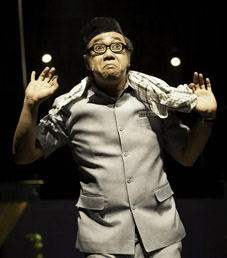
Butet Kartaredjasa, Death of a Critic
FESTIVAL NUSANTARA (FROM ARCHAIC JAVANESE FOR ‘THE ISLANDS IN BETWEEN’ AND NOW INVOKING THE ENTIRE INDONESIAN ARCHIPELAGO) SHOWCASED MORE THAN INDONESIAN CONTEMPORARY THEATRE, DANCE AND MUSIC AT THE BRISBANE POWERHOUSE. IT NEATLY TIED IN WITH INDONESIAN INDEPENDENCE DAY, PROVIDING A FORUM FOR A VARIETY OF CULTURAL ACTIVITIES, WHILE PRESENTING ARTISTICALLY AND POLITICALLY CHALLENGING WORKS THAT MIGHT NOT OTHERWISE HAVE APPEALED SO BROADLY. BY INCLUDING THE INDONESIAN COMMUNITY, THE POWERHOUSE ATTRACTED A UNIQUELY RESPONSIVE AUDIENCE INCLUDING FAMILIES, INTERNATIONAL STUDENTS, LANGUAGE TEACHERS, SCHOLARS AND INDONESIAN ARTS AFICIONADOS. AT THE SAME TIME, THE EVENT ENGENDERED RICHLY COMPLEX LEVELS OF INTERROGATION OF POLITICAL, CULTURAL AND ARTISTIC ISSUES. THERE WAS THE RARE SENSE OF A SHARED PEOPLE’S FESTIVAL AND, BY INTRODUCING THE SPIRIT OF THE CARNIVALESQUE, IT TEMPERED WHAT MIGHT OTHERWISE HAVE BEEN EXPERIENCED AS UNRECONCILED PERSPECTIVES.
The event has been a long term aspiration of Brisbane Powerhouse artistic director, Andrew Ross, whose team included assistant director Fauzi from the Surabaya Arts Festival. The program ranged from a retrospective of provocative images by both Indonesian and Australian photo-journalists to the cheesy pop of zany, youth oriented band Project Pop. The big crowd pleaser was Djaduk Ferianto’s big brassy show band, Kua Etnika, which like Karakatau’s more sophisticated fusion, blends jazz and swing with instrumentation and riffs from around the Nusantara archipelago. It was more easy listening than high art but featured a range of accoustically impressive compositions by members of the Kua Etnika collective appearing, incidentally, under the umbrella of the Bagong Kussudiardjo Foundation. Kussudiardjo was a former student of Martha Graham and a crucial disseminator of American modern dance ideas since the 1950s.
nan jombang dance company
Nan Jombang Dance Company’s most striking image in War of the Plates, a program of three Euro-Minangkabau etudes, was the opening solo. Out of the darkness a bell canto voice intoned its lament, “hati ini… this heart…”, transfixed us for a moment, then suddenly Angga Djamar’s head dived for the floor, liquid red dress cascading down her back as muscular legs rose, reached powerfully into the space, a headless creature searching blindly, articulately with feet on the end of arms. Barely touching down, featherlight, she rebounded, arching airborne into a supine ‘sault. Self accompanied by voice and minimalist percussion, choreographer Ery Mefri’s dancers weave expressionistic suggestions of interiority together with explorations of the folkloric—notably plate dance and the pants-slapping rhythms of ‘randai’, signature motifs of Minangkabau cultural identity. Other traditional artforms referenced, such as the percussive use of brass trays used in the sufi art of ‘selawat dulang’, were played not by musicians but by the dancers themselves. The hand clapping and pants slapping choreography of the final study played dramatically with dynamic contrasts—pianissimo to forte, butoh-slow to exploding with the folk form’s usual momentary gusto and complexity.
Although moving away from the simple repetition of tradition, Mefri only just began to exploit its choreographic potential. Based in the Sumatran capital of Padang, this company has bravely sought a contemporary language for expressing their region’s traditional ethos. There is a self-conscious element that pays homage to Martha Graham, butoh, even Bausch, directly or indirectly, but the indigenous martial art form ‘pencak silat’ yields a rich physical vocabulary of its own. They all combined in this soulful tryptich.
teater payung hitam
While stylistically Mefri seems to explore community, self and identity, Teater Payung Hitam (Black Umbrella Theatre) digs deeper in an attempt to express some primal truth about the alienation of Indonesian society from the mother principle in their work, Merah Bolong Putih Bolong (Red Hole White Hole in the program but better translated as Ruptured Red Ruptured White), written and directed by Rachman Sabur. This reading, occluded behind the more immediate political narratives of the last 50 years, was however not readily accessible to Brisbane audiences.
In a dramatic setting of perilously swinging boulders, carefully laid out rocks of red and white (the national flag, blood and purity, left and right, or… what?) were endlessly manipulated in gestures that spoke of the futility of small acts of resistance against the powerful and patriarchal onslaught of state power, the muscle of dominant ideologies. In another homage to expressionism, men half clad as labourers ducked the granite pendulums, rattled metal pails of grey gravel, gathered like monkeys or clowns and, in groups, assailed the relentless time machine of history. Or alone made valiant attempts to pick up the pieces, to recover order. Such a man, with a pail on his head, his body frail with age, bends to pick up one red stone at a time, but each time he bends, the one already in the pail drops out. Occasionally a saronged wild-haired figure—madman? madwoman?—reels out across the increasing chaos of stones that play a percussive symphony as they thud and roll, clack or rattle. At one point he/she is doused in a shower of red gravel (symbolising menstrual blood, we learn after the show) but nothing seems to change.
When this stricken soul is finally buried against a sound track of buzzing flies, it seems the narrative has just begun. This nation has been built on patriarchal strategies, explained Fauzi. Labour, war, Islam, economic development…Masculine power has dominated the story, and the Goddess has gone underground. The Ur Mother is Dead, and so struggles in vain to reunite with her children. But as her arm rises in silence, fist clenched, from the burial mound, there is no finality but a symbol of hope, “Merdeka!”, the revolutionary cry of freedom.
Teater Payung Hitam are a small, valiant artistic community based in the creative hotbed of Bandung, pushing boundaries politically and artistically, committed to visionary theatre in the avant-garde mould. More installation than dramatic art, their work assaulted our senses with a visceral physicality on the threshold of pain and danger.
butet kartaredjasa
Against these emerging companies Butet Kartaredjasa’s Death of A Critic by Agus Noor was more self assured on all fronts. Seasoned comic artist and founder of Teater Koma, Butet examines the role of the social commentator throughout history. Time moves forth and occasionally back. We check in on Socrates at one point, Napoleon at another: “I was Napoleon’s left hand”, says the critic. There’s an ambivalence to this critic, a grasping for power and recognition that underpins him as the constant shadow of demagoguery but the framing action really implicates the present until, arriving at a prospective Utopia in the Third Millenium, he dwindles away because he is no longer needed. We follow his ranting with colleagues who sold out, his refusal to abandon his vocation, and his vain belief that his service will one day—one day—be acknowledged. This is a two man show cleverly managed by one actor (and a bundle of blankets when the affable serving man, Bambang, a characteristically Javanese-style Sancho Panza to this Don Quixote appears) with video projection (interactive, whimsical and theatrically relevant) and an off-stage chorus-cum-band whose verbal interjections were as apropos as their live sound effects and instrumental accompaniment. By way of translation, the English surtitles were only the tip of the iceberg, but Butet was such an authoritatively engaging presence and so vocally and physically expressive that he took us along with him despite the language difference.
making connections
Though perhaps out of sync with Australia’s declining interest in Asian culture, Brisbane Powerhouse has boldly presented a small but potent festival of Indonesia’s contemporary arts, making a point about the usual overflying of the Indonesian islands in search of world festival fodder. Nor is it another wayang puppet show on a potted palm fringed stage. Instead Andrew Ross presents a selection of contemporary work that is socially and politically engaged, made by Indonesian artists in Indonesia for their own communities. What is pleasing is that this program deliberately avoids the self reflexive business of inter-cultural collaboration that is often producer driven and unevenly credited. But if collaborations are not a high priority for Ross, artistic connections are nevertheless valuable. It was gratifying then that a collaboration between Queensland’s music ensemble Topology, Djaduk Ferianto and Surabaya Arts Festival was also facilitated by this event.
Ross’s objectives are far reaching and include setting up Festival Nusantara as a vehicle for nurturing and marketing the young companies of the region. Ideally however, Ross’s overall vision might benefit if complemented by major festival players in a position to invite mature companies at the level of Bessie-award winning dance company Gumarang Sakti or Bengkel Teater Rendra who have never been seen here despite decades of international European and American attention. Such examples of excellence may be required, in conjunction with the already frequent individual exchanges and collaborations, to turn around our arts sector’s general ambivalence.
Ross appears to reject the wisdom of possibly linking with like minded events such as Queensland Art Gallery’s Australian Asia-Pacific Triennial of Contemporary Art. However, given the close relationship between contemporary performing arts and performance art in Indonesia it would seem to make sense to exploit such an alternative conduit to broader Australian interest. This relationship (exemplified, say, by Heri Dono, performance installation artist first introduced here in the 1993 APT) is as rooted in tradition (where there is less separation between disciplines—one often finds that traditional painters also dance and play dalang/puppeteer) as much as it follows on from the contemporary art movement in Jakarta and Bandung, where the notion of the ideologically progressive auteur found a fine arts following in ITB (Institut Teknology Bandung) long before public theatre became its medium.
Festival Nusantara: Nan Jombang Dance Company, War of The Plates, choreographer Ery Mefri, lighting Jo Currey; Teater Payung Hitam, Red Hole White Hole, writer, director Rachman Sabur; Death of a Critic, performer Butet Kartaredjasa, writer Agus Noor, director Whani Dharmawan, music Djaduk Ferianto; Brisbane Powerhouse, August 8-12
RealTime issue #81 Oct-Nov 2007 pg. 11
© Douglas Leonard & Indija Mahjoeddin; for permission to reproduce apply to realtime@realtimearts.net
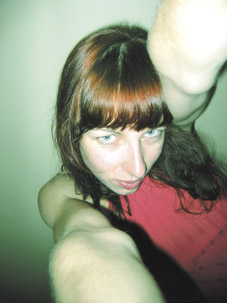
Tanja Liedtke, provided courtesy Solon Ulbrich
THE LOSS OF TANJA LIEDTKE, ONE OF AUSTRALIAN DANCE’S BRIGHTEST HOPES, IN A ROAD ACCIDENT ON AUGUST 17, IS KEENLY FELT AROUND THE WORLD.
Not yet 30 years old, Liedtke moved a lot of people as a dancer, choreographer and colleague. A tribute, held at Sydney Opera House on August 27 and organized by her partner, Solon Ulbrich, family and friends, highlighted the breadth of her achievements and allowed artists from the UK, family from Germany and colleagues from across the Australian performing arts sector to come together.
Liedtke was due to take up the position of Artistic Director at Sydney Dance Company in October. Having been involved in her recruitment, I remain inspired by the undaunted young woman who swept up the Board and, following her appointment, the Australian dance community in an inclusive vision for the company. Liedtke’s plans were not yet fleshed out, but she clearly understood her new role in the Australian dance ecology.
Liedtke’s career as a choreographer may have been short, but her success was established. Her first full evening production, Twelfth Floor, was nominated for five Australian dance awards in 2006, toured nationally through the Mobile States network and received rave reviews. Liedtke’s most recent work, construct, which premiered in London in May, was another triumph. Allen Robertson, dance critic for The Times, wrote, “The surprise of stumbling across a fresh, fully-formed talent is one of the reasons we keep going to the theatre.”
Liedtke’s choreographic voice was inspired by a rich life experience. Her father’s work took the family of three children from her birthplace in Germany to Spain and the UK. Starting dance aged four, Liedtke studied at the International Ballet Centre in Madrid. She entered Elmhurst Ballet School in the UK but, drawn to contemporary dance, finished her training at the Ballet Rambert School.
In 1997 the family moved to Australia and Liedtke to Sydney where she found Tanya Pearson’s ballet school. Liedtke coached students there until auditioning for Australian Dance Theatre and moving to Adelaide in 1999. She spent four years at ADT, creating roles in Garry Stewart’s Birdbrain, The Age of Unbeauty, Plastic Space and Monstrosity. Liedtke began to make her own work for the company’s choreographic workshop season, Ignite.
In 2003, Liedtke’s talent as a dancer was spotted by Lloyd Newson, Director of DV8, on a UK tour by ADT. Newson invited Liedtke to join his company for the European tour and film for Channel4 of The Cost of Living. She returned to the company in 2005 to become the diva in Just for Show.
During this time Liedtke worked internationally, resetting Ignite productions, To My Suite and Forever You on De Anima Ballet Contemporanea in Brazil, making Angels Fallen for Akademie des Tanzes in Mannheim and Enter Twilight for Tasdance.
In 2006 Liedtke returned to Tasdance to create Always Building. She had also recently created work for David Hughes Dance Company in Scotland. Touring for Twelfth Floor in Europe was planned and her new work, construct, was in demand.
Whilst plans to honour Liedtke at SDC and through her extant work are slowly forming, her cruel loss is felt in Sydney, Australia and the world.
Sophie Travers
construct: tanja liedtke’s final work
Many beautiful and insightful things have been said after Tanja Liedtke’s tragic death, mostly by people who knew her better and were more familiar with her work than I. My thoughts on her come from the perspective of a colleague and independent dance maker who admired her work and, like many in the contemporary dance scene, was very excited about the prospect of her working as the new artistic director of Sydney Dance Company.
I met Tanja last year at Performance Space when she was in Sydney to present her work Twelfth Floor as part of a national tour made possible through Mobile States. I enjoyed the work so much that I went to see it twice. It was a beautifully crafted piece, intelligently composed. The choreography was inventive and original. I was especially impressed with the way Tanja had managed to bring together a group of excellent individual performers (Anton, Kristina Chan, Julian Crotti, Amelia McQueen, Paul White) and made them gel as an ensemble.
After Twelfth Floor, I was seriously looking forward to seeing more of Tanja’s work. That opportunity came in June this year when I happened to be in the UK at the same time as she was touring her new work, construct, to four British cities. I caught up with the show in Manchester, on the last day of the tour. Tanja not only choreographed construct but also performed in it, with Paul White and Kristina Chan.
Construct explores notions of construction and destruction, building and collapse. The bare stage is strewn with objects associated with house building, such as a work bench, a step ladder, wires, rolls of tape and loose timber planks. All these objects are at some stage integrated into the choreography, most notably the planks. In one section, the performers use the timber playfully to create a series of tableaux vivants transforming them from picture frame to blanket, from telephone receiver to toilet seat. In another section, Paul, standing on his head, balances a plank on his feet and performs an extraordinary juggling routine.
For large sections of the work, cartoonish characterisations and stylised, sometimes clichéd gesturing are all used to make visible the artificiality inherent in any kind of construction, no matter if it refers to architecture or the relationship between human beings. In the last third of the work, stylisation is dropped, giving way to a darker, more realistic exploration addressing the futility of construction and the danger of collapse. Tanja’s solo, crouching on the ground, utterly alone and very small, keeping herself entertained by using her fingers as puppets, was especially moving.
I remember thinking, after the show, that construct confirmed the maturity of Tanja Liedtke’s choreographic vision. Even though not yet fully developed, it was impressive and made me curious for more.
Let us hope that construct will eventually be seen by Australian audiences, not only as a memorial to Tanja Liedtke but also as a confirmation of her reputation as a distinctive, consistent and inspired choreographic voice.
Martin del Amo
During our time together at ADT, Tanja was a constant source of inspiration, fun and friendship. She had 1,000 clever ideas a day, and never gave less than 100% effort to mastering the difficult repertoire.
Every event, conversation and moment in her life sparked an idea in her genius mind. Backstage personal jokes turned into marvellous monologues in the show. Far-fetched ideas on the bus became brilliant scenes. Her mind was always at work.
Being employed by her was an opportunity I’m lucky to have had. She was relentless in getting exactly what she was after with incredible attention to detail. One of her greatest attributes was the degree to which she would let people contribute to her work. Although always certain of what she wanted, she was always open to suggestions and ideas.
Kristina and I both agree that the development and performance of construct with Tanja Liedtke was the highlight of our entire careers. It was a privilege to work, live and play with her
Paul White
Tanja and I worked together collaboratively from 2000. She was always 100% focused and committed to her work and her dancers. Every little piece of the puzzle was important to her, both in her choreography and in her relationships with the people around her. She was extremely generous. I always felt incredibly inspired by her and therefore completely devoted to her work and vision, as did many of the lucky people who got to work with her. Tanja somehow knew the exact key to use to open possibilities within individuals and push them beyond what they thought was possible. Sometimes it was trial and error but the journey was always fulfilling. Tanja herself was always up for learning from her peers and dancers, which created a very open and giving work environment. We were all in it together.
Kristina Chan
http://tanjarocks.blogspot.com is a space for sharing memories of Tanja Liedtke
RealTime issue #81 Oct-Nov 2007 pg. 12
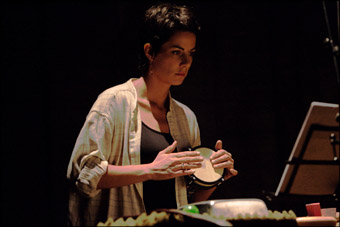
Claire Edwardes
photo Bridget Elliot
Claire Edwardes
VISCERAL RHYTHMS THAT GET THE HEART BEATING WILDLY AND THE FEET ITCHING TO DANCE—THAT’S A TYPICAL IMAGE ASSOCIATED WITH PERCUSSION. STRAVINSKY EXPLOITED ITS PRIMAL NATURE IN HIS SCORE FOR BALLET, THE RITE OF SPRING, BUT MANY COMPOSERS SINCE HAVE, CONSCIOUSLY AND UNCONSCIOUSLY, CHALLENGED THIS PERCEPTION BY EXPLORING THE INTRICATE QUALITIES OF PERCUSSION. AWARD-WINNING FREELANCE PERCUSSIONIST CLAIRE EDWARDES SAYS, “I LOVE THE HEAVY DRUMMING WHERE YOU CAN JUST GET CARRIED AWAY…THERE’S DEFINITELY ROOM FOR THAT… I’LL OFTEN PROGRAM SOMETHING LIKE IT, BUT THEN COMBINE IT WITH SMALLER SOUNDS.”
“Like David Young’s new work?”, I suggest. The composer’s To Keep Things Reasonable (Ad Res Modicas Conservandas) was recently premiered in Sydney by Ensemble Offspring and the Song Company at their Caged Uncaged mini-festival [see RT 82]. Amongst other things, it required Edwardes and colleague Bree Van Reyck to gently scratch and rub chopsticks against various metal and wood surfaces. “Yeah!”, she exclaims. “Could you actually hear the rubbing on the woodblock? We couldn’t, being so close to the singers.” She needn’t have worried. The beauty of this delicate work was hearing its subtle techniques pushed right to the edge of silence.
Edwardes finds both ends of this spectrum integral to her musical life and her personal expression: “the softer, more sensual techniques, I guess, are in tune with my feminine side, and the visceral ‘striking’ [she demonstrates] the girl in me who is strong and powerful.”
Along with these attributes comes extreme versatility—the list of instruments available to a percussionist is endless. Edwardes says it’s difficult to explain what playing is like: “Generally, it just feels good—scraping, rubbing, hitting, shaking. I get something different out of [each of these] techniques. Emotionally, you can express different things—like if I compare playing [Morton Feldman’s] King of Denmark, which is all [soft dynamics and played] with fingers and hands, to playing [anything by] Xenakis: I love playing them both.”
Edwardes’ aesthetic of the physicality of playing is clear: physical gestures must enhance sound. She has no time for ego-driven movement. “I have a reaction against moving for the sake of moving”, she says. “This is something I try to be conscious of in my own playing…I move a lot when I play, but [this] comes from the music…it’s about keeping it real.”
Given Edwardes’ enthusiasm for contemporary music, I was surprised that her passion for the new only emerged in her final years as a student at the Sydney Conservatorium of Music—a Hans-Werner Henze’s solo marimba work, Five Scenes from Snow Country, being a major turning point. With its sparse textures and ultra soft dynamics, the work lead Edwardes’ to “realise that not all music plays itself.”
Ten years later—after postgraduate studies in Holland and with a busy schedule of freelance work—Edwardes’ now relishes the freedom that contemporary music gives her. With myriad choices for interpreting new and recent work, a lot of her rehearsal time is spent away from instruments analysing and scribbling furiously on music scores. For Edwardes, the notion of a journey is a useful analogy: it gives the audience something tangible to grasp. “It’s the only way to keep the audience with you…[by providing] threads for them to navigate through [the music].”
And while her own journey so far has been frustrating at times, mostly she’s felt liberated by the whole experience. Curiosity is now a huge asset: “I’ve learnt the importance to let go and not be stopped by thoughts that something isn’t possible…because if a composer wants something—a particular sound—then you have to play it! It’s about keeping an open mind, keeping the gamut of sound worlds open…I’m now constantly foraging in Mum’s kitchen looking for new sounds, and I love it that my Dad thinks I’m crazy because I’m always playing weird instruments.”
We’ve been seeing a lot of Edwardes around Sydney lately: in Cage:Uncaged, the Sibelius Young Composer’s Competition Concert, the TV series Spicks and Specks and the Bad Dog Yoda concert with guitarist Goeffrey Morris, where she launched her first solo album, Coil. And the next few months seem just as busy. Considering most of the pieces in her repertoire won’t get many outings, I wondered how she manages to embody such a diverse amount of work. As I suspected, she’s a damned good sight-reader. Of course, it also gets easier with time. “Composers will always be coming up with new instruments to play and new sounds”, she explains, “but by building up a repertoire of techniques and gestures, you become more comfortable with the sound world.” She insists, however, that it’s not a formula: “It’s more a way of thinking, a certain framework in which to work, so when rehearsing new pieces it’s nice to know that you’ve got things under control. Well, at least you hope you do!”
With so many ‘things’ to hit, scratch, rub and scrape in often very specific ways, I imagined the interplay between the physical and intellectual aspects of playing to be enormously challenging. For Edwardes it comes quite naturally. She loves the “well-rounded experience” of her existence as a percussionist and performer of contemporary music. The challenge lies in maintaining this versatility throughout rehearsals and practise sessions, and this is what keeps her career choice fresh and exciting.
So with great sight-reading skills, score mark-ups and scrupulous analyses, where does that leave improvisation? “I’ve always erred towards a more rigorous style, like the [works of Dominik] Karski”, she admits. “It’s about what you know, what you’re comfortable with…I have a background as a pianist so I’m used to reading scores.” Improvisation is something Edwardes has fairly recently had to embrace—“it’s very in vogue now.” It seems to have been a steep learning curve, but Edwardes—not one to be afraid of challenges—insists that now she’s been introduced to it she’ll include it in her programs.
In 2006, in preparation for their first free improvisation performance (John Zorn’s Hockey), Edwardes and the other members of the Sydney-based Ensemble Offspring participated in a series of workshops run by improvising performer Jim Denley. “We hadn’t done anything like this before, but thought it would be easier to learn as a group—to give it a go! It was a good formal start and a place to gain a few pointers.” She says Ensemble Offspring has since come a long way with their improvisational skills: “We’ve performed Cage’s Four6 twice now and if you look at the difference between the two performances it’s phenomenal…and that’s what the piece is really about: learning to choose sounds.”
Ensemble Offspring is just one of a number of groups with whom Edwardes regularly performs; collaboration is a crucial part of her work as a performer. “Essentially I’m a soloist”, she explains. “I perform by myself, and I like that aspect of my career…but I love performing with other people. I’m a very social person. I love bouncing ideas around, knowing that [they] aren’t the only way of seeing things, the problem solving that takes place, the different personalities, the energy—it’s all great!”
The Duyfken Project, a cross-cultural collaboration with Dutch percussionist Niels Meliefste as Duo Vertigo, exposed audiences across Australia to new works commissioned by local and overseas composers. Edwardes commitment to Australian new music recently won her the 2007 Classical Music Award for Outstanding Contribution by an Individual. And while Edwardes enjoys working with composers, she doesn’t really see it as collaboration: “It is in a way”, she admits. “But essentially it’s the composer who has to bring the notes to the rehearsal… [they’re] the creative force. I shouldn’t direct too much — it’s not my role. [Workshopping] is something that does take place with younger composers, but older composers don’t generally need to do this. They already have a strong sense of what they want and the sounds they like. We’ll normally just discuss things such as instrumentation and style at the beginning.”
So what actually drives Claire Edwardes? Mostly it’s the audience—advocacy for the arts is a huge motivation. Her work as assistant artistic director of Ensemble Offspring is an aspect of her career she’d like to develop further. “I think this is really important for Australia…particularly bringing in trends from overseas…we’re still very isolated.”
Art is obviously important to Edwardes for the spiritual welfare of society. “There is a great quote from JFK about the US: ‘This country cannot afford to be materially rich and spiritually poor…’ This is a state that I am afraid Australia could be accused of being in at the moment…As performers and promoters we have to work extra hard to get audiences interested in new music—it is not seen as a priority for most people…Contemporary music is so important because it is the development of our culture NOW!”
Claire Edwardes cites funding priorities and a cultural emphasis on materialism as major hurdles for the arts. But in terms of the actual music, she thinks there’s often a huge misunderstanding. “Essentially people are scared of the unknown…I’d like to get the idea out there that music is about feelings and that’s all you have to know.”
Claire Edwardes first solo CD, Coil, is reviewed on page 48 and five copies courtesy of Tall Poppies are available as giveaways to RealTime readers (p56).
RealTime issue #81 Oct-Nov 2007 pg. 14
© Danielle Carey; for permission to reproduce apply to realtime@realtimearts.net
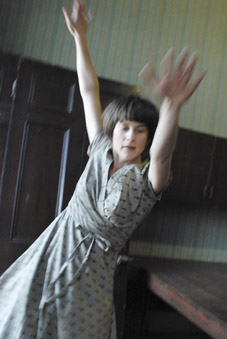
Rosie Dennis,
photo Heidrun Löhr
Rosie Dennis,
SYDNEY-BASED IMPROVISER ROSIE DENNIS IS A UNIQUE AND ELECTRIFYING PERFORMER, CREATING SHORT WORKS, AROUND 20-30 MINUTES EACH, REALISED AT SPEED—VOCALLY AND PHYSICALLY—BUT IMBUED WITH NUANCES AND SUBTLETIES RISING OUT OF HER MANIC RIFFING. IN JUST OVER FOUR YEARS, DENNIS HAS BEGUN TO CREATE A CAREER FOR HERSELF, MOST NOTABLY IN THE UK AND NOW IN EUROPE, WHILE HER HOME, AUSTRALIA, PROVES MORE OF A CHALLENGE BECAUSE IT IS ONLY JUST BEGINNING TO GROW THE PERFORMANCE NETWORKS THAT PROLIFERATE ELSEWHERE. I MET WITH DENNIS TO TALK ABOUT HOW HER WORK HAS EVOLVED AND HOW IT HAS MANAGED TO REACH AN INTERNATIONAL AUDIENCE.
With a quiet seriousness (so different from her performance spin-outs), Dennis conveys a clear-eyed sense of purpose and of careful analysis of the performance path she’s chosen for herself or which, as she tells it, perhaps chose her. “Accident” and “luck” figure strongly in her account of her career. However, while she says she’s not a planner she confesses to having been, at times, a control freak. It was interesting to hear how Dennis, as she developed her craft, moved towards structured improvisation—a model providing both freedom and form. Similarly, she says that being vulnerable is what appeals to her about improvisation, but it doesn’t frighten her. These are not contradictions but perhaps elemental to the art, and life, of this improviser.
What’s driven you to become a performer?
An accident really. About five years ago I auditioned for the VCA to go into their director’s course, that was my trajectory at that time. I’d done a couple of short things for the unbecomings season at Performance Space and before that at university as part of my arts degree. So I thought a creative way to get around not getting into VCA was to go back on the floor and train, so that if I was working with performers I’d be in touch and coming from a similar place. At that time, in 2003, the improviser Andrew Morrish just happened to be doing a weekend workshop in Sydney. I almost chickened out but my partner said I needed to go. Andrew said to me on that first day, “I don’t think you’re really a director. I think you’re a performer.” I said okay and I felt really exhilarated after the workshop like something had changed for me. I hadn’t really performed at all before, except at school, just directed.
Andrew said he had a Sunday night thing with just a few artists meeting to perform for each other. I went to that every Sunday. I had a huge appetite. Something had been unlocked and I was finding something new every week, and it helped with the way I’d write. I could do it on the floor instead of sitting down, and new text would come and new doors open.
You were writing before you began performing?
Yes. The first play I wrote pieced together about 45 Gertrude Stein sentences into a love story which became a show, Can Fish Be Wives (1996), at Downstairs Belvoir during one Mardi Gras. When I think about it, it’s exactly what I do now, poetic text, and it had sound, it had music and it had abstract movement. I was 20-21 and working it out.
My writing was heavily rhythmic, so improvisation helped: as I was walking around the rhythm of my walking was changing the rhythm of the text. I realised the two were feeding each other and I became aware of specific hand gestures and I thought the movement’s feeling the text and the text is feeling the movement and this synergy is good. But at this time I did little movement in my performance work at all. With Elly Brickhill I improvised vocally in darkness at a microphone while she danced in Waiting to Breathe Out (2002-03). By now I was 25 and I was very shy on stage, even after working with Andrew—but that had been for only five people at a time.
The improvising was feeding my writing but it was research still and I was getting frustrated, having more and more questions about things happening on the floor I wanted answered and Andrew said you’re going to have to do it more. He teamed me up with the dancer Martin del Amo and we decided to practise with each other. It’s very specific: we have half an hour each and we perform for each other. So it’s not a collaborative process, not a duo. That began in 2004. We’re still doing it.
But then you leapt into the void.
The big moment was with Polish in Next Wave in 2004. I thought, okay I’m going to try this now, over five nights, without a very clear theme but investigating the same sort of material every time. I did it and I thought, I’m a performer.
Was it a good leap?
A good leap. Well, it was a ride on a freeway and it was very difficult to slow down and speed is still something I use in my works very particularly. I find the faster I go the more opportunities and options that I’ve got to play with. I’m in the moment but thinking ahead and I’ll stumble and I’ll hear something in the word and that can take me in another direction. I like that.
Did you have a structure?
No, I was just freefalling. I’d have a little clock in the corner and just watch for the 20 minutes to be up and then I’d find an ending. It was a good experience.
How did you move into structuring your work?
That was me wanting to go back to writing. I’d been a control freak in my early 20s and constricting myself about what I wanted to do—terrible in retrospect. But after improvising I now had a real fear of putting something on paper: “God, now I’m going to have to stick to it.” And I still only write down points, but I am going to get older and I’m going to forget things, so I am trying to write things down while they’re all still in me.
I decided it was good to put some structure down because that gave me parameters to work within, which I’ve always done—time constraints, physical obstacles. Having a ‘score’ gave me more freedom to do other things in performance because I wasn’t thinking about where I had to go. That’s what I realised in Melbourne at Next Wave where I was always trying to build to 20 minutes duration. I thought, “Rosie, you don’t have to do that because maybe that improvisation is actually only 16 minutes. You need to be able to give yourself permission to leave when it’s finished or cut to the next section.”
What happened after Next Wave?
I met the British artist Richard Layzell at the National Review of Live Art (NRLA) in Australia in 2003 and he took me to Perth because we’d done a little bit of collaborating at Time_Place_Space 2 [Dennis was a participant in 2003 where Layzell was a mentor]. I did a late night solo and he got people to look at it. I got invited back the next year to make a piece, which was Access All Areas, and the NRLA director Nikki Milican invited me to Glasgow. I went in 2006.
I did nothing at all in 2005. While at Next Wave I got a call from Performance Space who were looking for a publicist and I needed a job and took it but didn’t feel I could promote my work there. I kept training and doing stuff at Omeo Studio [the Sydney base for Morrish and other improvisers] and eventually the Sunday night program there faded out and I curated the odd event and then went overseas.
And once there you made immediate connections.
The Inbetween Time festival in February 2006 at Arnolfini in Bristol was the week before NRLA and the curators from Portugal’s Festival Trama in Porto saw me perform Love Song Dedication there and asked me to come and do two shows for them. That was really lucky. And at NRLA there was the buzz of seeing so much work. I was really happy. Three months after I got back, Nikki asked me to come back in 2007, but the airfare was a problem. The first time I got Australia Council support. So I discussed it with my partner, about consolidating my work at NRLA and how that would benefit my work here. The travel cost would be an investment worth making in myself as an artist. I wasn’t worried about the airfare—I wanted to perform. In Australia there aren’t as many opportunities, there aren’t as many places to perform.
I’m difficult to program. I’ve approached fringe theatre venues here. I do sit, if weirdly, in theatre and I do move, so I fit with dance, but I’m not really theatre and I’m not really funny. Performance Space was incredibly supportive of me as an artist: last year they co-produced Martin del Amo and I doing solos over three nights. But in Europe there’s a place for short works. Four hundred people come a day to NRLA.
I was in NRLA 2007 and I performed again at Arnolfini in Bristol. A lot of the same people came back and saw my new show, Hitting a Brick Wall; some have seen all three works. I performed at Chapter in Cardiff and did a workshop at the university there. I came back home and then self-funded another trip in May and I’m about to go again at the end of September. Nothing is ever a waste, I meet great artists and I always see work. At the ANTI festival in Kuopio in Finland I’ll do a show, a workshop and a talk, two shows in Lubljana as part of the City of Women Fesitval, and I’ll perform and do a workshop at Lancaster University—people there had seen me at Arnolfini. I’ll be in Experimentica, a live art festival in Cardiff, and the Word About Town spoken word festival in Hastings.
Are you tempted to move to the UK?
No, I really like Australia and making work here, and I’m turning my focus to how to do more stuff in Australia. I’m running an occasional series called Fantastic Animals at a studio in Annandale because I need to show work, and I invite other artists to join me. And I’m making a new work as a companion piece to Access All Areas so they can be marketed and performed together, the new one as a response to the first. This is rather than making a 45-60 minute piece. I don’t want to do that. I have to be true to what I enjoy.
What kind of responses do you get from audiences?
People have strong reactions, and they are always much older than I expect. I always thought that my work appealed particularly to women. The last two trips overseas have proved me quite wrong about that. I got much more feedback from men. Bizarre. Someone said ages ago. “Your work’s so female.”
What is it that audiences connect with?
I’m drawn to improvisation because it makes me vulnerable on stage. I’ve become quite confident in that vulnerability. It doesn’t frighten me at all, but if I’m not there being exposed then I’m not fully making the kind of work I want to make. The vulnerability is what people connect with.
Is the work about you? People often play themselves, or logical extensions of themselves or adopt personae in contemporary performance.
In London last month someone who knew me thought the performance was about my partner and I, and was alarmed. But I don’t mind if people think the work is about me. The work starts very specifically and then I broaden it.
When I watch the rushes of the film of Access All Areas [titled Quietly Collapsed] I do think, “You’re so intense.” It comes with the speed I’m working at.
How did the film come about?
I’d said to Sam James, the video artist, I want to make a film of Access All Areas, people respond well to it wherever I go and I can’t take the show everywhere. And it could screen in festivals. Sam suggested we apply for a commission fee from the ABC Dance 4 Film project [a broadcast partnership between the Australia Council, ABC TV, Channel 4 and Arts Council England for the screening of dance films on the ABC and Channel 4 in the UK] and we got $3,000, for a 3.5 minute film. [Sean O’Brien was the other successful Australian filmmaker applicant.]
So is there a long term plan, beyond the double bill and the film?
So much came out of working with Andrew Morrish, from Time_Place_Space and NRLA and, although I said I don’t plan, I did sit down and come up with a five-year plan, a realistic strategy. I’m optimistic about what I’m doing now. I might not do it forever. I’m a true improviser. This is what I’m doing now.
Rosie Dennis is currently touring Access All Areas, Love Song Dedication and Hitting A Brick Wall. www.suture.com.au
RealTime issue #81 Oct-Nov 2007 pg. 15
© Keith Gallasch; for permission to reproduce apply to realtime@realtimearts.net
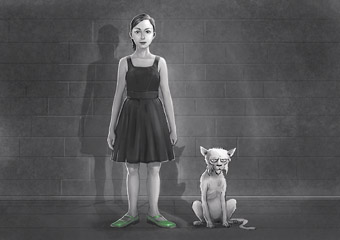
The Pipe Manager, Lisa O’Neill
LISA O’NEILL IS UBIQUITOUS, BUT ALWAYS SUI GENERIS. ALTHOUGH SHE APPEARS IN A VARIETY OF FIELDS (NEW MEDIA WITH TRANSMUTE COLLECTIVE, PHYSICAL THEATRE WITH SUZUKI-BASED FRANK COMPANY AND THE POP-CULTURISH BRIDE OF FRANK, OR IN SOLO DANCE WORKS), HER MANY PERFORMANCE MASKS AND VARIED PERFORMANCE STYLES ARE ALWAYS IRRADIATED FROM THE SAME INNER CORE. HER STALKING-ANIMAL ATTENTION, HER GROUNDEDNESS, AND THE EXPLOSIVENESS OF A PUGILIST ARE UNMISTAKEABLE. SHE HAS A QUALITY OF SPIRIT THAT, WHILE SEEMINGLY BOTH PROFOUND AND REMOTE, IS ALSO IMMENSELY AND IMMEDIATELY SEDUCTIVE.
As the participant in a total creative process reaching beyond the aesthetic, O’Neill seems to espouse a ‘transaesthetic’ of dance, sometimes incorporating an essentially private mythopoeic vision as in her signature dance piece, Sweet Yeti. O’Neill comments on this, a work that seems to touch on the animist/shamanic origins of dance: “I’m not quite sure what it is people see, but it goes to show that if you are in a transcendental space, a state that I seem always to find in Sweet Yeti, then the audience will go with you and feel and see things that you probably weren’t deliberately intending.”
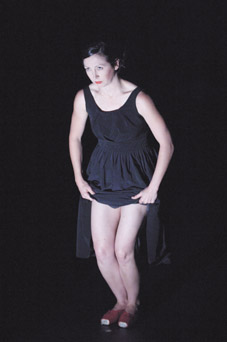
Lisa O’Neill, Sweet Yeti,
photo Phil Hargreaves
Lisa O’Neill, Sweet Yeti,
Originally created in 1995, Sweet Yeti has evolved over time as O’Neill continues to remount it, most recently in November 2006. She goes on to say, “Every time I perform this work I feel like I’m home, it’s a really interesting, enlightening and shared experience that stands out for me against my other performance works. I first created and performed the work when I was 22, I am now 34 and, when I performed it last year, it was as though I was outside myself, watching myself dance from another viewpoint. I feel as though my whole life is tucked away in that piece, 12 years of it. This really interests me as a performer. I would love to perform Sweet Yeti for as long as my body can cope. The piece was never about anything in particular, but to this day it seems to be the piece that moves people the most.”
“You are the summation of what you’ve done. Who you are is incidental”, says Frank Theatre’s Jacqui Carroll, which seems apropos. If O’Neill is a product of her sources, then Carroll has been a major influence. Through their long association (since O’Neill was 14), one can place O’Neill in direct lineage both to Martha Graham and Tadashi Suzuki, both hard task-masters. However, rather than dance or actor training, O’Neill talks about the direct transmission of “deep energy fields”, a forceful encounter she likens to being slammed into the back of a car. There is a strong focus on “intentionality” which she, in turn, feels the need to hand on. For the past seven years, along with playwright and theatre scholar Norman Price, she has been developing the Advanced Diploma of Arts (Acting) course at Southbank Institute of Technology. This creative partnership engendered the Pineapple Queen Merde project based on an earlier Price play and, for O’Neill, “highlighted the need for intensely long creative development periods if a work and its performers are to truly reach full potential.”
Since knee operations in 2003 prompted a shift towards acting, O’Neill confesses that “dance as an art form rarely inspires me any more; it is as though I have been shifted into another space through my diverse experiences as a performer and performance maker, my work in the theatre. I find it very hard to watch bodies and limbs moving in space unless the dancer is completely involved with what they are doing, that something more substantial and deeply internal is working behind the motion.” Her interrogation of dance reveals an obdurate passion, even while she wryly concedes that she may be perceived as “this black sheep that appears and disappears. Or maybe this is how I see myself?” The American artist William Baily said that the key was to stay with something and keep making it better, cleaner, more resonant, more intense. O’Neill thoroughly concurs. “In terms of my own arts practice, I have dedicated most of my adult life to a couple of specific training systems for that very reason, applying this philosophy to my rehearsals, performance and art making. I have always concerned myself with the ability to continue growing and developing along the one trajectory, to delve deeper into that space.”
Musing on the career of undoubtedly one of the most hardworking artists in Brisbane helps to make sense of the dramatic new turn she has taken in her latest creative development showing at the Judith Wright Centre: The Pipe Manager (a carefully prosaic title). It is a “stand out project” for O’Neill because it is the first time she has invited other artists to collaborate with her on a solo dance work. They include an illustrator, writer, sound artist, new media artist, video editor, dramaturg and costume designer. It is also the first time (considering her history with the new media group Transmute Collective) that she has resorted to visual media in her own work. Thus the story will be ultimately conveyed through movement, illustration and sound, with minimal subtitles, cartoon captions and a voice over narration.
It is also the first time O’Neill, as dancer, has resorted to story, albeit a bleak and somewhat apocalyptic tale leavened by her propensity for clowning and whimsy. The narrative follows the journey of a woman who, after applying for the job as pipe manager, is asked to innovate and reinvent the archetypal pipe (as in plumbing). At work the woman is under the vigilant eyes of the dictatorial Board of Directors who are hidden away high up in the walls of the office behind glass. When previous managers ran out of inventions they were literally terminated on the spot. So the desperate need to reinvent the pipe becomes a life or death situation. She stumbles across old business files and discovers that previous managers would eventually deconstruct their inventions in order to create new ones. But is deconstructing an invention a viable way to invent anew? And does this necessarily equate to functional, high quality and sustainable possibilities? Alice-like, she falls down a large pipe and finds herself in Yetiland, an alternative reality where she comes face to face with those figures from her workplace who now look surprisingly like, yes, yetis.
O’Neill recalls attending an Arts Queensland meeting where every second word was ‘innovation.’ The Pipe Manager seems to be saying that when ends become subservient to the means of production, frustration constrains the producer to either abstain or go mad. In Hades, compulsory maddening behaviour was considered the ultimate punishment reserved for blasphemy. Sisyphus was forced to keep rolling a stone uphill, only to see it roll back down. But artists and clowns, the ultimate blasphemers, have always risen up against the oppression of creative thought by dogma. They expose literal-mindedness with metaphor. If our most sensitive artists are the antennae of our culture, we must be in deep trouble. Even Brian Lucas, that most intimate of story-tellers, recently produced an uncharacteristic, darkly eruptive parable in revolt against the corruption of language.
The Pipe Manager is a multi-layered, complex and developing piece of work which is endeavoring to come to terms with large issues. It takes on no less than the capitalist imaginary of the unlimited expansion of production and consumption and at the same time, to give O’Neill the final word, reflects on a contemporary reluctance to work along with the forces of nature rather than ride them like a bull. Lisa O’Neill, of all people, has sufficient cred to tackle such themes. There are many of us on the sidelines cheering her on.
The Pipe Manager, devisor, performer Lisa O’Neill, writer Peter Berkahn, illustrator XTN, dramaturg Kathryn Kelly, video production Jaxzyn, soundtrack editor Ramsay Hatfield, costume designer Glen Brown, new media consultant Keith Armstrong; Judith Wright Centre of Contemporary Arts, June 8-9
RealTime issue #81 Oct-Nov 2007 pg. 16
© Douglas Leonard; for permission to reproduce apply to realtime@realtimearts.net
![Matthew Gardiner’s Oribotics [network]](https://www.realtime.org.au/wp-content/uploads/art/13/1343_gallasch_oribotics-miaf.jpg)
Matthew Gardiner’s Oribotics [network]
oribotics [network]
There’s something biomimetic on the glass panes of Federation Square’s Atrium—it’s oribots. They communicate with each other, they glow and change colour, they feed on sunlight. These entirely new, living creatures, part of oribotics [network], have grown out of the earlier Matthew Gardiner work, oribotics, a mating of origami and robotics. Each new oribot here is in harmony with its environment, the design shape echoing the folds and facets of the atrium. Communication is powered by built-in low voltage computers and relayed via a wi-fi network. The data stream changes the tricolour LED output. The oribots blossom as they attract data from your movement and stimuli from online fanciers. See and believe. And it’s free.
Matthew Gardiner’s Oribotics [network], Fracture Gallery, Atrium, Federation Square, Melbourne International Arts Festival, Melbourne, Oct 8-Nov 9
www.oribotics.net
coming to a second life near you
Art is quickly establishing niches for itself in the burgeoning Second Life ecosystem-cum-market, sometimes as creative extensions of first world works (Physical TV’s Thursdays Fictions) but increasingly on its own virtual terms. The Australia Council’s Inter-Arts Office has promptly tempted Australian artists to go native in Second Life with the offer of a $20,000 residency ($4m in lindens) which was successfully applied for by the team of Christopher Dodds, Adam Nash and Justin Clemens. Inter-Arts doubtless would like artists to find income as well as renown in Second Life and perhaps help lift the Second Life game beyond bad graphic art and wobbly puppetry.
What the team promises is an “installation, a metaphor for the Tower of Babel, us[ing] voice recognition software that converts the spoken word of real and virtual world participants into 3-D letterform images in an evolving tower of words. The letterforms generate relationships with each other through a combination of visual and sonic manifestations, fragments of narrative, environmental/user awareness capabilities and through interaction with existing data generated within Second Life itself, such as the virtual winds, sunrises and sunsets.”
As often with Second Life ventures there’s a curious desire to manifest the work in both first and second worlds, a kind of insurance perhaps, but here the aim is to engage a different kind of audience who presumably might never think of getting a second life: “The artwork will be a simultaneous installation in Second Life and in a real world gallery, where gallery visitors can be directly involved in its creation via a computer interface.” Apparently most of the dollars will go on the gallery showing (http://babelswarm.blogspot.com).
RealTime issue #81 Oct-Nov 2007 pg. 18
© RealTime ; for permission to reproduce apply to realtime@realtimearts.net
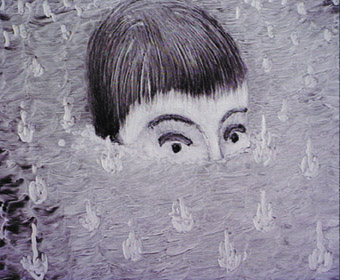
The Boy Who Loved the Rain
RECENTLY IN REALTIME AND ELSEWHERE I’VE BEEN CRITICAL OF AUSTRALIAN SHORT FILM AND ANIMATION, SO MUCH SO I’M BEGINNING TO BORE MYSELF (AND DOUBTLESS OTHERS) WITH THE OLD REFRAIN. STILL, I VOICE THESE CRITICISMS FROM A POSITION OF RESPECT FOR THE AUSTRALIAN INDEPENDENT SCENE AND ITS UNREALISED POTENTIAL, WHICH IS WHY IT WAS SO REFRESHING TO ATTENDthe Melbourne international film festival’s AUSTRALIAN SHORT STORIES SESSION.
These weren’t shorts made by superhero writer-directors who think they can do it all, insulting the audience’s intelligence with woeful scripts, lame punch lines, toilet humour and clichéd narrative tricks, and they weren’t shot in such a hyperaware glossy. fashion that I was forced to wonder whether the director wouldn’t be happier making ads. Instead we were presented with genuine, lived-in dramas rooted in experience and a sense of worldly self-awareness. These were films made by people who actually have something to say about their immediate environment, rather than by filmmakers who appear to have little motive other than adding another notch to their showreel by aping overseas trends (trends that are stale by the time they reach these shores anyway).
indigenous short film
Australian Stories, a showcase for Indigenous film, included four animation shorts produced as part of the 12-strong Dust Echoes series that collects Dream Time stories from Arnhem Land, produced by the ABC in association with Deakin University and the Djilpin Arts Aboriginal Corporation. Of these, Mermaid Story (James Calvert, 5mins) was told entirely through music and sound—no narration, no dialogue. Mixing cut-outs, silhouettes and traditional drawing styles, the simple story, about a man who chooses to live with mermaids, thus forsaking his family, was achingly poignant. The Bat and the Butterfly (Dave Jones, 5mins) was perhaps the most impressive. Its characters looked like a cross between gingerbread men, stone carvings and claymation, and the story was told through snatched whisperings and ambient desert sounds, culminating in a powerful tale of cowardice and lack of responsibility versus courage and redemption. Dust Echoes was stunning, with every element in synch, creating a rich, sensory experience—visualising the Dream Time by melding the techniques of the future with the raw emotion of the very distant past.
The live action in Australian Stories was also impressive. Pauline Whyman avoided sentimentality in Back Seat (5mins), a film seen mostly through the blurred POV of the child protagonist, aimed at the Aboriginal family she sees at the end receding through the window of the car driven by her white foster parents. Stark emotional dynamics told the story: close-ups of car locks and windows; a simple Polaroid frame left lingering in the memory.
The hilarious Nana (Warwick Thornton, 5mins) featured a young girl’s comments on the titular oldie, an ancient lady whose good works include beating up alcohol smugglers who threaten the sanctity of her community. In her down time Nana paints, delighting the little girl with her off-the-cuff remark that “I paint the same painting every time. White people wouldn’t know the difference anyway.”
Adrian Wills’ Jackie Jackie (5mins) is a completely warped film about an Aboriginal girl who has to put up with the ghastly prejudices of her white boss at the supermarket where she works. All around her, the robots who work at this place are represented in hypergarish style: blue plastic wigs, clothes in colours that would do Howard Arkley proud. In the end, the boss gets his and the message is clear: stick up for yourself, because self-respect is often all you’ve got. Back Seat, Nana and Jackie Jackie are from the AFC Indigenous Branch’s latest initiative, Bit of Black Business (see page 23).
Darlene Johnson’s Crocodile Dreaming (26mins) starred David Gulpilil as an elder with the power of magic. When his clan’s sacred stone is stolen and thrown into the river, Gulpilil must defy totemic crocodiles to retrieve it. He’s the perfect choice for such an ‘aqua man’, with his ultra-smooth skin and pitch-dark eyes like portals to another dimension. The film is a tour de force, including all the performances (Tom E Lewis is the antagonist); Darlene Johnson is one hell of a filmmaker—the disturbing scene of a crocodile’s revenge and another where one swims quietly above Gulpilil are testimony to that.
When the Natives Get Restless (28min), also from Adrian Wills, is a raw look at an Aboriginal housing estate in Dubbo, a lawless non-place. One resident says, “My life’s not worth living”; another despairs, “I hate Dubbo, hate the estate, hate what it’s done to me.” The point is made that in the city people only hear media versions of what goes on, like a recent riot depicted here. The film takes us beyond that. An interviewee says that ever since settlement black people have not been allowed to work. After you see how subtly and insidiously hardwired this attitude is, you realise this country hasn’t come very far. Here, aggressors come to seem more like victims and we are left shaken with the sense that people are still left to live like this in the 21st century.
animation
The animation component of MIFF 2007 also contained some impressive Australian work. Thomas Fraser’s The Boy Who Loved the Rain (7mins) was a wonderful, impressionistic and atmospheric short, blending all sorts of morphing effects with nature’s rain and the unnatural snow of a TV set, while Susan Danta’s The Bronze Mirror (7mins), based on a Korean folk tale, related with wit, style and grace the story of simple folk bamboozled by their reflection in a mirror. The absence of these two films from the 2007 Melbourne International Animation Festival’s disappointing Australian Panorama, supposedly a showcase of our best recent local talent, is puzzling.
Of the internationals, The Adventures of John & John (William Bishop-Stevens, UK, 7mins) told the story of a couple of geeks who invent a machine that projects thoughts onto a screen. With its fearless crosscutting of variegated animation styles aligned to fierce, black humour and a self-deprecating tone, this one was a cut above. However it was matched by Gitanjali Rao’s Printed Rainbow (India, 16mins), about an elderly Indian lady living in a grey present-day dystopia dreaming of her former life via the multicoloured, psychedelic hues of her matchbox collection, souvenirs of the old country. Taking her cat along for a ride through inner space, she steps into the ultravivid matchbox scenes, perhaps never to return, willing a better life in a transcendental, beautifully rendered testament to the power of the imagination.
Lapsus (Juan Pablo Zaramella, Argentina, 4mins) was loads of fun, its blocky, black-and-white style milking maximum coverage from a nun whose body changes shape and form seemingly against her will. Yours Truly (Osbert Parker, UK, 7mins) was an outstanding noir: found objects from old films and magazines reanimate to provide twisted thrills (think Dead Men Don’t Wear Plaid with a Blood Simple sensibility). Spain’s The Lady on the Threshold (Jorge Dayas, 14mins) was disturbing, an unearthly combination of secret sects and voluntary amputation enhanced by the deceptively passive quality of the animation.
experimental
I also caught MIFF’s Experimental Shorts program. Nothing matched the highlight of last year’s session, in which two fat Germans wanked to Mozart. Instead we had Silver Poem (Cristiana Miranda, Brazil, 4mins), a riot of monochrome textures, scratchy film and a great soundtrack. Order-Re-Order (Barbara Doser, Hotstetter Kurt, Austria, 7mins) used video feedback to form all sorts of shapes from cellular blobs of light. It was like diving into a dissected brain to the accompaniment of phased, symphonic, loop-locked music. Stuart Gurden’s Harmonium (UK, 9mins) also played perceptual games, using visual and aural tape loops to create complex inter-rhythms that slowly resolved themselves into a Terry Riley piece overlaid with spoken text by Kurt Vonnegut. Harrachov (Matt Hulse, Joost Van Veen, P Esther Urlus, UK & Netherlands, 10mins) was old school, visually reminiscent of Nosferatu, all stop motion and time lapses, with its depiction of a machine assembling itself. That’s a clichéd theme, but the addition of shots of nature also assembling itself—clouds moving, water rippling—lent the film a timeless quality that was beguiling.
Finally, I’d like to note Paul Winkler’s Popkitsch (Australia, 17mins), a hellish mishmash of the tackiest cultural refuse: a midi soundtrack of “Wake Me Up Before You Go Go” set to flipbook-style animations of kewpie dolls, photos of Hawaiian muscle hunks endlessly replayed, coagulating into a poptrash, shapeless blur…This film sums up the maddening quality of MIFF’s experimental shorts: that thrill of recognition tempered by utter, infuriating banality that makes you question your very will to live with the crushing, yet sometimes bizarrely uplifting, boredom of it all.
Melbourne International Film Festival, July 25-Aug 12, www.melbournefilmfestival.com.au
RealTime issue #81 Oct-Nov 2007 pg. 19
© Simon Sellars; for permission to reproduce apply to realtime@realtimearts.net
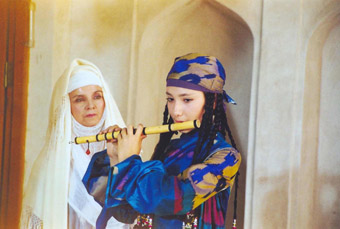
The Road Beneath the Skies
THE 2007 BRISBANE INTERNATIONAL FILM FESTIVAL WAS A CONDENSED AFFAIR OWING TO SWEEPING INSTITUTIONAL CHANGES. DESPITE THE PARTICULARLY BRUTE ILLOGIC WITH WHICH THE NEOLIBERALIST AXE SWUNG THIS TIME AROUND, THE 16TH FESTIVAL NONETHELESS DELIVERED SOME VITALLY SIGNIFICANT FILM EXPERIENCES TO A CITY UNDERGOING AN UNPRECEDENTED FLOURISHING OF FILM CULTURE. OF PARTICULAR NOTE AT THIS YEAR’S BIFF WAS A COMPACT BUT EXCEPTIONAL SUITE OF FILMS FROM THE BROADER ARAB WORLD, WHICH SERVED TO NUANCE AND COMPLICATE OUR UNDERSTANDING OF THE PLURALITY OF TRADITIONS IN THIS ‘OTHER’ CINEMA.
mainline
The emergent female sensibility among the thrilling discoveries in these films was particularly evident in the searing Iranian feature Mainline (Khoon Bazi). This harrowing account of a mother’s desperate attempt to get her heroin-addicted daughter clean in time for the young woman’s impending wedding deliberately raises thorny and highly relevant questions of bondage, dependency and fulfillment in a national cinema known more for, as Frances Bonner has put it, “lushness and poetic ellipses” than the investigation of social problems. Co-directed by Rakhstan Bani-Estemad, whose daughter Baran Kosari plays the main character, Sara, it is a powerful addition to the canon of films largely by and about women and a unique glimpse of middle-class life in Tehran, which is revealed to share the same agonies as any urban centre. Shot in mainly black and white, bar occasional flares of orange for counterpoint, Mainline’s formal beauty never aestheticises its subject, serving instead as an elegant frame for the central grimness of its theme.
barakat
!
Female solidarity, or more precisely, its challenges, is the theme of the Algerian film Barakat! (Enough!, Djamila Sahraoui). This bold film turns on the unlikely alliance forged by two women doctors, Amel and Khadija, when Amel’s husband is captured by militants. Amel, young and idealistic, is contrasted with the battle-hardened Khadija, a veteran of the independence war against the French. As played by Fettouma Bouamari, Khadija, whose gender now separates her from the male guerillas she once fought with shoulder to shoulder, is a magnetic personality. A carefully-calibrated mix of roguish irreverence and coruscating cynicism, her contempt for all dogmas reminds us of the plurality of positions and experiences in Arab cultures. As an Arab film, directed by a woman, whose narrative hinges on the intergenerational tensions between these two formidable, professional women, Barakat! survives the slightly heavy-handed treatment of its ending to offer a potent take on the challenges for post-colonial peoples in neo-fundamentalist times.
truth and beyond
Revising Islam to reflect local culture is the theme of several ‘outsider’ films at the festival, including the thought-provoking documentary, Truth and Beyond (Ahmed Muztaba Zamal), which highlights the centrality of music in Bangladeshi spiritual practice. The film’s prologue explains that Bangladesh is home to two distinct branches of Islam, textual Islam and the little-discussed ‘indigenous Islam.’ The latter predates textual Islam in Bangladesh, and involves practices unique to the region that diverge significantly from those of orthodox Islam. Truth and Beyond explores the ecstatic musical celebrations and community gatherings that characterise this indigenous faith and constitute its otherness from the anti-musical piety of the orthodox tradition. Memorable scenes include improvised musical debates in remote villages; a visit to the followers of the prophet Lalon who embrace Christianity, Hinduism, Buddhism and Islam equally; and a glimpse into the moving ceremony known as the Urs of Saidur Rahman Bayati of Waecia Tarika, where worshippers reduced to tears embrace each other.
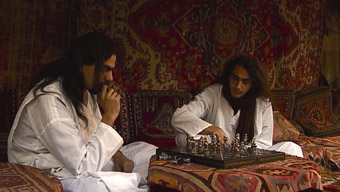
Rumi: the Poetry of Islam
rumi: the poetry of islam
Truth and Beyond formed part of a charming body of films celebrating the legacy of the mystical Persian poet Rumi, among which the remarkable Dervish feature film, Takva: a Man’s Fear of God (Özer Kiziltan), stood out for its gripping examination of the clash of economics, conscience and spirituality (see Megan Carrigy’s response, RT80, p30). Rumi: the Poetry of Islam is a low-key enquiry into the life of this most enduring and well-loved Persian poet. This docu-drama announces its ‘otherness’ from the codified forms of non-fiction film via an almost absurdly dramatic English voiceover and proceeds to ‘cast’ two very different Muslims, a Bosnian pilgrim and an Iranian musician, to portray key scenes from Rumi’s life. These re-enactments are rather awkward and jarring at first, but become increasingly endearing as the film progresses. The friction caused by these atypical, seemingly untutored techniques serves to refresh our conception of the documentary’s scope, and activates our understanding of the lived practices of both spirituality and poetry. By the end, the interviews with scholars, Imams and Rumi acolytes build a compelling argument that Rumi’s work (among the best-selling poetry in the US) can act as a bridge between Islam and the West.
the road beneath the skies
In the folklore mode, the most exhilarating experience, however, was delivered by the extraordinary Uzbekistani film The Road Beneath the Skies (Kamara Kamalova). The film purges the dour realist style of its Soviet heritage for a stubbornly specific local expression which resonates with the poetic work of fellow Central Asian auteur Sergei Paradjanov. The narrative about love and loss, told in dance-allegorical form, is striking in its lush colour—particularly gold, lavender, red, and green—which enhances the profoundly surrealistic sequences threaded through the film. For audiences unschooled in the folkloric traditions of Uzbekistan, it is difficult to know when the material drawn from traditional tales ends and when the filmmaker’s own fabulist inventions begin, such is the alchemy of this fusion of folklore and the filmmaker’s recollected dreams. The quiet poise of the film’s venerable female director and her warm responses to a rapt audience after the screening mirrored the creative assurance of this unforgettable film.
…and some mexican bunuel
Another rare opportunity was presented by the festival’s superb retrospective of Luis Bunuel’s Mexican films. Los Olvidados, Bunuel’s first film in ‘exile,’ is a tragedy that follows a group of street kids surviving the slums of Mexico City. Bunuel’s subversion of neo-realist conventions with the insertion of surrealist interjections serves not to decentre but rather illuminate the characters’ troubled inner lives. Simon of the Desert discards realism altogether, using the story of the saint to explore some favourite themes. As the anchorite maintains a desert vigil atop his pillar, he is met with increasingly ludicrous temptations until an overspent Bunuel “suddenly uses the Devil’s frequent flyer points to joyride his protagonist into a 1960s beat bar” (in Quentin Turnour’s memorable words), abruptly truncating this dizzying parable and concluding Bunuel’s Mexican career.
Despite the brutality of the funding cuts, BIFF managed to triumph on the basis of inspired, sometimes audacious selections. The enthusiastic responses of the large audiences—to so many of the films that weren’t new releases from David Lynch—provided what is to be, hopefully, a satisfying confirmation of the old adage about the best form of vengeance being success.
16th Brisbane International Film Festival; Regent Cinema; Palace Centro Cinemas; Australian Cinematheque, GoMA, Brisbane, August 2-12, www.biff.com.au
RealTime issue #81 Oct-Nov 2007 pg. 20
© Danni Zuvela & Daniel Spencer; for permission to reproduce apply to realtime@realtimearts.net
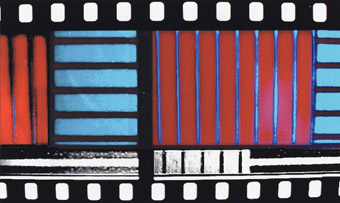
Dresden Dynamo
FOR SOME AVANT-GARDE FILM ENTHUSIASTS, THE IDEA OF A DVD PRESENTATION OF THE HISTORIC WORKS OF THE LONDON FILMMAKERS’ CO-OPERATIVE IS SOMEWHAT PERVERSE. AFTER ALL, IN A GENRE KNOWN FOR ITS OBSESSIVES AND PURISTS, THIS WAS AN ARTISTIC CLIQUE WHOSE MEDIUM-SPECIFIC FOCUS BORDERED ON THE HARDCORE. THE LFMC’S OUTPUT IS FAMED FOR ITS RIGOROUS ATTENTION TO THE MATERIALS OF CINEMA, PARTICULARLY CELLULOID AND THE CINEMATIC APPARATUS.
In breaking down the apparatus into film strip, projector beam and screen, some members of the LFMC took a ‘performative turn’, exploring, in Expanded Cinema happenings, the ‘event’ of cinema and the effects of the filmmaker/artist’s intervention in it. The intensity of attention on the film material itself produced a remarkable body of works and attendant body of theory around ‘structural-materialist film’, a uniquely British school within the international avant-garde of the 1960s and 70s which examined, in minute detail, aspects of exposure, duration, the film strip and the film surface.
We can safely assume, then, that a DVD of work that so intransigently constituted around celluloid reality was always going to have an uphill task convincing the purists. The central question that the production of a contemporary format collection of works whose essence is very much located in another medium was always going to be, ‘how does it work’? The SSS DVD seems to suggest that the answer is, ‘with mixed results.’
Many of the works retain their incredibly rich enunciative power about film itself in the domestic presentation format, and the smaller screen even enhances the analytic possibilities of some of the films on this DVD. Almost all the output of the LFMC can be described as a visual ‘study’ of some sort, attesting to both the availability of the Co-op’s optical printer and the art-school backgrounds and lack of film industry ambition characteristic of LFMC members. The interrogation of movement in Malcolm Le Grice’s Little Dog For Roger (1967), with its Muybridgean fixation on the energetic bounding motions of a small dog, is not noticeably diminished by the digital re-presentation. Jeff Keen’s fun Pop art film Marvo Movie (1967) is faded but remains a kinetic delight powered by hyperactive montage and seductive concrete poetry soundtrack.
The incredible energy and incandescence of Lis Rhodes’ Dresden Dynamo (1971) and Mike Leggett’s Shepherd’s Bush (1971, see RT79, p22), however, are muted in this context. The digital images of these extraordinary experiments (Dresden Dynamo with Letraset directly applied to the film, Shepherd’s Bush with the exposure limits of the new step-printer) are somehow less physical and exuberant than their film ‘originals.’ Even so, the phenomenological address of these films, with their droning, reverberant soundtracks, is so potent that the DVD experience is still quite exhilarating. Taken together with Marvo Movie and Marilyn Halford’s playful Footsteps (showing the filmmaker playing the game known as ‘statues’ in Australia), these films lend some support to the nascent conversation around European structuralist film that is challenging the usual ‘dry formalist’ characterisation of this work, and asserting the existence of more affirmative, even spectacular artistic urges.
It’s important to note that the DVD, like most, does not come with public exhibition rights. For any audience in anything but the home setting to be shown this deeply filmic work from the digital format would amount to a travesty. Given the extensive 16mm holdings and accessibility of the National Film and Sound Archive’s Film and Video Lending Collection, which includes some beautiful new prints of films from the LFMC decade in question, it would be a double travesty for any Australian exhibitor to screen off the DVD.
It’s worth remembering, at this point, the violence committed by the By Brakhage DVD on the rentals of that filmmaker’s prints from various film institutions which previously had depended on those rentals for key income. (It is not yet known how the DVD of Shoot Shoot Shoot has affected print rentals of LFMC films from the primary UK experimental film distributor, LUX, though that institution has shifted its attention in recent years away from distribution activities.)
Avant-garde film on DVD, it would seem, is something of a double-edged sword for avant-garde cinema: on the one hand, it is now undeniably denting the income of certain institutions, which were originally set up by filmmakers to support and nurture distribution and exhibition, and making it harder for educators to justify the costs associated with screening 16mm prints in their courses.
On the other hand, DVDs provide unrivalled convenience of access on a format that can open budding cinephiles to the discovery of 16mm’s unique specificity. As many have pointed out, it’s not just postures of willful self-alienation that have kept avant-garde film largely languishing in obscurity. Questions of access have long blighted the wider understanding of experimental cinema and while these are not entirely resolved with the concession to home entertainment DVD, they are at least acknowledged.
The release of the Shoot Shoot Shoot DVD, with its extensive catalogue notes in English and in French, should also begin to correct the international lack of visibility of the British avant-garde cinema, so long dominated by the canonical Americans. The DVD has been produced for home use, and seen in that context, it is hard to imagine a more ideal introduction to this complex national avant-garde cinema. Contextualised with the notes, the body of works collected on the DVD offers an invigorating tour through an intellectually vibrant cinematic decade, and a critical window, before the onset of the putative ‘post-medium condition’, onto a fascinating field of art practice.
SHOOT SHOOT SHOOT: British Avant-Garde Film of the 1960s and 1970s, 120mins, bilingual English/French booklet by project curator Mark Webber; contains the following films: At The Academy (Guy Sherwin 1974), Little Dog For Roger (Malcolm Le Grice 1967), Shepherd’s Bush (Mike Leggett 1971), Hall (Peter Gidal 1968-69), Dirty (Stephen Dwoskin 1965-67), Marvo Movie (Jeff Keen 1967), Broadwalk (William Raban 1972), Fforest Bay II (Chris Welsby 1973), Slides (Annabel Nicolson 1970), Film No. 1 (David Crosswaite 1971), Dresden Dynamo (Lis Rhodes 1971), Footsteps (Marilyn Halford 1974), Leading Light (John Smith 1975). DVD PAL Region free. Publisher: LUX/ Re:Voir
RealTime issue #81 Oct-Nov 2007 pg. 21
© Danni Zuvela; for permission to reproduce apply to realtime@realtimearts.net
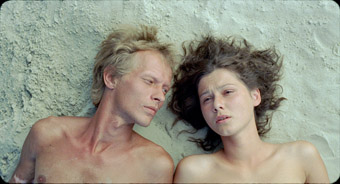
Euphoria
AS THE CONFIDENCE OF THE RUSSIAN FEDERATION CONTINUES TO EXPAND ON BOTH ECONOMIC AND POLITICAL FRONTS THE YOUNG DEMOCRACY FINDS ITSELF ENTERING A NEW AND EXCITING CHAPTER. HAVING SURMOUNTED THE HUMILIATIONS OF COLD WAR DEFEAT AND OVERCOME THE PURGATORIAL RITE OF BEGGING TO WESTERN POWERBROKERS, MODERN RUSSIA NOW FACES THOSE BURNING QUESTIONS OF IDENTITY MET BY ALL EMPOWERED ADOLESCENTS: WHO AM I? WHERE DID I COME FROM? WHAT DO I WANT TO BE? AND PERHAPS MOST IMPORTANTLY, WHAT DO I WANT OTHERS TO THINK OF ME? IT IS WITH THESE QUESTIONS IN MIND THAT CONTEMPORARY RUSSIAN FILMS CAN BE UNDERSTOOD AS PERFORMING AN IMPORTANT DEFINITIONAL FUNCTION.
Since the dawn of the Soviet state, when Lenin supposedly declared cinema to be “the most important art”, Russian filmmakers have borne an exceptional degree of cultural responsibility. Their task is to somehow provide a coherent picture of the largest country on Earth, to express the varied sentiments of the nation’s ethnically disparate and geographically isolated populations while at the same time showing the rest of the world what a centralised and resolute place Russia really is. To achieve this aim the Russian film industry has typically produced an extremely varied output of features. Sophisticated art films and literary adaptations designed for the nation’s urban elites and European festivals are counterbalanced with unpretentious genre pictures: war films, science-fictions and, more recently, melodramas and romantic comedies. Such diversity was again evident last month at the 4th Annual Russian Resurrection Film Festival where the most opaque of existential meditations played comfortably alongside the most formulaic of swashbucklers.
euphoria
At the serious end of this year’s program were two directorial debuts that have garnered considerable praise internationally—Michael Segal’s Franz and Polina and Ivan Vyrypaev’s Euphoria (winner of the Little Golden Lion at Venice and the Grand Prix for Best Film at Warsaw). The latter is a small budget chamber piece that presents a ‘Russiafied’ version of the nihilistic road-movie genre so prevalent in the American independent cinema of the 1980s and 90s. Set in mid-summer amidst the yellow vastness of the Russian steppes, Euphoria’s drama—if that’s what it can be called—centres on a love affair between married mother Vera and the nomadic Pasha and the retribution suffered upon them by Vera’s older, alcoholic and thus hard-done-by husband. An impressionistic work with minimal dialogue, Euphoria conveys its themes of desire and metaphysical abandon less through plot than through sweeping movements of emotion. Otherworldly images, wondrously captured by cinematographer Andrei Naidenov, develop in unison with a superb score by Aider Gainlin to produce an experiential narrative, one in which the viewer’s understanding of the film is less a matter of comprehending the story than of intimately feeling the mise-en-scene, of sensing the atmosphere. At once deeply cynical and texturally beautiful, Euphoria signals a new kind of sentiment germinating in Russia today (one we have already seen in Kirill Serebrennikov’s recent black comedy Playing the Victim). Detached from tradition, here only the present survives, and through it the characters drift aimlessly, content not to think about it. “Thinking”, Euphoria informs us, “only makes it worse.”
franz and polina
More focussed and, I think, rewarding is Michael Segal’s Franz and Polina, so far the winner of Best Film awards at Biarritz and Listopad. Another tragic love story, it tells of an incommunicable bond between a Bellorussian peasant girl and a young German soldier during the tail-end of World War II, at a time when Nazi forces retreating from the Russian front incinerated the inhabitants and villages of occupied East European territories. Perhaps unforgivably naïve to his rulers’ intentions, when Franz suddenly finds himself implicated in the slaughter of innocents he turns traitor to the Nazi cause and escapes with Polina, running a gauntlet of war and merciless winter cold. Plumbing the lower depths of humanity, Franz and Polina (like the best of Russian films) frames its largely speechless human drama in wider horizons, tenuously maintaining an affirmation of life through vivid expressions of natural light and a focus on the living substance of the Earth itself. A finely crafted and beautiful work, it marks the arrival of a considerable talent in director Segal.
beat the enemy
Another film drenched in the Russian love of nature is 80-year-old Vitali Melinkov’s semi-autobiographical comedy Beat the Enemy. Also set in the dying days of World War II, it follows a ragtag propaganda unit’s mission to spread the word of imminent Soviet victory to isolated communities dotted along a remote Siberian river. Standing before Orthodox pacifists, bawdy fisherwomen and the ‘People’s Enemies’ of Soviet gulags, the team present the state’s message with varying degrees of success, prompting premature celebrations from some and the unwavering disdain of others. A gentle comedy, like cheering up a grief-stricken loved one, Beat the Enemy defuses its nation’s deeply troubled memories of totalitarianism with a well-worn Russian strategy. Ideologues (the source of all human suffering) are rendered as morons while the normal folk simply go about life as best they can under the shadow of ridiculous tyranny. Not a flawless approach by any means—after all, bullets have a habit of tearing through denial—but nevertheless one way to maintain a degree of dignity in the face of unfathomable cruelty. Beat the Enemy had its international debut at the festival, opening the seasons in Melbourne and Adelaide.
day watch
Now to the populist end of this year’s program, and to two films, Day Watch and Wolfhound, that emphatically signal Russian cinema’s ascension to a new level of high budget filmmaking. The hotly anticipated sequel to the huge international success Night Watch, Timur Bekmambetov’s Day Watch, picks up where the first film left off, utilising a wilfully daft narrative premise involving a shaky truce between good and evil vampires simply as a launching pad for delirious outbursts of cartoon violence and manic stylistics. A wild and genuinely funny ride, Day Watch is more expensive and ambitious than the original, layering its Gilliamesque world with a technical maximalism reminiscent of Hong Kong director Tsui Hark and the surface level aesthetics of the cinéma du look. At times verging on pure abstraction in its sound and colour designs, what Day Watch lacks in terms of characterisation and narrative logic drifts by inconspicuously beneath a lovingly woven fabric of cinematic excess. Less a story than a sideshow, Day Watch is yet another example of the contemporary action film’s reversion to the early cinema of attractions: an incomprehensible pleasure which will no doubt draw the young’ns away from their gaming consoles when Fox Searchlight distributes it nationally in October.
wolfhound
Unfortunately, the same kind of praise cannot be bestowed upon Nikolai Lebedev’s equally ludicrous sword and sorcery epic Wolfhound, which, somewhat inappropriately, opened the festival in Sydney. Adapted from the best selling novel by Maria Semenova, the film contains all the elements you would expect from something of this kind: a revenge driven hero, a blind magician sidekick, a benevolent princess, her conniving cousin, a powerful phantom menace, a fairy godmother, potentially disastrous setbacks on the way to victory and a delightful pet bat thrown in for good measure. Alas, the ingredients alone don’t make the soup, and where Wolfhound abounds in good intentions it remains seriously lacking in the sophistication of character and wit that international audiences now expect from such romps. Although a massive domestic success, this bell won’t ring in the West; further proof that when Russia tries to emulate the US it always comes off second best.
up off its knees
Other new films to feature on the festival’s programme included Andrei Eshpai’s
menopausal romance Ellipsis, Igor Maslennikov’s costume satire Russian Money, Rezo Gigineishvili’s sex comedy Heat and Pavel Lunghin’s monastic drama The Island, which I reviewed earlier [RT77, p19]. A disparate mix to say the least, but in all a strong indication of a national industry “getting up off its knees” (to use a current national slogan) and moving on with confidence. It’s been a long time down and out for Russia, from Stalin to Brezhnev to Putin. Now it seems the time has come for its resurrection.
4th Annual Russian Resurrection Film Festival, Sydney, Melbourne, Brisbane, Adelaide, Perth, Canberra, Aug 30-Sept 16
RealTime issue #81 Oct-Nov 2007 pg. 22
© Tom Redwood; for permission to reproduce apply to realtime@realtimearts.net
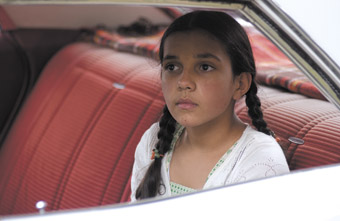
Back Seat
IN THE WAKE OF TROPFEST, INCREASINGLY SHORT SHORT-FILMMAKING HAS BECOME A FECUND TRAINING GROUND FOR WOULD-BE FILMMAKERS AND OTHER FANTASISTS USING LOW COST, HIGH-TECH EQUIPMENT AND FILLING THE LISTS OF EVER PROLIFERATING SHORT FILM FESTIVALS OR BROADCASTING THEIR DIY ON YOUTUBE AND ELSEWHERE. WILL A VIABLE MARKET FOR SHORT FILM ONLINE, ON-PHONE, IN I-POD EMERGE IN TANDEM WITH THE RUSH OF SERIOUS NEW MAKERS? PERHAPS THE AUSTRALIAN FILM COMMISSION’S INDIGENOUS BRANCH THINKS SO.
The wonderful short films of 10-30 minutes (and several 50 minute features) that came out of the AFC Indigenous Branch’s Sand to Celluloid initiative over some 12 years provided evidence of a talented generation putting to good use the carefully constructed programs and partnerships available to it (involving the AFC, SBSi, FTO, Film Australia and other screen organisations and committed individual producers). The Indigenous Branch’s latest initiative, however, has gone with the trend, commissioning 13 five-minute films, offering more opportunities for a larger number of mostly emerging filmmakers than the three to six films made for each of the earlier programs.
Aptly titled Bit of Black Business, the films made for the initiative are precisely that, works tackling issues that continue to preoccupy Aboriginal people and their filmmakers. They attempt to sustain a collective sense of culture and individual dignity, often against great odds, but not without wry humour. In this collection, there’s a marked sense of the viewer engaging face to face with the characters. It’s as if, in grappling with limited duration, the makers have for the greater part decided to work intimately, creating brief narrative episodes from larger lives and shooting often in close-up and frequently with faces looking into the camera. The point of view of children, adolescents and young adults is recurrent as they admire or are mystified by or painfully detached from people much older than themselves.
In Michel Blanchard’s Custard, a young woman visits her home in beautiful waterside country to see her grandmother whom in the voiceover she recalls as tiny and unwell, but also how she made custard for the family. The house is not one she recalls lovingly, deploring the memory of a sick old grandfather shuffling about in the night. She sits with the grandmother in the kitchen and then by the water, the depressed older woman worrying at what killed her husband—alcohol, cancer, schizophrenia (“We’ll all get it now. Oh well, what’s one more thing?”). Back in the kitchen, the young woman pretends to read to her grandmother from the death certificate: “You know what killed him? Acute custardisation.” They laugh and, for a moment, the darkness is dispelled. It’s all that can be done and perhaps it’s enough. She leaves. Murray Lui’s cinematography glows with the glitter of sun on the water and there’s almost a sense of nostalgia in the warmth of the light on the greens and browns of the countryside. It’s just right in tempering the sadness the film generates, that sense of melancholy about the distance between the older and the younger woman. Wisely avoiding dramatic action and focussing on stillness and reflection, Custard makes its five minutes feel satisfyingly full.
Martin Leroy Adams’ Days Like These vividly portrays a growing sense of despair in the face of racism as a young black boxer, urged by his mother to find work as the household bills accumulate, barely gets to first base on most of his interviews despite looking good and behaving well. He has no criminal record but the fact that his father is in prison is enough to guarantee rejection. Beaten up by hostile white boys, he is found by cops, one of whom growls, “Hello, monkey.” It’s a brisk, blunt film, shot with a casual documentary feel. The opening, with the boy in a boxing ring, has him punching at us in extreme close-up. It’s a confronting image and the rest of the film suggests where his anger and strength might be coming from.
Back Seat by Pauline Whyman is one of the strongest films in the collection. It opens with us face to face with a 12-year-old girl in the back seat of a flash American car on her way with her white foster parents to see her Aboriginal mother, brothers and sisters. As in Custard, there’s a feeling of disconnection, again kept at a distance from melodrama and textured with a touch of nostalgia—the car, the stepmother’s hairstyle and the black mother’s home furnished with middleclass thoroughness, intriguing artworks and nicknacks and populated with neat children.
Back Seat deftly lets the story tell itself in close-ups of the girl. She doesn’t get to speak for herself—her stepmother over-eagerly listing the child’s school achievements, crowning it inadvertantly with “I don’t know where she gets it from”). The girl is too shy to communicate with her siblings who giggle at her, so she seeks refuge in the back seat of the car, winding up the window, shutting herself off from the mystery that is her life. A sister cajoles her to return for a group photo, a Polaroid shot which she fingers softly as, soon, the car pulls away and she looks longingly out the rear window. Back Seat implicates the viewer with a heightened subjectivity as we come face to face with an emotionally impossible situation, but at least there’s affection and yearning even if the distance between the child and her real family seems vast. It’s a very different account of a Stolen Generation life, but the same sad story nonetheless and based on the filmmaker’s own. (See also p19.)
Warwick Thorton is an experienced cinematographer (Radiance and many short films) and writer-director (Green Bush). Nana is his tribute to Aboriginal grandmothers. He said, on the opening night of 2007 Message Sticks Film Festival at the Sydney Opera House, venerable Nanas can do what they wish and they can be ‘wicked.’ Again, the point of view is a child’s, a five-year-old, the camera alternating between her and Nana, facing us as they see each other: Nana cooking, later Nana taking food to older people in the district, Nana conning white buyers of Indigenous art, Nana, rifle in hand, catching food (a volley of shots and a close-up of the bodies of wallabies and lizards slapped onto the bonnet of her car), Nana and an aunty on night patrol apprehending alcohol smugglers, throwing the booze into the bush and mercilessly beating up the offenders with big sticks. In a reverse shot the little girl, sitting in the car, looks on, bemused, admiring. The film is a little comic shocker made with electrifying assurance.
Jacob Nash’s Bloodlines is a simple but effective account of a young man building up the courage to telephone the mother from whom he was separated as a child. But we don’t know that until the end of the film. He lives in a stylish, comfortable apartment. He’s naked except for shorts, amplifying his vulnerability, and nervous, the soundtrack beating like a heart. He puts off approaching or even picking up the phone. We look into his face and then, with him, at the photographs of the white family of which he is a part but, at the same time, not. Nash’s approach is simple but focused and intense.
In Kelli Cross’ The Turtle, a boy in early adolesence, withdrawn, baseball cap over his eyes, earphones plugged in, arrives in a remote coastal town where he’s picked up by an uncle who takes him to where his father lived. The lone possesion is a tortoise shell: “all he left behind.” The boy won’t budge. He’s here because he’s been in trouble, presumably with the law. When his uncle can’t start his boat, the boy starts it for him, is persuaded to go out on the water and then, astonished to suddenly find himself in the water at his uncle’s prompting, flips over a turtle, thus disabling it. In a mere moment he has reconnected, however tenuously, with his father and his culture. Like Custard and Back Seat, the mood is reflective and considered, although here there’s a sense of release despite the enormous distance between son and dead father.
Sharpeye by Aaron Fa’aaso is an intruiging tale of a 12-year-old Torres Strait Ilsander boy playing spy for the local army reservists when their island is invaded during a military exercise by Special Forces. The plot is slight and we learn little about the boy, but we do get a strong sense of the pride of these part-time soldiers (elaborately uniformed and equipped with the best) and especially of their joy in victory, which they dance like their warrior forbears.
Trisha Morton-Thomas’ Kwayte has its moments and again they’re built around a child, here a three-year-old. It’s her birthday and her father has arrived home in the morning with a hangover. His wife won’t speak to him and his little daughter supplies him with glasses of water, one after the other, which intially he needs and later feels obliged to accept and which it turns out she has taken from the toilet bowl. The apparently benign “little princess” with her crown and wand has punished her delinquent father—but will she transform him? The ending feels a little thin, but the film’s construction is tight, and the little girl is engaging.
Adrian Wills’ Jackie Jackie has the look of a John Waters movie. An Aboriginal girl, Jinaali, works on the checkout in a sleek supermarket, Sunnyshine, otherwise staffed with glam white checkout chicks in plastic wigs. She hangs up a cardboard sign over her cash register saying “Equal Opportunity Line” and accrues a long ultra-multicultural queue of customers. But our heroine’s appoach is too casual for the grumpy store manager, who would prefer “ladies’ best friend” to “tampon” for her amplified price check. After he castigates her in front of the customers, Jinaali unleashes an Anthony Mundine toy on the manager and then tackles him herself, joyfully denouncing him as racist. It’s light as a souffle and good to look at, but the dialogue is clunky and the film is not as funny or political as it could be, but Wills has a certain verve. (See also p19.)
Of the 10 films in this collection that particularly appealed to me (a high ratio for a 13-film set), some handled their five minutes better than others, but most avoided the temptation to make economy versions of feature films, still a common impulse in short filmmaking where the product is seen as a stepping stone to greater things. The directors were certainly blessed with the guidance of producer Kath Shelper and the mature artistry of the cinematographers, editors and sound staff who worked with them in generating spare narratives and strong images in mere screen minutes. Bit of Black Business does its emerging talent proud, doubtless encouraging the emergence of another generation of fine filmmakers.
–
AFC Indigenous Branch, Bit of Black Business, directors Martin Leroy Adams, Jon Bell, Michelle Blanchard, Kelli Cross, Dena Curtis, Aaron Fa’aoso, Debbie Gittens, Michael Longbottom, Jacob Nash, Trisha Morton-Thomas, Warwick Thornton, Pauline Whyman and Adrian Wills, producer Kath Shelper, Film Depot, Indigenous Branch of the Australian Film Commission, SBS Independent, New South Wales Film and Television Office and ScreenWest, 2007
RealTime issue #81 Oct-Nov 2007 pg. 23
© Keith Gallasch; for permission to reproduce apply to realtime@realtimearts.net
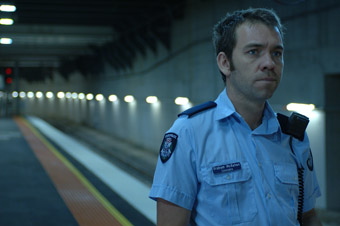
Noise
WRITER-DIRECTOR MATTHEW SAVILLE HAS REALISED THE PROMISE HE SHOWED IN ROY HOLSDOTTER LIVE (52MINS, 2003) WITH NOISE (108MINS, 2007), A SHARPLY OBSERVED, SUSPENSEFUL AND OFTEN QUIETLY FUNNY ACCOUNT OF A NAIVE YOUNG POLICEMAN (GRAHAM MCGANN PLAYED SUPERBLY BY BRENDAN COWELL) STRUGGLING WITH TINNITUS, INCIPIENT DEAFNESS AND THE FEAR OF SOMETHING WORSE, LIKE A TUMOUR. HE’S UNKNOWINGLY ON A FATEFUl JOURNEY AMIDST MURDER INVESTIGATIONS IN SUBURBAN AUSTRALIA. WITH THE TINNITUS AS THEIR STARTING POINT, SAVILLE, COMPOSER BRYONY MARKS AND SOUND DESIGNER EMMA BORTIGNON; HAVE CREATED ONE OF THE MOST INVOLVING, HAUNTING AND DEEPLY INTEGRATED SOUND WORLDS IN AUSTRALIAN CINEMA.
Noise warrants a more detailed response to its construction, cinematography and performances than I can offer here. I want to focus on the sound. There’s a handful of Australian films in which sound plays a significantly heightened role. I admired Kiss or Kill (1997) directed by Bill Bennett with its heightened buzz of the outback, of wind and wire, for being eerily music-less (sound design Wayne Pashley, Toivo Lember, Gethin Creagh, Best Achievement in Sound, AFI Award 1997). A friend reminded me recently that the sense of interiority achieved in Rolf de Heer’s claustrophobic Bad Boy Bubby (1993) had been created in part by using a binaural head microphone (sound design James Currie, microphone engineer Frederick Stahl). In Matthew Saville’s Noise, Graham’s aural world and ours, alternates between sharply etched everyday sounds (trains squeal, a spoon in a cup clatters, a toy car roars, a street light buzzes) and the painful high, thin hum of the policeman’s tinnitus, competing with and muting the world.
The music score too has a wiry hum, filling out, as the tension builds, with a deep, dark ostinato. Through-composed, it moves deftly across narrative strands (not all the scenes focus on Graham) connecting episodes and enhancing a sense of continuity and escalating tension.
Small details relating to sound are threaded through the narrative—the murder witness wears headphones, one of the reasons she doesn’t at first see the bodies littering the carriage she enters (in later flashbacks to this episode we hear the high treble screech from the phones when she pulls them off); Graham says he’s not getting a signal on his walkie-talkie in the railway station; his girlfriend is gradually revealed to be a trombonist in a police band; she offers a theory of phasing to suggest a way his condition might be treated; words are calculatedy misheard (a senior cop replaces tinnitus with tinea). In contrast to these moments or a momentary focus on a sound (often with a close-up of the object—a grasscutter, a fax machine) there are three key events which envelope Graham and come close to overwhelming us with their sonic intensity.
Distraught with the pressures of home, job and his intermittent but growing deafness, Graham turns on everything in his apartment that can make a noise—radios, alarms, TVs, taps and a giant sound system and sits amidst it all, expressionless, face to face with us, sharing the roar but also an inescapable, tourtuous high pitched whine. In a subsequent episode he finds himself in a sudden fog of deafness, panicky, fighting off his girlfriend’s reassuring touch and, like us, unable to make out her distant blurred words. In the film’s climax, the murderer fires a shotgun into the police caravan that Graham inhabits for a good part of the film (a little sonic cosmos in itself). The blast deafens Graham and, as the killer pursues him and the policeman fires back, we enter two aural realms at once. It’s as if we’re in the deafened man’s occluded world while at the same time taking in the escalating aggregation of Carols by Candlelight (where the girlfriend is playing) on the police caravan televison, Graham’s high whimpering as he struggles to reload his gun, a locked car horn, a baby crying and finally a police helicopter roaring above, its spotlight cast down on Graham like a ray from heaven, offering grace.
The sound we hear now above all is of words recalled from a few scenes earlier when, in a philosophical moment, Graham mused over the prospect of eternal life after death. He speculated that in the “nanoseconds of dying…if all the time you were a fuckwit” you’d be doomed “to be a fuck-knuckle for eternity.” But “if all the time you managed in your life not to be an embrassment, that would be heaven.” In the end Graham is a hero. Our growing empathy for this apparently obtuse young man, out of kilter with his job and his partner, but whose quiet wit has become evident in exchanges with nightshift visitors to the caravan, has been principally developed through virtuosic deployment of sound and music evolving out of and working in perfect tandem with Matthew Saville’s expert script and by placing us deep inside the aural action.
Noise, writer, director Matthew Saville, cinematographer László Baranyai, editor Geoff Hitchins, composer Bryony Marks, sound design Emma Bortignon, producer Trevor Blainey, Retro Active Films, Australian distributor Madman Films
See giveaways (p56)
RealTime issue #81 Oct-Nov 2007 pg. 24
© Keith Gallasch; for permission to reproduce apply to realtime@realtimearts.net
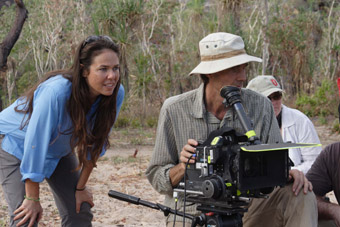
Darlene Johnson and Kim Batterham on location, Crocodile Dreaming
THIS YEAR’S WORLD OF WOMEN (WOW) FESTIVAL OPENS WITH TWO VERY DIFFERENT FILM EXPERIENCES. IN ROSALIND GILLESPIE’S CLIMBERS, A GROUP OF WOMEN TACKLE DEMONS, INCLUDING INNER ONES, AS THEY ATTEMPT TO SCALE MT EVEREST. IN DARLENE JOHNSON’S CROCODILE DREAMING, THE POWER OF A MOTHER’S TOTEM IMPACTS ON THE LIVES OF HER SONS EVEN AFTER HER DEATH.
Climbers (16mm, 29 minutes) was made in 1980 and features the work of Margaret Barr, the influential choreographer and teacher who worked in Sydney from the 1950s creating a body of work motivated by strong social and political concerns. Barr’s 1976 dance drama is restaged and filmed in her studio using ladders, ropes and platforms to depict the tortuous journey. The allegory of women’s struggle for liberation is infused with heroics, acrobatics and some bracing 80s feminism.
In Darlene Johnson’s Crocodile Dreaming (26 mins), the rhythm of a tale spanning time immemorial is cleverly intercut with cultural complexity, full-on suspense and some impressive effects. We’re invited into a private realm reminiscent of David Gulpilil’s own in which the keeper of the clan’s knowledge is also a film star. In a jokey scene, we see Gulpilil abandoning his role in an advertising campaign for more serious matters in his other world, back home, where his half-brother, played strongly by Tom E Lewis, is paying the price for messing with the natural order.
The WOW program offers emerging and established female filmmakers the opportunity to enter short works (up to 55 minutes and from any genre) within a thematic perspective of “seeing the world through the eyes of women.” The weekend of October 25-26 will be a celebratory gathering and a showcase for the talents of female directors, producers, writers, editors and cinematographers in the Australian film industry and in Oceania. On Friday night, 25 October, the finalists in the short film festival will be screened and awards presented.
This year, following the festival, the WOW Tour, comprising four curated screen programs including the finalists in the competition, will travel to over 18 national, regional and remote locations in Australia.
A forum, “From Conception to Screen” will be held on Friday afternoon where industry guest speakers will explore the skills and processes required to progress an idea from its conception to a final product shown on screen, via mobile phones or as a website download. Guest speakers will be videoed and a DVD made for screening/discussion along with industry programs to accompany the WOW touring event.
A selection of works from the Mobile Journeys exhibition curated by d/Lux/Media Arts/ will be featured in the foyer. This exhibition highlights new mobile telephone technologies linking with filmmaking genres. A Bluetooth Zone where exhibition creative pieces will be “zapped” directly to guests’ mobile phones for viewing will be a feature of the exhibition. There is also a new category: an iDRINX award and prize for the best viral, a short film/video up to three minutes in length designed for internet viewing.
WOW Festival 2007, Chauvel Cinema, Sydney Thursday-Friday 25-26 October. For more information: Sil-Nyin Cameron, Festival Director/Co-ordinator wowfilmfestival@nsw.wift.org
RealTime issue #81 Oct-Nov 2007 pg. 24
© Virginia Baxter; for permission to reproduce apply to realtime@realtimearts.net
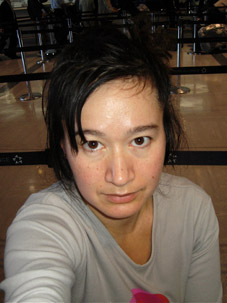
Hito Steyerl
photo courtesy of the artist
Hito Steyerl
IN THIS YEAR’S DOCUMENTA IN KASSEL, GERMANY, HITO STEYERL SHOWED THREE WORKS: JOURNAL NO 1—AN ARTIST’S IMPRESSION; LOVELY ANDREA; AND RED ALERT. THESE REVEAL THE IMPORTANT CONTRIBUTION THAT STEYERL, A GERMAN BASED ARTIST OF JAPANESE HERITAGE, IS MAKING TO FILM PRODUCTION WITHIN A CONTEMPORARY ART CONTEXT.
Artistic film, as opposed to video installation, sits uneasily in the exhibition framework. While video installations often have a rhizomatic structure, viewed as easily in the beginning, middle or end, the more linear time structure of film, which requires a viewer to be present at the beginning and stay at least for most of the film, has presented some exhibition challenges. This year the artistic director of Documenta 12, Roger Beurgel, claimed to have solved the problem by returning film to the cinema, offering an extensive program in conjunction with the main exhibition.
Steyerl’s innovative and challenging work has ensured its being primarily viewed within an art rather than a cinema context. Even in Documenta 12 her two longest video works were exhibited as projections in the key exhibition venues. Steyerl’s work stood out as unique given the marked decline in film work as a whole between Documenta 11 and 12, especially for the form of film Steyerl has been most interested in—documentary. In an interview with her in Berlin in June this year, she explained to me, “there has been a tremendous, conservative backlash in parts of the art world aimed at socially engaged art, which was subsumed under the derogatory identifier ‘documentary’ as opposed to ‘art’.”
Steyerl is quick to point out that mainstream documentaries should not be discussed as ‘art’, unless there is experimentation or formal contestation of the form of documentary making. She remains interested in works which challenge our preconceptions of what a documentary should do. Her own works have consistently explored ideas such as the relationship between fiction and truth, viewer, subject and filmmaker, and the subjective and objective within the documentary cannon. As she explained in a recent article “Documentary Uncertainty”, “terms like ‘truth’, ‘reality’ and ‘objectivity’ and so on are characterized by the lack of any generally valid interpretation and of any clear cut definitions. Thus we are faced with the first paradox: the documentary form which is supposed to transmit knowledge in a transparent and clear way has to be investigated using conceptual tools which are neither clear nor transparent.”
Journal No. 1—An Artist’s Impression deliberately explores this very paradox. Journal No 1 was the title of the first monthly Bosnian newsreel made in 1947 which was lost in 1993 during the Yugoslav war. This newsreel shows, among other things, images of Muslim women learning to read and write in the secular post-war Yugoslavia under Josip Broz Tito. In her film, Steyerl attempts to reconstruct the newsreel by inviting two staff members from Film Museum Sarajevo to recount its contents to an artist, Arman Kulasic, who sketches their memories. The two accounts of the missing newsreel, however, differ both in the recollection of its contents and its eventual fate. Steyerl then attempts to find the missing film in a search across the new post-war Croatia.
Steyerl eventually finds the newsreel in a house it was taken to for safe storage. But it was burnt in the war, its charred condition rendering it unwatchable: the ‘truth’ of the accounts of this newsreel thus remaining forever unverifiable. The film ends with the artist Arman Kulasic explaining his own experiences of ethnic cleansing during the war and his difficulties in getting a visa to travel to the USA after 9/11 because of his Muslim background. Steyerl’s detective-like search for truth thus ends up creating as many questions on the nature of documentary making as it does on the Yugoslav war and war more broadly.
But while Steyerl is interested in exploring the murky relationship between the representation of fact and fiction in documentaries she is not interested in abandoning the quest for truth altogether. She explains that truth, “as constructed or artificial as it might be”, is the “precondition of any political sphere which deserves this name.” She goes on to say that “as Hannah Arendt pointed out truth is indispensable in political terms. Arendt didn’t mean absolute truth, but simply an agreement about material facts. If this is jeopardised then we have a huge political problem.” So while Journal No. 1—An Artist’s Impression may complicate our preconceived ideas about the Yugoslav war and historical and contemporary documentary making, it does not give up on the idea of understanding and truth as being crucial for political reconciliation and justice.
In an interview about his 1972 film with Jean-Pierre Gorin, Tout Va Bien, Jean-Luc Godard commented that the task for filmmakers, or artists more broadly, is not to make “political films” but to “make film politically.” Hito Steyerl’s films are undeniably “political”—covering subjects such as racism, war and terrorism—but what makes them so interesting is her attempts to construct them politically, to unpick and explore her own position within the framework of filmmaking.
This was very apparent in her 2004 film, November, which was screened in Australia as part of the If You See Something, Say Something exhibition (co-curated by Keg de Souza and myself) at Gallery 4a in January 2007 (RT78, p46). Here she combines old footage she shot as a teenager with her friend Andrea with a contemporary documentary about Andrea’s later involvement as a freedom fighter during the war in Kurdistan, and her eventual murder. The juxtaposition of the earlier feminist action movie—the teenagers create a gang of female outlaws who roam around intimidating men—with the footage of Andrea’s death creates a moving exploration of the transition from idealism and youthful political fantasy to reality. While Steyerl is obviously admiring of her friend she is careful not to posthumously create a heroine. The title November was chosen because of its position after October—the month of the Russian revolution—and describes a time of disillusionment and exhaustion after intense political struggle. In November Steyerl works through feelings of grief at her friend’s death as she seeks an understanding of the political factors which shaped her fate.
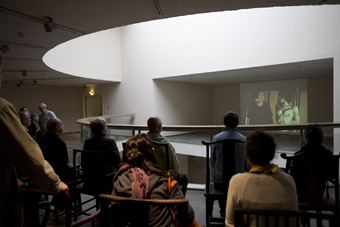
Hito Steyerl, Lovely Andrea, installation, Documenta 12
At Documenta 12, Steyerl loosely returns to her friend in the film Lovely Andrea (shown in the atrium of the Fridericianum). The title comes from a character, “Lovely Andrea”, Steyerl created as a tribute to her friend when the filmmaker herself posed for bondage photographs while in Japan in 1987. Lovely Andrea unfolds like a detective story as Steyerl returns 20 years later to Japan to locate the magazine which published these pictures—a quest, unlike the one for the Bosnian newsreel, in which she is ultimately successful.
Lovely Andrea is an extremely visually seductive and entertaining film. Steyerl focuses on the nawa-shibari style of bondage which involves the capture and suspension of women in the air by ropes. She explores this notion with a young Japanese aerial performer who acts as a quasi guide for Steyerl through the world of contemporary Japanese bondage. The film includes several shots of this woman suspended by ropes, performing various bondage scenarios and intercut with popular culture references including Spiderman, The Pet Shop Boys and Wonder Woman. The film moves like a detective thriller-visual interest sustained through the search and eventual discovery of the pictures.
When discussing the film Steyerl explains that her interest in bondage was not just about finding a missing piece of her own history but was an allegory for modern society. She draws on a 1930 text by Siegfried Kracauer, The Ornament of Mass, in which he described a performance by a group of showgirls, The Tiller Girls. Kracauer was fascinated by how the performers would move their legs as if they were being mass produced on an assembly line. Steyerl explains, “he made a point of choosing a humble, if not outright silly and over-commodified example from mass culture to interpret it as a reflex of the dominant conditions of production of this time: Taylorism. He understood that one shouldn’t complain about this type of culture, but move right through it. The total abstraction of disconnected limbs was not only a machine in the sense of an assembly line, but also presented a way beyond the fateful implications of the ‘natural body’, which became horribly explicit in National-Socialist race policies shortly after. It could not just be read as an allegory of economic bondage, but also the first announcement of its overcoming.”
According to Steyerl the link between this 1930s exploration of the body and her own work is that she sees the self-suspension performance, which the main protagonist of Lovely Andrea develops, in a similar way: “first of all, it is a reflex of an economical situation of self-entrepreneurship, in which we have internalised authority to a point to incorporate both ‘master and slave’ within the same individual. One motivates oneself, pushes oneself to work to the point of self-exploitation. But on the other hand this performance doesn’t stop at visualising this practice, but utilises the same tools that would normally be used for bondage and submission in order to create something completely different. Actually, this performance is much more about flying and floating, about overcoming gravity than about captivity and passivity. So this performance goes right through bondage into a different direction.”
Lovely Andrea is a very ambitious film—attempting to draw from Steyerl’s brief encounter with bondage many allegories about contemporary society. But the comic and at times literal way she does this—particularly her reliance on visual equivalence between the ropes of bondage and the internet as the modern web of life—can come across as a little forced. While Lovely Andrea loosely refers to Steyerl’s attachment to her friend Andrea it does this without the personal involvement which made November so powerful. In many ways it feels like Steyerl is shielding herself, a position at odds with the task the film set itself—the discovery of youthful bondage photographs of the artist. But the film is very clever and interesting if a little less resolved than Steyerl’s other work
Red Alert is a three screen red monochrome video representing an experiment by the artist in abstract video documentation and is a meditation on the 1921 painting of three monochrome canvases by Aleksandre Rodchenko, Pure Red Color, Pure Yellow Color, Pure Blue Color. Rodchenko wrote of these paintings, “I reduced painting to its logical conclusion and exhibited three canvases: red, blue and yellow. I affirmed: It’s all over. Basic colours. Every plane, it’s a plane and there is no more to representation.” Steyerl refers to this avant-garde gesture when she writes, “Red Alert translates this work into video, the assumption being that of these three primary colours only the red one is left. This red is actually based on the colour used by the US Homeland Security office for their highest alert level. It is, if you like, the colour of contemporary fear itself. On the other hand, this work also shows the limit of video, since the moving image has to be frozen in order to translate it into a painting format. And video or concrete representation of reality reaches its limit in the end of constant online transmissions which convey just abstract fear as such, with a minimum of concrete mediation.”
Two of Steyerl’s films, November and The Normality, were shown at the gerMANY FACES australia festival as part of the videokunst.de symposium curated by Anna Munster at the College of Fine Arts, Sydney, Sept 23.
RealTime issue #81 Oct-Nov 2007 pg. 25
© Zanny Begg; for permission to reproduce apply to realtime@realtimearts.net
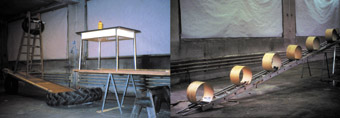
Peter Fischli and David Weiss, Der Lauf Der Ding/The Way Things Go
THEY SAY EVERYBODY WANTS TO BE 21. ANY YOUNGER AND YOU THIRST FOR FREEDOM FROM YOUR WORLD. ANY OLDER AND YOU WISH YOU COULD HAVE IT OVER AGAIN. EXPERIMENTA’S AWKWARD PHASE IS NOW OFFICIALLY OVER; WITH TWO CONFIDENT AND POPULAR EXHIBITIONS IN HOUSE OF TOMORROW (2003) AND VANISHING POINT (2005), THE ARRIVAL OF THIS YEAR’S EXPERIMENTA PLAYGROUND REPRESENTS THE BIG PUSH FOR THE ORGANISATION. BIG ENOUGH, IN FACT, TO NOMINATE ITSELF AS THE INTERNATIONAL BIENNALE OF MEDIA ARTS. THE RESULT WAS A CONFIDENT AND ARTICULATE EXPERIENCE THAT SURVEYED SOME OF THE MOST INTERESTING WORKS OF RECENT YEARS, WHILE PROVIDING A MAP FOR THOSE NEW TO MEDIA ART.
The inclusion of Peter Fischli and David Weiss’ video work Der Lauf Der Ding/The Way Things Go (Switzerland, 1987) is an example of the latter; a keystone of experimental art practice that has the instant effect of grounding the viewer on the sensory level. A series of reactions and actions unfolds as an elaborate version of Mouse Trap ricochets across the periodic table with abandon. A tyre rolls down a board setting a pulley in motion that ignites a match that sparks a coal fire, and so on. Though this and a number of the other works are now freely available, including via YouTube, the environment of the playground needs its swings and roundabouts—the perennials and milestones that mark the borders of the sandpit. The Way Things Go should really be part of the science curriculum at high school level; it’s messy, permanently and viciously DIY and still boggles the mind’s eye 20 years on from its creation.
Alongside a number of other video works, this subdivided room of “extreme art on screen” set the tone—making a compromise between accessibility and confrontation. During four visits, I saw the same dynamics: people flocked to the work least likely to appear on DVD. Interactive art came first, especially for children. Only then were the video works taken in. The Black Box gallery was perfect for the collection, and the low light conditions were soothing without being soft.
Giant interactive teacup rides courtesy of Shu Lea Cheang’s Baby Love (2005, RT76, p23) were the main attraction for most, but the meat of the exhibit was in the smaller works that required touch, or its similitude.
In Double Fantasy (Jennifer and Kevin McCoy, USA, 2005), the dream worlds of two children are assembled with miniature tiny trees and buildings. Two meticulously constructed dioramas lie back to back and are suspended in mid-air, a squid-like array of metallic arms curling out from the sides and winding back to point cameras at the tiny figures on either side. A projector rifles through the angles which are carefully plotted to use tilt and deep focus, and we see the stories unfold. On one side, a grim but baroque battle scene, on the other, a joyful wedding in a chapel. The result is as much a paean to romantic imagery as it is deconstruction. The soft light and off-kilter situations are dreamlike and whimsical, soaked in nostalgia. The natural urge was to twist the camera arms to new positions; so common was this impulse that Experimenta had to staff the artwork with an apologetic young minder—play has its rules and regulations. Still, the decision to frame the artwork as open sculpture and allow visitors to examine it from all angles is fair trade for the lack of interactivity. (For more on the McCoys, see RT78.)
As a child you looked up from your bed, watching branches move in the wind through the window. Seeing grim shapes in the half-light, you made horrible things come to life. In Philip Worthington’s Shadow Monsters (UK, 2005), a plain white projection invites closer inspection, for which you have to cross in front of a divider. Immediately, you sense the projection is coming from below and not above; and not only that, but you’re a horrible freak. Your shadow is captured and relayed onto the wall in front of you with a slight delay, with monstrous additions such as tentacles, hairs, spines, spikes and gawking eyes on stalks. Move your hands to make a shadow-play duck and the duck will grow fierce teeth while belching out a grey cartoon cloud. The whizz and pop of the accompanying sound cues complete the circuit. The projection and capture mechanism has been refined and changed after a number of international showings, but the iteration at Experimenta Playground is as good as it gets.
In a similar way, The Manual Imput Station (TMEMA aka Golan Levin and Zachary Lieberman, USA, 2004-2006) whittles away expectations as you approach a nondescript overhead projector with a handful of shapes and numbers on a table. Casting your hands into the beam doesn’t produce any results at first. Only when your fingers cross, or you use one of the letters and shapes to form an enclosed form, does the play begin. Form an ‘O’ with your thumb and forefinger and the shadow ‘O’ on the wall lights up in yellow, promptly ‘falls’ as a virtual object, and bounces away with the sound of rolling glass. Before you know it you are are causing smaller shards to rain and shatter. The work generates scientific curiosity; it would be equally at home in a children’s science museum.
Narinda Reeders’ Help Yourself (Australia, 2007) is immediately one of the most effortlessly inquisitive and deliberate pieces of interactive art seen for some time. Parodies of ATM routines have been mounted before, as have playful versions of self-help culture. Their natural combination in Help Yourself is immediately recognisable and satisfying. Your on-screen guide, Lydia, who cannot hear the commands you speak into the microphone very well, is likely to berate you, and will somehow abuse your trust. Advice is generated almost incoherently and always aimed at the heart. Anybody who has experienced the dark wit of the woman inside Westpac ATMs will appreciate this opportunity for revenge.
If Experimenta's projected biennale can be achieved without having to include media arts' greatest hits, then it could go on to be a success and for all the right reasons, commercial and national. More importantly, the first biennale has been curated with kindness and daring and could, in the future, continue to develop its sense that art isn't an endless self-referential game but something you can play with to your heart's content.
Expertimenta Playground, BlackBox, The Arts Centre, Melbourne, Aug 25-Sept 23, www.experimenta.org/playground
RealTime issue #81 Oct-Nov 2007 pg. 24
© Christian McCrae; for permission to reproduce apply to realtime@realtimearts.net
The Goethe Institut’s innovative gerMANY FACES australia festival opened September 10 with a screening of FW Murnau’s 116-minute 1926 film classic, Faust, apparently this country’s premiere screening.
The film is a remarkable experience in itself but was transformed in this concert screening by the live accompaniment of American composer Phillip Johnston (who composes in Australia for Bell Shakespeare among others) leading a small cabaret-strength ensemble of clarinet, ukelele, piano, accordion, cello and voice.
As well as scoring a number of contemporary films, Johnston has composed for new screenings of classics by Todd Browning, Buster Keaton and George Méliès. For his account of Faust, he has largely eschewed sound effects and movie soundtrack scoring, treating the film like a music theatre work by providing vocals, set pieces and recurring melodies.
It seemed, however, a strange thing to subject a 1920s film with a calculated mediaeval scenography (for all its expressionist strategies) to Johnston’s deployment of popular American idioms: blues, gospel, jazz. These are embedded in the composer’s engaging melodic minimalism, but at times feel somewhat out of kilter with what we are seeing. Hilary Bell’s libretto (affecting at times) also has to work against the film’s intertitles.
Sometimes, at its plainest, the meeting of Murnau and Johnston worked, elsewhere it simply couldn’t—histories and cultures bashed up against one another. But the experience was frequently rewarding, the film wonderful (the modest visual effects, such as Mephistopheles looming over a mediaeval city, were surprisingly powerful) and the band, the dextrous Johnson included, excellent, singer/speaker Lauren Easton above all. RT
Faust/Murnau, director FW Murnau, composer, saxophone, piano, ukelele Phillip Johnston, accordion Elizabeth Jones, cello John Napier, voice Lauren Easton, Seymour Centre, Sydney, Sept 10; www.phillipjohnston.com
RealTime issue #81 Oct-Nov 2007 pg. 26
© Keith Gallasch; for permission to reproduce apply to realtime@realtimearts.net
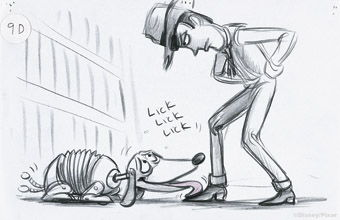
from the storyboard of Toy Story, artist Joe Ranft
DIVIDED INTO THREE SECTIONS, PIXAR: 20 YEARS OF ANIMATION AT THE AUSTRALIAN CENTRE FOR THE MOVING IMAGE (ACMI) IS DEDICATED TO CHARACTER, NARRATIVE AND WORLDS. THE EXHIBITION INCLUDES OVER 500 PAINTINGS, DRAWINGS AND SCULPTURES. IN MELBOURNE, THE ADDED ADVANTAGE HAS BEEN THE INCLUSION OF ART WORK FOR THE NEW PIXAR FILM, RATATOUILLE (2007), ONLY RECENTLY RELEASED HERE, AS WELL AS THREE CROWD PLEASERS. THERE’S THE GIANT LUXOR JR SCULPTURE AND BALL THAT STARRED IN PIXAR’S FIRST ANIMATION, WELCOMING VISITORS AT ACMI’S ENTRANCE; THE ‘REAL’ CAR-SIZED SALLY CARRERA FROM CARS which OCCUPIES THE GROUND FLOOR LOBBY; AND MY PERSONAL FAVOURITE THE GIANT, STUFFED SULLEY (AND PLASTIC MIKE) FROM MONSTERS INC— IT TOOK GREAT WILL POWER ON MY PART NOT TO IGNORE THE BARRIER THAT SEPARATES THEM FROM THE CROWD IN ORDER TO GET JUST ONE, BIG HUG FROM THE BLUE GUY. UNFORTUNATELY, SUCH DISPLAYs OF LOVE have taken their toll ON SULLEY FROM EARLY ON IN THE EXHIBITION AND NOW, WHILE VISITORS CAN LOOK, THEY CAN’T TOUCH.
The exhibition is exclusive in Australia to ACMI, but has also shown at the Ghibli Museum in Mikata, Tokyo, the New York Museum of Modern Art, the London Science Museum and the National Museum of Scotland. Curated by Elyse Klaidman, Dean of Art and Film at Pixar University, this exhibition is very much a celebration of the more traditional creative processes at work behind the scenes that give eventual life to the digitally animated films that are the more familiar trademark of Pixar.
Beginning as an independent company in 1986, Pixar Animation is still a young studio, yet its success has been nothing short of phenomenal. It has consistently won awards for its short films—including Luxo Jr (1986), Tin Toy (1988), Red’s Dream (1987) and For the Birds (2000)—and the animated features Toy Story (1995) and Toy Story 2 (1999), A Bug’s Life (1998), Monsters Inc (2001), Finding Nemo (2003), The Incredibles (2004) and Cars (2006). It has also been at the forefront of developing its own in-house software programmes (including RenderMan), which have gone on to advance the art of computer generated filmmaking and animation. Add to this the fact that Pixar has also broken record after record (including its own) on box office receipts—with total gross coming to just under $4 billion—and we have a force to be reckoned with.
John Lasseter, Chief Creative Officer at Disney Studios (who recently bought Pixar) and Pixar Animation Studios explains on the Pixar website that “the computer is where we finish our stories.” This exhibition takes the audience on a delightful journey that’s about the lead up to that final stage. The artwork that confronts the viewer appears seemingly endless and displays the complex artistic process that’s required to produce the final animations with which we’re most familiar. Wall after wall and cabinet after cabinet display works such as Dan Lee’s dynamic movement studies of Boo from Monsters Inc; Ricky Nierva, Dan Lee, Geefwee Boedoe and Tia Kratter’s pastel, marker and pen and pencil drawings of Monsters Inc characters in various stages of creation; and the wonderful minimalist drawings by Teddy Newton that include studies of Frozone and Newton’s early digital concept for the title sequence of The Incredibles. There’s also the deceptively simple and experimental collages of A Miscellaneous Superhero and Edna Mode (aka ‘E’) by Newton that capture the viewer’s imagination with their combination of coloured paper cut-outs and richly textured fabrics; the cast urethane resin and polymer clay models that would make Rodin proud; the retro colourscripts of Lou Romano that abstract and condense the characters and storylines of The Incredibles into richly coloured, atmospheric worlds that are reminiscent of Mary Blair’s artwork for the Disney Studios in the 1950s and 60s; the dark and evocative underwater worlds portraying the loveable (and not so loveable) characters from Finding Nemo by Simón Varela; and the totally cheeky acrylic painting of Flik from A Bug’s Life whom Tia Kratter compositionally arranges in a homage to Leonardo da Vinci’s Vitruvian Man—an ant supplants man in the grand scheme of things.
Dominating the exhibition is a discourse on the symbiotic relationship between technology and art, and this is found not only in the traditional art as early stage processes of the digital animations, but in digital installations on show. Artscape (2005) is an 11-minute widescreen film on a 12 metre screen that links four projectors to achieve its hypnotic effect. The film was created for the Museum of Modern Art exhibition by the director and digital artist Andrew Jimenez (who also worked as digital artist on The Incredibles, Monsters Inc and Finding Nemo) and sound designer Gary Rydstrom. It takes the viewer across the surface of a gigantic display board and into a three-dimensional journey of many of the drawings, paintings and other art works on display in two-dimensional form in the exhibition. The camera pans across work after work in pastels, crayons, painting and gouache. Relying on a device that can be traced back to the 17th and 18th century perspective boxes (examples of which had been on display at ACMI’s 2006 exhibition, Eyes, Lies and Illusions, RT77, p21), but which now uses alternative tools such as Photoshop, images are scanned and layered in space to produce the illusion of depth as the camera explores their terrain. At one point we travel into the world of A Bug’s Life and, as the camera tracks into a crayon drawing, we experience a true sense of its minute scale. The strangely alien-like noises and sound effects that vibrate amidst the thousands upon thousands of blades of grass eventually reveal the thousands upon thousands of ant-faces that hide in their midst.
The Toy Story zoetrope, created by the Pixar animator J Warren Trezevant is, in many respects, the exhibition scene stealer. Influenced by its bigger cousin, the My Neighbour Totoro zoetrope at the Ghibli Museum in Japan, this one is a homage to the history of animation. Updating old zoetrope technology for the early 21st century, the device uses computers to orchestrate the perfectly timed movement of the multiple and slightly varied versions of the sculptured characters of Woody, Jess, Buzz, Wheezy the Penguin and others who occupy a circular disk that spins like a merry-go-round. Strobe lights are introduced and, timed to perfection, the trickery of persistence of vision kicks in: the static images transform and we suddenly see Woody on his horse, riding around the circle; Jess twirling her lasso above her head and down over her body; Buzz Lightyear bouncing on a ball; Wheezy the Penguin jumping into and out of holes in the ground; and the little green alien who stands at the circle perimeter, waving at the viewer experiencing this wondrous technological feat, utterly mesmerized.
It took me over five viewings of the spin cycle before I could tear myself away to take in the crowd sharing the room. Every face—and there were over 30 packed into the space—from 2-year olds to over-60s and appeared as if frozen in time, with enormous smiles plastered across their faces. It was as if every zoetrope performance was being performed for them personally. And as I waved to the little green alien, I could hear many promises being made to the little ones by parents trying to extract them from this very special room and the wondrous toy it housed.
Throughout, a story is told about the way traditional and new media art can and do interact to produce evocative stories. In the words of John Lassiter, “The art challenges technology and the technology inspires art.”
RealTime issue #81 Oct-Nov 2007 pg. 27
© Angela Ndalianis; for permission to reproduce apply to realtime@realtimearts.net
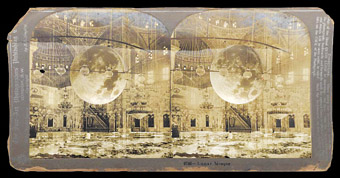
Stereoscopic, Henschke and Kendrigan
HAVING BEEN BORN AND RAISED IN MELBOURNE, AND BEING PERIPATETICALLY INCLINED, I WAS SURE THAT I HAD SEEN ALL THERE WAS TO SEE IN THE CBD OF MY HOMETOWN. HOW DELICIOUS THEN TO FIND A HIDDEN TREASURE LIKE THE WUNDERKAMMER.
Part shop, part museum, the Wunderkammer, like its 17th and 18th century counterparts, is home to an extensive array of scientific curiosities, artefacts and ephemera. From piranhas in bell jars to the full sized, taxidermied remains of a lioness from the long defunct Bacchus Marsh Safari Park, all manner of strange and strangely beautiful objects compete for the visitor’s attention. And amidst this cornucopia is a collection of works by artists Chris Henschke and Donna Kendrigan.
Collected together under the title Unnatural Curiosities, there are more than six distinct and distinctive works, each of which draws inspiration from earlier cultures of display of which the Wunderkammer (or Cabinet of Curiosity) is one example. Each work is displayed in a custom-built cabinet superbly and lovingly crafted by Lindon Davey-Milne. The works stand up as craft, effortlessly melding into their surroundings. But as works of art, they offer even more. Each piece is aesthetically interesting while offering an intelligent and reflexive critique of the cultures of display in which they themselves participate.
The largest of the works Transplants (2005) is housed in a reproduction 19th century style botanist’s cabinet. Comprising both artefacts and a touch screen installation, the work allows the viewer to engage with a digital interactive titled Garden of Transplants, housed within the cabinet. Navigating the space brings to life science fiction writer Adam Browne’s short story, Orlando’s Third Trance. The garden itself is inhabited by strangely mutated and unnatural organisms rendered in the style of the colonial botanist. The aesthetic overlay of the past on present and future creates a sense of historical all-at-onceness, a sense usually denied or repressed by most scientific descriptions of the world where progress and rupture override renewal and continuity.
Electrococo Salon (2007) also plays with the intersection between past and present by housing an exotic three dimensional, digitally constructed scene featuring 18th century French prints of interiors, electrical circuit diagrams and antique machine parts. This is displayed within a diorama cabinet along with a sound score composed from manipulated voices, jackhammers and harpsichord. The work challenges the viewer to think about relationships between the interfaces of the computer and preceding technologies of display like the diorama.
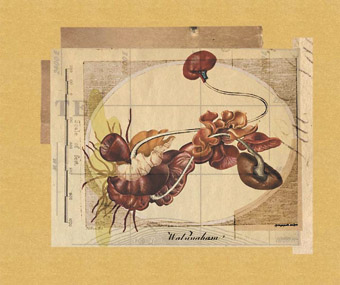
Kidney Plant, Henschke and Kendrigan
Similarly, Salon of Spirits (2006) and Lunar Mosque (2006) feature stereoscopic images created through the blending of Victorian era Keystone images printed onto Lambda Duratran. Both works reference key moments in both the history of display technologies. Salon of Spirits features images familiar to anyone interested in the spirit photography of the late 19th century. Lunar Mosque features a moon straight out of a scene by French illusionist and cinematographer George Méliès. Both works remind the viewer that the desire for immersion in a three dimensional world extends back beyond the development of virtual reality in the late 20th century.
The evocatively titled Interior Probably Undisturbed (2007) is a beautifully textured digital collage featuring 18th century geological diagrams. The images combine to form a strange volcanic landscape suggestive of close-up cross-sections of scientific specimens. Similarly, New Ocean Fantasy (2007) appears as if collated from items in an ancient oceanographer’s desk drawer. Both works invite us to see differently, to mistake one thing for another, one time for another, one world for another.
One of the most fascinating aspects of this exhibition is its location within the Wunderkammer. As media artists struggle to secure ongoing opportunities in a world of seemingly contracting exhibition opportunities, the marriage, in this instance, of commerce with art has proven to be a savvy choice by the artists and the shop owners. Apart from the obvious concurrence between their thematics, each brings their own audience to this arrangement.
Henschke and Kendrigan are certainly not the first media artists to realise that sourcing new kinds of spaces to exhibit their art is not only likely to bring them into contact with new audiences but also enhances the possibility of creating a market for media arts (they have already managed to sell one of the works exhibited in Unnatural Curiosities). Ian Haig certainly explored this when he exhibited Futurotica at both Sexpo and at the Erotic Museum in Los Angeles in 2004.
In this instance, Henschke and Kendrigan’s work could not have found a more apt home. To some extent it is telling of media arts’ status in the arts hierarchy that artists need to be so inventive in order to get their work seen. With traditional gallery spaces still reluctant to exhibit work that invites physical interaction and media arts organisations being squeezed by slimmer budgets and demands for large audience returns, we may well see more opportunistic manoeuvres like this by artists intent on getting their work into the world.
Unnatural Curiosities, Wunderkammer, 439 Lonsdale Street, Melbourne, Aug 4-Sept 29
RealTime issue #81 Oct-Nov 2007 pg. 28
© Lisa Gye; for permission to reproduce apply to realtime@realtimearts.net
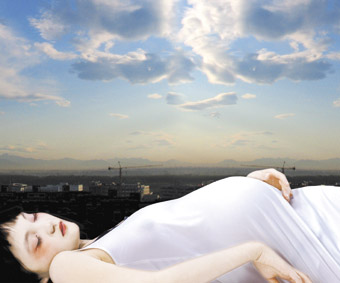
Cui Xiuwen, Angel Series #13
courtesy of the artist and Marella Gallery, Beijing
Cui Xiuwen, Angel Series #13
ENTERING THE QUT CREATIVE INDUSTRIES PRECINCT I WAS CONFRONTED BY A CONFLUENCE OF SCREENS, EACH OUT TO GRAB MY ATTENTION. DAZZLED, I TEETERED ABOUT UNSURE WHICH WAY TO TURN. THE VERNACULAR TERRAIN EXHIBITION FEATURED 50 ARTISTS FROM AUSTRALIA, CHINA AND JAPAN AND WAS CURATED BY A TEAM LED BY STEPHEN DANZIGER, THE DIRECTOR OF IDA (INTERNATIONAL DIGITAL ART) PROJECTS. IT RESPONDED TO THE IDEA OF ‘VERNACULAR CREATIVITY’ AS COINED BY MEDIA THEORIST JEAN BURGESS, REFERRING TO COMMONPLACE MODES OF CREATION.
With the increasing availability of digital media technologies this creativity is being nurtured in a plethora of new contexts and modes of social interaction, as exemplified by YouTube, Flickr, mobile phone art, Second Life and the neverending torrent of blogs. As the new digital terrain becomes at once both domestic and global, Marshall McLuhan’s mistyped catch phrase “the medium is the massage” looms louder than ever.
The majority of the works in Vernacular Terrain were screen-based. Perhaps non-screen-based works, being dependent on different platforms or on interfaces for interaction, are less attractive to artists because of technical obstacles and limitations of distribution.
Projected onto one wall was Taiwanese artist Chen Yung-Hsien’s Grassing. A plasticine bust of the artist’s head, shorn of hair, eyes closed, evoking transcendence. Rice seeds sprinkled onto the head take root and grow. With time lapse filming, the head is transformed into a mass of leafy green shoots, like a green mohawk. A period of illness spawned for the artist a whole series of works focused on his head, beginning with Release, which involved wrapping it in bacon and salmon strips. The impression is of the need to find tranquility—if by curious means—more usually associated with nature rather than technology.
In the work of Kim Joon (Korea) tattoos come to life on human skin: Chinese characters swell and breathe, while tattooed soldiers steam and explode in jittery motion. The idea came from the artist’s animated tattoo designs for mobile phone screen savers. The work is quite controverisal because tattooing in Korea is still essentially illegal unless the tattooist has a medical degree. Kim Joon associates tattoos with desire, wounded masculinity and processes of imprinting memory. In other works he has used commercial brand labels as oversized tattoos in a critique of consumer obsession with logos.
Almost concealed by the array of massive screens was a set of high-tech glasses through which I viewed the R-rated works of Faiyaz Jafri. These featured animated porcelain doll characters as sadistic “plastic surgery vixens” with fingerless elongated limbs. These nymphs play out bloody Japanese horror scenarios set against computer game generated hallways and rooms. In Déjeuner, a posse of knife wielding girls forms 3D virtual spaces, one inside another. Although Jafri is of Pakistani descent, he grew up in the Netherlands and now lives in New York, and his work reveals its transcultural character in the influence of the Japanese Hentai (perverted sexuality) tradition found these days in anime and manga.
The Australian animator Chris Denaro was artist in residence, developing a new work every 72 hours which was then projected onto the floor. By delving into the endless realm of images available on the photo sharing site Flickr and using a Creative Commons licensed software tool, Denaro collected images of objects, particularly those with over-designed curvilinear design. Splicing them together he formed entirely new objects which had little resemblance to the originals. These new objects resembled Japanese Chindogu (possibly useless inventions) in all their absurdity. The animation software then looped the chimerical forms into mechanised animations allowing them to dance and spin around the floor.
Jin Shan’s video, Hanging Flesh (China), takes us inside a deserted industrial warehouse with long tracking shots. We finally encounter a shirtless figure swaying pendulum-like to an accompanying soundtrack of animal squeals. The viewer soon realises, however, that the camera is inverted. With this image of apparent torment Jin responds grimly to the relentless, dehumanising transformation of modern China.
Other works included Peter Greenaway and collaborator Istvan Horkay’s latest extension of their Tulse Luper project. The high level of sophistication of that work possibly departed from the vernacular theme, but it further revealed how multiple images can be framed, overlayed and threaded through with multiple narratives, not unlike HTML.
Many artists are now taking up the opportunities offered by new media to circumvent the usual gate keepers to reach audiences outside the gallery context. The increasing democratisation offered by online communities contrasts with the fast eroding democracy of established media outlets. The new vernacular aesthetic is already noticeably infiltrating big media in the form of reality TV, homespun documentaries and fake B grade movies. Tom Sherman of Vernacular Video trumpets the death knell for artists who hesitate to immerse themselves in the aesthetic of this latest vernacular. He may yet be mistaken. What is apparent is that many of these works from around the world seek not only to respond to the fast paced, low-fi buzz of the vernacular with more sophisticated and enriching alternatives, but also seek to escape and transcend the popular vernacular itself and still reach an audience.
***
Photographer and video artist Cui Xiuwen (born 1970) exhibits internationally and has been a leader in bringing the female artist in China to prominence, boldly focusing on sex, previously the province of the male artist. In her digital photographic series Angel, young girls in white, the one here pregnant, populate the modern Chinese landscape. [Ed.]
IDA Projects, Vernacular Terrain, curators Stephen Danziger, Xu Dawei, Lubi Thomas, Michael Perkins, Pauline Doutreluingne; presented by QUT Creative Industries Precinct and Beijing Film Academy in association with Yokohama Art Project and Platform China Contemporary Art Insititute, QUT Creative Industries Precinct Aug 28-Sept 15, QUT Art Museum, Brisbane, Aug 1-Sept 30; http://www.idaprojects.org/
RealTime issue #81 Oct-Nov 2007 pg. 29
© Robert Lort; for permission to reproduce apply to realtime@realtimearts.net
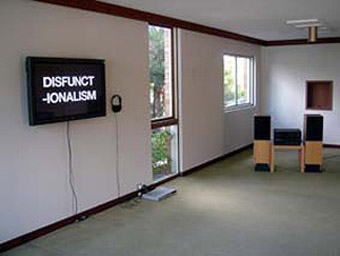
Grant Stevens, I Like Ike, installation 2005
courtesy the artist and Gallery Barry Keldoulis
Grant Stevens, I Like Ike, installation 2005
THIS YEAR’S D/ART/07 WAS EFFECTIVELY HOUSED AT THE AUSTRALIAN CENTRE FOR PHOTOGRAPHY, AS WELL AS HAVING A MORE UBIQUITOUS VIRTUAL PRESENCE ONLINE AND AT PERTH’S REVELATION FILM FESTIIVAL. THE FORUM WAS HELD IN THE CENTRE’S FRONT ROOM, THE EXHIBITION OF ONLINE WORKS IN ITS BACK SPACE (ENTRY THROUGH A CORRIDOR WALLED WITH EXHIBITED WORKS ON VIDEO MONITORS), AND OTHER WORKS SCREENED A SHORT WALK AWAY AT THE CHAUVEL CINEMAS. DESCRIBED BY DLUX DIRECTOR DAVID CRANSWICK AS “A REVIEW OF WHAT’S HAPPENING WITH THE MEDIA CONDUIT” WHILE WE WAIT FOR THE IMPACT OF MICROSOFT’S SILVERLIGHT CROSS-BROWSER, CROSS-PLATFORM PLUG-IN, THE FORUM WAS FASCINATING, OFFERING AN INTRODUCTION TO AND INSIGHTS INTO THE ACTUALITIES AND THE POTENTIALS OF THE PROLIFERATING MEANS OF DISTRIBUTION, RELATED LEGAL ISSUES AND, NOT LEAST, INCOME GENERATION. THE MOOD WAS POSITIVE, IF CAUTIOUSLY OPTIMISTIC.
getting the rights right
Copyright lawyer Raena Lea-Shannon, a specialist in digital media and the arts, offered a brisk, vivid history of the legal issues up to the present moment, describing the digital impact as “extremely disruptive to the legal environment.” Napster had “rampaged copyright” and heralded a changed distribution model. The sheer fixity of film’s celluloid acetate and its highly mechanical projection apparatus allowed, she said, “for a great deal of control”, with monopolisitic film companies becoming their own distributors and issuing exclusive licences for different territories and different media (eg theatrical release first, followed by cable, then free-to-air and DVD). Lea-Shannon described this structured temporal model as a source of increasing consumer frustration from the 1980s on. New models emerging from hacking and from Napster drove SONY to Digital Rights Management (content or copy protection, referred to by its opponents as digital restrictions management), creating DVDs that invaded users’ computers and their privacy and which had to be recalled: “life for the end-user had looked like becoming a nightmare.” The invasion is not over. As the Electronic Frontier Foundation puts it:
…DRM technologies do nothing to stop copyright pirates, but instead end up interfering with fans’ lawful use of music, movies, and other copyrighted works. DRM can prevent you from making back-ups of your DVDs and music downloaded from online stores, recording your favorite TV programs, using the portable media player of your choice, remixing clips of movies into your own home movies, and much more. www.eff.org/IP/DRM/
Lea-Shannon described the transformation of the rights we are living through as embracing Open Source approaches and increasingly licensing to the world—blanket licensing enabling a model similar to the collection agency APRA in the music field. For the first time, she said, we have the means for low budget, lo-tech works to enjoy not only distribution but options in delivery platforms and the means to generate income. She added, that there are also increasing ways to discover the very existence of a work via Google or Technorati, which claims to be “[c]urrently tracking 104.4 million blogs and over 250 million pieces of tagged social media…We search, surface, and organize blogs and the other forms of independent, user-generated content (photos, videos, voting, etc.) increasingly referred to as ‘citizen media.’“
For copyright protection, Lea-Shannon advised artists to register with Screen Rights, the audiovisual copyright society, and to apply for an ISAN (International Standard Audiovisual Number) for an individual work—it’s similar to the ISBN (International Standard Book Number). ISANs apply to both digital and physical media. Lea-Shannon was emphatic: “Never underestimate income from schools.” Screenrights says that universities, TAFEs, government and almost all other schools are licensed by them to copy from radio and television. Presumably web and locative media art will eventually have access to these rights too, where sought.
money for the makers
Created by David Geddes, Andrew Kelley and Simone Govic, Si-Mi is a Melbourne-based digital content online marketplace. The quietly reticent Geddes described the site as dedicated to making available quality screen work of all kinds and creating income for the makers. George Gittoes’ recent documentary, Rampage, is downloadable from Si-Mi for $3.99, shorter works sell for as little as $0.39. Format, platform and cost are decided by the content owner, the artist, who owns the world rights. Geddes says the site’s income comes from a mix of advertising and Si-Mi’s split of the income from sales: 30%. Geddes sees Si-Mi as creating in particular a niche for high quality work: “we target it. It’s the opposite of the bottom end of YouTube video and it’s stuff not picked up by the big companies.” Each work has a 90-second trailer and the profile page is controlled by the artist. While opposed to DRM, Geddes believes that some form of it is going to be necessary.
subscription model
The laidback, affable Brent Hoff from the USA, took us back to a more tangible sales item, a quarterly DVD film and video magazine, Wholphin DVD. It comes complete with notes and interviews, sells for US$50 per annum and was inspired by the success of the McSweeney’s book-cum-magazine-cum-object. McSweeney’s, where Hoff writes about science, publishes Wholphin DVD. Hoff described himself as “not a film man, but a writer.” But film is obviously very important to him; he mentioned one in particular that he was involved in the making of and which he showed later that evening at the Chauvel, Alfredo Garcia’s Yeah Yeah, We Speak Perfect English, Just Serve. It’s a video of a volleyball game, ironically labelled “Walleyball”, using the fence on the beach border between the USA and Mexico as a net and putting the players on the US side at risk of being shot or jailed for life. Among the magazine’s repertoire of documentaries, dramas, fantasies and animations are a number of incisive politically left-of-centre works.
Hoff sees the magazine he co-founded and edits as “free[ing] us from industry constraints and giv[ing] us more control.” While there are sites similar to Si-Mi—the French Dailymotion, Metacafe and others—Hoff likes the physical DVD distribution model. Wholphin also have public showings (Hoff likes the idea of buying cinema down-time for screenings), but the business model is primarily a subscription one, based on the McSweeney’s approach which includes placing copies in niche bookstores and, in lesser amounts, in Borders.
The short form content of the magazine, Hoff thinks, is attractive not only to viewers but also to makers, like David O Russell, Erroll Morris, Dennis Hopper and Steven Soderbergh, who have all contributed works. There are also occasional longer works like Australian Anthony Lucas’ award-winning 26-minute animation, The Mysterious Geographic Explorations of Jasper Morello. The combination of well-known names willing to work without big budgets, or any, and new makers appearing in the same edition is highly attractive. Now in its fourth edition, the magazine was in profit by May this year. As for DRM, Hoff sees it as ridiculous, “so hard to police.”
precious moving object
In his talk, Barry Keldoulis, the hard working, persuasive director of GBK gallery, took us to a different kind of content, fine art video. After video art had apparently gone into abeyance in the 90s, I can recall the excitement when the word spread a few years back that a Shaun Gladwell video had sold to a collector for a modest sum. Gladwell, TV Moore and Kate Murphy are just some of the local Sydney video artists of note whose work will be found in key galleries and shows, and will doubtless be joined by Sam Smith, recipient of this year’s Helen Lempriere $40,000 Travelling Fellowship. In an age where mechanical production has been digitalised and gone through the roof and video clips sell for $0.39 and makers hope for successful long tail sales to make their money, how do you keep artworks in specialist markets seriously profitable from the word go?
Grant Stevens was the first video artist on Keldoulis’ books. That was in 2004. The edition of the work sold out. Keldoulis sees video art as “priced like photography”, as having international appeal, and already accruing in value as time passes. Packaging, he says, is not important for the purchasing institution, just the artist’s signature, knowledge that the edition is limited, and the rights to technical upgrade (given the short lives of modern tehnologies). A Jess McNeill work ran to only eight copies, sold at $2000-8,000 each, averaging out to total sales of $40,000 which was, Keldoulis suggested, “viable for an artist.” The selling situation has been improved, he said, with the advent of the flat screen monitor and buyers who like to screen works which “are meditative or intriguing at dinner parties.” Kedoulis said that the notion that rising sales in video have corresponded with “a slump in photographic sales”, and that photography is “not so cutting edge now”, was not entirely true. But, clearly, he thinks there’s something in it.
bright new world
In the closing discussion Raena Lea-Shannon described a future online world with “a massive aggregation of content”, “sophisticated search mechanisms”, “highly compartmentalised audiences”, and big corporations going with everyone else to collection societies—“unless they try to create their own.” But DRM, she claimed, “would go the way of the dodo—it’s impossible to enforce.”
d/Art/07, Forum, ACP; Wholphin DVD screening, Chauvel Cinemas, Sydney, July 19
Wholphin DVD, www.wholphindvd.com
Technorati, http://technorati.com/
Screenrights, www.screenrights.org
McSweeney’s, http://store.mcsweeneys.net/index.cfm
Dailymotion, www.dailymotion.com/us
Metacafe, www.metacafe.com
RealTime issue #81 Oct-Nov 2007 pg. 30
© Keith Gallasch; for permission to reproduce apply to realtime@realtimearts.net
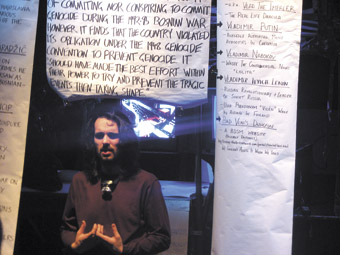
Vlad Mijic, Villanus
photo Rhys Auteri
Vlad Mijic, Villanus
IT’S A CLUNG-TO BELIEF AMONG MANY ADMIRERS OF ART THAT ITS FINEST CREATORS ARE RARELY APPRECIATED DURING THEIR MOMENT ON EARTH. I DON’T KNOW HOW OFTEN THAT CLAIM HAS BEEN EMPLOYED BY THEATREMAKERS TO JUSTIFY AVERAGE WORK, BUT VOCIFEROUSLY NEGATIVE DENUNCIATIONS ARE ALWAYS MORE ENTICING THAN TEPID PRAISE. ANY PIECE ABLE TO INSPIRE ANGER IS, PERHAPS, WORTH A LOOK-IN FOR THAT REASON.
villanus
Welcome Stranger’s Villanus saw a damning critique during the night of my attendance. A vocal audience member made her displeasure known for the last half of the solo show’s duration, sighing and muttering to her companion and asking if they could please leave, now, thank you? When performer Vlad Mijic lay dying, an arrow piercing his gut, apologising for imposing his tale upon his audience, this voice of criticism responded with, “It’s alright darl, it’s just a bit long.” She walked out soon thereafter, the most physical form of criticism available.
Villanus is a profoundly intriguing work, obviously. Mildly engaging performances don’t often occasion walk-outs. Ninety minute monologues that powerfully redefine notions of dramatic structure, character and identity do. Villanus is not without its flaws—there’s a good hour of material stretched out to greater length here. But that good stuff is worth the wait.
Mijic’s Serbian heritage inspires this work. Though he left the country (which wasn’t then a country) at the age of three, his ethnic background later cast him as a villain, one of the bad guys in a war he had nothing to do with. Villanus sees him taking on the role of villain, channelling the monsters of history, offering sympathy to the devil.
It’s a patchwork quilt of vignettes in which Mijic switches identities at an alarming rate—as much to highlight the unstable, projected nature of identity itself as anything else. The set, too, is a junkshop pastiche of roadside hard rubbish, TV screens and cameras, butcher’s paper and packing tape. It’s the stuff Australian culture uses but isn’t willing to offer much value to—just like the dislocated characters Mijic incarnates.
There’s a lot of humour in this ragged work, and much insight, though it lacks the sustained focus necessary to drive home its more provocative points. It’s not for everyone and yes, “it’s a bit long”, but it tends fertile ground worthy of cultivation.
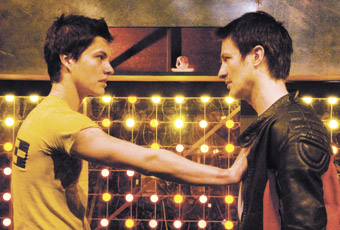
Luke Mullins and Xavier Samuels, Mercury Fur
photo Dan Stainsby
Luke Mullins and Xavier Samuels, Mercury Fur
mercury fur
UK playwright Philip Ridley’s Mercury Fur inspired more public outrage upon its premiere, though Little Death Productions’ recent Melbourne staging saw less controversy and more uniform praise. In Britain, Ridley’s publishers Faber and Faber refused to print the play and several critics denounced the piece as degrading and voyeuristic sadism. It’s anything but.
Mercury Fur’s world is one in which the social contract governing civilisation has been torn up and set afire, giving way to an anarchy both terrifying and entirely plausible. Gangs roam the streets with murderous intent, riots occur with no apparent cause, and governments respond by bombing unruly populations. And amidst the chaos, people get on with getting on. Elliot (Luke Mullins) and Darren (Xavier Samuel) are in the business of organising exclusive parties in which salaried businessfolk indulge their wildest fantasies—murdering a child in a bizarre Vietnam War/Elvis impersonator scenario, for instance. That’s when Elliot isn’t peddling the psychotropic butterflies which descended on London during a sandstorm, or trying to negotiate the excesses of the monstrous “family’‘ which has formed around him: the blind Duchess who is a pit of need and wilful self-delusion; Papa Spinx, a ferocious criminal kingpin who arranges Elliot’s clients; and newcomer Naz, the childlike fool with the butterfly addiction who eventually becomes the crux of the work’s moral dilemma.
It’s thoroughly nasty stuff delivered with enough humour, intelligence and relevance to justify its worst aspects. In the wrong hands, any scene calling for an adolescent shrouded in clingwrap to be hefted offstage awaiting a meathook to the rear would be nothing less than sicko-erotica masquerading as cutting edge theatre, but maybe that’s just me.
One of the work’s strengths is its openness—an audience member’s sense of the piece’s target could easily vary significantly from that of the person they’re sitting next to. Has this dystopia been brought about by a malevolent military-industrial complex? Drug use and hedonism in the young reaching some kind of critical mass? Sheer individualistic greed? Or something else entirely—perhaps something even biblical in scale? All are interpretations supported by the narrative, but it’s that tantalising sense of senselessness creeping around the fringes of the work that gives it such power. We’re trapped in the confines of a ruined building along with these characters, after all, and it’s hard to get the big picture when you’re hiding behind boarded-up windows.
The apocalyptic world of Mercury Fur is bound to alienate some audiences, but it is a text which engages with the alienation of the modern world. Little Death’s version doesn’t revel in its monstrosity but respects the bleak vision it requires. Mullins embraces an atypical role, bringing a convincing rough-hewn edge to Elliot. Aaron Orzech is a discovery as the naïf Naz, and Kelly Ryall’s understated score along with Danny Pettingill’s magnificent lighting bank lend an urgency to the piece that scoffs at the nay-sayers. Here’s hoping for a return season after its Sydney appearance.
holiday
So we get to Holiday. Hard to imagine someone calling for its banning, or rousing themselves enough to walk out. Missing its point would more likely result in a quiet snooze, perhaps. It would be missing out, though, on one of the most fascinating productions in recent memory.
But, to be honest, it would be easy to let Holiday pass you by. Ranters Theatre, under the direction of Adriano Cortese and featuring the impeccable writing of Raimondo Cortese, has long concentrated on the kind of naturalism that seems like anti-theatre, eschewing dramatics in favour of a precise, honest observation. Holiday is both the apogee of this aesthetic and a move in a new direction, introducing theatrical elements previously absented from the more minimalist works Ranters is known for.
It’s almost like one of those 3D magic eye pictures—a seemingly chaotic, random array of dialogue which suddenly, powerfully gains a depth that is almost shocking in its richness. The premise is simple: two men (Paul Lum and Patrick Moffat) lounge beside a large inflatable pool, shooting the breeze in snatches of conversation. Their location is only hinted at—a beachside resort, perhaps, or a suburban backyard. Their relationship is equally vague—they may have just met, or they may be old friends. This is theatre of the moment, in which no word exists before it is uttered, no action before it is performed. The relationship between these two is a process, not a product of the past.
But it’s also misleading to use terms like minimalist or naturalist in relation to Cortese’s dialogue. By reducing extraneous elements, Holiday forces us to listen to the words of these two men, and though their talk initially seems like the listless, even bored ramblings of people on a break from the real world, it’s quickly apparent that profound themes are being confronted—religion, politics, history, love, dreams, art and more are all subtly woven into this tapestry. The very idea of a holiday, after all, is to “get away” from it all, but in doing so these men realise that the alternative is a kind of existential nothingness. Throwing an inflatable ball back and forth in order to do something, anything, thus takes on the kind of true absurdity as effective as anything Beckett could have dreamt up.
The inclusion of brief, baroque songs breaking up the work, along with a sublimely understated set design by Anna Tregloan and an evocative soundscape by David Franzke, anchor the piece in a more sophisticated contemporary milieu than previous Ranters’ productions, and add further aspects to contemplate as this gentle and meditative work unfolds. This is contemporary performance of the highest calibre, wrought with deft skill and tempered with a discerning, unwavering hand. Then again, you might just not get it at all.
Villanus, writer-directors Vlad Mijic, Rhys Auteri, performer Vlad Mijic, Welcome Stranger Productions, Old Council Chambers, Trades Hall, Carlton, Aug 23-Sept 2; Mercury Fur, writer Philip Ridley, director Ben Packer, performers Paul Ashcroft, Gareth Ellis, Fiona Macys, Luke Mullins, Aaron Orzech, Russ Pirie, Xavier Samuel, design Adam Gardnir, sound Kelly Ryall, lighting Danny Pettingill, Little Death Productions,Theatreworks, Melbourne Aug 30-Sept 16; Ranters Theatre, Holiday, writer Raimondo Cortese, director Adriano Cortese, performers Paul Lum, Patrick Moffatt, design Anna Tregloan, sound David Franzke, Arts House, North Melbourne Town Hall, Aug 9-22
Mercury Fur plays as part of Griffin Stablemates Program at the Stables Theatre until October 13
RealTime issue #81 Oct-Nov 2007 pg. 31
© John Bailey; for permission to reproduce apply to realtime@realtimearts.net
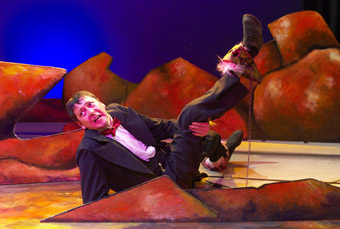
Sam Longley, Not Like Beckett
photo Jon Green
Sam Longley, Not Like Beckett
LIKE THE COLONISING RABBITS WHOSE STORY IT DEPICTS, MICHAEL WATTS’ NOT LIKE BECKETT HAS PROLIFERATED IN VARIOUS LOCALES. WRITTEN IN ALICE SPRINGS, IT PREMIERED IN 2006 AT THE MALTHOUSE DIRECTED BY MICHAEL KANTOR BEFORE BEING STAGED IN ALICE SPRINGS (WATTS’ HOME) AND DARWIN IN A CO-PRODUCTION BY THE ALICE’S RED DUST THEATRE AND DARWIN THEATRE COMPANY. NEW PRODUCTIONS WERE RECENTLY PRESENTED IN LISMORE BY NORPA AND PERTH BY DECKCHAIR. LIKE MANY OF THE SCRIPTS BY THE PLAYWRIGHT REFERENCED IN THE TITLE, NOT LIKE BECKETT IS A VIRTUOSIC MONOLOGUE, PERFORMED IN PERTH BY SAM LONGLEY.
Watts’ text deals with the fallen vaudevillian scion of a wealthy mining-and-squattocracy family of Australian rabbits. He found fame and fortune by drawing on the prejudices and clichéd scatological expectations of his audiences, before being marooned on the outback hummock where the play is set, his leg cruelly mangled in a trap. Mixing rude bush humour with a dash of Samuel Beckett’s Malone Dies, the protagonist, Walter Walloon Beckett reminisces about his life and fate as he awaits his final apotheosis and extinction at the hand of a trapper to become a fine felt hat. Even in death, Walter is egocentric. His thoughts do however turn to his absent former lover and performing partner, the indigenous bilby Boo Boo, whose presence is alluded to in Alison Brayford’s anthropomorphic set of painted mammarial rocks.
Director Emily McLean’s production focuses predominantly on the story and on Longley’s lanky six foot presence, the actor skilfully shifting from pathetic self-pity and egoism to unashamedly jocular exposition as he describes Walter’s signature acts of sticking a carrot up his arse and his realisation that all rabbits do is fuck everything in sight. Walter’s show thus morphs from leap-frogging over rabbits in order to fuck them from behind to the more popular performance for his peers of fucking over the indigenous bilbies as vigorously and frequently as possible. Watts’ script has plenty of barbs like this.
Longley’s well paced, well shaped solo is interspersed with sound effects (boom-tish cymbals and so on), sudden bursts of garish front lights and even segues into song (“I Did It My Way”). Generally though, these music-hall elements are rhythmic diversions from Walter’s life story. While McLean and Longley produce a fine show, it lacks some theatrical spark and bite. Particularly odd is a finale played for pathos, Longley doing a realistic dying scene, and much of the promotion and criticism in Perth focussed on Watts’ play as a tragic “love story.”
Watts’ monstrous allegory is not well suited to this interpretation and the somewhat lukewarm response to Not Like Beckett outside Melbourne may be attributable to this, together with a lingering sense that West Australians and Territorians feel they live closer to the frontline of contemporary colonialism and race relations than the distant, self-satisfied urbanites of the east. Certainly, Kantor’s own vigorous embrace of urban themes and iconography by referencing not Sinatra but Sid Vicious in Walter’s singing, by casting the protagonist as a reincarnation of famous Australian vaudevillian Roy Rene, and by setting the play not in the bush but on the once infamous Vault (or ‘Yellow Peril’) public sculpture of central Melbourne, had no counterpart in Perth. While WA could do with more nasty little plays like this, I missed Kantor’s insistence that both Australian history and its theatre is a dastardly mishmash of influences and locales that must be rendered in all of their horrible, clashing complexity if we are to accurately represent our society.
Not Like Beckett, writer Michael Watts, director Emily McLean, performer Sam Longley, design Alison Brayford, lighting Andrew Portwine, Deckchair Theatre, Victoria Theatre, Fremantle, July 26-Aug 12, 2007; Not Like Beckett, writer Michael Watts, director Michael Kantor, performer Russell Dykstra, design Anna Cordingly, lighting Niklas Pajanti, sound Darren Verhagen; Malthouse Theatre,
July 28-Aug 20, 2006
RealTime issue #81 Oct-Nov 2007 pg. 32
© Jonathan Marshall; for permission to reproduce apply to realtime@realtimearts.net
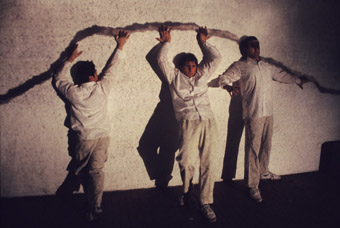
In Other Words
courtesy of the artist
In Other Words
TALYA CHALEF’S IN OTHER WORDS BEGINS WITH THE WRITING ON THE WALL. THE AUDIENCE IS LED INTO AN INTRODUCTORY SPACE WHERE PRINTED QUOTES ACCOMPANY PHOTOCOPIES OF MAPS SUGGESTING A TEXTUAL TOPOGRAPHY TO BE TRAVERSED. INTRODUCTIONS OVER, WE THEN ENTER A VAST PERFORMANCE SPACE THAT MAY HAVE ONCE BEEN A CONVENT KITCHEN. AND THERE’S SOMETHING COOKING AMONG THE THREE MALE PERFORMERS AS THEY SCRAWL WORDS ON CELL WALLS. SOUTH AFRICA’S TRUTH AND RECONCILIATION COMMISSION, PINOCHET’S DEATH SQUADS IN FASCIST CHILE AND AUSTRALIA’S STOLEN GENERATIONS COMBINE IN A BROAD RUMINATION UPON STATE SANCTIONED MURDER AND DISPLACED PEOPLES.
Chalef infuses this performance with a movement vocabulary that oscillates between quiet stillness and violent tremolo allowing us to comprehend the poetry of trauma, as well as the trauma itself. The performance is then sucked into a projected image of a cracked wall, and each performer clings to an edifice accompanied by a striking composition of synthesizer and distorted sounds.
Pain is a visceral experience, one not simply carved into flesh, but also vulcanised upon the soul. And this is nowhere more apparent than when the performers come together slightly off centre for a smoko. They resemble politicians using words to duck and weave, to stall and dominate, revealing the limitations of the English language, accentuated by Tim Stitz stuffing his lean form into a disused fireplace and thereby transforming it into a mini-proscenium, or an Auschwitz oven. When Death arrives, we do not greet it with polite words. Instead, we defiantly resist its presence with paralytic screams. During this performance, it’s the image of Death that haunts us, not the words we use to divert and conceal its ever attending presence. And so it is that Chalef’s ‘other words’ are images. The pain of remembered experience, once probed and investigated, becomes a chemical dream. When remembering, I do not speak. Instead, I feel and see…
A lesser known Kafka story is titled Under the Harrow. The protagonist has his sin carved into his chest by an “Apparatus.” In conceiving of such an image, it was as if Kafka was attempting to transcend the limitations of language. In Other Words functions similarly. We see and experience the pain inflicted upon the individual by political machines that once resided (and still exist to degrees) in three continents. But this is not before the show takes a most interesting turn. A video projection of a woman, superimposed over the actual presence of a male performer (one who has outlined his own image in chalk upon a wall), invites us to consider the liberating possibilities of technology. Thinking and feeling beyond gender, we see pain for what it really is: a kaleidoscope of flesh, blood and viscera, the gulf between anima and animus, and the painful experience of synthesising both into a fully integrated personality.
In Other Words, animateur Talya Chalef, performers Keith Brockett, Tim Stitz, Mark Tregonning, Georgina Durham, Suzannah Bayes Morton, sound design Alex Garsden, lighting Bronwyn Pringle; Basement Space, Abbotsford Arts Complex, Melbourne, August 1-11
RealTime issue #81 Oct-Nov 2007 pg. 32
© Tony Reck; for permission to reproduce apply to realtime@realtimearts.net
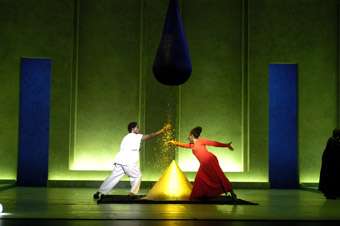
Robert Wilson, The Temptation of St Anthony
courtesy Melbourne International Arts Festival
Robert Wilson, The Temptation of St Anthony
FOR THOSE WHO MISSED ROBERT WILSON’S SURPRISINGLY ANIMATED, PERFORMATIVE AND VERY FUNNY TALK ABOUT HIS LIFE, ART AND CAREER AT THE 2006 SYDNEY FESTIVAL, ABSOLUTE WILSON, A GENEROUS 105-MINUTE DOCUMENTARY BY KATHARINA OTTO-BERNSTEIN, IS MORE THAN COMPENSATION.
The film offers a talkative Wilson, words from Tom Waits, Susan Sontag (who saw every performance of some works), William Burroughs, David Byrne, Phillip Glass and others, along with images and footage from many shows. There are tantalising glimpses of works Australians are unlikely ever to see and ones they just might have (Einstein on the Beach or Black Rider) or are looking forward to (like the The Temptation of Saint Anthony at the 2007 Melbourne international Arts Festival). The film gives us as much of the personal Wilson as he doubtless allows, some of it fascinating, and plenty of the artist (including the hard taskmaster), and even though there’s no interrogation of the great man’s attitudes, this is an immensely valuable, well-crafted and entertaining document. RT
We are giving away six copies of Absolute Wilson courtesy of DV1.
See giveaways (p56)
RealTime issue #81 Oct-Nov 2007 pg. 34
© RealTime ; for permission to reproduce apply to realtime@realtimearts.net
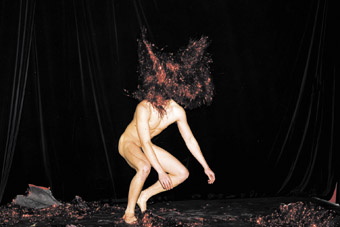
Justin Shoulder – U Little Stripper!
photo Alex Davies
Justin Shoulder – U Little Stripper!
WHAT IS IT THAT MAKES A PERFORMANCE NIGHT WORK? A SERENDIPITOUS BREW OF SKILL, TALENT, PRODUCTION AND ATMOSPHERE. BUT SOMETHING ELSE IS NEEDED, SOMETHING ELUSIVE AND UNNAMEABLE TO BOLSTER ALL THESE THINGS. AS WELL AS A GOOD DOSE OF BAD ATTITUDE AND RADICAL POLITICS, A GOOD NIGHT HARNESSES AND PRODUCES A TYPE OF CARNAL FREEDOM, UNIQUE TO SYDNEY, THAT IS IN SAD DECLINE THIS CENTURY.
Matt Stegh and Matt Hornby, who with the help of a small crew produced U Little Stripper! in June at Lanfranchi’s, can take a lot of credit for keeping alive Sydney’s bawdy, larrikin performance traditions. They began with the community event Man Jam, whose purpose was to promote sexy performance by men and poke fun at all-male revues. They were reacting to the absence of men on stage at alternative events, and the plastic aesthetic of mainstream gay performance and striptease. Man Jam produced a couple of nights at unlicensed venues during which a flood of talented, wild blokes strutted their stuff to packed houses. Then, having proved their point, they opened the doors to women, and realised their full potential in a pansexual incarnation. The events were in the subversive Weimar tradition of sex and satire. They moved to 34b on Oxford Street and, although the occasional great show was still to be seen, licensing laws and burnout effectively gagged the original intentions. The boys wisely had a rest. They returned with U Little Stripper! (ULS), a striptease performance night held the weekend before legendary art warehouse Lanfranchi’s was closed.
Lucky early punters were greeted by a human cake in high heels, wearing a ledge crammed with hand-made profiteroles. The stage in the main room was done in black velvet, and the other room was a dance floor which filled during interval.
Justin Shoulder is an exciting young artist who has produced an array of costumes that Leigh Bowery would be proud of. His full face and body sculptures are animist, absurdist, whimsical and monstrous. Shoulder understands proportion and character. He also knows how to inhabit his creations and make them move. He often performs with a percussion ensemble, enhancing the Asian inflection of some pieces. For ULS, he made a shiny red dog with pointy ears, long snout and big shaggy body, which turned out to be a clever series of fringed panels deftly removed one by one. The head-dress stayed on, the final vision a lithe body with dog head, dancing on a red sea.
Vixen Noir is an Australian based US stripper who has appeared at Gurlesque and Vanessa Wagner’s Newtown Hotel nights, and for many years been involved in queer activist performance. She’s slick and sassy, and works in a traditional twenty minute format, with a twist.
Kimo, F2M, relatively new to performing, brings to mind old school queer punk. Almost twenty years ago, Wicked Women pioneered a brand of feminist sex positive performance motivated by the need for dykes to smash shame and political correctness, and flaunt their bodies in public. Kimo is one of many who couldn’t exist without this legacy, and F2Ms are the new frontier. Kimo was crude and celebratory, rewarded like everyone by the hugely supportive crowd.
Max Imum was a schoolgirl lured by Mephisto to the Dark Abyss. In an hilariously sinister performance, Mephisto raped the girl before she turned on him with her fists. It was the classic revenge scenario refreshed by witty repartee, the casting of a fluffy puppet as Mephisto, some fine fight choreography and Max’s joyous, unbridled triumph.
The cops arrived at some stage, and would return the next week during Lanfranchi’s farewell party, when they entered and physically harassed people. But at ULS the jubilation, defiance and excitement were unquenchable.
The two Matts presented a madcap, surreal caper with a whiff of fin de siècle decadence. Dickie and Dickie were limp-wristed ponces who minced about in high cut trousers and cravats, bragging and bitching. It was like a one act play, complete with bizarre medley, choreographed number and semi-coherent dialogue pierced by fey screams. The Dickies slept in matching red satin gowns beneath a silver satin sheet…covered in brown stains. Half the action took place behind beautifully painted peacock screens with holes cut out for the performers’ faces as they dressed for a ball. They emerged in nude suits with knee length gonads and pencil penises.
Simone O’Brien and Nicci Wilkes (Guido) were newly weds in a side-splitting slapstick routine that featured domestic violence, an interactive cake-cutting ritual and a creamy blowjob, throughout which the groom’s yelling could be heard over the Billy Idol soundtrack, all the way to the back of the room. This show featured the best drag—both boy and girl—seen in a long time.
The sexiest man on Sydney stages must be Trash Vaudeville who graced ULS as a slender butch cowboy in tight black flares and ripped knickers. He is that rare thing—a master male hula hoopist who puts his own touch to an array of skilful tricks. After a nude trapeze interlude he gave us multiple hoops at the end, then the big finger.
Annabel Lines, seasoned circus performer, was classy and nasty in equal measure. She began with legs—in suspenders, fishnets and red pumps—disembodied, contorting. Her body gradually emerged, a dominatrix in cat’s eye glasses, black lace and long gloves. Two clowns upstage holding her hoop completed the picture of vaudi glamour.
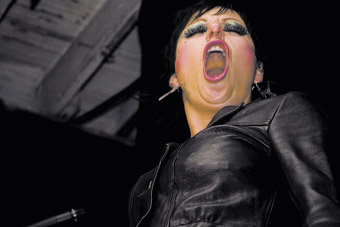
Christa Hughes, U Little Stripper!
photo Alex Davies
Christa Hughes, U Little Stripper!
Christa Hughes has developed a unique gender fuck striptease for events by this collective. She does a mean lip sync to macho soundtracks, tonight’s a leathered up rock star exhorting the stadium to indulge in mind-altering substances. She stripped to Love is the Drug, and finished with her signature tune The Lady is a Tramp, high kicking naked in long black boots. Hughes’ voice is consistently powerful, able to effect immediate changes in emotional register, the dodgy sound system no impediment.
Hughes was followed by her sister Vashti, as Uncle Funky, who gives excellent mike: “Fucken oath, how sexy was that Sheila? I wanna fucken meet her, and I mean m-e-a-t. I can’t help it, I’m a bloke, and I’ve got feelings.” Uncle Funky is a computer nerd who reinvented himself as a professional stripper, in baseball hat and Bonds singlet. With all the élan of his previous incarnation, he stripped down to an elephant glove puppet.
Celia Curtis and Dave Disaster performed a duet in fringed white costumes. It was vintage 1970s irony complete with wind machine, ending in an egg and feather fight. Curtis is capable of better—she is sheer genius at her best—but this was a fittingly funny and cathartic ending to the night.
At least that’s what we thought. The strip karaoke was yet to begin. The pandemonium let loose by the performers had set the room on fire and audience members began to get on stage and strip in an unstoppable stream—men, women, gay and straight. U Little Stripper! had achieved its purpose—liberation.
The strip karaoke revealed the true nature of the night, which was about celebrating what it means to be free and alive: and enjoying your body, to the fullest. Which might not sound like much, but in an age of puritanism, proscription and punishment, could well be the most radical thing of all.
U Little Stripper!, Lanfranchi’s Memorial Disco, Sydney, June 10
RealTime issue #81 Oct-Nov 2007 pg. 34
© Fiona McGregor; for permission to reproduce apply to realtime@realtimearts.net
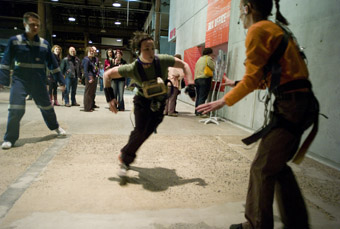
(foreground l-r) Martyn Coutts, Kate Sherman, Sharon Kerr, Wayfarer
photo Marco Bok
(foreground l-r) Martyn Coutts, Kate Sherman, Sharon Kerr, Wayfarer
GAMES BORE ME. MONOPOLY, SCRABBLE AND SNAKES & LADDERS WERE NEVER 3D ENOUGH. COMPUTER GAMES SEEM LIKE A RUSE: A FANTASY OF AGENCY WHEN IN FACT YOU’RE JUST A PAWN IN THE CONSTRUCT, ABLE TO BE BRUTALLY GUNNED DOWN AT ANY MOMENT. (OKAY, I’M NOT THAT GOOD AT THEM EITHER.) SO I WAS INTRIGUED YET TREPIDATIOUS ABOUT KATE RICHARDS AND MARTYN COUTTS’ WAYFARER, A LIVE, SITE-SPECIFIC, PERFORMATIVE GAME AT PERFORMANCE SPACE. BEING SLOW TO BOOK I WAS NOT ABLE TO BE AN ACTIVE PARTICIPANT BUT, THANKS TO THE MIGHTY ORANGE TEAM, ALLOWED TO HITCH A RIDE.
The first thing I notice is that Wayfarer is no mean technical feat. CarriageWorks is infested with multiple wireless networks allowing two-way audio communication between performers and audience, multiple live point-of-view camera feeds and complex positional tracking. Yet the human remains very much at the forefront of the activity, from the performer and player interaction before and during the game to the roving technicians ready with laptops to solve any little stagefright issues the technology might experience.
The rules of the game are kept simple: the audience teams of four have to direct their performer/player (wayfarer) to run around the cavernous CarriageWorks complex looking for triggerpoints which they swipe, seemingly by pointing at them. This gives the team “loot” and an instruction which they must then get the performer to act on. The instructions are minimal but involve interactivity between players or between players and unsuspecting bystanders: for example, “Follow another wayfarer for two minutes”, “Get 10 cents from a stranger” (the orange team managed to get 50 cents), or “Work with another wayfarer to reach the target.” The most alarming option is the “licence to kill” where one of the wayfarers gets the green light to hunt down the others and steal all their loot. It was not totally clear what this ‘murder’ entailed, and I’m pretty sure no lives were lost in our game, however the non-contact battle posturing between players was certainly amusing.
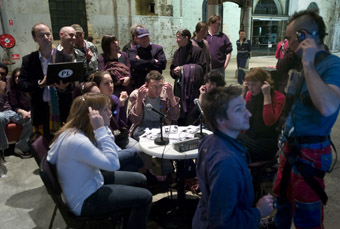
audience players, Wayfarer
photo Marco Bok
audience players, Wayfarer
The use of simple tasks and basic rules means that the strength of the game is in the quality of the interactions: between the performers, between performers and audience, and between audience members. The collective fulfilment of tasks means that the relationship between performer and audience is equal, making the interactions strong, direct and meaningful. The group dynamics of audience-players in their teams is particularly interesting to watch (the benefit of being an observer): who takes the lead, who is the problem solver, who has the most competitive drive? My favourite moment came when one of the members of the orange team who had rarely spoken very politely suggested, “We have six minutes left so if you could just take it up to a quick jog…” And let me say that the green team who won were just a little bit aggressive for my liking!
The most engaging aspect of Wayfarer is the integration of the live performers into the game, and the interplay with CarriageWorks itself. Early in the game, amidst a foyer full of theatregoers there are sudden squeals and shouts as the players tear through the space trying to catch each other. This moment is electrifying, forcing the audience-players to exist in simultaneous states of reality and virtuality which is pleasantly disorienting and even a little bit magical. The performers also return to base or come into visual range, but more of their live interaction in the real world would strengthen Wayfarer. Interestingly some audience members would have been more familiar with the building than others and I wonder how this affected their game. Knowing the space well I found that the activity of correlating real and virtual spatial information added another satisfying dimension. Either way, the audience-players and those living vicariously seemed to find Wayfarer engaging as both game and performance and I eagerly await the next manifestation to make myself part of the action.
performing objects & machines
Wayfarer was not the only activity infiltrating every nook and cranny of CarriageWorks on the final night of Performance Space’s July-August programming. The contraptions created by participants in Joey Ruigrok van der Werven’s Performing Objects and Machines workshop were also let loose on the foyer giving us a taste of the potential of a new generation of makers and theatre magicians. Many people felt that Tobhiyah Stone Feller’s elegantly simple Track Temptation—five segments of railway track suspended end to end, activated like a pendulum allowing them to gently clang—should be permanently installed and used as the interval bell.
Sarah Firth-Smith’s Emerging Artist—a wet-black, mutant tree whose squirming arms drew pictures wherever they made contact with the ground—had a creepy yet strangely endearing autonomous presence. Pongpassakorn Kulthirathum’s mobile audiovisual locomotive was ingenious in its self-contained efficiency; Marley Dawson interacted with and activated some of the heritage machinery left in the rafters; Michelle Outram generated electricity by playing the piano via a pully system; Kat Barron took 3D photos in a pyramid; Agatha Gothe-Snape went lo-fi, activating her paintings with cables and magic bells; and Clare Britton mutated like a Transformer into a giant mobile chook!
making the space work
All this activity, along with the Wayfarer team screaming past and the capacity audience from Version 1.0’s Deeply Offensive and Utterly Untrue pouring out, brought the CarriageWorks foyer absolutely to life. This vibrancy has also been present at events like Performance Space’s Night Time series (RT78, p38) and the recent Underbelly festival (co-produced by CarriageWorks, RT80, p44). But I can’t help comparing the joy of all this with the unease of the opening night of the July-August season when the theatre audience was overwhelmed by a massive department store fashion parade at the other end of the foyer. Of course there are understandable financial pressures on the CarriageWorks management to generate income, but the only way the venue will succeed culturally and develop an audience is by consistently filling its spaces with the stuff that it was actually built for—smart, challenging, bold and intriguing art.
For an interview with Kate Richards about Wayfarer, see RT80, p4. For another Performance Space event in the CarriageWorks foyer directed by Joey Ruigrok van der Werven, see Volta on November 24, 25.
Wayfarer, artists-producers Kate Richards, Martyn Coutts, technical producer-designer Mr Snow, House of Laudanum, programmer-software designer Jon Drummond, Squelch Media, performers Kate Sherman, Sharon Kerr, Ben DeMole, Ryk Goddard, wayfarer unit design Marty Jay, Steve Howarth, erth, screen design Tim Richter, SV2; Performance Space at CarriageWorks Sept 5-8; Performing Objects and Machines, facilitating artist Joey Ruigrok van der Werven; Performance Space at CarriageWorks Sept 8
RealTime issue #81 Oct-Nov 2007 pg. 35
© Gail Priest; for permission to reproduce apply to realtime@realtimearts.net
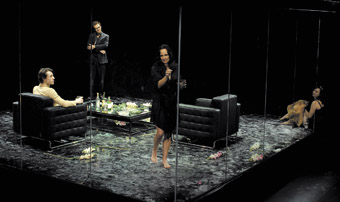
Simon Stone, Martin Csokas, Catherine McClements, Robin McLeavy, Who’s Afraid of Virginia Woolf
photo Heidrun Löhr
Simon Stone, Martin Csokas, Catherine McClements, Robin McLeavy, Who’s Afraid of Virginia Woolf
THEATRE CAN BE FRIGHTENING, EVEN WHEN IT’S FUNNY AND THEN ESPECIALLY SO. VERSION 1.0 AT THEIR MOST BAROQUE AND WITH FINELY TUNED ENSEMBLE PLAYING GAVE US DEEPLY OFFENSIVE AND UTTERLY UNTRUE, A REALLY SCARY IF WICKEDLY COMIC ACCOUNT OF THE SURREAL AUSTRALIAN WHEAT BOARD OIL-FOR-FOOD PROGRAM SCANDAL (SEE P37). ELSEWHERE IT WAS EUTHANASIA—SHOWN IN GRIM DETAIL—IN THE SYDNEY THEATRE COMPANY PRODUCTION OF DON DELILLO’S TENSE FAMILY DRAMA, LOVE LIES BLEEDING; MARITAL PATHOLOGY IN COMPANY B’S WHO’S AFRAID OF VIRGINIA WOOLF?—A CLASSIC PLAYED HERE TO A NEW LEVEL OF PHYSICAL EXCESS; AND GENETIC ENGINEERING IN DR EGG AND THE MAN WITH NO EAR, PRETTILY DONE WITH PUPPETS AND PROJECTIONS BUT FULL OF DIRE WARNINGS.
In all of these there’s a sense of entrapment, of finding ourselves looped into unwanted symmetries—like the genetic engineering we both desire (to improve the quality of life) and fear (the monsters it might make of us), the euthanasia that will improve the quality of dying but could excuse murder, the family that nurtures us but whose deeply embedded games keep us from ourselves.
love lies bleeding
In Don Delillo’s Love Lies Bleeding, an aged man on a drip sits in a wheelchair on a bleak American desert landscape beneath the harsh moon-like glare of two huge halogen lamps. He is so still he could be dead, or a dummy, as in one of those verisimilitude sculptures that used to spook us in art galleries. Shortly his double, very much alive, is wheeled on, recalling his first encounter with death as a child and musing on one of his failed marriages, the partners “living in the same skin” and “wishing each other dead in a car crash.”
But this exchange between Alex the artist and Lia his young wife, his fourth, who pushes his chair, turns out to be in the recent past. The play’s present focuses on the man as we first saw him, a comatose stroke victim. However Lia is convinced he is still responsive, noticing among other things his small tics at the approach of a storm. But his third wife, Toinette, and their son, Sean, have arrived, determined to put the old man out of what they perceive as his misery. What unfolds is a protracted argument: Lia in opposition, Sean determined, Toinette going along with the plan but losing her resolve. It’s the ready-made abstractions that mother and son trot out in justification for killing Alex that astonish the young woman, while we wonder if the son is acting out of compassion or a desire for vengeance, for a “life spent waiting” for a man now “holding us back.”
Sean eventually persuades Lia that the deed must be done and sends her walking in the desert. Her acquiescence is not really understood until late in the play. The deed itself however is gruesomely careless: the morphine is past the use-by-date, the euthanasia method taken from uncertain instructions on a website and the symptoms of dying difficult to detect. This waiting is painful. The body slumps.
We move forward in time. Lia is speaking at her husband’s funeral: she “refuses to tell stories.” Her memory of Alex, she says, is of his being, not anecdotes. We return to an earlier time, but with the knowledge now that Lia finally came to accept: “Alex could have gone on forever, I could not.” And then we loop further back to the play’s opening when Alex can still speak and utters the words that Lia most likely refused to hear: “I’m running backwards.” It’s a speech of deep despair from a man losing his sense of self, but it’s finally leavened with humour that Lia might have mistaken for undying spirit.
Love Lies Bleeding is a dream-like morality play, wisely staying short of nightmare, written, directed and performed without sentimentality or melodrama and tempered with occasional black humour (including the curtain call in which the dummy, a very real actor, stands and takes a bow). Paula Arundell’s portrayal of Lia is wonderfully subtle, the initial aura of new ageism giving way to wisdom. Benjamin Winspear brings a poetic animation to Sean’s unswerving sense of purpose; Robyn Nevin carefully reveals Toinette’s growing sense of doubt and, in the little we see of him, Max Cullen plays an essentially quiet, fading Alex with finesse. Little is glimpsed of the difficult younger man we hear about or, a fault with the play, of the artist and his practice. The great strength of Love Lies Bleeding is, as you would expect, in the poetry implicit in the writing and the idea that a coming together of divergent personaiities can yield change that, even if a tad mismanaged, is nonetheless as it should be.
who’s afraid of virginia woolf?
It was a pleasure to be able to enjoy another demanding American play shortly after seeing Love Lies Bleeding. In Albee’s classic love looks close to dead. The vicious co-dependency of Martha and George is a relationship nonetheless, but the symmetry is broken when Martha reveals the secret of their (actually non-existent) boy child to some young late night guests (well on the way into their own marital knot). Martha has betrayed the trust implicit in the fantasy she shares with her husband and, in the course of an overnight binge of drinking and cruel game-playing, a vengeful George (already deeply humiliated) ‘kills’ the son, eliminating a key part of the couple’s relationship.
The power of the play resides in the accuracy of Albee’s heightened rendition of the strategies of everyday dialogue. We observe with growing anxiety and fascination the interplay of Martha’s direct, vulgar assaults and George’s snide commentary on how she speaks and thinks. From the outset neither can give way to the other, they are locked in a pattern of escalating asymmetry until it momentariily collapses, when the words give out, into physical violence and sexual betrayal. Inevitably talk starts up again, but will the relationship ever be the same?
Benedict Andrews and cast get the language games right—and the bigger games too, like “get the guests” and “humiliate the host.” Martin Csokas is particularly effective as George, combining a sense of embittered interiority with a veneer of extroversion. Csoka’s low toned, laidback delivery is occasionally reminscent of Richard Burton’s intoning, without being at all imitative, and he is able to pull off an unbelievably quiet, fast and threatening sotto voce. The only thing I missed was sufficient marking of the occasional sense of intimacy and knowingness between George and Martha when they mutually acknowledge their game playing.
As is to be expected of Andrews, the production speaks to us on many levels. The stylish all-sheen-and-surfaces set by Robert Cousins is a loungeroom in black leather, chrome and two walls of glass. In the first act the glass is behind the performers, in the second it is between audience and performers, the characters appearing as if caged specimens and the glass, table, floor, walls literally awash with their spit, alcohol and a mountain of melted ice cubes which George earlier emptied over the glass table. Sodden, they climb the furniture and slip and slide on treacherous surfaces—the mess of their psychological abjection given its physical correlative.
Once again continuity of vision, embodied in direction and design, is the hallmark of Andrews’ work, the revolving set echoing the same team’s design for The Season at Sarsaparilla (RT78, p11) and the director and designer Anna Tregloan’s glass wall in Eldorado for Malthouse (RT74, p42). Although I found the musical underscoring of the climactic argument undervalued the power of Albee’s dialogue and although I was not always convinced by Catherine McClement’s brittle depiction of Martha (some requisite vulnernability seemed missing), the relentless drive of this Who’s Afraid of Virginia Woolf and the image of a social world drowning in itself made for a grimly satisfying experience.
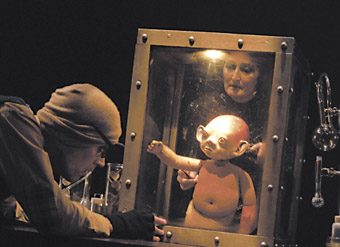
Dr Egg and the Man with No Ear
photo Heidrun Löhr
Dr Egg and the Man with No Ear
dr egg & the man with no ear
Like steampunk, if minus the punk, this “modern day fable” for 7-12 year-olds is sci-fi in a retro-ish setting. A man crashes his bicycle, has his ear eaten off by a bull terrier and slips into a profound depression—he sorely misses his ear but is incapable of doing anything about it. Daughter Vivi seeks out Dr Egg, a bald-headed Edwardian scientist type (cf Rolf de Heer’s Dr Plonk) who will grow an ear for the father from a slice of the girl’s body. The result, however, mutates into something else, with a life of its own.
The show is full of striking images—the splendidly frocked Snake narrator, clever alternations between the performers and small puppet versions of themselves (which the actors manipulate), multi-layered design (parallel performances in front of and behind the screen that flies in and out of the Constructivist proscenium), large-scale projections that effectively evoke travel across landscape and city, an elaborate old world scientific laboratory, and witty puppeteering in the genetic engineering of a tomato with a fish and, not least, the new ear that sprouts legs. The magic is reinforced by an onstage solo musician, Biddy Connor, who provides effects and an engaging score from, among other things, percussion, toy piano and vocals.
While all this seems clear enough—a reasonably simple story and ample spectacle—the show sometime feels quite complicated and the transitions from performers to their puppet selves slow and elaborate. The tale is framed by the Snake narrator—appearing first as an animation, weaving through foliage, and then as a glittering human version who has to then elaborately shed her frock. It makes for a very slow start not to mention introducing the (possibly complex) question of why a snake, while a certain moral heavy-handedness seemed already evident—“a story of human folly”, Snake declares—for a show apparently about the complexities of choice in the age of cloning. Annie Lee (from the Kransky Sisters) eventually manages to engage as the reptile, although the headmistressy diction amplifies the show’s retro tone and evokes a quainter theatre for young people of days gone by.
The one-dimensionality of Dr Egg himself—in no way able to represent any of the virtues of genetic engineering—is worrying, and not the fault of performer Colin Sneesby. Although Dr Egg and the Man with No Ear is not a play of character complexity (the father is deeply depressed but invested with just enough gravitas by Brian Lucas; Vivi with feeling and pragmatism by Lara Tumak), the issues are complex. Some of this is conveyed—the new ear creature is a living thing and cute, dammit—but insufficiently because that word ‘folly’ seems to hang pre-emptively over the whole enterprise. Snake asks towards the end, “Who is to blame?”, and you wonder, ‘For what, precisely?’. For a daughter’s concern for her suffering father? The narration and the portrayal of the scientist suggest a crime has been perpetrated, the story however suggests something else. I was confused, as were the youngsters around me. This is a play then not about choice, but a wrong choice—and what other is available to Vivi in her world? Oddly, the writer Catherine Fargher, is no stranger to the complexities of biotechnology whether in her account for RealTime of working with tissue culture (RT65, p17) or in her witty performance, Biohome (RT 75, p 34).
Although theatrically sophisticated and expertly realised as such (director Jessica Wilson), Dr Egg and the Man with No Ear is weighed down with message and the mechanics of production. Fargher’s writing ranges from flat to incisive to droll—“Why exercise when you can simply mutate?” The performances are good though a little more complexity all round wouldn’t go astray. Re-worked, better paced and made less internally contradictory, Dr Egg and the Man with No Ear could enjoy a long life as a relevant and magical work for our time.
Sydney Theatre Company, Love Lies Bleeding, writer Don Delillo, director Lee Lewis, performers Paula Arundell, Max Cullen, Robyn Nevin, Benjamin Winspear, Shaun Goss, designer Fiona Crombie, lighting Luiz Pampolha, composer Paul Charlier; STC Wharf 2, July 12-Sept 1; Company B, Who’s Afraid of Virginia Woolf?, writer Edward Albee, director Benedict Andrews, performers Martin Csokas, Catherine McClements, Robin McLeavy, Simon Stone, designer Robert Cousins, costumes Alice Babidge lighting Niklas Palantji, sound design Jeremy Silver; Belvoir St Theatre, Aug 8-Sept 16; Dr Egg and the Man with No Ear, concept by director Jessica Wilson and writer Catherine Fargher from a story by Fargher, performers Annie Lee, Brian Lucas, Lara Tumak, Colin Sneesby, designer Jonathon Oxlade, animation Jamie Clennett, composer, musician Biddy Connor, composer James Wilkinson, lighting design Phil Lethlean, producer Performing Lines; The Studio, Sydney Opera House, July 25-27
RealTime issue #81 Oct-Nov 2007 pg. 36,
© Keith Gallasch; for permission to reproduce apply to realtime@realtimearts.net
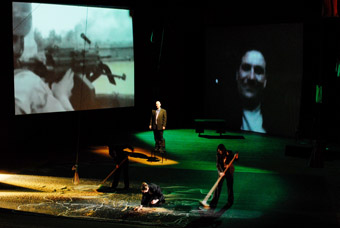
Deeply Offensive and Utterly Untrue
photo Heidrun Löhr
Deeply Offensive and Utterly Untrue
THE FINE PERFORMANCE STRATEGY BUILT BY VERSION 1.0 OVER THE LAST FOUR YEARS (CMI, WAGES OF SPIN, FROM A DISTANCE…) ARRIVES AT ITS MOST NUANCED AND DELICATE IN A PIECE ABOUT THE DRIEST SUBJECT MATTER: WHEAT. DEEPLY OFFENSIVE AND UTTERLY UNTRUE IS AN INQUIRY INTO THE 2005 COLE INQUIRY INTO THE UN OIL-FOR-FOOD PROGRAM WHICH WAS EXPLOITED BY THE AUSTRALIAN WHEAT BOARD WHO PAID SADDAM HUSSEIN’S REGIME IN IRAQ $300 MILLION IN KICKBACKS WHILE THE AUSTRALIAN GOVERNMENT WAS PREPARING OUR TROOPS FOR WAR IN THAT COUNTRY.
The work steals its title from the “polished” rhetoric of the Minister for Foreign Affairs, Alexander Downer. The idea that the Australian Government “went to war to protect its wheat market” was, he declared tersely, “deeply offensive and utterly untrue.” Version 1.0 use theatre as a mode of interrogation, here into repeated attempts by bureaucrats and politicians to create a veneer of truthfulness by using evasion and obfuscation, only to mire themselves and the government in ignominy.
Version 1.0 are at their canniest when they compel the words of their subjects to do the job that has to be done. Words here are objects to be offered in place of meaning. Version 1.0 recycle and rehearse these words, as if testing whether this time spoken slower, faster, funnier or intoned, we might understand what is actually being said.
Not a chance. Blank parody becomes a way to restage meaninglessness. We hear the emptiness, variously desparate, raging and slick, of politicians and administrative bunglers at their best. “I don’t know”… “I don’t recall”….”I can’t remember” becomes a chorus of practiced deniers performing a chamber piece from transcript ‘scores’ on music stands. In a recurrent direct video feed from the CarriageWorks bar, Stephen Klinder drolly recites Alexander Downer’s parochialism for the benefit of the media masses: “You see”, he repeatedly reminds the camera, twee-ly and with pursed lips, “It’s very, very complicated.”
Version 1.0 go to great lengths to unravel the complications of the corruption scenario. In playschool-like skits they physically spell out the money chain, the information chain, the wheat chain, the political chain. Kym Vercoe runs a marathon over a chalked world map, charting wheat markets across the globe. To track the cash flow, the performers enact an escalating transaction scenario conducted between Iraqi middlemen, a growing number of non-existent trucking companies around the world and Wheat Board executives. After aptly playing with a remote control toy car, Michael Long, AWB Sales and Marketing Manager, reveals with disingenuous naivety how the trucking fee was likewise toyed with and casually inflated—here a calculation scribbled on paper on someone’s back and flaunted before the camera. Not at all complicated.
Sean Bacon’s videowork is superbly Brechtian: each testimonial undercut with the biting satire of a suspicious longshot or looming close-up, or a parodic intervention into the scene with images of Iraq—that ominously ‘other’ world. Gail Priest’s lilting Arabic folk music motifs compound these visual statements, becoming tantalising reminders of how we construct the exotically faraway. In a deep corner, at a distance, Saddam Hussein appears on a portable monitor. His televised trial offers a minute backdrop to the events played big screen. Up close, a projected mouse teeters on a piece of cheese placed in a trap. It takes a moment, but we soon notice that the mouse is live onstage, in a cage. Underneath the projected image, an awkward Peter Greary, General Manager of Trading at AWB, is questioned…but doesn’t take the bait.
So many of these moments animate the dry and dusty annals that are the Inquiry report itself. We are told at the beginning that, laid out in reams along one side of the stage, it is “confidential…but can be downloaded online.” This kind of paradox continuously haunts the Inquiry and feeds version 1.0’s unrelentingly coy, cynical tone. Frankly, I’m thankful that they got to all of those words first before we had to read them. What they reveal is the absolute shambolics of due process, the hollow gesture of an Inquiry which hasn’t interrogated or unpacked anything at all. In this sense version 1.0’s performance of a performance of (un)truthfulness is at once deeply abhorrent and utterly entertaining. Next time, Alexander Downer might want to watch his words.
Version 1.0, Deeply Offensive and Utterly Untrue, devisor-performers, Stephen Klinder, Jane Phegan, Yana Taylor, Kym Vercoe, David Williams, video artist Sean Bacon, dramaturgy Paul Dwyer, physical dramaturgy Christopher Ryan, sound Gail Priest; Performance Space, Aug 24-Sept 8
RealTime issue #81 Oct-Nov 2007 pg. 37
© Bryoni Trezise; for permission to reproduce apply to realtime@realtimearts.net
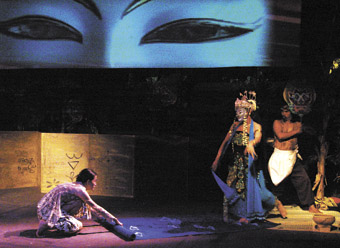
Maryam Supraba, Monica Wulff and Gusjur Mahesa, The Tangled Garden
photo Don Mamouney
Maryam Supraba, Monica Wulff and Gusjur Mahesa, The Tangled Garden
IN LUSH, ALMOST DAMP SURROUNDS, PERFORMERS CAMP BENEATH BANANA PALMS AND DELICATE BAMBOO PROJECTIONS. THEY HOLD COLOURFUL MONKEY-FACED FANS, COYLY PEEPING AT THE AUDIENCE FROM BEHIND BOLDLY PAINTED BABOON EYES. AS GAMELAN RHYTHMS PATTER INTO THE MIX—A DRUMMER SLYLY TAPPING IN THE DEPTHS OF THE STAGE—THE INTIMACY OF THE SIDETRACK PERFORMANCE SPACE SETTLES US INTO A FEELING OF TROPICAL OTHERNESS. WE ARE DISTINCTLY CAUGHT IN THE EXOTICS OF ELSEWHERE.
Don Mamouney’s script for The Tangled Garden restages the theme of encounter between east and west. In an exchange between traditional Indonesian and contemporary theatre work the show has toured Bandung, Jakarta and Darwin. Presented with the rich but awkward resonance of the intercultural moment, the audience is at the centre of this meeting, invited to draw in the steamy scent of greenery known mainly to a different climate. Language is strange, truncated or sometimes altogether untranslated. We are given grabs of what we are accustomed to amidst much that we are not. In this, we function as witness to, and dynamic part of, the east-west meeting itself.
The cross-cultural theme is realised in the fable-like fates of two childhood friends who meet as adults and love the same enchanting woman, Dewi (Maryam Supraba). Ariel (Alex Blias) holds all the rich clichés of western bookish education and worldly knowing, while his counterpart, Ujang (Dedi Warsana) is plainly strong in body, borne of the earth. The premise of the plot is simple—two brothers fight it out, battling their own inner demons, for a woman who cannot choose between them.
The narrative treats this premise with a degree of confusing complexity. We witness the men sacrifice their love of each other for Dewi, they ask the gods to intervene, but then Dewi overrides the decision of the gods and makes her own choice, only to re-decide again later. The men die in a moment of mutual suicide, swap heads upon rebirth, and seem to resolve nothing but the continued itch for Dewi’s beauty and the promise of some good sex to boot.
As the story increasingly entangles itself, nothing much eventuates out of a question that perhaps hasn’t been asked in quite the right way. For a start, the men’s desire is heartbreakingly simple, as is Dewi’s irritatingly undecided response to their continued adulations. Perhaps intended to signify an ultimate philosophical quandary, her flitting between partners strangely reads as more of a precocious yuppy panic. The ‘west’ of intercultural surely erupts in unintended ways here. Why do we care who she chooses? Is the textual premise actually about choice at all?
As a metaphor, the Tangled Garden story replays the central conceit of the production, which is suitably more invested in the dramatic form and process demanded of cross-cultural practice than its narrative outcome. A collaboration between Sydney’s Sidetrack Performance Group and Komunitas CCL in Bandang, Indonesia, the work was produced during four months of exchange, training and dialogue between two theatres steeped in important histories of collaboration and transformational community-building.
The function of the work on this level is clear. Carlos Gomes (direction) and Iman Soleh (movement) have embedded the form with the tension and strength brought to such exchange. The ensemble are well-versed in a physical vocabulary of Javanese dance coupled with an amusing pantomimic mode. Song, image and exquisite Cirebonese mask work illuminate the potential for deep dialogue within cross-cultural practice. Tangled Garden comes alive when body and sound animate the kinds of ideas that text may not. In these moments, chorus performers enact the burlesque hilarity of a burning groin; a humanoid rooster crows the dawning of the day; a guru is less interested in enlightenment than in a crude bit on the side.
Monica Wulff as the goddess Sri Pohaci strikes an interesting presence with a continued watchful eye that transforms into action with a thunderous masked dance sequence, beckoning mere mortals back to order and life. Wulff’s performance is startling partly for its latency: we barely see her move throughout the work, and then suddenly, scatty commedia are focalised with the rhythmic and angular precision of her finely-tuned technique.
With such potential in performers and the richness engendered by the meeting of two different theatrical worlds, The Tangled Garden offers a fusion of east and west in process in ways that its story does not. In practice, there’s no need to choose, but a plenitude available for all.
Sidetrack, The Tangled Garden, writer Don Mamouney, design, direction Carlos Gomes, performers Alex Blias, Gusjur Mahesa, Maryam Supraba, Dedi Warsana, Monica Wulff, movement Iman Soleh, sound Yadi Mulyadi, video Assad Abdi, lighting Yadi Mulyadi, Adji Sangiadji; Sidetrack Theatre, Sydney, Aug 22-Sept 9
RealTime issue #81 Oct-Nov 2007 pg. 38
© Bryoni Trezise; for permission to reproduce apply to realtime@realtimearts.net
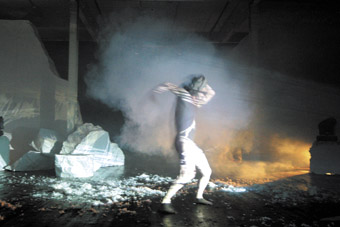
Angus Cerini, Chapters from the Pandemic
photo Marg Horwell
Angus Cerini, Chapters from the Pandemic
A NAKED ANGUS CERINI LIES PROSTRATE UPON A STAINLESS STEEL TABLE. BODY HAIR REMOVED, GENITALS STRAPPED IN A POLYESTER SACK THAT APPEARS TO MAKE HIS SCROTUM SWELL, CERINI INVOKES A NEUTERED MUTE ABOUT TO PUNCTURE THE WOMB AND UNLEASH HIS APOCALYPTIC PERSONA UPON A RUINED WORLD.
Resembling the bastard son of a thousand maniacs, his elevation from the table is accompanied by twitches and spasms that contrast nicely with the rustic sounds of a farmyard dawn. Beyond Cerini’s shattered form, the remnants of a vast white wall lay strewn across the space. A fissure in the wall opens out into a dark embrace, a cataclysmic world enveloped by eternal darkness. Nuclear winter, the lower cerebral cortex or a perverse vision of a tyrannised chicken staring outward from its recently cracked shell…Who knows? Chapters from the Pandemic invites contemplation. Through it, we come to know a tome that is the hidden recess of the human imagination.
Silent but deadly, Cerini’s paroxysms are heightened by sophisticated strobe lighting and high voltage digital imagery. His body becomes a telematic screen upon which is administered a kinetic impulse intermittently interrupted by a shock of pre-recorded sound. As if punished for daring to conceive of a thing so beastly, a sudden overhead snap releases a hidden trapdoor and down upon Cerini descends the plumage of a thousand debreasted chickens. Yet this could also be a snowstorm on a winter’s noon cast down upon the world in some Icelandic myth, or a snap-frozen, now shattered ocean harboring an inverted King Neptune.
Time passes… Day, night…Who can be sure ? Cerini pumps up the vibrato and emerges dripping wet from a movement riff with sweat illuminating his waxed, jerked-off form. Watching him, finger dancing in his mouth in a ballet miniature, we come to appreciate this creation in much the same way as a person might express great sympathy, yet conceal laughter, when confronted by the creature that might have been if Lynch had not scripted the killing of his mutant offspring in Eraserhead. Like that film, this performance momentarily steps beyond the cabal of its own grandiloquence. Most impressive is its subversion of a popular aesthetic form. Animation can make the fantastic appear actual, but Pandemic’s triumph is that it successfully links the actual with the fantastic, minus animation’s usual cute escapism. And even though Cerini’s persona is named Meatwise, we are never in doubt that Meatwise is anything other than an unsealed incarnation of Angus Cerini on a beguiling, disconcerting ride into the lost highway of his soul.
If there is one quibble about this alluring performance, it is that the theatrics are so refined, its effects so special, its production values so slick, that Cerini’s obsessions never quite slash their way into the poetic imagination. I’m enthralled, yes, but never completely moved.
Chapters from the Pandemic, performer, writer, director Angus Cerini, design Marg Horwell, lighting Rachel Burke, sound Kelly Ryall, video Michael Carmody; 45 Downstairs, Melbourne, Aug 11-19
RealTime issue #81 Oct-Nov 2007 pg. 38
© Tony Reck; for permission to reproduce apply to realtime@realtimearts.net
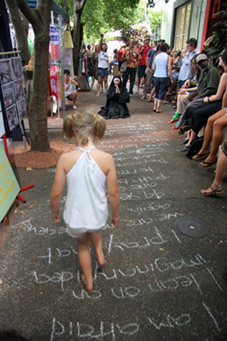
A Prayer, Jill Orr, Interpositions
photo Fiona Morrison
A Prayer, Jill Orr, Interpositions
INTERPOSITIONS WAS STAGED AS PART OF THE DARWIN FESTIVAL PROGRAM BY 24HR ART AT VARIOUS PUBLIC LOCATIONS AROUND THE CITY IN A WEEK LONG SERIES OF ROVING INTERVENTIONIST PERFORMANCES. FOCUSED ON THE PERFORMING ARTS AS A CONDUIT FOR INTERCULTURAL DIALOGUE, COLLABORATION, AUDIENCE PARTICIPATION AND REACTION, THE EVENT FEATURED TEN ARTISTS: JILL ORR, ANN FUATA, ASH KEATING, JASON KEATS, HAYLEY WEST AND DANIELLE FREAKLEY FROM AUSTRALIA, AND FROM SINGAPORE JULIANA YASIN, KHAIRUDDIN HORI, RIZMAN PUTRA AND LYNN LU.
Jill Orr appeared in a performance entitled A Prayer wearing a nun’s habit. For much of the performance she was on hands and knees scribing on hard pavement, beginning with “I stand on Larrakia land. I pray for the children.” Orr continued with a functional but loose, organic sway and at times stood, gathered herself and then returned again to her cathartic writing. At moments she appeared struck somehow, like a savant illumine in a cinematic pose. Much of Orr’s oeuvre can be characterised as enactment of iconic still imagery. This performance was located in the Darwin weekend markets where the tightly packed stalls created a cloistered tunnel. The stalls’ canvas walls produced dramatic flat planes of light and dark and elsewhere dappled sunlight streamed down on the achingly spiritual scene. In this way the performance related to Orr’s larger body of work. In evidence as early as 1979, in Lunch with Birds where her figure became a vessel, covered in loaves and small fish, Orr is often associated, as performance theorist Anne Marsh has pointed out, with images of sacrifice and endurance.
More typically, the nun is cast by Orr as an institutional character, pertinent in these times of renewed governmental vigour, some say a new colonialism. In this way the performance spoke equally to the past, present and future. On the one hand, Orr’s persona stands in for the ‘alien other.’ This is convincingly conveyed—her dissociation with place is apparent in the prickly contrast of the black cloth and stockings against the pounding heat of the sun. On the other hand, the religious habit does not appear as divisive as it once might have. No longer are conclusions cast in black and white or good versus evil. Rather, the religious figure is read as a universal character—we are all implicated. Orr confirms this: in her original design she may have taken the habit off, but ultimately didn’t need to.
The words chalked on the marketplace pavement were given another life by a passer-by who read them aloud. This anonymous, Indigenous gentleman, old and weathered, didn’t just say them, but theatrically delivered them, giving the performance further resonance, complexity and a sense of complicity. Shortly thereafter another Aboriginal man contributed his own aptly contradictory utterances: “You’re evil, sister” and “We love you, sister.”
The words of a guest speaker at another Darwin Festival event resonated. Gary Lee in his Larrakia welcome to country for the National Aboriginal Torres Strait Islander Award exhibition affirmed that “The federal invasion into Aboriginal communities and the control, disruption and uncertainty foisted upon us, to our lives, should be condemned for what it is—a colonial style land-grab—in the name of protecting Aboriginal children.”
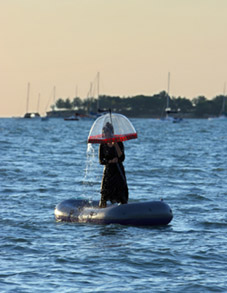
Lynn Lu, Interpositions
photo Fiona Morrison
Lynn Lu, Interpositions
A Punch in the Gut: Experiential Knowledge, Empathy and Performance Art is the title of a doctoral thesis by Singaporean artist Lynn Lu currently studying in Japan. The title provides entry into her Interpositions work and a performance practice that she has built extensively over the past 13 years in the United States, North and Southeast Asia and Europe. As Lu affirms, “there are some things in this world that you can only know through personal experience and this kind of knowledge is very different to knowledge you receive from others, knowledge you accept on faith or which is based on logic or inference.”
One sunset on the azure Arafura Sea, Lu rows a rickety rubber boat far from the Darwin shoreline. With increasing distance her figure becomes a silhouette. What occurs is absurd: kneeling in the boat, she pops up an umbrella and a summer rain falls. Elsewhere it is sunny. The rain falls from her umbrella to create a tinkling structure of entrapment. After a time the boat sinks. Lu disappears, consumed by the sea. She has been, in her own words, “dunked” and needs to swim to shore.
Compared with Lu’s previous performances, this can be considered a diaristic piece which the artist has jokingly labelled her “love series”—having recently fallen out of it. According to Lu the performance draws on a strong image that occurred to her from a moment towards the end of her relationship, of being in a private rainstorm and how absurd it is to somebody watching from the outside in apparent sunshine. In this way the location of Darwin brought to bear other associations not necessarily intended by Lu. The Darwin shoreline as Australia’s most northern waters is a deeply ambiguous and politicised space. According to locals on the shoreline, unaware of Lu’s personal metaphor, the performance was cast in more political terms, of being witness to a troubled figure at sea, but not necessarily able to do anything about it.
Rizman Putra’s explosive energy and hilarity was contagious and also rooted in experience. He dressed in various costumes, but most often wore a cute mask, made in the form of a dog’s head, and a full-body lycra suit. The energy with which he trashed plastic flowers against an asphalt surface, chucked a total, full-body tanty, rolled around the floor, four legs bent like a dog, was laudable. Putra is determined to create “a space in which to be silly” and to enact a cliché—“really bad performance.” In general terms the audience followed his chaos assisted through much of the performance with ‘signs’, a performance approach made famous by Bob Dylan and now itself clichéd through appropriation in music videos. Rizman fashioned an acute wordplay on tropes like ‘rock and roll’ and ‘heavy metal’ to a soundtrack of mixes including Elvis Presley and 80s rock band Survivor. Quotation from the genres of poetry, photography, video, music, burlesque and dance were given an airing in Rizman’s tight if chaotic performance.
Singapore artist Khairuddin Hori’s stark yet teasing, porn-like routine was consummately staged in the unsoiled environment of a well chosen sparkling laundromat. Melbourne’s Danielle Freakley engaged her audience with the Quote Generator in which language is stolen, concentrated and overdramatised with well-known quotations assimilated into everyday life to remarkable effect. While Darwin’s Hayley West invited audiences to her market stall for complimentary card or letter writing on their behalf or to exchange small personal items, Ann Fuata focused on the personal and rituals of hair and identity.
A shared strategy was employed across Interpositions, a casual sense of play that was engaging and participatory.
24 HR Art, interpositions, Darwin Festival, various locations, Aug 11-18;
http://interpositions.blogspot.com/; http://www.youtube.com/24HRArt
RealTime issue #81 Oct-Nov 2007 pg. 40
© Allison Gray; for permission to reproduce apply to realtime@realtimearts.net
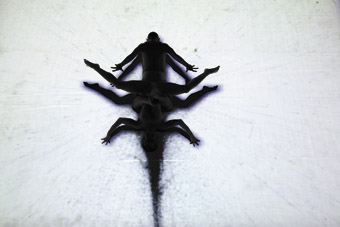
Mortal Engine, Chunky Move
photo Rom Anthonis
Mortal Engine, Chunky Move
ONE OF THE MOST INNOVATIVE AUSTRALIAN PERFORMANCE WORKS OF RECENT TIMES, GLOW, WAS THE OUTCOME OF A COLLABORATION BETWEEN CHUNKY MOVE ARTISTIC DIRECTOR GIDEON OBARZANEK AND GERMAN INTERACTIVE VIDEO SYSTEMS MAKER FRIEDER WEISS. AFTER PREMIERING IN MELBOURNE AND SUCCESSFULLY TOURING TO THE SYDNEY OPERA HOUSE STUDIO, GLOW IS FEATURED IN THIS YEAR’S MELBOURNE INTERNATIONAL ARTS FESTIVAL. AFTER THAT, IT’S OFF TO VANCOUVER’S PUSH INTERNATIONAL PERFORMANCE FESTIVAL, NEW YORK’S THE KITCHEN (IN PARTNERSHIP WITH PS21 AND THE JOYCE THEATRE) AND LONDON’S SOUTHBANK HAYWARD GALLERY. IN THE MEANTIME, A NEW WORK, AN EVOLUTIONARY STEP ON FROM GLOW IS ALREADY IN DEVELOPMENT FOR AN EARLY 2008 PREMIERE.
In Glow, the audience look down from all sides of the theatre onto a white floor-cum-screen on which a dancer generates an animated environment, initially taut and geometric and then ominously impressionistic. The performer appears to evolve from a huddled form into human shape, creating a world of astonishing shapes and colours around her, one which eventually takes on a threatening life of its own. It’s an intense experience and, dark as its theme appears to be, an exhilarating one, the thrill not simply at the technological magic but in its meaningful integration.
It seems long ago that laser-driven interactivity offered an apparently unique potential for performers to drive their own lighting and sound effects, but it rarely came to much. However, using instead interactive video systems developed by Frieder Weiss with his Calypso software, Glow effectively and convincingly realises the dream. Now, in a new work, Mortal Engine, Obarzanek and Weiss come together again, but this time with Melbourne-based sound artist Robin Fox on oscilloscope and sound and, yes, adding lasers.
For Obarzanek, lasers offer “a way of getting off the screen into the volume of the space, including above the audience in the auditorium.” As well Weiss has got the video and laser systems speaking to each other. The advantage of the laser system is that, as well as being responsive to sounds, it can track more bodies than Glow’s one dancer, allowing Obarzanek a cast of six.
Obarzanek says that for Robin Fox it’s a return to working with the oscilloscope (his recent focus has been on lasers) here projected onto the screen floor, following a dancer (thanks to an algorithm created in Weiss’ Calypso) as well as responding to sound files, as it has done in Fox’s powerful sound art works. Both Weiss and Fox will work live in Mortal Engine, meaning that visuals and sounds can change performance to performance. The company will skill up a trainee in the technology for subsequent seasons.
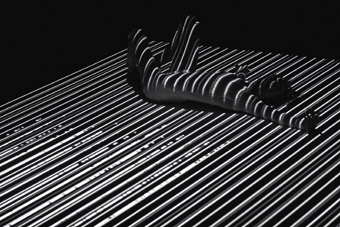
Kristy Ayer, Glow, Chunky Move
photo Andrew Curtin
Kristy Ayer, Glow, Chunky Move
Compared with Glow, there is an exponential growth in realtime interactivity and its variables in Mortal Engine. Towards the end of Glow, Obarzanek says, the graphics, in relationship to the performer’s body, had become semi-autonomous. He and Weiss wanted to go past the “quite straightforward” approach of Glow to a point where the environment in Mortal Engine, he stresses, “will most certainly have a life of its own.”
Mortal Engine will also be a longer work, 60 minutes to Glow’s 26, but not all of it technologically governed and not all danced. There will be passages created with the dancers where the video-laser system will be in ‘off’ mode and another in which Robin Fox will project his oscilloscope onto a stage emptied of dancers and filled with sound.
Again, the stage floor will also serve as a screen, but given the considerable challenges Glow offered presenting venues (many theatres find it hard to provide the audience overview and some have had to build the appropriate banks of seating), Obarzanek has opted for a raked floor that can be deployed on a conventional stage. Given what he describes as his “aversion to vertical screens”, the rake seems a good solution, especially when complemented with the overhead possibilities provided by lasers. The rake also has panels that unfold from the floor. The design is by Obarzanek working with the company’s production manager Richard Dinnen, the music by Iceland-based Australian composer Ben Frost.
Obarzanek’s vision seems to have a distinctive if lateral cinematic dimension—integrating the screen into his performance spaces in Glow and the forthcoming Mortal Engine, but also in making films. His first venture was a dance film for the ABC, Wet (1998), which he thinks he “took on far too early” and which “made him shy of film.” However, at this year’s Melbourne International Film Festival his 10-minute Dance Like your Old Man (2007) won Best Short Documentary against international competitors and the Nova Award for Innovative Australian Cinema. In the film women dance like their fathers while describing their relationships with them. Obarzanek recalls feeling “thrilled and shocked” about winning “because the film was so simple. I generally have an aversion to dance on film, but that makes it a challenge to do it.”
What particulary pleased Obarzanek was being rewarded for making a documentary. It’s what he’s been doing on stage, he says, in works like the poll data-driven Wanted: Ballet for a Contemporary Democracy (2002) and the interview based I Want to Dance Better at Parties (2004) which features men talking about themselves and dance). He suspects that the effectiveness of Dance Like Your Old Man comes from the tension between the images of the women dancing, on the one hand, and, on the other, what they say about their fathers: “it’s more complex, more difficult”, whereas “the dancing is cute but quickly runs out without the words.”
With the fellow creators of the celebrated Tense Dave (2003)—Lucy Guerin and Michael Kantor—Obarzabek shares another aversion, to dance theatre: “We like the idea but we don’t think it works.” But as with dance film, it’s something to take on, now for a second time. The low tech Tense Dave used a giddying stage revolve to great effect, constantly and magically, even cinematically, reframing action and images with limited means. The new work, Two-Faced Bastard, with the same team, is already in the making; “even more low tech, almost no costuming, strong performers and performed to two fronts. Two shows are presented at the same time separated by a curtain with the performers slipping through it from one show to the other. It’s a challenge because you can always hear what’s happening in the other show.” We can look forward to some more theatre magic and, doubtless, as in Tense Dave, Glow and Mortal Engine, human wilfullness tangling with an environment (low tech or high) that appears to have a life of its own.
Chunky Move is in full touring mode: I Want to Dance Better at Parties is soon off to Pittsburgh after a five city tour in the USA and to Vancouver and Christchurch earlier this year; and Glow has been to Sydney and Darwin, the Netherlands and soon travels to Beijing, Shanghai, Dresden and Perth before going on to the USA and UK. Obarzanek has no doubt that the company’s new works, Mortal Engine and Two-Faced Bastard, will provide major opportunities for international touring. Chunky Move will continue to take Australian performance innovation to the world—and in Glow and Mortal Engine, innovation born of Australian and German invention.
–
Chunky Move, Glow, Chunky Move Studio 1, Melbourne International Arts Festival, Oct 12-27, www.chunkymove.com, www.melbournefestival.com.au
RealTime issue #81 Oct-Nov 2007 pg. 41
© Keith Gallasch; for permission to reproduce apply to realtime@realtimearts.net
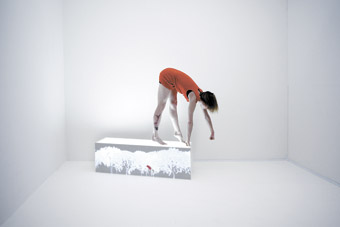
Lisa Griffiths, As You Take Time
photo Patrick Neu
Lisa Griffiths, As You Take Time
CHOREOGRAPHER AND FILMMAKER SUE HEALEY HAS MADE AN EFFECTIVE MULTIMEDIA INCURSION INTO GALLERY 4A’S VARIOUS SPACES STARTING WITH THE SHOP WINDOW ON HAY STREET, CHINATOWN WHERE DANCERS SHONA ERSKINE AND LISA GRIFFITHS OSCILLATE BETWEEN BUTOH-ESQUE SLOW MOTION, ALBEIT WITH WESTERN DANCERLY GRACE, AND SMALL, SUDDEN ARTICULATIONS THAT SUGGEST ROBOTICISED SHOP DUMMIES. BEHIND THEM ON TWO LARGE MONITORS THEIR MOVEMENTS ARE TRACKED AT A SLIGHTLY SLOWER PACE LEAVING PAINTERLY, DIGITAL TRACES. ALREADY, AS YOU TAKE TIME IS PLAYING WITH TIME, OUR SENSE OF IT HEIGHTENED AS A MIX OF INTENDING AND ACCIDENTAL AUDIENCE FORM SMALL ATTENTIVE CROWDS AND THEN EVAPORATE WHILE PEDESTRIANS BREEZE BY, SNATCHING GLIMPSES OF THE DANCE.
These initial movements and disorientations seem apt: Japan is the world leader in robotics, has given us the performative body states of butoh and, as Healey writes in her program (and many before her), to visit that country is to enter a very different time zone, where the fast is very fast and the slow is meditatively so.
Inside the small downstairs gallery space, Rachelle Hickson, in Ritual Room appears to cower in a corner, extending her long body to the full and then contracting, hand across face and fenced in by small cutouts, at her feet, of the letters T I M E. Meanwhile, in accelerated footage, video projections on three walls show on older Japanese woman dressing Hickson in traditional kimono complete with obi and footwear. The letters of TIME are rearranged by Hickson, perhaps in an effort at control, and then by an interloping Kei Ikeda who becomes the subject of the next passage. As geisha makeup is applied to her face in closeup on a video projection (another focuses on the foot and kimono movements of someone—Hickson?) Ikeda leans and rolls against a video image of herself. While these video transformations appear passive, the live action is tense, as if adjusting to new cultural pressures that constrain and fold the dancers’ bodies. In a brisk duet, the pair race in a circle before their bodies merge, falling slowly into each other. It’s interesting that although both dancers seem to experience similar states, Ikeda is Japanese. However, the program tells us she came to Australia as an eight-year-old and, of course, the images of kimono and geisha makeup belong to a very different time for Japanese and Australian alike.
The dancers invite us to follow them to the upstairs gallery where Erskine and Japanese dancer Norizaku Maeda, in Shona in Japan, solo and duet against three screens which they raise and lower. Here we’re immersed in sweeping images of Erskine on Tokyo streets and railway stations and by water ways, sometimes filling the whole space. On screen Erskine is often still, prominent in her red coat as the city world flurries about her, or she moves in near harmony with a group of men in a quirky little dance on the road or lines up with them to fish for carp. Mouthing exaggerated o’s, Maeda abstractly mimicks the carp we see in close-up. There are moments of intimacy in the live performance, where the brief images of urban life give way to a passage in which the dancers lie side by side, hands and arms entwining against city lights. The differentiations between day and night, between tourist time and everyday time, between work and play and between two people further the work’s temporal play.
Lisa Griffiths performs The White Room in exactly that, an adjoining bright space we look into where the performer stands on a narrow light box, one low wall of which is a screen for fascinating images created by Jason Lam. Griffith’s body is almost immediately taut, every extension as if a desire to exceed, but always abstractly, whether leaning out to the wall or tottering on all fours (on toe tips and clenched fists), working from the box’s narrow parameters. The first projected image on the box wall is a black and white negative of a tree growing and then shedding its leaves, and then dissolving into another tree, and another. A later image is of gently waving leaves of grass amidst which a tiny real time Griffith appears. The tension between Nature’s long-term time, amplified by the long whining notes of Darrin Verhagen’s score, and the human body’s urgent drives is palpable, not least in Griffith’s realisation of the exacting choreography.
We crowd into a black box of a room stacked with small mountain of DVD players and monitors. Here Maeda too exhibits a vibrating tension right to his finger tips as his hands gesture into the sole pool of light, as if reaching for something utterly and painfully unattainable. Finally, he simply switches the monitors on and leaves; we stare uncomprehendingly at images from other dance works and everyday family life. Time is retrievable, but how and whose?
The final passage, Norizaku in Australia, takes us into a large space featuring the whole ensemble. As in The White Room, Maeda, like Griffith, is hemmed in, restricted to performing atop a box. Here, expansive, serene, sunny coastline images are projected, but what first draws us in is sand falling from the performer’s cupped hands to the box top in an amplified reflective sonic reverie. On the screen Maeda is seen in the ocean, above the water line, gesturing abstractly from a rock plinth, a performance which he duplicates live—another kind of seeking across time and space? Meanwhile the four female dancers dance near and far in chorus, shaping their hands into binocular shapes with which they regard us and Maeda with touristy brevity to a bouncy pop score from Ben Walsh. Again different kinds of time experience are juxtaposed—the deep time of interiority and the filling-in time of kitsch—and doubtless we learn a little of Norizaku’s alienation, of feeling utterly isolated and intruded on.
Though deftly executed and alternating nicely between the intensity of Maeda’s performance and the neat frivolity of the ensemble dancing, Norizaku in Australia seems rather slight coming after the focused power of its predecessors. But it’s worth recalling that ‘artentertainment’ comes easier to Japanese culture than it does our own. This is something Walsh captures in his scores for Shona in Japan and Norizaku in Australia, drawing on traditional Japanese music and cheeky pop and using his own distinctive instrumentation (was that a piano accordion I heard)?
As You Take Time does not theorise cultural temporal difference, but it yields a pretty good impression of contrasting and overlapping sense experiences, not least from the mix of real and virtual means that Healey and her dancers and media artists deploy and by moving their audience through a range of states themselves. As You Take Time is an intricate, engrossing multimedia dance experience.
–
As You Take Time, director Sue Healey, performers Norikazu Maeda (Tokyo), Shona Erskine, Lisa Griffiths, Rachelle Hickson, Kei Ikeda, music Ben Walsh, Darrin Verhagen, lighting designer Nicholas Higgins, projection designers Jason Lam, Sue Healey; Gallery 4a Asia-Australia Arts Centre, Sydney, Aug 14-25
RealTime issue #81 Oct-Nov 2007 pg. 42
© Keith Gallasch; for permission to reproduce apply to realtime@realtimearts.net
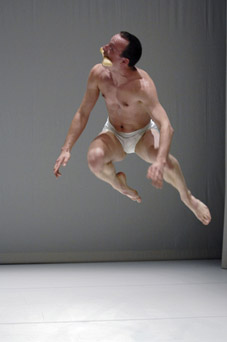
Kenneth Flak, CYP17, Future Tense
photo Ben van Duin
Kenneth Flak, CYP17, Future Tense
TWO MEN IN WHITE LOOK TOWARDS THE FUTURE: CONCERNED, IMAGINING, CURIOUS, THEY PRESENT UNIQUE VERSIONS OF THE HUMAN BODY, RESISTING AND/OR SAVOURING THE TECHNO-EVOLUTIONARY TALE IN WHICH THEY ARE IMMERSED. THE INQUIRIES ARE DELICIOUSLY EVIDENT IN EVERY MOVING FIBRE.
In Erection, choreographed and performed by French Canadian Pierre Rigal and directed by Aurélien Bory, the dancer emerges into movement through an efficient and contained physicality. Erupting from stillness through punctuated arcs isolated in the ribcage, as though hoisted on invisible hooks, he progresses to executing 360 degree flips of his entire body from a supine horizontal position. I watch closely his interplay with various projected minimalist blocks and lines like the bar code motif. It takes me some time to extricate this relationship (hopefully not about human surveillance) and feel his steady emergence from motionlessness to scampering, hands and feet pawing into the mat, taking hold. He chases incidental space between moving lines wiped in left and right at different speeds projected on the white square mat: a world of possible obstacles. It presents a periphery, the precipice to some unknown circumscribed black. He skirts the edges, edges skirting him; he isn’t standing yet.
The second half of the piece is taken up by Rigal’s now fully erect masculinised figure darting about in boxing shorts, delivering his entire body airborne through the chest, dissonant in rhythm, unbounded in a wild cacophony of sound and staccato light. Can he fly in this body? He seems to ask, “What is beyond our verticality?”
The strongest image is Rigal in perfect replication, centrestage, appearing transcendant, Such a crisp projection toys with my perceptions: who is the live Rigal? He enters his own image, crawls into it like a cat suit, eyeballing the audience for the first time. He invites us to see the telos of his futurism in the fullness and security of our own skin.
Andre Gingas’ CYP17 engineers theatrical absurdity through movement choice, structure and storyline. Dancer Kenneth Flak’s early gestures are repetitive and richly textured in quality, establishing a character of quirky vulnerability. He expertly tacks between sitting and standing postures whilst various stills flash onto the back of the three walled structure isolating him from the probing outside world. A mesmerising path is minutely inscribed by his quivering hands into the back edges of the space while we are led into some Kurt Vonnegut-like world of factual abstraction courting obnoxious interruptions from high volume Bollywood samples. Moments of the bizarre are dropped in, literally thrown in by a figure in a white space suit entering from the stage left Exit door. The sudden inclusion of a bone, then the torso of a calico dummy with velcro attached limbs and head, punctuate the exploration by this isolated man in tight white shorts of his externally controlled world with apparently non-human curiosity and physical experimentation. And yet he responds at all times within the bounds of human reaction: fear, desire, disappointment and joy.
The random flicking between scenes, at first repetitive in theme, disconcertingly explodes elsewhere into a classic contemporary dance vocabulary followed by a gymnastic routine. I’m further confused by the performer’s declamatory critique of the USA and reporting of CIA conspiracies. Yet on reflection, how do we come to know something? How far do we go to master our relationship with the world? And. more pertinently, what is the range of our own possibilities?
Mikhail Baryshnikov’s curation of FutureTense presents two singular investigations of the limits and potentialities of human embodiment whilst constrained within the ‘measure of a man.’ Who better to ask than dancers who dwell and creatively dream in their bodies at length?
FutureTense: curator Mikhail Baryshnikov; Erection, performer, choreographer Pierre Rigal, director Auriélian Bory; CYP17, choreographer Andre Gingras, performer Kenneth Flak; Playhouse, Sydney Opera House, Aug 1-12
RealTime issue #81 Oct-Nov 2007 pg. 43
© Jodie McNeilly; for permission to reproduce apply to realtime@realtimearts.net
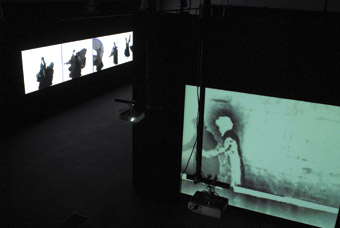
In Situ II, Still-Live, ReelDance Installations #03, CHOREOGRAPHICS
photo Heidrun Löhr
In Situ II, Still-Live, ReelDance Installations #03, CHOREOGRAPHICS
I SAW CHOREOGRAPHICS, THE THIRD IN THE REELDANCE INSTALLATION SERIES, THREE TIMES, EACH SUCCESSIVE VISIT INTENSIFYING THE PLEASURE OF THE EARLIER ENCOUNTER. THE HUGE AREA THAT PERFORMANCE SPACE NOW HAS ACCESS TO AT CARRIAGEWORKS FOR ITS GALLERY WAS IDEAL FOR THE FIVE-SCREEN SPREAD OF IN SITU II, THE PROJECTION ONTO A BED OF SAND FOR VIOLIN PHASE/FASE TOP SHOT, AND THE FACE TO FACE WALL SCREENS FOR STILL-LIVE. IN EACH OF THE WORKS THERE WAS A HEIGHTENED SENSE OF PATTERNING OF LIVE MOVEMENT INTO SOMETHING ELSE, DETERMINED BY MULTIPLE SCREEN MANIPULATION, RIGOROUS POINT OF VIEW WORK OR COMPUTER-INTERACTIVITY POSSIBILITIES.
Filmed against a white, deep background, In Situ II captures two female performers swirling in long full black skirts, their full sleeves later held straight with inserted poles, thus extending their physical sweep. The dynamic of their swirling is amplified by close-miking of the skirts (we listen through headphones), the swishing soon morphing into something like the rush of giant bird wings. The dancers’ sudden proximity to the camera and equally sudden distance from it is also bracing, the skirts filling the visual as well as the aural space. This immersiveness is further intensified by the dance of images from screen to screen, the makers using just one screen and rapidly building to five, or simply duplicating an image across all screens, working in twos and threes and other permutations.
Suddenly, it’s dark. Fluid movement is replaced with the wringing of water from sodden cloth, the crack of wet material, the snap of washed hair. What was airy and elegant (the costuming suggestive of middle class conservative female dress from the 18th century to recent times) is now liquid and sensual in this bracing Dutch-Moroccan creation from Said Mahrouf (costume designer, artist), Hester Tammes (writer, artist) and Toon de Zoeten (filmmaker). For curator Erin Brannigan the thrill of In Situ II also resides in how it recalls “the famous proto-cinematic performances of Loie Fuller’s skirt dances and the photographic motion studies of Jules Marey.”
In the same space as In Situ, Violin Phase/Fase Top Shot (Thierry De Mey and Rosas, Belgium) is another engrossing installation. You look down onto several square metres of sand onto which is projected dancer-choreographer Anne Teresa De Keersmaeker dancing, in turn, on a thin layer of white sand over a dark surface. In synch with the phasing of Steve Reich’s beautiful minimalist, pulsing Violin Phase, De Keersmaeker systematically marks patterns in the sand in a large unfolding circle, travels back over the same line, erasing some traces, scalloping new ones and sweeping to the centre in narrow arcs until she has created a series of petals and the whole becomes a mandalic flower. As she turns at the centre her skirt billows full (in empathy with her In Situ II sisters?), her arms swinging across her torso and out. She kicks and is propelled along the lines she’s created and now softly blurs until she returns to the centre, looks up at us, sucks in a deep breath and disappears, leaving her creation behind. Shot from a 20-metre high crane, Violin Phase/Fase Top Shot is not only exquisite evidence of the commonplace claim that dancers generate or map out space (likewise magically witnessed, and again aerially, in Chunky Moves’ Glow) but also an act of dancerly embroidery visually resonant with the erotic domesticity of In Situ II.
Still-Live (Simon Ellis, David Corbet, Melbourne), the third installation, was located in part in the CarriageWorks foyer where on touch-screen kiosks you could, with a finger, manipulate half-tone images of dancers in short movement phrases (as you can do at www.skellis.net/dad.project/). Inside the Performance Space Gallery the same images were simultaneously projected at human scale, one on each of two facing walls, creating a kind of duet. The staccato delivery and the limited visual information meant that there was never quite enough fluidity of movement to make sense of a dancer’s style, unless you already knew their work, and even then…Curiously it was the antique technology of the hard copy flicker books rather than this digital equivalent that provided just enough flow and a sense of essence; they have been very well-thumbed in our household. If Still-Live felt like the artists were on the edge of something but weren’t quite ready to take us with them, the makers of In Situ II and Violin Phase/Fase Top Shot took us right in with their cinematic magic. The great thing about ReelDance Installations #03 is this sense of risk and exploration, Ellis and Corbet included, but also the scale of the experience (not something for the DVD player at home) and having somewhere just right for its staging.
ReelDance Installations #03, CHOREOGRAPHICS, An Exploration of Dance & the Moving Image, curator Erin Brannigan, Performance Space, CarriageWorks, Sydney, May 26-June 30
RealTime issue #81 Oct-Nov 2007 pg. 44
© Keith Gallasch; for permission to reproduce apply to realtime@realtimearts.net
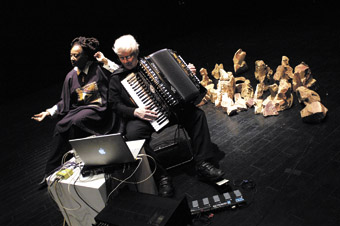
Pauline Oliveros and Ione
photo Heroku Ikeda, courtesy of Kanazawa Museum of Art
Pauline Oliveros and Ione
THE ANNUAL SOUND ART EXTRAVAGANZA, LIQUID ARCHITECTURE, IS AN INTERNATIONALLY SIGNIFICANT EVENT THAT PROVIDES AUDIENCES WITH A CROSS-SECTION OF THE NEWEST AND BEST IN THE FIELD. WITH PERFORMERS FROM ACROSS AUSTRALIA, THE US, FRANCE AND SWITZERLAND, WORKING IN DIVERSE FIELDS, THIS WAS A FABULOUS SEASON. SOUND ART CAN EMBRACE EXPERIMENTAL MUSIC, NEW MEDIA AND PERFORMANCE ART; THIS YEAR’S LA FESTIVAL FEATURED ALL OF THESE AND ALSO LOOKED BACK AT THE ROOTS OF AUSTRALIAN SOUND ART AND ITS GREATEST EXPONENTS.
The program opened with performances by three younger composers. Dean Linguey performed on an apparatus comprising two sheets of steel suspended from a frame and connected by metal wires. Electric transducers vibrate the closely microphoned sheets and the vibrations are broadcast through a mixer and the PA. Linguey orchestrates a complex polyphonic signal into engaging music by touching or pressing the metal with his hands. Camilla Hannan’s work involves reprocessed field recordings orchestrated into a delightful composition that hovers between music and audio-documentary, taking you into worlds of memory and imagination. Nigel Wright creates engaging experimental musical compositions using a laptop. These composer-performers showcased three of the primary ways of generating sound—using a vibrating object (most musical instruments fall into this category), morphing and blending recordings of ambient, environmental or sampled sounds, and orchestrating synthesised sound. Much sound art traditionally falls somewhere along this continuum. The listener responds to the sound as music but is also teased by the recognisability of particular sounds, and notices how they are transformed and mixed, the melodic or harmonic lines and patterns that develop, spatial effects and the incorporation into the mix of performative by-products such as resonances, overtones and feedback. Every artist establishes a unique language.
australian sound art history
The same night saw the launch of the CD of Australian sound art pioneers, Artefacts of Australian Experimental Music: 1930-1973, compiled by Clinton Green, and a panel discussion between notable composer/performers Pauline Oliveros, Rainer Linz, Robin Fox and Warren Burt (a former Oliveros student). Before a large and interested audience, this evening was a significant moment in the history of Australian sound art, and discussion ranged over the nature and legacy of Australia’s early experimental music and the lack of acknowledgement of the important work that has emerged. In Australia, the field developed particularly in the 1970s through the work of Burt, Keith Humble and Ron Nagorcka and through the establishment of university courses in the area, and has since gained impetus through international travel and recording distribution. But the roots go back to the 1930s and Percy Grainger is counted as a pioneer. The panel concluded that the Australian sound art scene is now firmly part of a global community. Echoing a cry throughout the arts, they lamented the continuing lack of news-media attention and of funding for experimental music and sound art.
Following the panel discussion, Fox performed on early synthesisers retrieved from a dumpster at the closure of an important 1970s Melbourne studio, and blended into the mix some elements from recordings made at the time.
deep listening
Pauline Oliveros, a leader in sound art in the US since the 1950s, is the founder of Deep Listening®, a mediation practice that involves shifting focus from a particular sound to all ambient sound and listening exclusively or inclusively. Her delightful performances with her collaborator Ione were highly refined musical compositions. While in Australia, Oliveros had also performed a remix of one of her 1960s works (see RT80, p51), so the lineage of experimental music and sound art was laid before us.
In the Melbourne leg of LA8, Oliveros and Ione’s Saturday afternoon Deep Listening workshop was not to be missed. After a series of warm-up exercises, our attention was focussed on the nature of listening and the awareness and recognition of ambient sound. We heard unmediated the ambient sounds such as birds, cars and trams that sound artists so often mimic, reuse or parody. Deep Listening is also about experiencing one’s own body, how it hears, feels and itself produces sound, and how hearing and feeling connect. The workshop reminded us of how we categorise sound as musical, unmusical or noise, depending on context, memory, experience and taste.
into the labyrinth
On the concluding night, the audience was marshalled through the rear door of the auditorium into an underground carpark/loading bay—which became a quintessentially urban arena—and given earplugs. Earplugs at a concert? The evening opened with Perth-based quartet Abe Sada (recalling the name of the 1930s Japanese geisha who notoriously suffocated and then castrated her lover), who perform on electric bass guitars connected through effects pedals to massive amplifiers. For this set, they were joined by Robin Fox on laptop, and the performers spread themselves around the space, coordinating their improvisations through aural rather than visual cues, with brief flourishes and squealing feedback overlaying long, rumbling drones. Slow, subtle and introspective, this is darkly beautiful music that partly builds on the aesthetic that emerged in the Hendrix era of the electric guitar, but which draws more on the ethos of sound art to establish a unique and compelling oeuvre.
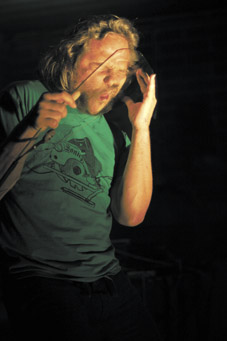
Justice Yeldam, Liquid Architecture 8
photo Christina Tester
Justice Yeldam, Liquid Architecture 8
Following Abe Sada was the astonishing Justice Yeldham and the Dynamic Ribbon Device. As well as the Coca-Cola insignia, the term Dynamic Ribbon Device might refer to the contact microphone attached to the large chunk of window pane that Yeldham (Lucas Abela) holds in his hands and against which he presses his face as he bawls his rant, or to the blood flowing from his hands and mouth as the performance progresses and the glass slowly disintegrates. The mike is connected via effects pedals to a large amplifier, so that Yeldham’s cathartic yelling is transmuted into nearly abstract sound, though never abstract enough to blunt the emotional power of his soliloquy. More performance art than sound art, it recalls the tradition of performance and body art from Chris Burden, Mike Parr and Stelarc to Monika Tichacek, amongst numerous others, in which artists violate their own bodies, drawing attention to the nature and vulnerability of human flesh, its colonisation and the possibility of redemption through suffering. Abela’s is art at its most primal.
Runzelstirn and Gurgelstock (in fact one artist, Rudolf Eb.er of Switzerland) followed, with the performer, wearing a pig mask with a mike in it, sitting in a car and declaiming unintelligibly through a mixer and PA. Again, more performance than sound art, it was mockingly ironic, as if revealing the tormented psyche of a commuter caught in a traffic jam, and resonating with the carpark metaphorically as well as literally. Overall, the evening was more urban theatre than concert.
This LA season focussed very much on the listener and the nature of listening. The contrast for the audience between Justice Yeldham’s visceral performance, Abe Sada’s tectonic reverberations and Pauline Oliveros and Ione’s meditative music was profound. Important in sound art is the experience of the body—both the performer’s and the listener’s—its haptic awareness and its location in site and space. Sound art is about the technical means of making and orchestrating musical sounds and it can carry incisive political and social commentary. It is very much about the physical, intellectual and musical experience of listening and the triggering of memory and emotion. The best works touch us at every level. Director Nat Bates’ thoughtful programming has made for a memorable LA festival that has once again revealed the breadth, depth and potential of sound art.
Liquid Architecture 8, director Nat Bates, Arts House, North Melbourne Town Hall, July 11-13, RMIT University, Melbourne, July 14
RealTime issue #81 Oct-Nov 2007 pg. 45
© Chris Reid; for permission to reproduce apply to realtime@realtimearts.net
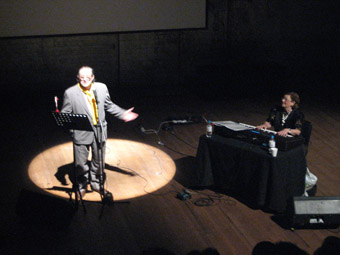
Tony Mason-Cox and Ann Onymous, Liquid Architecture 8, Sydney
photo Shannon O’Neill
Tony Mason-Cox and Ann Onymous, Liquid Architecture 8, Sydney
OVER THE LAST THREE YEARS THE SYDNEY DIRECTORS OF LIQUID ARCHITECTURE, SHANNON O’NEILL AND BEN BYRNE, HAVE CONSISTENTLY DEMONSTRATED A BOLD AND DISTINCTIVE CURATORIAL APPROACH. EACH EVENING IS NOT ONLY CLEARLY CRAFTED TO EXPLORE A PARTICULAR ASPECT OR FETISH OF AUDIO EXPLORATION, BUT TO “DO SOMETHING TO YOU.” THE 2007 SYDNEY EVENT WAS THEIR MOST PROVOCATIVE YET.
surprise sounds
In a controversial move, the opening night seemed aimed at repelling audiences. The program notes claimed an exploration of popular music, but it felt more like a finger to the idea of scenes and acceptance: who is an outsider artist and who an insider; if it’s all about self-expression why are some people perceived as artists, some not? Daniel Green has a developing reputation for his performative video work, and he took a brave leap in presenting a live version of his excruciatingly daggy style, opening with “Tomorrow Belongs to Me” from Cabaret, in enthusiastic yet shaky baritone accompanied by occasional noise bursts on a toy guitar.
The audience was split between aghast and amused. Green continued with a remix travesty of “Maria” from West Side Story with glitched minidisk backing and finished off with a fiendish version of “Tell Me More” from Grease, played from a commercial DVD that supplies sing-a-long karaoke text, to which Green only sang “blah blah.” Knowing, and sometimes appreciating, Green’s work for video, I found this interesting not so much as sonic exploration but rather as a performance work, but to those in the dark it must have been indeed perplexing.
This disorientation worsened with the introduction of Tony Mason-Cox and his accompanist Ann Onymous. Mason-Cox is an insurance salesman who likes to pen a tune or two, particularly a dirty ditty, and enthusiastically sing them in his stumbling way. His first few limericks were amusing, but he seems to have written hundreds and the overload became tortuous, particularly for those with delicate political constitutions. What was most interesting was when Mason-Cox sang a serious song about his stepfather, his voice now frail and uncertain. The sentiment was genuinely moving—which made the audience distinctly uncomfortable. Was Mason-Cox’s inclusion in the program a challenge to sound art elitism or was he wilfully placed out of context? These conspicuously contentious questions charged the Sydney LA 8 opening evening. For those who hung on to the end, the glam rock mayhem of the band Winner was their clear reward.
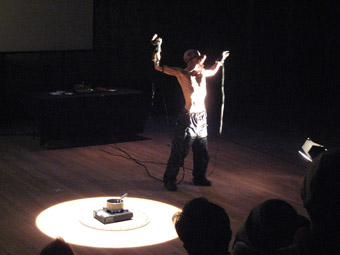
Runzelstirn & Gurgelstock, Liquid Architecture 8, Sydney
photo Shannon O’Neill
Runzelstirn & Gurgelstock, Liquid Architecture 8, Sydney
actionist acts
In contrast, the second night promised to be truly terrifying with performances by actionist inspired artists Runzelstirn & Gurgelstock (one person actually, Rudolf Eb.er) and Dave Phillips from Switzerland and local artist Lucas Darklord (aka Thomas Knox Arnold). While Natasha Anderson on contrabass and garklein recorders with electronics might appear to be out of place in this industrial gothic line-up, her deft use of dynamics, texturing and attack gave her performance an intriguing brutality juxtaposed with fragility making her one of the most satisfying acts (conceptually and sonically) of the festival. Conversely, Lucas Darklord’s appearance—militaristic jacket with spiked shoulder pads and half blackened face—promised something more gruesome than we actually experienced, which turned out to be a polite set of dark and murky glitches shifting in and out of a timid apocalypse.
Dave Phillips was certainly disturbing for many with his video collage of human cruelty to animals, accompanied by poetically accusatory aphorisms and unrelenting noise floor. While the piece by Runzelstirn & Gurgelstock—involving a camp-stove with a pot of boiling vinegar, pig nose and a strap-on finger noise activator—looked ready to deliver on its threat of menace, the artist appeared gleeful in denying us any dramatic climax.
The evening ended with the video documentation of a performance by Runzelstirn & Gurgelstock involving a line-up of butoh inspired female performers drinking a variety of different coloured substances on cue to loud music and throwing up for a very long time. While outwardly a performance piece, its roots were in audio—by far the worst aspect of sitting through it was the sound of the women gagging, spitting and sticking their fingers further down their throats to prolong the action. As a very transparent “play” of manipulation and consensual subjugation, set very firmly within the extreme body zone of Japanese performance aesthetics, I was surprised by the agitated response to the piece as sexist by some in the audience. But then again not everyone has consensually subjugated themselves to a decade of performance art…
audio-visuality
The final evening concentrated on audiovisual explorations and did not seem planned to upset the audience, although excessive length did move it into the realm of endurance. The common theme, it seemed, was the re-emergence, for better or worse, of narrative in audiovisual works. Peter Newman has developed a distinctive style—intensely minimal visuals and dramatic bittersweet sounds—and he explored this further, pushing the sweet a little more than the bitter this time. Lloyd Barrett seems to use similar visual processing methods to Newman but opted for a (for some too) clear narrative using text panels to explicate his dream segments, creating a pithy short film feel to his set.
Kamusta (Chris Caines and Jessica Tyrrell) employed two screens—one a slowly setting sun, another a shifting melange of close-up street details—accompanied by a miminally developing soundscape and live voiceover by Caines. While all the elements were clear and considered, the piece as a whole did not develop beyond a kind of ambivalent ambience perhaps created by an unreconciled struggle with the figurative nature of text. Abject Leader introduced a performer to their 16mm film and audio set. There was potential in the beat poet flow of Jamie Hume’s offering, however the parodic gesture at character—safari suit, pith helmet and fake facial hair—felt underdeveloped and stylistically awkward, which along with some ornery projectors resulted in an overly long and difficultly paced set, although Joel Stern’s sounds maintained some momentum.
Cellule d’Intervention Metamkine, the team of French projection and sound artists came on at some time close to midnight for a 40-minute set when many of us in the audience had very little left to invest; however their dynamism was worth the wait. There is an orchestral quality, a Hitchcock-Herrmann grandeur to the work that is both perplexing and invigorating. The very hands-on manipulation of light is alchemical and magical, the structure of the set intriguing in its use of internal climactic steps and troughs. It felt like we were in the hands of dream masters…and when it was over we stumbled out shell-shocked and hazy, trying to remember our way home.
in situ
The festival also featured Terminal, installations by Jasper Streit, Natasha Anderson, Rik Rue and Wade Marynowksy, dotted around the CarriageWorks foyer. A potentially difficult venue due to sound bleed issues, the pieces were well-placed providing little islands of focus for audiences easily dissipated in the cavernous space. Marynowsky’s player piano automaton, Anderson’s abject testicular gloops and Streit’s minimal metal object provided as much visual as audio intrigue.
The curation of Liquid Architecture Sydney this year was wily and thought provoking, the experience of the whole festival being stronger and more satisfying perhaps than the individual performances. Despite the suspicion that programming of extreme acts might repel some audiences, the festival was very well attended with the final night at capacity. Sadly Shannon O’Neill and Ben Byrne have called it quits for Liquid Architecture. It cannot be said that they went quietly.
Liquid Architecture 8, Sydney directors Ben Byrne, Shannon O’Neill, national director Nat Bates; Performance Space at CarriageWorks, Sydney, June 28-30
RealTime issue #81 Oct-Nov 2007 pg. 46
© Gail Priest; for permission to reproduce apply to realtime@realtimearts.net
THIS YEAR, FOR THE QUEENSLAND MUSIC FESTIVAL, ELISION BROUGHT TOGETHER SAXOPHONIST/COMPOSERS TIMOTHY O’DWYER AND JOHN BUTCHER TO DIRECT WHAT REMAINS, A FOUR MOVEMENT WORK (TWO EACH) FOR THE ELISION ENSEMBLE LASTING ABOUT AN HOUR. THREE MOVEMENTS ARE IMPROVISED AND ONE (BY O’DWYER) TRADITIONALLY SCORED. THE IMPROVISATIONS WORK AS GAMES, WITH THE PERFORMERS GIVEN SETS OF INSTRUCTIONS THAT INFLUENCE THINGS LIKE LISTENING AND RESPONSE STRATEGIES.
The usual seating is pulled back so that audience and performers are arranged around the perimeter of the very cubic performance hall of the Judith Wright Centre. The performers (Graeme Jennings, Peter Veale, Tristram Williams and Erkki Veltheim with Butcher and O’Dwyer) are split into two groups, O’Dwyer in one, Butcher in the other, and face each other from opposite ends of the floor. The audience takes up the other two sides.
The music starts with punchy noise bites from the brass and reeds snapping from one group to the other. Contest and bravado alternate, synched up to and fro to make a symbolic conflict-like rap without the stereotypes. Percussion hurtles in as a nutty professor continuo—it’s funny, fast, brilliant, all sorts of things are being hit, bowed or rattled. Butcher comes in with a solo that sounds like strangling poultry. Not to be outdone, the violin from O’Dwyer’s side likewise garrottes some poor beast before a hideous ring modulated feedback guitar makes everyone else sound lyrical. There’s plenty of spatial, timbral, and rhythmic interplay, with an underlying feel that the musicians will break into killing each other any second now. Tension relaxes, and Butcher and O’Dwyer start using the sax stops as percussion—sounds great, rich, lively, like kids in the bath. The first movement ends to the enormous roar of saliva circulating through the cavern of Butcher’s saxophone.
The second movement begins with Butcher’s side playing long fast lines like a bunch of religious ecstatics in a casually loony frenzy. Jump to the other side of the space for frantic table percussion, bass clarinet and a bit of all-join-in, sound switching from side to side of the hall. O’Dwyer pulls some out some beautiful sounds before a great bop solo from Butcher, hip and eccentric, Tuvan throat singer does Coltrane with hiccups. Butcher’s face and neck inflate and explode in a bizarre peristalsis. Time for a brief pause before the third movement.
O’Dwyer moves to a podium up front to conduct what is the most scored of the movements. Much quieter, more of an ensemble feel, you can hear the organisation. Supermarket plastic bags get scrunched and amplified, become percussion. Soft sounds, plosive pats on the keys, bowed cymbals, feedback sax, fade out.
Back to improvisation and the final movement starts with O’Dwyer and Butcher using a ping-pong, no-playing style, where everything comes out except the sound of the sax. Butcher starts up the other soloists for some detailed call and response. It’s like a pushy conversation, or hearing tests where the performers have to guess what and when the other is going to play and try and play along. Someone starts playing stuff so that it sounds backwards. Butcher makes sounds like a crow rattling. The hour is up and it’s over.
So good I went the second night for a repeat performance. I wasn’t the only one. O’Dwyer’s solo was the most sustained and confronting aggression I’ve heard. If music could be heat we would have burned.
ELISION, What Remains, composer-performers Timothy O’Dwyer, John Butcher, ELISION ensemble; Judith Wright Centre of Contemporary Arts, July 20-21
RealTime issue #81 Oct-Nov 2007 pg. 47
© Greg Hooper; for permission to reproduce apply to realtime@realtimearts.net

l-r Matt Warren, Tom Hall, Scott Cottrell
photo Leeanne Hall
l-r Matt Warren, Tom Hall, Scott Cottrell
TOM HALL STOOD UP FROM HIS LAPTOP AND LEFT HIS SEAT UP ON THE STAGE, HIS TALL FRAME ALLOWING HIM TO COMFORTABLY HOLD THE SMALL RIDE CYMBAL ABOVE THE HEADS OF EVERY PERSON IN THE ROOM FOR A BRIEF MOMENT BEFORE HEADING FOR THE ENTRANCE, DOWN THE STAIRS, AND VERY POSSIBLY ONTO THE STREET. HE HAD BEEN CLANGING THE CYMBAL WITH SMALL STICKS AND PROCESSING THIS SOUND THROUGH HIS LAPTOP AND WHATEVER ELSE HE WAS USING. THIS HAD BEEN VERY ENGAGING, BUT STEPPING OFF THE STAGE FOR A SOLO WAS UNEXPECTED AND EXCITING. ALL TECHNICAL MANIPULATION WAS GONE, JUST THE CLEAN SOUND OF ONE CYMBAL, REPETITIVE AND HYPNOTIC. SOMEONE ELSE IN THE APPRECIATIVE AUDIENCE REFERRED TO THIS AS A BLESSING AND PERHAPS IT WAS.
The other performers, Scot Cottrell and Matt Warren, had become silent at this stage, allowing Brisbane-based sound artist Hall to take the moment, but they were still present in the sound: a rich outburst of not-playing that served to demonstrate that this meeting of minds, and approaches to sonic construction and equipment was more than some dudes trading licks, and let me thank some higher power for that. Improvisation is a special thrill when it works, but all too often the chance for a peek at some kind of ecstatic insight gets lost as macho types take turns demonstrating their chops. Or even worse, no turns are taken at all. This was not the case here; we managed to see some real communication that had a strong dynamic sense. It was exciting, even funny for the audience and seemingly the performers, but this seems to be normal for Tom Hall: he is really genuinely thrilled by sound. He listens to it, captures and manipulates it, recontextualising into performance. His pleasure is infectious.
I’d attended the workshop Hall had run earlier that day. He took us for a wander about the docks area of Hobart, and whilst calmly discussing sounds and things that made them, his fascination became clear. He stares at his environment as well as listening to it, obsessing about bridges and holes in piers. He speculated that a particular bridge may well be totally unique in its position above the water, the way it sits in relation to the prevailing wind around the Hobart waterfront area, and that the sounds it generates might be the only sounds like that anywhere in the world. That it occurs to him to think of this is remarkable in itself, but he then gathers and stores the sound as best he can with his collection of microphones (something else he was quite excited by) with the promise of constructing a work with it.
The group carried out exercises—it was a workshop after all. Simple cupping of the hands about the ear to isolate sounds was a good starting point to get us speculating about the nature of sound in the everyday world, but a genuine moment of clarity came a little later.
Tom handed all the attendees earplugs. We stood on the lawn next to the busy and rather noisy Salamanca Market, one of Hobart’s best-known tourist attractions and a very familiar experience for actual residents. Plugs inserted, the market itself became removed and grew distant quite rapidly. This was strange indeed; we’d not moved. As the silence grew more palpable, I wondered what Hall was really doing here: the idea had been to create sensitivity in the ear itself on removing the earplugs afterwards, but this experience of silence was quite something. I felt strange, disconnected from the world after only a few minutes of this very simple exercise. The workshop group became a mild spectacle to observant marketgoers. We were, as it happened, standing about with fluorescent earplugs visible, not-listening with intent. Intended or not, this added to the odd, isolated feel of this moment.
Removal of the earplugs came after a short walk to a more central spot in the nearby Salamanca Square. I found the rush of sound a relief and, yes, it did all feel louder somehow. Just like the cymbal that was to ring over my head later that evening, there was something quite amazing in this brief, simple moment.
Tom Hall finds wonder in the small and the brief, in the things that go unnoticed in this busy life. Beyond that though, he is fortunate to be able to express this with a clarity one encounters all too infrequently.
Sound workshop with Tom Hall, Inflight, Hobart, Aug 18-19; www.tomhall.com.au
RealTime issue #81 Oct-Nov 2007 pg. 48
© Andrew Harper; for permission to reproduce apply to realtime@realtimearts.net
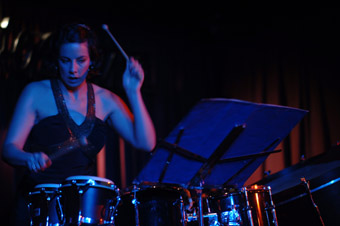
Claire Edwardes
HAVING JUST SEEN CLAIRE EDWARDES PERFORMING WITH GREAT SUBTLETY IN THE BRACING SONG COMPANY/ENSEMBLE OFFSPRING CAGE UNCAGED CELEBRATION AND, A WEEK BEFORE, IN A SUPERB CONCERT IN DUET WITH GUITARIST GEOFFREY MORRIS, I WAS EAGER TO IMMERSE MYSELF IN THE PERCUSSIONIST’S FIRST CD, TITLED COIL AFTER THE MAGICAL FIRST TRACK ON THE CD, COMPOSED BY GERARD BROPHY. MY EXPECTATIONS OF TEXTURED, NUANCED AND CHARACTERFUL PLAYING WERE FULLY MET.
Coil is a wonderfully apt image for the album, conjuring something wound, expanding and contracting, full of force but also of a controlled unleashing of sounds delicate and powerful, whether in a music box or a grand pendulum clock or, as realised here, on vibraphone, marimba and drums. The compositions on the CD beat and pulse regularly as we would expect of percussion but, by turns, they dance, muse, grow introspective, dramatic and ache for transcendence.
In Brophy’s Coil (8’39, 1996) little melodies surge, rise, turn back on themselves and take flight again generating a palpable optimism. I wanted to invent words to sing with these sparkling, bell-like vibraphone musings and the rise and fall of their memorable cadences in Edwardes’ able hands. In contrast, Andrew Ford’s The Armed Man (5’42, 2004) is, the composer says, founded on a mediaeval tune. We don’t hear it, besides the tonal range is restricted to a drum kit, but the effect is powerful, a drum solo without a band, hinting at things ceremonial (march, attack, execution) and even rock’n’roll and, for Ford, the Iraq War,
Ross Edwards’ More Marimba Dances (7’05, 2004) furthers the magic of the widely played earlier set and had me on my feet. Edwardes and producer Belinda Webster bring to the trio of dances an enveloping range and depth of sound, the timber ringing with sublime bottom notes and high ripplings, resonating with buried references to music Latin and Asian and Baroque. The first and last dances open with buoyant riffs that you quickly embody—they are the springs out of which the compositions rise before falling and rising again—while the middle piece revels in an elegant tentativeness. Refreshing is the word for More Marimba Dances, and they are never less than utterly intelligent.
Next, in works by Andrew Schultz, Dominick Karski and Damien Ricketson, I found myself in very different, more demanding territory. Schultz’s Winter Ground [12’05, 2000] for vibraphone, is palpably reflective, establishing an ambiguous emotional state and working it over and over, winding and entwining, growing denser by accrual, expanding from a narrow note range into a stream of consciousness reverie with just enough of a rhythmic anchor to keep the work sensually engaging, often quite beautiful, right to the final residue of the repeated ringing of a single note. Something has been completed.
Dominik Karski’s Beginnings to No End [7’45, 1999], writes the composer, comprises “seven short fragments called ‘beginnings’—small pockets of musical material that could have been developed further, but instead collapse unexpectedly.” Fast pulsed, insistent ‘beginnings’ on marimba first simply stop. The impulse to cease soon seems to come from the instrusion of a very different voice. Sweet marimba and gruff bongos dialogue, a remarkable exchange which must have stretched Edwardes, brain and limb until, finally, the marimba takes off on its own, happily monologuing, galloping, riffing, locked into a final pulse with minute diversions, into…
Damien Ricketson describes his Hol Spannen Luiden [18:12, 1997] as “a variation without a theme”, “a recounting of a musical work where the original is never heard”, with a focus on “the nature of memory, in particular processes of recollection and decay.” The most demanding work on the CD, this work requires several listenings before it takes because it forsakes obvious beat and pulse for the very textures of percussive sound—small rolls, the vibration of dropped sticks, the natural reverberation of struck metal, all listened to and pondered in very real time. Once relaxed into, Hol Spannen Luiden is subtly if sparely immersive.
The CD closes with a return to more accessible material but both pieces have their own complexities. Mark Clement Pollard’s Just a Moment (3’20, 1996) has a gentle minimalist-cum-gamelan feel on vibraphone with brisk phasing which yields upper end sparkle and a mid-range pealing, generating rich layering in mere minutes. It’s fascinating that in a reversal of expectation, the cyclical melodic drive for Just a Moment comes from the top end of the instrument, while the occasional mid-range notes suddenly colour the composition from below. Pollard’s One Sweet Moment (3’00, 1997) starts ringing strongly, if hesitantly, like carolling bells, and subsequently takes shape as a continuous pealing with an emphatic beat, the intervals finally opening out, the pulse slowing, decayed notes hanging…These are brief works, but feel big and embracing and leave a glorious ringing in the ears.
Claire Edwardes has located the kinetic energy in these compositions and let them uncoil. With each play of the CD, their magic is released.
Claire Edwardes, Coil, recording engineer, producer Belinda Webster, mastering Don Bartley, Tall Poppies, CD TO193, www.tallpoppies.net
See giveaways (p56).
RealTime issue #81 Oct-Nov 2007 pg. 48
© Keith Gallasch; for permission to reproduce apply to realtime@realtimearts.net
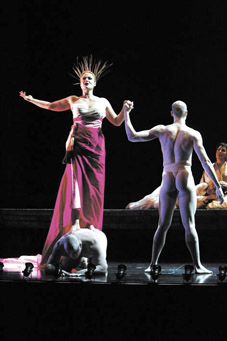
Katrina Sheppeard, The Love of the Nightingale
photo Rob MacColl
Katrina Sheppeard, The Love of the Nightingale
THERE IS SOMETHING BOTH ENDEARING AND ABSURD ABOUT OPERA AND IT’S NOT THAT IT’S NOT OVER UNTIL THE FAT LADY SINGS. IT’S IMPOSSIBLE NOT TO MENTION THE OPINION OF DR SAMUEL JOHNSON CITED RECENTLY IN THE AUSTRALIAN THAT IT IS AN “EXOTICK AND IRRATIONAL ENTERTAINMENT.” LIKE A CRAZY MARXIST AUNT FROM ANOTHER ERA, OPERA CAN SEEM BOTH HOPELESSLY ANACHRONISTIC AND EMBARRASSING, TOO PRONE TO WEEP OVER LOST CAUSES LIKE, WELL, HUMANITY. IN THE POSTHUMAN WORLD, WE WEEP OVER THE BOTTOM LINE, AND OPERA COMPANIES HAVE MUCH TO WEEP ABOUT IN THIS RESPECT.
But since words have been cannibalised into sound-bites and rhetoric trammelled in the mud of world wars and worse, opera seems well-suited to express our most primal or sublime emotions, and something of those in between. In a cheek by jowl inner suburb in Brisbane sometimes it becomes impossible to edit out the intimate transactions of neighbours. When the phone rang in the home of an elderly Greek couple, the awful pause and ensuing deep male keening accompanied by the broken recitative of a female voice told its own story (their son had died). It seems to me that it would be impossible to render the speechless anguish and profundity of such a moment in any form other than opera (unless in the silent scream of visual art). The American musical has its own fine attributes, but doesn’t quite cut the mustard unless we count George Gershwin’s Porgy and Bess, a self-styled folk opera. From Artaud onwards, avant-garde theatre has aspired to the total experience of Eastern opera while denigrating Western opera as a bourgeois art form, forgetting that ‘bel canto’ was once as popular as ‘the beautiful game’ [soccer, Ed.]. Beaumarchais’ farcical play The Marriage of Figaro was credited with being the insurrectionist spark that inflamed the French Revolution, and was adapted into an equally subversive operatic masterpiece by Mozart. More recently, John Adams’ controversial modern opera Death of Klinghoffer caused a bitter international debate. The mad old aunt is still dancing away.
l’orpheo
The 2007 Queensland Music Festival wins the World Cup by fielding the first (still one of the finest), and our home team’s very impressive latest, contribution to the operatic tradition. The festival participated in the 400th anniversary of Claudio Monteverdi’s and Alessandro Striggio’s L’Orpheo which is being celebrated world-wide, while mounting the world premiere season of Richard Mills’ and Timberlake Wertenbaker’s The Love of The Nightingale. L’Orpheo was first performed before a court audience (although Monteverdi’s second lost opera was presented al fresco before a reputed audience of 5000) so that the neo-classical, acoustically friendly venue at the Masonic Memorial Temple with its back-straightening wooden pews chimed. It was a sumptuous feast, not because a lot of money had been spent (it was sparsely but adequately staged in the round), but because of the superlative and enthusiastic rendering by the mainly young cast of Griffith’s Conservatorium singers, and the accompanying musical ravishment.
We were on intimate terms with the inner workings of the period music ensemble led by the disarmingly undemonstrative harpist Marshall McGuire. Violone, harpsichord, theorbo, cornetto, sackbut and regal were some of the instruments rarely seen or heard that made the orchestra as entrancing to watch as to listen to, as on the spot as a jazz combo. The loud cacophany of brass and drums, the harmony and rhythm of ‘continuo’ instruments like the organ, cello and viola, and melodic ones such as the recorder were a combined knockout in their day, and are familiarly dissonant in the manner, say, of Kurt Weill to modern ears. Like the songster Weill, Monteverdi turned out some hot madrigals, although he also wrote church music as well as writing for the more profane medium of the theatre. A kind of brilliant musical ‘bricoleur’, Monteverdi mixed and matched: the opening bars of L’Orpheo are the same as his Vespers. It was this conflux of church music, love songs, and dramatic feelings that defined a new genre. By extolling in then voguish Neo-Platonic terms the ‘civilising’ power of music in the classical Orpheus and Eurydice myth, Monteverdi raised men and women to the heights of the gods in what has been regarded by many as the first humanist manifesto. On opening night, Gregory Massingham as Orpheo had lost his voice. His part was sung by Trevor Pichanick while Massingham performed the role. Pichanick’s bel canto rendition grew wonderfully in stature, and a warm and supportive audience responded to the potentially awkward arrangement with appropriately civilised demeanour.
the love of the nightingale
The Love of the Nightingale tenders a less optimistic, less harmonious version of the humanist project from a soured, latterday perspective of civilisation and its discontents. Based on a darker classical myth from Ovid’s Metamorphoses, it sets up an opposition between liberal, sunny Athens and gloomy, repressive Thrace which has come to its aid in times of war, but really it’s the fracture in any society’s psyche between the ineffectual voice of conscience and dumb violence.
The liberator from the North, Tereus, asks only to marry the King’s daughter, Procne, to the chagrin of her naïve younger sister, Philomele. Five years later and after the birth of her son, Itys, Procne languishes for her sister’s company, and asks her husband, Tereus, to escort Philomele back to Thrace on a visit. On the journey homeward, Tereus rapes Philomele and, in a desperate bid to cover his tracks, cuts out her tongue. Philomele is prevented from asking the most basic question: Why? When the deed is exposed, Procne exacts revenge by slaughtering her own sword-wielding, father-proxy child because: “We did not want that future. A future without questions.” Rather than offering the slaying of the patriarchal line as a solution, there is devastating irony here because one of the questions relates to the murder of children. The only hope—because “the blood had to stop flowing, the anger had to subside”—is radical transformation magically provided by Ovid who has the three protagonists turn into birds. In the opera, the possibility of transcendence is made heartbreakingly transparent in a sort of afterlife coda when Itys asks: “Why aren’t you speaking Philomele? Don’t you want me to ask questions?” Philomele breaks into the pure wordless song of the nightingale and we are brought full circle to meditate on the hope (and hopelessness) of the civilising power of music extolled in L’Orpheo.
Wertenbaker’s libretto is simply marvellous in its self-awareness, and Anke Hoppner as Procne and Leanne Kenneally as Philomele interpretively and vocally outstanding, but I found Mill’s post-romantic score (and I’ll be howled down for this) had too many unnecessary strings, literal and figurative, attached. Nevertheless I was still intensely aware that my mad old aunt was dancing.
L’Orpheo, composer Claudio Monteverdi, librettist Alessandro Striggio, musical director Marshall McGuire, stage director Caroline Stacey, designer Kaoru Alfonso, lighting designer George Meijer, Ludovico’s band, chorus and orchestra staff and students Queensland Conservatorium Griffith University; Masonic Memorial Temple, July 23, 25, 27; The Love of the Nightingale, composer Richard Mills, librettist Timberlake Wertenbaker, conductor Richard Gill, director Lindy Hume, designer Dan Potra, costumes Kate Hawley, lighting Nigel Levings; Opera Queensland, Playhouse Queensland Performing Arts Centre, July 13, 16, 18
RealTime issue #81 Oct-Nov 2007 pg. 49
© Douglas Leonard; for permission to reproduce apply to realtime@realtimearts.net
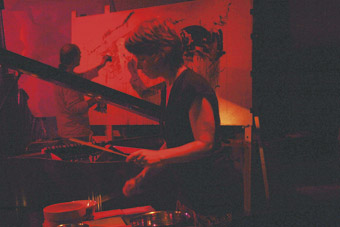
Tony Cuthbertson, Vanessa Tomlinson, See Hear Now
photo Glen O’Malley
Tony Cuthbertson, Vanessa Tomlinson, See Hear Now
IN SEE HEAR NOW 2007, QUALITY COLLABORATIONS AND SYNERGIES ABOUNDED; IT WAS THE AUDIENCES WHICH WERE THIN. TROPICAL TOWNSVILLE’S COLDEST WINTER ON RECORD MUST HAVE KEPT ITS FROST-TENDER INHABITANTS INDOORS, UNWILLING TO BRAVE THE UNSEASONABLE COLD(ISH) SNAP EVEN FOR THE LIKES OF DISTINGUISHED VISITORS, BONEMAP AND JIM DENLEY, CLOCKED OUT DUO AND LAWRENCE ENGLISH. THE COMPENSATORY ASPECT OF SMALL AUDIENCE NUMBERS WAS THE FEEL OF FAMILY GATHERING/MASTER JAM SESSION.
performance 7: lapse
Previous collaboration between Bonemap and Denley was evident in Lapse, the piece straddling the divide between improvisation and rehearsed polish. The aural contortions of Denley’s sax were complemented dynamically by Russell Milledge’s dripping, synthesized percussion in the early stages of the piece. Projections of numbers and computations flickered across the walls, amplifying Rebecca Youdell’s stressed, erratic movements. Youdell, in a vintage black ruffled dress, played to the spotlight, flitted and flirted with the saxophonist, intermittently connected with him, calmed; then the next wave of moaning, wailing sax threw her back to her obsessive scrubbing, quarantined by the circle of the spotlight into her involuntary dance, untouchable.
Youdell bumped against visual artists scratching away at their easels on the periphery, and tangled with an unseen protagonist. Black and white projections of body silhouettes appeared, initially floating and swirling like a Bond film intro, but at times becoming frantic and distorted. Youdell clawed at her costume.
The visual artists laughed, sharing a separate moment, but the laughter almost mocked the dancer’s vulnerability. The projections turned into a hall of mirrors reflecting a filmed Youdell in a red dress torn and pinned together with safety pins. Her shadow interrupted her screen self as she mimicked its movements.
Distorted words filtered through the sax and the laptop. Youdell screwed up her face and tilted her head in an effort to decipher.
Lapse gave away its performance history with a neat wrap up, the music and visuals ending as Youdell faced the audience, styled like a catwalk model, placed her hand under her long hair and flipped it forward to hide her face.
challenges
In contrast, not a few of the festival’s 20 performances were overlong and dawdled scrappily to their conclusions. Works which were solidly captivating in their first half died as the ideas ran thin. This could have been due to the pressures of improvisation.
Another challenge was the role of the visual artists. They tended to be placed at the edges of the action, contrary to the claim in the program: “Visual artists feature…as an integral performing and documenting element, enabling the audience to simultaneously view a number of different visual interpretations of the performance.” However, lighting, projections and distance often prevented the audience from seeing the marks being laid down. Occasionally artist movements at the easels served as an iteration of the larger performance, but mostly it seemed extraneous. Visual art incorporating new media practices were integrated more successfully, with projected film and stills essential to the ambience of many of the multidisciplinary pieces.
performance 4: untitled
The most effective incorporation of visual art was achieved in Performance 4.
Movement artists Nicole Keen and Kate Hooper were wrapped together in a single stretchy white sack centrestage. As they contorted in response to Amanda Stewart’s vocal performance, visual artist Michelle Deveze drew on the cloth. Slower passages allowed her to make deliberately directed work, while at times the movement artists’ staccato responses caused Deveze’s charcoal marks to become random and opportunistic, confined to wherever she could establish contact with her heaving canvas in the moment. A further layer of intrigue was added by local artist Donna Foley’s simultaneous responses using a data tablet, the images projected onto the dancers and walls.
Stewart’s voicework and Foley’s projections carried a heightened synergy underpinned by Foley’s specialisation in the intersection of the visual and aural. Just as Stewart pares back language from the coherent into its component parts, Foley’s calligraphy, using stylus on data tablet, is like pre-writing scribble, almost fooling the audience into believing they could decipher, in Foley’s chaotic, lacy marks, what Stewart was vocalising.
The intensity showed in Stewart’s mobile features and taut neck muscles as she worked rapidly back and forth between two microphones. An unbelievable array of effects was conjured. At times it was like someone quickly turning an old radio dial across stations, or overhearing the sighs, whispers and tragedies of the inhabitants of a whole apartment block all at once.
In between evoking echoes of kissing, popping, chattering teeth, ripping velcro, rain, trains, Morse code from space or a penguin colony in distress with her hoarse, breathy scat, Stewart threw in the odd, tantilising word, which she later described as “a rant for the underlings; women and low caste people.”
Foley’s projected marks changed colour, overlapped, intensified until the screen was practically filled, emptied and the process begun again. The lighting replicated changing weather. Photographer Glenn O’Mallley ducked and wove through the action, adding his shadow to the backdrop as he recorded Deveze trying to tame a ground which behaved like a large, unruly and reluctant animal.
Eventually Stewart’s vocals wound down from disturbing to soothing, ending quietly with “fait accompli…the economics of us…” She walked away from the microphones cueing Foley and Deveze’s last slow lines as they all eyed each other.
These disparate elements married to produce a multidimensional, sensual and random collage. The eye was kept moving, the ear straining and the mind racing to connect the nuances of voice, hand and body: an engrossing journey.
performance 11: after milk wood
Three actors based in North Queensland, Christopher Glover, Susan Prince and John Robertson, performed as an array of characters in a text derived from Dylan Thomas’ Under Milk Wood. The shifts from character to character intensified in pace and visual projections reinforced the rhythm of the dialogue. With the speakers’ faces distorted by the strongly coloured uplights and partly obscured by the projections onto their semi-transparent cage, the focus was firmly on the powerful poetry.
Brisbane-based media artist and composer Lawrence English stood at his laptop computer for the first two-thirds of the performance, recording, mixing and sampling to produce a soundscape playback for the final third. As the actors fell silent and still, English’s playback commenced with a sound like humming machinery, a faint tune and feedback. Bites and echoes of the spoken performance became audible, passages of dialogue were repeated, snippets of biting and nagging, interspersed with a squeaking wheel turning reluctantly. Thomas’s words were rearranged, new dialogue formed between characters in English’s reflexive mixing—the dreams of Milk Wood’s characters disintegrated and reintegrated as night terrors.
This time, the frantic, responsive work of the visual artists at the edges of the performance space added several unexpected elements to the whole. Working on paper with dry media, the rustling, crunching and scratching enhanced the mood of the piece and could be heard in the playback, providing layers of night sounds like rats scuttling and leaves blowing. Deveze, Jenny Tyack, Gerald Soworka and Katherine Cornwall continued to work on through the playback, responding to the mixto which they had already contributed. The movement of the visual artists in the half light of the stage periphery also added a sense of dark things lurking at the barely discernable edges of consciousness during sleep and dreams.
panel 4: spoken music, stationary movement
At a brief forum held at the end of day three, a group of participants examined the potential of movement and text in contemporary performance. Discussion ensued on the hierarchy of forms in each performance, which led, of course, to the question ‘What constitutes Art?’ Group? Language? Neurology? Someone commented that for an infant learning language everything is interrelated, and involves control of movement/hand/mouth/ ear. This neatly encapsulated the tone of the festival, its cross disciplinary experiments and unexpected synergies, and its extended family inclusiveness.
See Hear Now 2007, Multi-Arts Festival, director Michael Whiticker, Townsville, June 21-24
RealTime issue #81 Oct-Nov 2007 pg. 50
© Bernadette Ashley; for permission to reproduce apply to realtime@realtimearts.net




































































































![Matthew Gardiner’s Oribotics [network]](https://www.realtime.org.au/wp-content/uploads/art/13/1343_gallasch_oribotics-miaf.jpg)














































